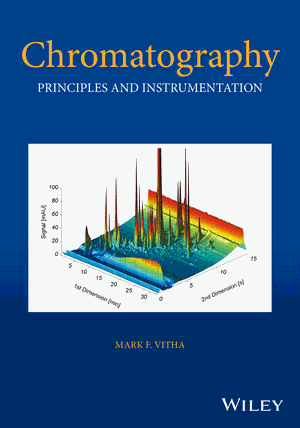
LIST OF BOOKS
Very incomplete list of books on different subjects. Links are to publisher online (if available) or printed version of the book. Some links might be dead (Page is update sporadically). Most of the books are listed in Chronological order (newer on top)
Quantitative Analytical Chemistry
General Laboratory Techniques, Safety, etc.
Practical Organic Chemistry and Synthesis
General Polymer Chemistry and Polymer Text Books, Polymer Characterization

Chromatography: Principles and Instrumentation (2016)
Mark F. Vitha
Wiley
ISBN: 978-1-119-27088-1 280 Pages
Publisher Description: Provides students and practitioners with a solid grounding in the theory of chromatography, important considerations in its application, and modern instrumentation. Highlights the primary variables that practitioners can manipulate, and how those variables influence chromatographic separations. Includes multiple figures that illustrate the application of these methods to actual, complex chemical samples .Problems are embedded throughout the chapters as well as at the end of each chapter so that students can check their understanding before continuing on to new sections. Each section includes numerous headings and subheadings, making it easy for faculty and students to refer to and use the information within each chapter selectively. The focused, concise nature makes it useful for a modular approach to analytical chemistry courses.

Chromatography: Concepts and Contrasts. 2nd Ed. (2009)
Jame M. Miller
Wiley
ISBN:9780471472070 (print) 4502 Pages
Publisher Description: The first edition of Chromatography: Concepts and Contrasts, published in 1988, was one of the first books to discuss all the different types of chromatography under one cover. The second edition continues with these principles but has been updated to include new chapters on sampling and sample preparation, capillary electrophoresis and capillary electrochromatography (CEC), chromatography with mass spec detection, and industrial and governmental practices in regulated industries.
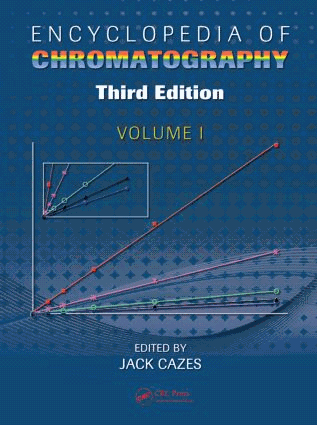
Encyclopedia of Chromatography. 3rd Ed. (2009)
Jack Cazes (Ed.)
CRC Press
ISBN:9780471472070 (print) 2850 Pages
Publisher Description: Thoroughly revised and expanded, the third edition of the Encyclopedia of Chromatography is an authoritative source of information for researchers in chemistry, biology, physics, engineering, and materials science. This quick reference and guide to specific chromatographic techniques and theory provides a basic introduction to the science and technology of the method, offering key references dealing with the methodology for analysis of specific chemicals and applications in industry. With a focus on emerging technologies and uses, the text contains tables and figures that cogently illustrate and clarify technical points in the articles. The Third Edition provides a valuable, reader-friendly reference for all those who employ chromatographic methods for analysis of complex mixtures of substances, as well as practitioners across the entire spectrum of science.
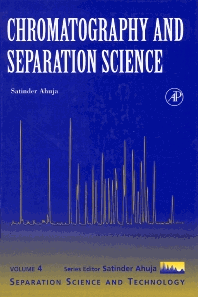
Chromatography and Separation Science (2002)
Satinder Ahuja
Academic Press
ISBN:9780120449811 (print) 262 Pages
Publisher Description: The basic objectives of this book are to: provide basic information on chromatography and separation science; show how simple extraction and partition processes provide the basis for development of chromatography and separation science; describe the role of chromatography and separation science in various fields; discuss the role of chromatography and separation science in development of new methodology; and present new evolving methods and how to select an optimum method.
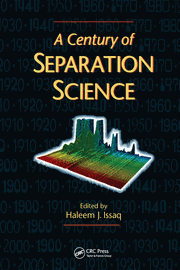
A Century of Separation Science (2001)
Haleem J. Issaq (Ed.)
CRC Press
ISBN: (print) 776 Pages
Publisher Description: A Century of Separation Science presents an extensive overview of the critical developments in separation science since 1900, covering recent advances in chromatography, electrophoresis, field-flow fractionation, countercurrent chromatography, and supercritical fluid chromatography for high-speed and high-throughput analysis.

Encyclopedia of Separation Science (2000)
Elsevier
ISBN: 978-0-12-226770-3 353 Pages
Publisher Description: The Encyclopedia of Separation Science is the most comprehensive resource available on the theory, techniques, and applications of separation science. The work presents information on three levels. The first volume contains Level 1, which provides a broad overview of the theory of the 12 main categories of separation techniques. Volumes 2-4 (Level 2) expand coverage with detailed theoretical and technical descriptions of particular techniques. The remaining Volumes 5-9 (Level 3) cover applications of these techniques from the micro to the macro, and also from the analytical laboratory bench to large-scale industrial processes. Volume 10 consists mainly of the index. Initial access to the online version offering extensive hypertext linking and advanced search tools is available with purchase. Ongoing access is maintained for a minimum annual fee.
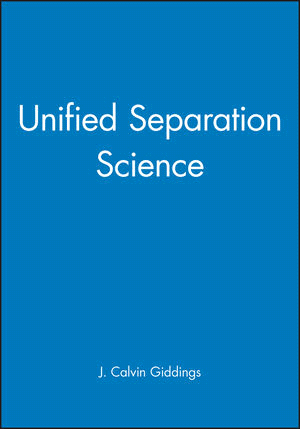
Unified Separation Science (1991)
J. Calvin Giddings
Wiley
ISBN: 978-0-471-52089-4 353 Pages
Publisher Description: Unifies the complex welter of techniques used for chemical separations by clearly formulating the concepts that are common to them. The mass transport phenomena underlying all separation processes are developed in a simple physical-mathematical form. The limitations and optimum performance of alternative separation techniques and the factors enhancing and limiting separation power can thus be described and explored. Generously illustrated and contains numerous exercises. Long awaited in the scientific community, it breaks new ground in understanding separation processes.
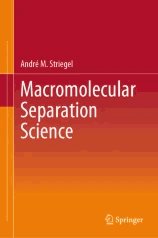
Macromolecular Separation Science (2025)
S
triegel A. MSpringer
ISBN: 978-3031830594 (Print)
696 pagesPublisher Description: This book provides a comprehensive guide to macromolecular separation science. It is unique in its in-depth combined coverage of the fundamentals and applications of each individual technique. This includes both widely employed as well as niche methods. It is also comprehensive regarding the instrumentation, especially but not limited to detectors, employed as well as the physical and chemical information obtained from various separations-detector couplings and also from multi-dimensional separations. Abundant figures and tables combine to illustrate each point. This book provides an indispensable guide for those working in the field of macromolecular separation science; to those seeking information about individual techniques; to polymer scientists and chromatographers in general; and to students, beginning practitioners, and experts alike.
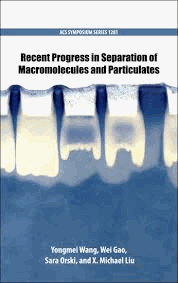
Recent Progress in Separation of Macromolecules and Particulates (2019)
Yongmei Wang, Wei Gao, Sara Orski, X. Michael Liu (Eds.)
ACS Symposium Series 1281
Publisher Description: Separation and characterization of materials is an essential step in the advancement of science and technology. The need for separation and characterization could arise from wishes to obtain purified samples with less contaminants, requirements for quality control of materials for downstream applications, or needs to identify structures and conformations of active species present in the applications. The types of materials encountered in applications are diverse, from synthetic polymers and biological derived biopolymers to micro or submicro particles and various conjugated or self-assembled nanomaterials. This makes the task of separation and characterization challenging. There is no one-size-fits-all approach. Scientists, whether working in academia or in industries, are constantly facing new challenges. Communication between scientists is essential for keeping each other updated on developments in the field. This was the motivation for organizing the symposium on "Recent Progress in Separation of Macromolecules and Particulates" at the 2017 Spring National American Chemical Society (ACS) Meeting in San Francisco. Symposiums based on such a theme have been organized several times in ACS meetings as well as in other settings, but no such symposium books have been published. Hence, the editors decided to put together this symposium book, based on the talks presented at the symposium, in the hope that knowledge shared at the meeting can be shared more broadly within the community and beyond.

Thermal Field-Flow Fractionation of Polymers (2019)
Guilaume Greyling, Harald Paschg
Springer
ISBN: 978-3-642-36079-4 (Print) 978-3-642-36080-0 (Online).
Publisher Description: This book introduces the reader to thermal field-flow fractionation and discusses its advantages over the fundamental problems associated with traditional column-based analytical techniques commonly used to characterize polymers and macromolecules. The authors discuss the theoretical background, equipment, experimental procedures as well as the recent advances and applications of thermal field-flow fractionation. Complete with several practical examples and troubleshooting guidelines, the book is written for beginners and experienced separation scientists alike and will enable its readers to optimize their experimental conditions for their specific separation needs and problems.

Multidimensional HPLC of Polymers (2013)
Harald Pasch, Bernd Trathnigg
Springer Laboratory
ISBN: 978-3-030-10649-2 (Print) 978-3-030-10650-8 (Online).
Publisher Description: This book presents the principle ideas of combining different analytical techniques in multi-dimensional analysis schemes. It reviews the basic principles and instrumentation of multi-dimensional chromatography and the hyphenation of liquid chromatography with selective spectroscopic detectors and presents experimental protocols for the analysis of complex polymers. It is the consequent continuation of "HPLC of Polymers" from 1999 by the same authors. Like its 'predecessor', this book discusses the theoretical background, equipment, experimental procedures and applications for each separation technique, but in contrast treats multi-dimensional and coupled techniques. "Multidimensional HPLC of Polymers" intends to review the state of the art in polymer chromatography and to summarize the developments in the field during the last 15 years. With its tutorial and laboratory manual style it is written for beginners as well as for experienced chromatographers, and will enable its readers (polymer chemists, physicists and material scientists, as well as students of polymer and analytical sciences) to optimize the experimental conditions for their specific separation problems.
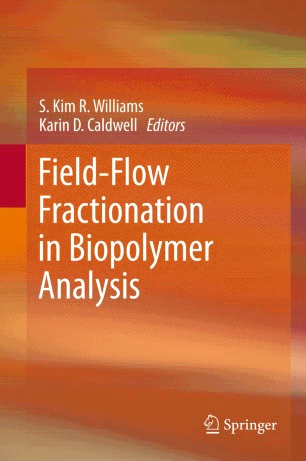
Field-Flow Fractionation in Biopolymer Analysis (2012)
S. Kim R. WilliamsKarin D. Caldwell
Springer
ISBN: 978-3-7091-0153-7 (Print) 978-3-7091-0154-4 (Online).
Publisher Description:
This is a timely collection of important biomedical applications for a set of separation/characterization techniques that are rapidly gaining popularity due to their wide dynamic range, high resolution, and ability to function in most commonly used solvent systems. Importantly, the field-flow fractionation (FFF) technique has recently emerged as a prominent complement to size exclusion chromatography for protein pharmaceuticals. Fractionation with FFF is gentle and preserves protein structural integrity better than existing alternatives. In the present text, different chapters are written by experts in their respective field of application, who offer comparisons between the FFF techniques and other methods for characterizing their special focus material. Practical guide-lines for successful implementation, such as choice of operating conditions, are offered in conjunction with each application. In addition to new instrumentation and approaches that address important current topics, readers are provided with an overall sense of prior (but timeless) major developments that may be overlooked in literature searches.
Stepan Podzimek
Wiley
ISBN:9780470386170 |Online ISBN:9780470877975 359 pages
Publisher Description: This book focuses on three important methods of polymer analysis: light scattering, size exclusion chromatography (SEC) and asymmetric flow field flow fractionation (A4F). These methods are important primarily in polymer science, but also in advanced materials science and emerging technologies. Readers will learn how light scattering measurements can easily provide absolute molar mass and size without any calibration or using reference standards and how its potential can be multiplied by the combination with a separation technique. Current users of conventional SEC will learn that a light scattering detector effectively solves the crucial problem of SEC, i.e. the column calibration, significantly improves reproducibility of SEC measurements and provides much additional information. In addition, they will see that A4F can overcome many traditional SEC problems, such as interactions of polymers with column packing, shearing degradation and limited separation of ultra-high molar mass polymers. The book also provides understanding the basic theory and principles of light scattering, SEC.

André M. Striegel, Wallace W. Yau, Joseph J. Kirkland, Donald D. Bly
Wiley
Publisher Description: The Second Edition of Modern Size-Exclusion Chromatography offers a complete guide to the theories, methods, and applications of size-exclusion chromatography. It provides an unparalleled, integrated, up-to-date treatment of gel permeation and gel filtration chromatography. With its detailed descriptions of techniques, data handling, compilations of information on columns and column packings, and tables of important solvents and reference materials, the book offers readers everything they need to take full advantage of this popular macromolecular characterization technique.

Multiple Detection in Size-Exclusion Chromatography (2004).
Andre M. Striegel (ed.)
ACS Symposium Series 893
Publisher Description: Multiple Detection in Size-Exclusion Chromatography provides a comprehensive view of detection techniques that are used synergistically in size-exclusion chromatography (SEC). These techniques include differential refractometry; static and dynamic light scattering; differential viscometry; fluorescence, ultraviolet, infrared, and nuclear magnetic resonance spectroscopy; electrospray ionization, matrix-assisted laser desorption ionization, chemical reaction interface, inductively coupled plasma, and tandem mass spectrometry; and dynamic surface tension. This book shows how these techniques provide useful molar mass, architectural, compositional, and thermodynamic information whether SEC is used as the sole separation method or as part of a two-dimensional chromatographic set-up. In the latter case, the ability to separate analytes based on size, provided by SEC, is augmented by separation based on chemical composition, block length, etc., provided by high performance liquid chromatography, liquid chromatography at the critical condition, phase fluctuation chromatography, or high osmotic pressure chromatography.

Handbook Of Size Exclusion Chromatography And Related Techniques. 2nd Ed. (2003)
Chi-San Wu (Editor)
CRC Press
Publisher Description: Documenting critical advances in this rapidly evolving field, the Second Edition highlights the need for new applications and technologies that assist in the determination of molecular weight and molecular weight distributions of polymers in an accurate, efficient manner. This volume presents the latest findings from a international team of specialists and continues to inspire and extend practical applications of size exclusion chromatography (SEC). It includes six new chapters covering high-speed size exclusion chromatography, SEC of low molecular weight materials, and the extended family of techniques, from two-dimensional liquid chromatography to high osmotic pressure chromatography.
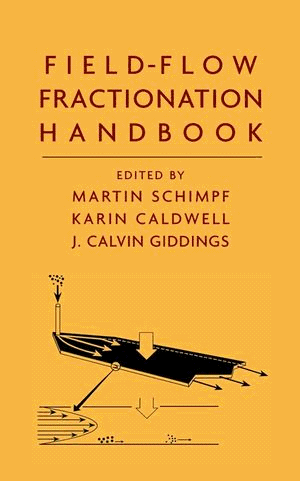
Field-Flow Fractionation Handbook (2000)
Martin E. Schimpf, Karin Caldwell, J. Calvin Giddings(Eds.)
Wiley
ISBN: 978-0-471-18430-0
616 PagesPublisher Description: Field flow fractionation (FFF) is an emerging separation technique, which has been proven successful in the analysis of pharmaceuticals, biotechnology products, polymers, soils, and foods, among others. In this book, Martin Schimpf joins forces with Karin Caldwell and J. Calvin Giddings, two of the primary developers of this technique, to bring you the first comprehensive, one-stop reference on the technique.

Size Exclusion Chromatography (1999)
Prof. Sadao Mori, Dr. Howard G. Barth
Springer Laboratory
ISBN: 978-3-642-08493-5 (Print) 978-3-662-03910-6 (Online)
Publisher Description: Although size exclusion chromatography (SEC) is perhaps the most popular and widely used technique for determining the molecular weight distribution of polymeric materials, there have been very few texts written on this topic. During the past decade, SEC has experienced a considerable amount of growth in regard to column and detector technology and new applications. With these advances, SEC can now be used for determining absolute molecular weight, polymer chain conformation and size, and branching, as well as polymer solution properties. This book introduces the reader to the fundamentals of SEC with emphasis on practical aspects of the technique, such as column and mobile selection, calibration, new detector capabilities and guidelines for performing SEC on most types of polymers, especially those of industrial importance. This book is intended for either those new to the field of SEC, or for those research workers who require a more comprehensive background.

Column Handbook for Size Exclusion Chromatography (1999)
Chi-san Wu
Academic Press
ISBN: 0127655557
Publisher Description: This is the first comprehensive reference to provide everything one needs to know about commercial analytical and preparative columns for size exclusion and gel filtration chromatography (SEC and GFC). SEC is now widely used as a quality assurance method in the polymer industry (both synthetic and biopolymers) to determine molecular weight and molecular weight distribution. The Handbook contains contributions from every column manufacturer around the world and from many experienced column users. It covers the technology, characterization, application, evaluation, maintenance, and quality control of analytical and preparative columns for SEC and GFC. Also included are columns for two closely related techniques, hydrodynamic chromatography and high osmotic pressure chromatography.

Chromatography of Polymers. Hyphenated and Multidimensional Techniques (1999)
Theodore Provder (Editor)
ACS Symposium Series 731
ISBN13: 9780841236615
Publisher Description: This book covers recent advances in hyphenated and multidimensional chromatographic techniques for elucidating the structure, composition, molecular weight, and branching distributions in complex polymers. It describes a variety of detectors along with associated data analysis methods and combines these with site-exclusion chromatography, field flow fractionation methods, and liquid chromatographic methods. It applies these methods to a wide range of polymeric materials.

Strategies in Size Exclusion Chromatography (1996)
Martin Potschka, Paul L. Dubin (Editors)
ACS Symposium Series 635
ISBN-10: 0841234140
Publisher Description: Examines size exclusion chromatography technology from both the detector-focused and column-focused approaches. Provides fundamental information on the mechanism of size exclusion chromatography Reparations. Addresses special topics in size exclusion chromatography, including characterization of copolymers, inverse size exclusion chromatography, aggregating polymers, polysaccharides, and proteins.

Chromatography of Polymers Characterization by SEC and FFF (1993)
Theodore Provder (Editor)
ACS Symposium Series 521
Publisher Description: Covers current developments in sedimentation and thermal field flow fractionation for particle size analysis, and characterization of polymer molecular-weight distribution. Presents fundamental studies on critical conditions in liquid chromatography, single-parameter approach to universal SEC calibration, and compositional characterization of polyolefin copolymers as a function of molecular weight and bunching. Provides a strategy for interpreting multidetector size exclusion chromatography (SEC) data. Reviews SEC for cationic, anionic, and nonionic copolymers of vinylpyrrolidone. Presents applications of SEC for the characterization of natural polymer products, cotton, and polysaccharides.

Aqueous Size-Exclusion Chromatography (1988)
Paul L. Dubin (Editor)
Elsevier
ISBN: 0444429573
Publisher Description: The rapid development of new packings for aqueous size-exclusion chromatography has revolutionized this field. High resolution non-adsorptive columns now make possible the efficient separation of proteins and the rapid and precise determination of the molecular weight distribution of synthetic polymers. This technology is also being applied to the separation of small ions, the characterization of associating systems, and the measurement of branching. At the same time, fundamental studies are elucidating the mechanisms of the various chromatographicprocesses. These developments in principles and applications are assembled for the first time in this book. Fundamental issues are dealt with: the roles of pore structure and macromolecular dimensions, hydrophobic and electrostatic effects, and the determination and control of column efficiency. High-performance packings based on derivatized silica are reviewed in detail. Special techniques are thoroughly described, including SEC/LALLS, inverse exclusion chromatography, and frontal zone chromatography.

Theodore Provder (Editor)
ACS Symposium Series 245
ISBN13: 9780841208261
Description (From Book Preface): This volume deals with the methodology involved in the practice of SEC from both a theoretical and a pragmatic perspective along with the application of this methodology to the characterization of polymers and related materials. The three sections reflect the major efforts in the field over the last 3 years.

Modern Size-Exclusion Liquid Chromatography: Practice of Gel Permeation and Gel Filtration Chromatography. 1st Ed. (1979)
Wallace W. Yau, Joseph J. Kirkland, Donald D. Bly
Wiley
ISBN-13: 9780471033875 496 pages
Publisher Description: A critical treatment of all aspects, containing definitive examples, detailed description of data handling, compilations of information on columns and column packings, and tables of important solvents and standard reference materials. Combines a basic, unified theory with practical know-how, integrating methods of gel permeation and gel filtration chromatography. Provides an understanding of molecular characterization problems as well as a background for developing new and improved characterization methods and apparatus for HPSEC performed with columns of small particles at high pressures.
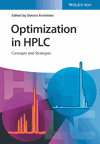
Stavros Kromidas (Ed.)
Wiley
ISBN: 978-3-527-34789-6 (Print)
393 PagesPublisher Description: Optimization in HPLC: Concepts and Strategies delivers tried-and-tested strategies for optimizing the performance of HPLC and UHPLC systems for a wide variety of analytical tasks. The book explains how to optimize the different HPLC operation modes for a range of analyses, including small molecules, chiral substances, and biomolecules. It also shows readers when and how computational tools may be used to optimize performance.The practice-oriented text describes common challenges faced by users and developers of HPLC and UHPLC systems, as well as how those challenges can be overcome. Written for first-time and experienced users of HPLC technology and keeping pace with recent developments in HPLC instrumentation and operation modes, this comprehensive guide leaves few questions unanswered.
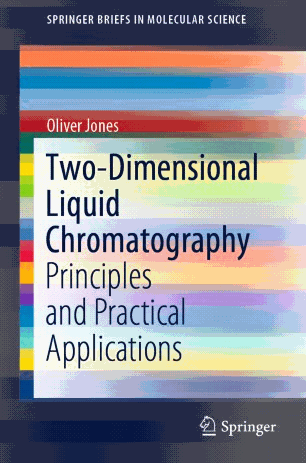
Two-Dimensional Liquid Chromatography. Principles and Practical Applications (2020)
Oliver Jones
Springer
ISBN: 978-981-15-6190-0 (Print) 86 Pages
Publisher Description: This book addresses the growing interest in the field of two-dimensional liquid chromatography (2DLC), a powerful approach to increasing resolution, available peak capacity, and selectivity in analytical chromatography. 2DLC is suitable for many applications, including in the pharmaceutical and polymer industries and the omic sciences (metabolomics, lipidomics and proteomics). Thanks to recent advances in technology and software the instrumentation needed to perform 2D-LC is broadly available to the analytical community in both industry and academia. Indeed, the technique can now be considered ready for application in R&D as well as in QA and QC labs, yet it is not widely known about outside academic laboratories and is rarely taught at the undergraduate level. This book outlines the main principles and features of 2D-LC (including comprehensive and heart-cutting modes, method development and real world applications) to enable modern analysts to start using this fascinating technique. The book offers an ideal starting point for those wishing to get into 2D-LC and will also be of interest to more experienced scientists in the field.
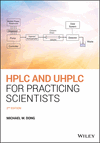
HPLC and UHPLC for Practicing Scientists. 2nd Ed. (2019)
Michael Dong
Wiley
ISBN: 9781119313762 382 pages
Publisher Description: A concise yet comprehensive reference guide on HPLC/UHPLC that focuses on its fundamentals, latest developments, and best practices in the pharmaceutical and biotechnology industries. Written for practitioners by an expert practitioner, this new edition of HPLC and UHPLC for Practicing Scientists adds numerous updates to its coverage of high-performance liquid chromatography, including comprehensive information on UHPLC (ultra-high-pressure liquid chromatography) and the continuing migration of HPLC to UHPLC, the modern standard platform. In addition to introducing readers to HPLC’s fundamentals, applications, and developments, the book describes basic theory and terminology for the novice, and reviews relevant concepts, best practices, and modern trends for the experienced practitioner. HPLC and UHPLC for Practicing Scientists, Second Edition offers three new chapters. One is a standalone chapter on UHPLC, covering concepts, benefits, practices, and potential issues. Another examines liquid chromatography/mass spectrometry (LC/MS). The third reviews at the analysis of recombinant biologics, particularly monoclonal antibodies (mAbs), used as therapeutics. While all chapters are revised in the new edition, five chapters are essentially rewritten (HPLC columns, instrumentation, pharmaceutical analysis, method development, and regulatory aspects). The book also includes problem and answer sections at the end of each chapter.

Hydrophilic Interaction Chromatography: A Guide for Practitioners (2013)
Bernard A. Olsen, Brian W. Pack (Eds.)
Wiley
ISBN: 9781118054178 336 pages
Publisher Description: An increasingly popular analytical method, hydrophilic interaction chromatography (HILIC) has the ability to retain and separate polar compounds that are often difficult to analyze by reversed-phase high-performance liquid chromatography (HPLC) or other analytical methods. Offering a comprehensive review, this book enables readers to develop a fundamental understanding of how HILIC works and then apply that knowledge to develop and implement a variety of practical applications.
Hydrophilic Interaction Chromatography begins with discussions of HILIC retention mechanisms, stationary phases, and general method development. This sets the foundation for the book's extensive coverage of applications. The authors address unique separation challenges for bioanalytical, environmental, pharmaceutical, and biochemical applications. Moreover, there is a thorough discussion of HILIC in two-dimensional chromatography.

Liquid Chromatography. Applications (2013)
Salvatore Fanali, Paul R. Haddad, Colin Poole, Peter Schoenmakers and David K. Lloyd (E)ditors
Elsevier
ISBN: 9783527306435 458 Pages
Publisher Description: A single source of authoritative information on all aspects of the practice of modern liquid chromatography suitable for advanced students and professionals working in a laboratory or managerial capacity.

Veronika R. Meyer
Wiley
ISBN: 978-0-470-68218-0 426 pages
Publisher Description: Three decades on from publication of the 1st German edition of Veronika Meyer's book on HPLC, this classic text remains one of the few titles available on general HPLC aimed at practitioners.

Lloyd R. Snyder, Joseph J. Kirkland, John W. Dolan
Wiley
ISBN-10: 0470167548 960 pages
Publisher Description: This carefully considered Third Edition maintains the strengths of the previous edition while significantly modifying its organization in light of recent research and experience. The text begins by introducing the reader to HPLC, its use in relation to other modern separation techniques, and its history. Designed to fulfill the needs of the full range of HPLC users, from novices to experts, Introduction to Modern Liquid Chromatography, Third Edition offers the most up-to-date, comprehensive, and accessible survey of HPLC methods and applications available.

Validating Chromatographic Methods: A Practical Guide (2006)
David M. Bliesner
Wiley
ISBN:9780471741473 291 Pages
Publisher Description: Validating Chromatographic Methods brings order and Current Good Manufacturing Practices to the often chaotic process of chromatographic method validation. It provides readers with both the practical information and the tools necessary to successfully set up a new validation system or upgrade a current system to fully comply with government safety and quality regulations. The net results are validated and transferable analytical methods that will serve for extended periods of time with minimal or no complications.
This guide focuses on high-performance liquid chromatographic methods validation; however, the concepts are generally applicable to the validation of other analytical techniques as well. Following an overview of analytical method validation and a discussion of its various components, the author dedicates a complete chapter to each step of validation: * Method evaluation and further method development * Final method development and trial method validation * Formal method validation and report generation * Formal data review and report issuance. Templates and examples for Methods Validation Standard Operating Procedures, Standard Test Methods, Methods Validation Protocols, and Methods Validation Reports are all provided. Moreover, the guide features detailed flowcharts and checklists that lead readers through every stage of method validation to ensure success. All of the templates are also included on a CD-ROM, enabling readers to easily work with and customize them.

Veronika R. Meyer
Wiley
Print ISBN: 9780470093771 374 pages
Publisher Description: Veronika Meyer's book on HPLC is a classic text and remains one of the few titles available on general HPLC. Following on from the success of the previous three editions, this new, fourth edition continues to provide users of HPLC in industry, government, and service laboratories, as well as postgraduate students, with a unified approach to HPLC and an equal treatment of the theory and practice of this important technique.

Lloyd Lloyd R. Snyder
Wiley
ISBN: 0471706469 496 pages
Publisher Description: Of the various ways in which chromatography is applied today, few have been as misunderstood as the technique of gradient elution, which presents many challenges compared to isocratic separation. When properly explained, however, gradient elution can be less difficult to understand and much easier to use than often assumed. Written by two well-known authorities in liquid chromatography, High-Performance Gradient Elution: The Practical Application of the Linear-Solvent-Strength Model takes the mystery out of the practice of gradient elution and helps remove barriers to the practical application of this important separation technique. The book presents a systematic approach to the current understanding of gradient elution, describing theory, methodology, and applications across many of the fields that use liquid chromatography as a primary analytical tool.

Marvin C. McMaster
Wiley
Print ISBN: 9780471754015 Online ISBN: 9780470079096 253 pages
Publisher Description: This Second Edition of the classic handbook details how to set up an HPLC system that capitalizes on the latest innovations. It covers new techniques in high-temperature, micro-flow, and ultra-fast chromatography, the linking of an HPLC to a mass spectrometer, and more. Complete with a CD-ROM and appendices, this guide has everything chromatographers need to know to confidently separate, identify, purify, and quantify compounds. Note: CD-ROM/DVD and other supplementary materials are not included as part of eBook file.

Preparative Chromatography: of Fine Chemicals and Pharmaceutical Agents (2005)
Prof. Dr.-Ing. Henner Schmidt-Traub (Ed.)
Wiley
ISBN: 978-0-12-415806-1 688 Pages
Publisher Description: This interdisciplinary approach combines the chemistry and engineering involved to describe the conception and improvement of chromatographic processes. The book covers recent developments in preparative chromatographic processes for the separation of "smaller" molecules using standard laboratory equipment as well as the detailed conception of industrial chemical plants. Following an introductory section on the history of chromatography, the current state of research and the design of chromatographic processes, the book goes on to define the general terminology. There then follow sections on solid materials and packed columns process concepts. Final chapters on modeling and determination of model parameters, the design and optimization of preparative chromatographic processes and chromatographic reactors allow for the optimum selection of chromatographic systems. Essential for chemists and engineers working in the chemicals and pharmaceutical industries as well as for food technologies, due to the interdisciplinary nature of these processes.

Practical HPLC Method Development. 2nd Ed. (1997)
Lloyd R. Snyder, Joseph J. Kirkland, Joseph L. Glajch
Wiley-Interscience
ISBN-10: 047100703X 800 pages
Publisher Description:This revision brings the reader completely up to date on the evolving methods associated with increasingly more complex sample types analyzed using high-performance liquid chromatography, or HPLC. The book also incorporates updated discussions of many of the fundamental components of HPLC systems and practical issues associated with the use of this analytical method. This edition includes new or expanded treatments of sample preparation, computer assisted method development, as well as biochemical samples, and chiral separations.
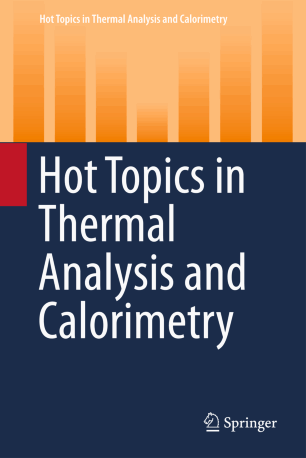
Hot Topics in Thermal Analysis and Calorimetry (Springer). 10 Volumes (2001-2014)
Publisher Description: The aim of this series is to summarize the most current topics in thermal analysis through contributions from outstanding authors. The advantage of these comprehensive books is that they collate information from current and selected fields, evaluate the results and discuss future trends. This provides important information to everyday scientists through the discussion and presentation of new findings for a range of topics sourced from all over the world. Topics include: Pharmaceuticals; Foods; Environmental research; Nanocomposites; Composit materials; Thinfilms; Bio and life-sciences to name just a few.
Handbook of Thermal Analysis and Calorimetry (Elsevier Science). 6 Volumes (1998-2018)
Publisher Description: This series, edited by world-renowned thermal analyst Prof. Patrick K. Gallagher, constitutes an enormously valuable resource to anyone involved with the characterization of thermal properties of materials. The reader will surely enjoy this up-to-date presentation of theory, fundamentals and diverse applications.
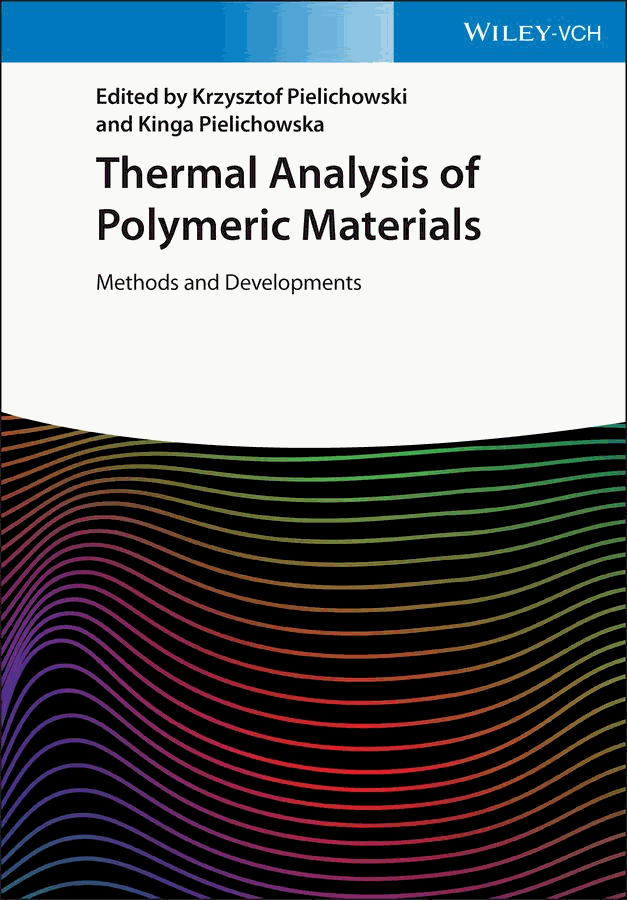
Thermal Analysis of Polymeric Materials: Methods and Developments (2022)
Krzysztof Pielichowski, Kinga Pielichowska (Ed
s.).Springer
ISBN: 978-3-527-82869-2
688 PagesPublisher Description:
This book delivers a detailed understanding of the thermal behavior of polymeric materials evaluated by thermal analysis methods. It covers the most widely applied principles which are used in method development to substantiate what happens upon heating of polymers. It also reviews the key application areas of polymers in materials science. Edited by two experts in the field, the book covers a wide range of specific topics within the aforementioned categories of discussion, such as: Crucial thermal phenomena - glass transition, crystallization behavior and curing kineticsPolymeric materials that have gained considerable interest over the last decade
The latest advancements in techniques related to the field, such as modulated temperature DSC and fast scanning calorimetry
The recent advances in hyphenated techniques and their applications
Polymer chemists, chemical engineers, materials scientists, and process engineers can use this comprehensive reference work to gain clarity on the topics discussed within and learn how to harness them in practical applications across a wide range of disciplines

Dynamic Mechanical Analysis: A Practical Introduction. 3rd Ed. (2020)
Kevin P. Menard
ISBN 280 Pages
CRC Press
Publisher
Description: Dynamic
Mechanical Analysis (DMA) is a powerful technique for understanding the
viscoelastic properties of materials. It has become a powerful tool for
chemists, polymer and material scientists, and engineers. Despite this, it often
remains underutilized in the modern laboratory. Because of its high sensitivity
to the presence of the glass transition, many users limit it to detecting glass
transitions that can’t be seen by differential scanning calorimetry (DSC).
This book presents a practical and straightforward approach to understanding how
DMA works and what it measures. Starting with the concepts of stress and strain,
the text takes the reader through stress–strain, creep, and thermomechanical
analysis. DMA is discussed as both the instrument and fixtures as well as the
techniques for measuring both thermoplastic and thermosetting behavior. This
edition offers expanded chapters on these areas as well as frequency scanning
and other application areas. To help the reader grasp the material, study
questions have also been added. Endnotes have been expanded and updated.
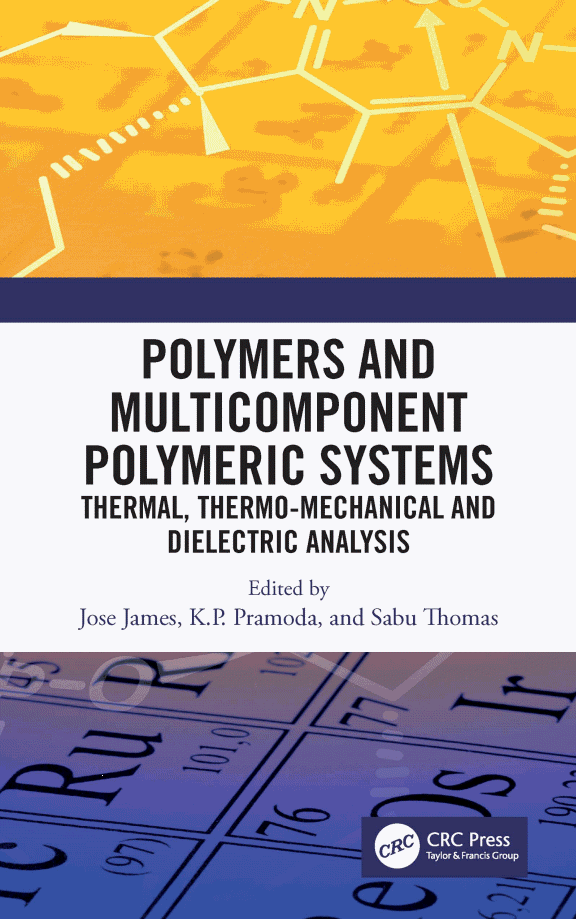
Jose James, Pramoda Kumari, Pallathadka, Sabu Thomas
ISBN 294 Pages
CRC Press
Publisher Description: In recent years, multicomponent polymers have generated much interest due to their excellent properties, unique morphology, and high-end applications. This book focuses on thermal, thermo-mechanical, and dielectric analysis of polymers and multicomponent polymeric systems such as blends, interpenetrating polymeric networks (IPNs), gels, polymer composites, and nanocomposites. Through these analyses, it provides an insight into the stability of polymer systems as a function of time, processing, and usage. Aimed at polymer chemists, physicists, and engineers, it also covers ASTM/ISO and other standards of various measurement techniques for systematic analysis in materials science.
Springer
ISBN 978-3-030-39961-0 2
66 pagesPublisher Description:

Leo Razdolsky
CRC Press
ISBN 414 pages
Publisher Description: The use of new engineering materials in the aerospace and space industry is usually governed by the need for enhancing the bearing capacity of structural elements and systems, improving the performance of specific applications, reducing structural weight and improving its cost-effectiveness. Crystalline composites and nanomaterials are used to design lightweight structural elements because such materials provide stiffness, strength and low density/weight. This book reviews the effect of high temperature creep on structural system response, and provides new phenomenological creep models (deterministic and probabilistic approach) of composites and nanomaterials. Certain criteria have been used in selecting the creep functions in order to describe a wide range of different behavior of materials. The experimental testing and evaluation of time variant creep in composite and nanomaterials is quite complex, expensive and, at times, time consuming. Therefore, the analytical analysis of creep properties and behavior of structural elements made of composite and nanocomposite materials subjected to severe thermal loadings conditions is of great practical importance. Composite elements and heterogeneous materials, from which they are made, make essential changes to the classical scheme for constructing the phenomenological creep model of composite elements, because it reflects the specificity of the composite material and manifests itself in the choice of two basic functions of the creep constitutive equation, namely memory and instantaneous modulus of elasticity functions. As such, the concepts and analytical techniques presented here are important. But the principal objective of this book is to demonstrate how nonlinear viscoelastic engineering creep theory can be incorporated into the general theory of mechanics of materials so that composite components can be designed and analyzed. The results are supported by step-by-step practical structural design examples and will be useful for structural engineers, code developers as well as material science researchers and university faculty. The phenomenological creep models presented in this book provide a usable engineering approximation for many applications in composite engineering.
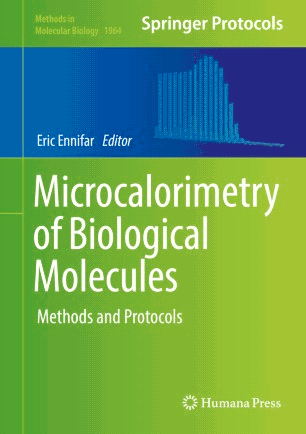
Microcalorimetry of Biological Molecules. Methods and Protocols (2019)
Eric Ennifar Ed.
Springer
ISBN 978-1-4939-9178-5 264 Pages
Publisher Description:
This volume provides methods on microcalorimetry approaches to investigate complex biological molecular systems. Chapters guide readers through Differential Scanning Calorimetry (DSC), Isothermal Titration Calorimetry (ITC), and advanced data processing. Written in the highly successful Methods in Molecular Biology series format, chapters include introductions to their respective topics, lists of the necessary materials and reagents, step-by-step, readily reproducible laboratory protocols, and tips on troubleshooting and avoiding known pitfalls.
Authoritative and practical, Microcalorimetry of Biological Molecules: Methods and Protocols aims to ensure successful results in the further study of this vital field.
Sergey Vyazovkin Nobuyoshi Koga Christoph Schick (eds)
Elsevier Science
ISBN 9780444640628 840 pages
Publisher Description: Volume Six, Second Edition, presents the latest in a series that has been well received by the thermal analysis and calorimetry community. This volume covers recent advances in techniques and applications that complement the earlier volumes. There has been tremendous progress in the field in recent years, and this book puts together the most high-impact topics selected for their popularity by new editors Sergey Vyazovkin, Nobuyoshi Koga and Christoph Schick—all editors of Thermochimica Acta. Among the important new techniques covered are biomass conversion; sustainable polymers; polymer nanocompsoties; nonmetallic glasses; phase change materials; propellants and explosives; applications to pharmaceuticals; processes in ceramics, metals, and alloys; ionic liquids; fast-scanning calorimetry, and more.

Titration Calorimetry. From Concept to Application (2018)
L. D. HansenMark K. TranstrumColette F. Quinn (Eds.)
Springer
ISBN 978-3-319-78249-2 60 pages
Publisher Description: This Brief describes the calibration of titration calorimeters (ITCs) and calculation of stoichiometry, equilibrium constants, enthalpy changes, and rate constants for reactions in solution. A framework/methodology for model development for analysis of ITC data is presented together with methods for assessing the uncertainties in determined parameters and test data sets. This book appeals to beginners, as well as to researchers and professionals in the field.
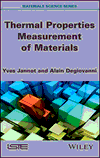
Thermal Properties Measurement of Materials (2018)
Y. Jannot, A. Degiovanni
Wiley
ISBN 9781786302557 334 pages
Publisher Description: This book presents the main methods used for thermal properties measurement. It aims to be accessible to all those, specialists in heat transfer or not, who need to measure the thermal properties of a material. The objective is to allow them to choose the measurement method the best adapted to the material to be characterized, and to pass on them all the theoretical and practical information allowing implementation with the maximum of precision.
 Thermal Analysis
in Practice. Fundamental Aspects (2017)
Thermal Analysis
in Practice. Fundamental Aspects (2017)
Matthias Wagner
Hanser Verlag
ISBN 978-1-56990-643-9 349 Pages
Publisher Description: Thermal analysis comprises a group of techniques used to determine the physical or chemical properties of a substance as it is heated, cooled, or held at constant temperature. It is particularly important for polymer characterization, but also has major application in analysis of pharmaceuticals and foodstuffs.
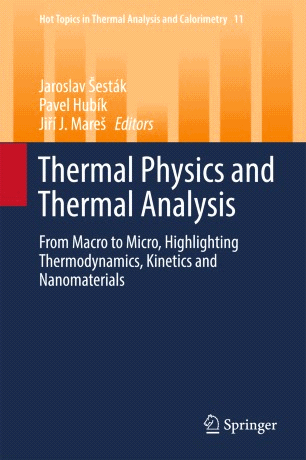
J. Šesták, P. Hubík, J.J. Mareš (Eds.)
Springer
ISBN 978-3-319-45897-7 585 pages
Publisher Description: Features twenty-five chapter contributions from an international array of distinguished academics based in Asia, Eastern and Western Europe, Russia, and the USA. This multi-author contributed volume provides an up-to-date and authoritative overview of cutting-edge themes involving the thermal analysis, applied solid-state physics, micro- and nano-crystallinity of selected solids and their macro- and microscopic thermal properties. Distinctive chapters featured in the book include, among others, calorimetry time scales from days to microseconds, glass transition phenomena, kinetics of non-isothermal processes, thermal inertia and temperature gradients, thermodynamics of nanomaterials, self-organization, significance of temperature and entropy. Advanced undergraduates, postgraduates and researchers working in the field of thermal analysis, thermophysical measurements and calorimetry will find this contributed volume invaluable. This is the third volume of the triptych volumes on thermal behaviour of materials; the previous two receiving thousand of downloads guaranteeing their worldwide impact.
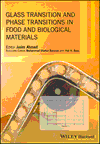
Glass Transition and Phase Transitions in Food and Biological Materials (2017)
J. Ahmed (Ed.)
Wiley
ISBN 9781118935729 477 pages
Publisher Description: Glass and State Transitions in Food and Biological Materials describes how glass transition has been applied to food micro-structure, food processing, product development, storage studies, packaging development and other areas. This book has been structured so that readers can initially grasp the basic principles and instrumentation, before moving through the various applications. In summary, the book will provide the “missing link” between food science and material science/polymer engineering. This will allow food scientists to better understand the concept and applications of thermal properties.
 Principles
of Thermal Analysis and Calorimetry (2nd Ed) (2016)
(knovel.com link) (2016)
Principles
of Thermal Analysis and Calorimetry (2nd Ed) (2016)
(knovel.com link) (2016)
Simon Gaisford, Vicky Kett, Peter Haines(Eds.)
RSC
ISBN 1782620516 / ISBN-13: 9781782620518 280 pages
Publisher Description: The use of thermal and calorimetric methods has shown rapid growth over the past few decades, in an increasingly wide range of applications. The original text was published in 2001; since then there have been significant advances in various analytical techniques and their applications. This second edition supplies an up to date, concise and readable account of the principles, experimental apparatus and practical procedures used in thermal analysis and calorimetric methods of analysis. Written by experts in their field, brief accounts of the basic theory are reinforced with detailed technical advances and contemporary developments. Where appropriate, applications are used to highlight particular operating principles or methods of interpretation. As an important source of information for many levels of readership in a variety of areas, this book will be an aid for students and lecturers through to industrial and laboratory staff and consultants.
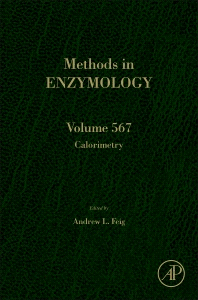
Calorimetry, Methods in Enzymology Vol. 567 (2016)
A.L. Feig (ed)
Elsevier Science
ISBN 9780128029060 530 pages
Publisher Description: Calorimetry, the latest volume in the Methods in Enzymology series continues the legacy of this premier serial with quality chapters authored by leaders in the field. Calorimetry is a highly technical experiment and it is easy for new practioners to get fooled into interpreting artifacts as real experimental results. This volume will guide readers to get the most out of their precious biological samples and includes topics on specific protocols for the types of studies being conducted as well as tips to improve the data collection. Most importantly, the chapters will also help to identify pitfalls that need to be avoided to ensure that the highest quality results are obtained.
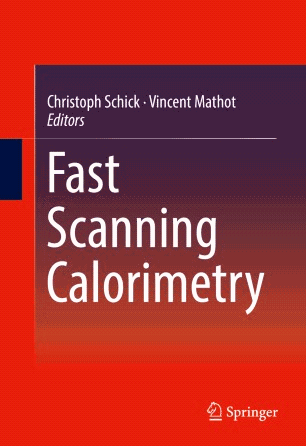
Fast Scanning Calorimetry (2016)
C. Schick,V. Mathot (Eds.)
Springer
ISBN 978-3-319-31327-6 796 pages
Publisher Description: In the past decades, the scan rate range of calorimeters has been extended tremendously at the high end, from approximately 10 up to 10 000 000 °C/s and more. The combination of various calorimeters and the newly-developed Fast Scanning Calorimeters (FSC) now span 11 orders of magnitude, by which many processes can be mimicked according to the time scale(s) of chemical and physical transitions occurring during cooling, heating and isothermal stays in case heat is exchanged. This not only opens new areas of research on polymers, metals, pharmaceuticals and all kinds of substances with respect to glass transition, crystallization and melting phenomena, it also enables in-depth study of metastability and reorganization of samples on an 1 to 1000 ng scale. In addition, FSC will become a crucial tool for understanding and optimization of processing methods at high speeds like injection molding. The book resembles the state-of-the art in Thermal Analysis & Calorimetry and is an excellent starting point for both experts and newcomers in the field.
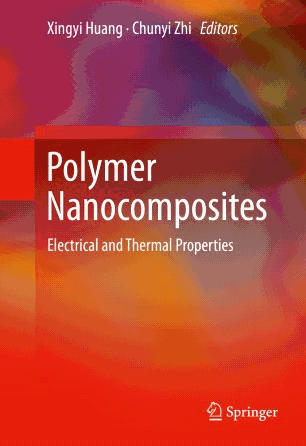
Polymer Nanocomposites. Electrical and Thermal Properties (2016)
X. Huang, C. Zhi (Eds.)
Springer
ISBN 978-3-319-28236-7 354 pages
Publisher Description: This book focuses on the fundamental principles and recent progress in the field of electrical and thermal properties of polymer nanocomposites. The physical and chemical natures determining the electrical and thermal properties of polymer nanocomposites are discussed in detail. The authors describe the range of traditional and emerging polymer nanocomposites from nanoparticle and polymer composites to novel nanostructure based polymer nanocomposites. They include novel properties and potential applications, such as high-k, low-k, high thermal conductivity, antistatic, high voltage insulation, electric stress control, and thermal energy conversion among others.
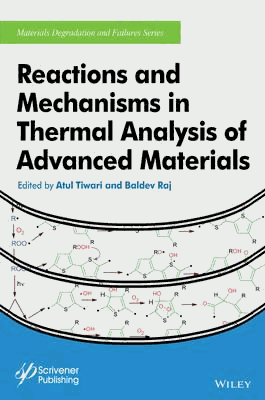
Reactions and Mechanisms in Thermal Analysis of Advanced Materials (2015)
Atul Tiwari, Baldev Raj ((Eds.)
Wiley-Scrivener Publishing
ISBN 9781119117575 Online ISBN: 9781119117711 304 pages
Publisher Description: Strong bonds form stronger materials. For this reason, the investigation on thermal degradation of materials is a significantly important area in research and development activities. The analysis of thermal stability can be used to assess the behavior of materials in the aggressive environmental conditions, which in turn provides valuable information about the service life span of the materiel.
Unlike other books published so far that have focused on either the fundamentals of thermal analysis or the degradation pattern of the materials, this book is specifically on the mechanism of degradation of materials.
The mechanism of rapturing of chemical bonds as a result of exposure to high-temperature environment is difficult to study and resulting mechanistic pathway hard to establish. Limited information is available on this subject in the published literatures and difficult to excavate.
Chapters in this book are contributed by the experts working on thermal degradation and analysis of the wide variety of advanced and traditional materials. Each chapter discusses the material, its possible application, behavior of chemical entities when exposed to high-temperature environment and mode and the mechanistic route of its decomposition. Such information is crucial while selecting the chemical ingredients during the synthesis or development of new materials technology.

Calorimetry: Fundamentals, Instrumentation and Application (2015)
Stefan M. Sarge, Günther W. H. Höhne, Wolfgang Hemminger
Wiley-VCH
ISBN 9783527327614 304 pages
Publisher Description: Clearly divided into three parts, this practical book begins by dealing with all fundamental aspects of calorimetry. The second part looks at the equipment used and new developments. The third and final section provides measurement guidelines in order to obtain the best results.

Thermal Degradation of Polymer Blends, Composites and Nanocomposites (2015)
P. M. Visakh, Yoshihiko Arao (Eds.)
Springer
ISBN 978-3-319-03463-8 250 pages
Publisher Description: This book delivers a deep insight into thermal polymer degradation features and put a particular emphasis on blends, composites and nanocomposites. It examines the thermal stability and the mechanism of degrading for every class of polymer substances and studies the effect on reinforcement to all classes. The book further explores the thermal stability when nano particles are added and summarizes the latest studies and application relevant results. This book offers a valuable reference source to graduate and post graduate students, engineering students, research scholars and polymer engineers from industry.

Wilfried Litz
Springer
ISBN 9783527327614 243 pages
Publisher Description: This book describes new and efficient calorimetric measurement methods, which can be used to accurately follow the chemical kinetics of liquid phase reaction systems. It describes apparatus and techniques for the precise measuring of the rate of heat liberation in discontinuous and continuous isothermal as well as non-isothermal reactions. The presented methodology can be used to follow the development of chemical reactions online, even in industrial scales.

Differential Scanning Calorimetry: Applications in Fat and Oil Technology (2014)
Emma Chiavaro
CRC Press
ISBN 1466591528 301 pages
Publisher Description: Provides a complete summary of the scientific literature about differential scanning calorimetry (DSC), a well-known thermo-analytical technique that currently has a large set of applications covering several aspects of lipid technology.The book is divided into three major sections. The first section covers the applications of DSC to study cooling and heating profiles of the main source of oils and fats. The second is more theoretical, discussing the application of DSC coupled to related thermal techniques and other physical measurements. And the third covers specific applications of DSC in the field of quality evaluation of palm, palm kernel, and coconut oils and their fractions as well as of some other important aspects of lipid technology such as shortening and margarine functionality, chocolate technology, and food emulsion stability..

Imre Miklós Szilágyi, György Liptay (Editors)
Springer
ISBN 978-3-319-09485-4 (Print) 978-3-319-09486-1 (Online) 356 pages
From The Back Cover: This is an expanded and revised second edition, presenting accurate and comprehensive information about our leading thermal scientists to current and future generations. In our globalized world, most researchers in thermal analysis do not know each other in person and are not familiar with each other’s achievements. This volume provides the reader with an up-to-date list of the prominent members in this community. The publication contains only living scientists. The selection is based partly on several decades of the editors' personal professional experience and also partly on the opinion of the Regional Editors of the Journal of Thermal Analysis and Calorimetry..

Jaroslav Šesták, Peter Šimon (Editors)
Springer
ISBN 978-90-481-3149-5 (Print) 978-90-481-3150-1 (Online) 497 Pages
From The Back Cover: Thermal Analysis of Micro-, Nano- and Non-Crystalline Materials: Transformation, Crystallization, Kinetics and Thermodynamics complements and adds to volume 8 Glassy, Amorphous and Nano-Crystalline Materials by providing a coherent and authoritative overview of cutting-edge themes in the field of crystalline materials. In particular, the book focuses on reaction thermodynamics and kinetics applied to solid-state chemistry and thermal physics of various states of materials. In this volume the fundamental and historical aspects of phenomenological kinetics and the equilibrium background of processes are detailed. Crystal defects, non-stoichiometry and nano-crystallinity, reduced glass-transition temperatures and glass-forming coefficients are covered. The determination of the glass transition by DSC, the role of heat transfer and phase transition in DTA experiments, and the explanation of DTA/DSC methods used for the estimation of crystal nucleation are reviewed. Structural relaxation and viscosity behaviour in glass and associated relaxation kinetics are also examined, together with the influence of preliminary nucleation and coupled phenomenological kinetics nucleation on both the strongly curved surfaces and nano-particles. The book investigates crystallization of glassy and amorphous materials including oxides, chalcogenides and metals, non-parametric and fractal description of kinetics, disorder and dimensionality in nano-crystalline diamond. Moreover, it analyzes thermal analysis of waste glass batches, amorphous inorganic polysialates and bioactivity of hydroxyl groups as well as reaction kinetics and unconventional glass formability of oxide superconductors.

Calorimetry and Thermal Methods in Catalysis (2013)
Aline Auroux
Springer
ISBN 978-3-642-11953-8 561 pages
Publisher Description: The book is about calorimetry and thermal analysis methods, alone or linked to other techniques, as applied to the characterization of catalysts, supports and adsorbents, and to the study of catalytic reactions in various domains: air and wastewater treatment, clean and renewable energies, refining of hydrocarbons, green chemistry, hydrogen production and storage. The book is intended to fill the gap between the basic thermodynamic and kinetics concepts acquired by students during their academic formation, and the use of experimental techniques such as thermal analysis and calorimetry to answer practical questions. Moreover, it supplies insights into the various thermal and calorimetric methods which can be employed in studies aimed at characterizing the physico-chemical properties of solid adsorbents, supports and catalysts, and the processes related to the adsorption desorption phenomena of the reactants and/or products of catalytic reactions. The book also covers the basic concepts for physico-chemical comprehension of the relevant phenomena. Thermodynamic and kinetic aspects of the catalytic reactions can be fruitfully investigated by means of thermal analysis and calorimetric methods, in order to better understand the sequence of the elemental steps in the catalysed reaction. So the fundamental theory behind the various thermal analysis and calorimetric techniques and methods also are illustrated..

Glass Transition, Dynamics and Heterogeneity of Polymer Thin Films (2013)
T. Kanaya (Ed.)
Springer
ISBN 978-3-642-34338-4 (Print) 978-3-642-34339-1 (Online) 150 pages
From The Back Cover: Mobility Gradient of Polystyrene in Films Supported on Solid Substrates, by Yoshihisa Fujii, Hiroshi Morita, Atsushi Takahara and Keiji Tanaka Probing Properties of Polymers in Thin Films Via Dewetting, by Günter Reiter Heterogeneous and Aging Dynamics in Single and Stacked Thin Polymer Films, by Koji Fukao, Takehide Terasawa, Kenji Nakamura, Daisuke Tahara Heterogeneous Dynamics of Polymer Thin Films as Studied by Neutron Scattering, by Rintaro Inoue and Toshiji Kanaya.
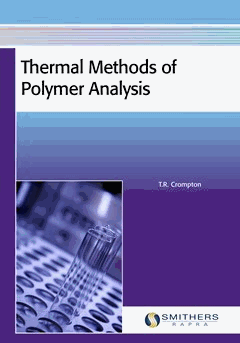
Thermal Methods of Polymer Analysis (2013)
T. R. Crompton
Smithers Rapra Technology
ISBN 978-1-84735-661-1 256 pages
Publisher Description: This book reviews the various thermal methods used for the characterisation of polymer properties and composition. All these methods study the properties of polymers as they change with temperature. The methods discussed in this book are: differential photocalorimetry, differential scanning calorimetry, dielectric thermal analysis, differential thermal analysis, dynamic mechanical analysis, evolved gas analysis, gas chromatography, gas chromatography combined with mass spectrometry, mass spectrometry, microthermal analysis, thermal volatilisation, thermogravimetric analysis and thermomechanical analysis. Each technique is discussed in detail and examples of the use of each technique are also given. Each chapter has an extensive list of references so that the reader can follow up topics of interest. This book will be a useful reference for those who already use any of these thermal methods but will also be of interest to undergraduates and those who are just starting to use these techniques.
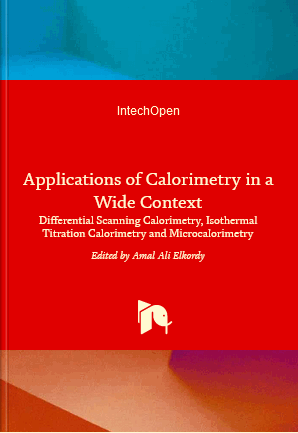
A. A. Elkordyn (Ed._
Intech
ISBN 978-953-51-0947-1 484 pages
Publisher Description: Calorimetry, as a technique for thermal analysis, has a wide range of applications which are not only limited to studying the thermal characterisation (e.g. melting temperature, denaturation temperature and enthalpy change) of small and large drug molecules, but are also extended to characterisation of fuel, metals and oils. Differential Scanning Calorimetry is used to study the thermal behaviours of drug molecules and excipients by measuring the differential heat flow needed to maintain the temperature difference between the sample and reference cells equal to zero upon heating at a controlled programmed rate. Microcalorimetry is used to study the thermal transition and folding of biological macromolecules in dilute solutions. Microcalorimetry is applied in formulation and stabilisation of therapeutic proteins. This book presents research from all over the world on the applications of calorimetry on both solid and liquid states of materials.
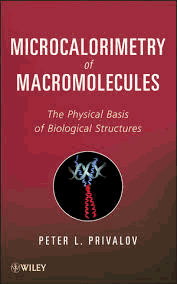
Microcalorimetry of Macromolecules: The Physical Basis of Biological Structures (2012)
Peter L. Privalov
Wiley
ISBN 9781118104514 Online ISBN: 9781118337509 409 pages
Publisher Description:
Examining the physical basis of the structure of macromolecules-proteins, nucleic acids, and their complexes-using calorimetric techniquesMany scientists working in biology are unfamiliar with the basics of thermodynamics and its role in determining molecular structures. Yet measuring the heat of structural change a molecule undergoes under various conditions yields information on the energies involved and, thus, on the physical bases of the considered structures. Microcalorimetry of Macromolecules offers protein scientists unique access to this important information.
Divided into thirteen chapters, the book introduces readers to the basics of thermodynamics as it applies to calorimetry, the evolution of the calorimetric technique, as well as how calorimetric techniques are used in the thermodynamic studies of macromolecules, detailing instruments for measuring the heat effects of various processes. Also provided is general information on the structure of biological macromolecules, proteins, and nucleic acids, focusing on the key thermodynamic problems relating to their structure
.
Thermal Stability of Polymers (2012)
T. R. Crompton
Smithers Rapra Technology
ISBN 1847355145 226 pages
Publisher Description: Clearly divided into three parts, this practical book begins by dealing with all fundamental aspects of calorimetry. The second part looks at the equipment used and new developments. The third and final section provides measurement guidelines in order to obtain the best results.

Jaroslav Šesták, Jiří J. Mareš, Pavel Hubík (Editors)
Springer
ISBN 978-90-481-2881-5 (Print) 978-90-481-2882-2 (Online) 370 pages
From The Back Cover: Glassy, Amorphous and Nano-crystalline Material: Thermal Physics, Analysis, Structure and Properties includes twenty-one chapter contributions from an international array of distinguished academics based in Asia, Australia, Eastern and Western Europe, Russia, and the USA. The book provides a coherent and authoritative overview of cutting-edge themes involving the thermal analysis, applied solid-state physics and the micro-crystallinity of selected materials and their macro- and microscopic thermal properties.
Selected chapters featured in the book include: Essential attributes of glassiness regarding the nature of non-crystalline solids; Aspects of vitrification, amorphization, disordering and the extent of nano-crystallinity; The basic role of thermal analysis in polymer physics; Classical and quantum diffusion and their application to the self-organized oscillatory reactions; Specificity of low temperature measurements applied to nano-crystalline diamante; Thermophysical properties of natural glasses at the extremes of the thermal history profile; Phenomenological meaning of temperature as background for the history and development of thermal analysis and calorimetry.

Differential Thermal Analysis: Application and Results in Mineralogy (2011)
W. Smykatz-Kloss
Springer
ISBN 3642659535 208 pages
Publisher Description: At first glance it may seem presumptuous to want to add yet another to the numerous books on Differential Thermal Analysis (DT A). Thermoanalytical methods have been in use for some time, as shown by the more than five thousand publications containing DT A or TG curves listed by SMOTHERS and CHIANG in the bibliography to their handbook and abstracted in the several volumes of Thermal Analysis Abstracts (TAA), edited by J. P. REDFERN for the International Con federation for Thermal Analysis (ICT A). Every three years the proceed ings of ICT A meetings are published, bringing the latest results of thermoanalytic research. There is also the Scifax DT A Data Index, edited by R. C. MACKENZIE (1962) and modeled on the ASTM pattern card index (used for X-ray investigations), a compilation of the DT A data for several hundred minerals, and inorganic and organic materials. The theoretical foundations of thermogravimetry and DT A have been described in detail by LEHMANN, DAS and PAETSCH (1953), R. C. MACKENZIE (1957, 1970), DUVAL (1963), WENDLANDT (1964), GARN (1965), F. PAULIK et al. (1966), SMOTHERS and CHIANG (1966), and KEATTCH (1969). Thermoanalytical results are strongly influenced by various factors relative to preparation and equipment (see 1-2. 4 of this study). This is the reason why we frequently find, in these books as well as in the Scifax-Card catalog, contradictory data on the same substance.

Heat Capacities: Liquids, Solutions and Vapours (2010)
Emmerich Wilhelm, Trevor M Letcher
ISBN 978-0-85404-176-3
524 pages
RSC
Publisher Description: The book contains the very latest information on all aspects of heat capacities related to liquids and vapours. The chapters, all written by knowledgeable experts in their respective fields, cover theory, experimental methods, and techniques (including speed of sound, photothermal techniques, brillouin scattering, scanning transitiometry, high resolution adiabatic scanning calorimetry), results on solutions, liquids, vapours, mixtures, electrolytes, critical regions, proteins, liquid crystals, polymers, reactions, effects of high pressure and phase changes. This new book covers a wide range of topics and is a key point of reference for undergraduates and graduates alike as well as researchers, academics and anyone working in the field or related areas.

Thermal Analysis
of Rubbers and Rubbery Materials (2010)
Namita Roy Choudhury, Prajna P De, Naba K Dutta (Editors)
ISBN 978-1847351029
566 pages
Smithers Rapra Technology
Publisher Description: This book describes the use of thermal analysis for determining additives in rubbery materials, recycling of rubbers and understanding the interactions of rubber, mainly fillers and the rubber matrix. It also explains characterization of rubber nanocomposites and other modified rubbers and their blends as well as examining instrumental techniques and crystallization of rubbers. This book will prove invaluable reading for anyone involved in material and product development, testing, processing, quality assurance, or failure analysis in industry and laboratories.

Thermal Analysis
of Polymers, Fundamentals and Applications (2009)
Joseph D. Menczel, R. Bruce Prime
ISBN 978-0-471-76917-0
688 pages
Wiley-Blackwell
Publisher Description: Presents a solid introduction to thermal analysis, methods, instrumentation, calibration, and application along with the necessary theoretical background. Useful to chemists, physicists, materials scientists, and engineers who are new to thermal analysis techniques, and to existing users of thermal analysis who wish expand their experience to new techniques and applications Topics covered include Differential Scanning Calorimetry and Differential Thermal Analysis (DSC/DTA), Thermogravimetry, Thermomechanical Analysis and Dilatometry, Dynamic Mechanical Analysis, Micro-Thermal Analysis, Hot Stage Microscopy, and Instrumentation. Written by experts in the various areas of thermal analysis Relevant and detailed experiments and examples follow each chapter.

Thermal Nanosystems and Nanomaterials (2009)
Sebastian Volz (Editor)
Springer
ISBN 978-3-642-04257-7 (Print) 978-3-642-04258-4 (Online) 591 pages
Publisher Description: Heat transfer laws for conduction, radiation and convection change when the dimensions of the systems in question shrink. The altered behaviours can be used efficiently in energy conversion, respectively bio- and high-performance materials to control microelectronic devices. To understand and model those thermal mechanisms, specific metrologies have to be established. This book provides an overview of actual devices and materials involving micro-nanoscale heat transfer mechanisms. These are clearly explained and exemplified by a large spectrum of relevant physical models, while the most advanced nanoscale thermal metrologies are presented.

Dynamic Mechanical Analysis: A Practical Introduction. 2nd Ed. (2008)
Kevin P. Menard
ISBN13 978-1420053128 240 Pages
CRC Press
Publisher Description: Dynamic mechanical analysis (DMA) has left the domain of the rheologist and has become a prevalent tool in the analytical laboratory. However, information on the use of this important tool is still scattered among a range of books and articles. Novices in the field have to dig through thermal analysis, rheology, and materials texts just to find the basics.
Updated with new material, expanded practical explanations, and new applications, Dynamic Mechanical Analysis, Second Edition continues to give chemists, engineers, and materials scientists a starting point for applying DMA to their individual fields. It imparts a clear understanding of how DMA works, its advantages, and possible limitations. Additional topics include stress/strain, data handling, experimental technology, test methods, and data analysis.
One of the only references dedicated to DMA, this accessible and easy-to-read guide gathers the most pertinent information available on this important technique.

Principles and
Applications of Thermal Analysis (2007)
Paul Gabbott (Editor)
ISBN 978-1-4051-3171-1
480 pages
Wiley-Blackwell
Publisher Description: Principles and Applications of Thermal Analysis is written by manufacturers and experienced users of thermal techniques. It provides sound practical instruction on using the techniques and gives an up-to-date account of the principle industrial applications. By covering basic thermogravimetric analysis (TGA), differential scanning calorimetry (DSC) including Fast Scanning DSC, together with dynamic mechanical analysis (DMA /TMA) methods, then discussing industrial applications, the book serves as an ideal introduction to the technology for new users. With a strong focus on practical issues, the book serves as an importa for experienced analysts.
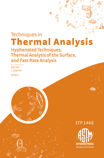
Techniques in Thermal Analysis: Hyphenated Techniques, Thermal Analysis of the
Surface, and Fast Rate Analysis (2007)
Pan Wei-Ping, Judovits Lawrence
ISBN
Publisher Description: STP 14
66: Nine peer-reviewed papers reflect the latest research in thermal analysis, including fast scan calorimetry in both instrument development and techniques. Sections cover:Hyphenated Techniques—seven papers cover the use of thermogravimetric analysis (TGA) with another technique. Topics deal with temperature-modulated differential scanning calorimetry; improved modeling when using hyphenated techniques; a simple calibration method for the quantitative use of mass spectrometry with TGA for a variety of encountered off gases; and much more.Fast Rate Analysis—covers fast scan calorimetry in both instrument development and techniques. Fast heating rates were employed to study epoxy curing and fast rate analysis allowed the separation of the glass transition and cure exotherm.Thermal Analysis of the Surface—discusses the use of a modified atomic force microscope (AFM), or Micro-Thermal Analysis, that uses the AFM probe as a thermal device.
Thermal Analysis
of Pharmaceuticals (2007)
Duncan Q.M. Craig, Mike Reading (Editors)
ISBN 978-0824758141
416 pages
CRC
Publisher Description: As a result of the Process Analytical Technologies (PAT) initiative launched by the U.S. Food and Drug Administration (FDA), analytical development is receiving more attention within the pharmaceutical industry. Illustrating the importance of analytical methodologies, Thermal Analysis of Pharmaceuticals presents reliable and versatile characterization tools for the successful development of pharmaceutical products. It draws attention to the most widely applicable methods and demonstrates how to interpret the associated data.
The book opens with the first three chapters devoted to differential scanning calorimetry (DSC), the most commonly used thermal method. These chapters cover the principles, optimal use, and pharmaceutical applications of the method. Subsequent chapters explore modulated temperature DSC, thermogravimetric analysis, thermal microscopy, microcalorimetry, high sensitivity DSC, dynamic mechanical analysis, and thermally stimulated current, all of which have attracted great interest within the pharmaceutical field. The chapters include theoretical background, measurement optimization, and pharmaceutical applications of each technique.
Exploring important techniques for characterizing the physical structure and properties of pharmaceutical materials, Thermal Analysis of Pharmaceuticals achieves an ideal balance in the depth, relevance, and accessibility of topics presented. The book provides an excellent overview of this key area in pharmaceutical development.

Michael E. Brown, Patrick K. Gallagher (Editors)
Elsevier Science
ISBN 978-0444531230
780 pagesPublisher Description: This is Volume 5 of a Handbook that has been well-received by the thermal analysis and calorimetry community. All chapters in all five volumes are written by international experts in the subject. The fifth volume covers recent advances in techniques and applications that complement the earlier volumes. The chapters refer wherever possible to earlier volumes, but each is complete in itself. The latest recommendations on Nomenclature are also included. Amongst the important new techniques that are covered are micro-thermal analysis, pulsed thermal analysis, fast-scanning calorimetery and the use of quartz-crystal microbalances. There are detailed reviews of heating - stage spectroscopy, the range of electrical techniques available, applications in rheology, catalysis and the study of nanoparticles. The development and application of isoconversional methods of kinetic analysis are described and there are comprehensive chapters on the many facets of thermochemistry and of measuring thermophysical properties. Applications to inorganic and coordination chemistry are reviewed, as are the latest applications in medical and dental sciences, including the importance of polymorphism. The volume concludes with a review of the use and importance of thermal analysis and calorimetry in quality control.

L'vov, Boris V. Brown, Michael E. (Editors)
Springer
ISBN 978-1-4020-5671-0 246 pages
Publisher Description: This book covers the results of investigations into the mechanisms and kinetics of thermal decompositions of solid and liquid substances on the basis of thermochemical analyses of the processes. In the framework of the proposed ideas, the main features of these reactions are explained and many problems and unusual phenomena, which have accumulated in this field are interpreted. New methods of TA measurement and calculation have been developed, which permit the precision and accuracy of determination of kinetic parameters to be increased substantially. Reliable kinetic characteristics have been obtained and the decomposition mechanisms for several tens of substances have been interpreted. These include different classes of compounds: crystalline hydrates, oxides, hydroxides, nitrides, azides, nitrates, sulfates, carbonates and oxalates.
 Modulated
Temperature Differential Scanning Calorimetry: Theoretical
and Practical Applications in Polymer Characterisation. (Hot Topics in Thermal
Analysis and Calorimetry, Vol. 6) (2006)
Modulated
Temperature Differential Scanning Calorimetry: Theoretical
and Practical Applications in Polymer Characterisation. (Hot Topics in Thermal
Analysis and Calorimetry, Vol. 6) (2006)
Mike Reading, Douglas J. Hourston (Editors)
Springer
ISBN 978-1-4020-3749-8
329 pages
Publisher
Description: MTDSC provides a step-change increase in the power of
calorimetry to characterize virtually all polymer systems including curing
systems, blends and semicrystalline polymers. It enables hidden transitions
to be revealed, miscibility to be accurately assessed, and phases and
interfaces in complex blends to be quantified. It also enables crystallinity
in complex systems to be measured and provides new insights into melting
behaviour. All of this is achieved by a simple modification of conventional
DSC.
In 1992 a new calorimetric technique was introduced that superimposed a small modulation on top of the conventional linear temperature program typically used in differential scanning calorimetry. This was combined with a method of data analysis that enabled the sample’s response to the linear component of the temperature program to be separated from its response to the periodic component. In this way, for the first time, a signal equivalent to that of conventional DSC was obtained simultaneously with a measure of the sample’s heat capacity from the modulation. The new information this provided sparked a revolution in scanning calorimetry by enabling new insights to be gained into almost all aspects of polymer characteristics.
This book provides both a basic and advanced treatment of the theory of the technique followed by a detailed exposition of its application to reacting systems, blends and semicrystalline polymers by the leaders in all of these fields. It is an essential text for anybody interested in calorimetry or polymer characterization, especially if they have found that conventional DSC cannot help them with their problems.
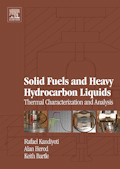
Solid Fuels and Heavy Hydrocarbon Liquids: Thermal Characterization and
Analysis (2006)
Rafael Kandiyoti, Alan Herod, Keith Bartle
Elsevier
ISBN 978-0-08-044486-4
361 pages
Publisher
Description: The first strand
involves a critical overview of the design of experimental methods used for
examining the thermal behaviour of solid fuels [pyrolysis, liquefaction and
gasification], while the second will emphasise chemical structures and molecular
mass distributions of coal derived tars, extracts and pitches, petroleum-derived
asphaltenes, and biomass derived heavy hydrocarbon liquids. Two major,
interdependent strands in the study of fossil and renewable fuel utilisation are
focused on within this text: (i) Thermal characterisation of solid fuels
including various ranks of coals, biomass and waste, and, (ii) The analytical
characterisation of heavy hydrocarbon liquids, covering coal, petroleum and
biomass derived heavy fraction.

Thermal Degradation of Polymeric Materials (2005)
Pielichowski, Krzysztof; Njuguna, James (Editors)
ISBN 978-1-85957-498-0
320 pages
Smithers Rapra Technology
Publisher Description: Thermal degradation of polymeric materials is an important issue from both the academic and the industrial viewpoints. This work summarizes recent developments in the study of the thermal degradation of polymers. The authors present an overview of thermal degradation mechanisms and kinetics as well as describing the use of thermogravimetry and differential scanning calorimetry, in combination with mass spectroscopy and infrared spectrometry, to investigate thermal decomposition. These methods have proved useful for defining suitable processing conditions for polymers as well as useful service guidelines for their application. The authors go on to discuss the thermal degradation of various polymers, copolymers, high-performance plastics, blends and composites, including polyolefins, styrene polymers, polyvinyl chloride, polyamides, polyurethanes, polyesters, polyacrylates and others. This book offers a wealth of information for polymer researchers and processors requiring an understanding of the implications of thermal degradation on material and product performanc..

Science of Heat and Thermophysical Studies. A Generalized Approach to Thermal
Analysis (2005)
J Sestak
Elsevier
ISBN 9780444519542
486 pages
Publisher Description: Science of Heat and Thermophysical Studies provides a non-traditional bridging of historical, philosophical, societal and scientific aspects of heat with a comprehensive approach to the field of generalized thermodynamics. It involves Greek philosophical views and their impact on the development of contemporary ideas. Covered topics include: . the concept of heat . thermometry and calorimetry . early concepts of temperature and its gradients . non-equilibrium and quantum thermodynamics . chemical kinetics . entropy, order and information . thermal science applied to economy(econophysics), ecosystems, and process dynamics or mesoscopic scales (quantum diffusion) . importance of energy science and its influence to societal life.

Thermal Analysis
of Polymeric Materials (2005)
Bernhardt Wunderlich
Springer
ISBN 978-3540236290
894 pages
Publisher Description: Thermal Analysis of Polymeric Materials" systematically treats macroscopic measurements by thermal analysis and the quantitative link to microscopic, molecular structure and mobility. Reversible and irreversible thermodynamics, kinetics, quantum mechanics, and statistical thermodynamics are the roots of the described thermal analysis. The book aims to broaden readers’ understanding of materials and the connection of flexible macromolecules (polymers) to small molecules and rigid macromolecules (minerals, salts, and metals). An effort is made to discover how the long, flexible molecules fit into their small phases which are characterized as microphases or nanophases. Their order ranges from amorphous to mesophase-like and crystalline. Ultimately, it is shown that the basic structure-property-processing triangle is connected to the better-known types of molecules and their common macroscopic phases.

Comprehensive
Handbook of Calorimetry and Thermal Analysis (2004)
The Japan Society of Calorimetry and Thermal Analysis (Editor), Michio
Michio Sorai (Editor-in-Chief)
Wiley
ISBN 978-0-470-85152-4
556 pages
Publisher Description: One of the field’s leading research centers has produced an essential and up-to-date resource covering two fields not normally brought together in the literature. Professor Sorai is a world-recognised expert in the field of thermodynamics and leads key researchers to provide complete coverage of the subject without overloading the reader. Comprehensive survey with practical examples. Provides coverage of principles, experimental methods, data analysis, databases and applications. Include applications in many disciplines, such as biochemistry, pharmacy, food, polymers, engineering and the fine chemical industries, in both industry and academia.
 The
Nature of Biological Systems as Revealed by Thermal Methods. (Hot Topics
in Thermal Analysis and Calorimetry, Vol. 5) (2004)
The
Nature of Biological Systems as Revealed by Thermal Methods. (Hot Topics
in Thermal Analysis and Calorimetry, Vol. 5) (2004)
Dénes Lörinczy (Editor)
Springer
ISBN 978-1-4020-2218-0
353 pages
Publisher Description: The Nature of Biological Systems as Revealed by Thermal Methods is a guide for experiments using thermal methods. The Editor has used his many years of experience to create a unique resource that will enable others with a less mathematical background, to realize the beauty and power of this tool and to gain a better understanding of biological problems.
Biological
calorimetry (and of course thermal analysis) is of increasing interest and
is not covered thoroughly in other resources. The methods presented are
macroscopic, for the rather inhomogeneous material (micromethods are often
not possible or not pertinent). This book will help beginners in the field
of thermal analysis or calorimetry understand the principles of
thermodynamics being applied to biological systems. Biological systems are
highly organized and very complex. The water and the different types of weak
interactions among the macromolecules make the interpretation of thermal
events very difficult. This book includes examples how to handle such
problems.
 Thermal
Properties of Green Polymers and Biocomposites. (Hot Topics
in Thermal Analysis and Calorimetry, Vol. 4) (2004)
Thermal
Properties of Green Polymers and Biocomposites. (Hot Topics
in Thermal Analysis and Calorimetry, Vol. 4) (2004)
Tatsuko Hatakeyama, Hyoe Hatakeyama
Springer
ISBN 978-1-4020-1907-4
331 pages
Publisher
Description: Environmentally
compatible polymers (green polymers) are the key to sustainable developments
for our rich and convenient life. In order to develop green polymers, it is
essential to understand that nature constructs a variety of materials that
can be used. Plant materials such as cellulose, hemicellulose and lignin are
the largest organic resources. Thermal Properties of Green Polymers and
Biocomposites is unique in that it introduces thermal analysis applicable to
green polymers and provides fundamental thermal properties of cellulose,
polysaccharides and lignin. The book includes over 370 figures concerning
thermal properties of green polymers with detailed experimental conditions.
It also introduces newly patented environmentally compatible green polymers.
Thermal properties provided include: thermogravimetry (TG), differential
thermal analysis (DTA), differential scanning calorimetry (DSC),
thermomechanometry (TMA) and dynamic mechanical analysis (DMA).
 Sample
Controlled Thermal Analysis: Origin,
Goals, Multiple Forms, Applications and Future. (Hot Topics in Thermal
Analysis and Calorimetry, Vol. 3) (2004)
Sample
Controlled Thermal Analysis: Origin,
Goals, Multiple Forms, Applications and Future. (Hot Topics in Thermal
Analysis and Calorimetry, Vol. 3) (2004)
O. Toft Sørensen, J. Rouquerol (Editors)
Springer
ISBN 978-1-4020-1563-2
224 pages
Publisher Description: Sample Controlled Thermal Analysis gives a short presentation of the spirit and history of SCTA and then focuses on: basic SCTA techniques, applications of SCTA in kinetic studies and applications in the study of ceramics, adsorbents and catalysts. Finally the expected future development of SCTA is discussed. This book is an invaluable reference for materials scientists, chemists, geologists, and engineers involved in the development of new materials, the manufacturing processes and quality control. It is also useful for research in solid state chemistry, materials science, materials in general, and analytical chemistry. Producers of thermoanalytical equipment and manufacturers of catalysts, technological ceramics and adsorbents for industrial or environment applications will find this an important resource.

Thermal Analysis Of Plastics: Theory and Practice (2004)
Gottfried W. Ehrenstein, Gabriela Riedel, Pia Trawiel
ISBN-156990362X 368 pages
Carl Hanser Verlag GmbH & Co. KG
Publisher Description: Thermal Analysis of Plastics provides information on important properties of plastic materials, such as nucleation, crystallization, degree of crystallinity, recrystallization, melting and solidification, glass transition, curing and postcuring, thermal stability, thermal expansion, relaxation of orientation and internal stresses, pvT-data, and others. Different test methods and their variations are described in detail, emphasizing the principles and their application in practice. Using practical examples, different approaches to problem solving are presented with a focus on the interpretation of experimental results. This just-released book is a must for everyone involved in material and product development, testing, processing, quality assurance, or failure analysis in industry and laboratories.

Michael E. Brown, Patrick K. Gallagher (Editors)
Elsevier Science
ISBN 978-0444820868 942 pages
Publisher Description: This is the second volume of a four volume set intended to describe the techniques and applications of thermoanalytical and calorimetric methods. The general techniques and methodology are covered extensively in Volume 1, along with the fundamental physicochemical background needed. Consequently the subsequent volumes dwell on the applications of these powerful and versatile methods, while assuming a familiarity with the techniques. Volume 2 covers major areas of inorganic materials and some related general topics, e.g., catalysis, geochemistry, and the preservation of art. The chapters are written by established practitioners in the field with the intent of presenting a sampling of the how thermoanalytical and calorimetric methods have contributed to progress in their respective areas. The chapters are not intended as exhaustive reviews of the topics, but rather, to illustrate to the readers what has been achieved and to encourage them to consider extending these applications further into their domains of interest.

Differential
Scanning Calorimetry. 2nd Ed. (2003)
Günther Höhne, Wolfgang F. Hemminger, H.-J. Flammersheim
ISBN 978-3-540-00467-7
298 pages
Springer
Publisher Description: In this updated and fully revised second edition, the authors provide the newcomer and the experienced practitioner with a balanced and comprehensive insight into all important methods and aspects of Differential Scanning Calorimetry (DSC), including a sound presentation of the theoretical basis of DSC thermal analysis and temperature-modulated DSC (TMDCS). Emphasis is placed on modern evaluation techniques, instrumentation, the underlying measurement principles, metrologically correct calibrations, factors influencing the measurement process, and on the exact interpretation of the results. The information enables the research scientist, the analyst and experienced laboratory staff to choose the most suitable equipment, to apply DSC methods successfully, to interpret the measurement curve, and thus to measure key properties precisely. In addition, the new edition includes improved instrumental techniques such as Tzerotm and StepScantm, new evaluation techniques, more applications, and the latest references.
 Theory
of Calorimetry. (Hot Topics in Thermal Analysis and Calorimetry,Vol. 2)
(2002)
Theory
of Calorimetry. (Hot Topics in Thermal Analysis and Calorimetry,Vol. 2)
(2002)
W. Zielenkiewicz, E. Margas
Springer
ISBN 978-1-4020-2218-0
353 pages
Publisher Description: The purpose of this book is to give a comprehensive description of the theoretical fundamentals of calorimetry. The considerations are based on the relations deduced from the laws and general equations of heat exchange theory and steering theory. The calorimeter is described as a physical object of well-defined thermal and dynamic parameters. The mathematical models of calorimeters are formulated. A classification of calorimeters is given. The methods of the determination of heat effects and analysis of the course of heat effects in the calorimeters are presented and discussed.

Michael E. Brown
Springer
ISBN 978-1-4020-0211-3
280 pages
Publisher Description: Thermal Analysis is a well-established set of techniques for obtaining qualitative and quantitative information about the effects of various heat treatments on materials of all kinds, including new chemical compounds, plastics, ceramics, alloys, construction materials, minerals, foods and medicines. Heating is performed under strictly controlled conditions and can reveal changes in structure and other important properties of the material being studied. Such studies are of great practical importance in the use of materials. This new edition has been thoroughly revised and rewritten to account for the changes that have occurred in the techniques and the instrumentation since the original edition in 1988. These changes include the introduction of new modulated temperature techniques and the exciting world of micro thermal analysis, based on novel adaptations of atomic force microscopy. These new techniques are integrated with the older standard techniques. The aim of the original edition has, however, been retained and is to provide a brief, readable introduction to these versatile techniques, for anyone contemplating their use, from which it is possible to move on to the specialist literature.

Handbook of Thermal Analysis and Calorimetry Volume 3: Applications to Polymers and Plastics (2002)
Stephen Z.D. Cheng (Editor)
Elsevier Science
ISBN 978-0444512864 858 pages
Publisher Description: As a new and exciting field of interdisciplinary macromolecular science and engineering, polymeric materials will have a profound presence in 21st century chemical, pharmaceutical, biomedical, manufacturing, infrastructure, electronic, optical and information technologies. The origin of this field derived from an area of polymer science and engineering encompassing plastic technologies. The field is rapidly expanding to incorporate new interdisciplinary research areas such as biomaterials, macromolecular biology, novel macromolecular structures, environmental macromolecular science and engineering, innovative and nano-fabrications of products, and is translating discoveries into technologies.

Handbook of
Thermal Analysis of Construction Materials (2002)
V.S. Ramachandran, Ralph M. Haber, James J. Beaudoin, Ana H. Delgado
ISBN 978-0815514879
702 pages
William Andrew
Publisher Description: This comprehensive book containing essential information on the applicability of thermal analysis techniques to evaluate inorganic and organic materials in construction technology should serve as a useful reference for the scientist, engineer, construction technologist, architect, manufacturer, and user of construction materials, standard-writing bodies, and analytical chemists. The material scientists at the National Research Council of Canada have established one of the best thermal analysis laboratories in the world. Various types of thermal analysis techniques have been applied successfully to the investigation of inorganic and organic construction materials. These studies have provided important information on the characterization of raw as well as finished materials, quality control, quantitative estimation, interrelationships between physical, chemical, mechanical, and durability characteristics.
Information on the application of thermal analysis to construction materials is dispersed in literature and hence the IRC scientists embarked on producing a handbook, the first of its kind, incorporating the latest knowledge available in this field of activity. Almost all important construction materials have been included.

Principles of
Thermal Analysis and Calorimetry (2002)
Peter Haines (Editor)
ISBN 978-0-85404-610-2
234 pages
RSC
Publisher Description: The use of thermal and calorimetric methods has shown rapid growth over the last two decades, in an increasingly wide range of applications. In addition, a number of powerful new techniques have been developed. This book supplies a concise and readable account of the principles, experimental apparatus and practical procedures used in thermal analysis and calorimetric methods of analysis. Brief accounts of the basic theory are reinforced with detailed applications of the methods and contemporary developments. Also included is information on standard test methods and manufacturers. Written by acknowledged experts, Principles of Thermal Analysis and Calorimetry is up-to-date, wide-ranging and practical. It will be an important source of information for many levels of readership in a variety of areas, from students and lecturers through to industrial and laboratory staff and consultants.

Characterisation of Polymers by Thermal Analysis (2001)
W.M. Groenewoud
ISBN 978-0-444-50604-7 390 pages
Elsevier
Publisher Description: Thermal Analysis (TA) has become an indispensable family of analytical techniques in the polymer research. The increased importance of these techniques can be seen as the result of three more or less parallel developments:• a tempestuous development of TA measuring techniques in combination with a high degree of automation,• the strongly increased understanding of the underlaying theory and,• the increasing knowledge of the relation between the polymers' chemical structure and their physical properties.These areas are still in their developmental stages, especially the third area. The increasing knowledge of the dependence of physical properties on chemical structure just accentuated more and more the need for accurate thermoanalytical measurements, and this knowledge is very important for the first stages of the development of new polymeric systems. Besides, the contribution of TA remains necessary for the technical and commercial development of such a new polymer system. The use of the various TA techniques in these processes is described in this book in nine chapters, while chapter ten illustrates the information obtained about different polymers during special case studies.This book illustrates in this way, applications of a wide variety of TA techniques whilst it is written from a materials characterisation rather than from a TA point of view with attention being paid to the chemical structure/physical properties correlations
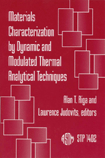
Materials Characterization by Dynamic and Modulated Thermal Analytical Techniques
(2001)Publisher Description: TSTP 1402 examines the latest dynamic and modulated thermal analytical techniques, including new interpretations and applications of Differential Scanning Calorimetry (DSC). The basis of many DSC methods is the modulation of temperature along with varying other parameters. Dynamic methods, including Dynamic Mechanical Analysis (DMA) and Dielectric Thermal Analysis (DETA), are also critiqued with new innovative applications. The mode of modulation, a sinusoidal wave or a saw tooth curve, affords the thermal analyst an opportunity to study a physical or chemical change in greater detail. 15 peer reviewed papers cover: • Temperature Modulated Differential Scanning Calorimetry (TMDSC) • Use of TMDSC in Curing and Chemical Reactions • Measurement of the Glass Transition and Melting by Modulated and Comparative Techniques • General Modulated Techniques • Other Modulated Techniques • Dynamic Techniques DMA and DETA.

The
Glass Transition. Relaxation Dynamics in Liquids and Disordered Materials
(2001)
Springer
ISBN 978-3-540-41801-6
Publisher Description: This is the first book dedicated to the glass transition since this concept became recognized as a distinct and independent field of investigation. The glass transition is a synonym for relaxation and dynamics in complex disordered systems, especially in liquids. It embraces time-scales ranging from picoseconds to years. The book describes and interrelates the following processes: cooperative alpha processes in a cold liquid, structural relaxation in the glass near Tg, the Johari-Goldstein beta process, the Williams-Götze process in a warm liquid, fast nonactivated cage rattling and boson peak, and ultraslow Fischer modes. By describing the salient facts, explaining and discussing the fundamentals, the author attempts to introduce a unifying concept for the entire material. The formulas, diagrams and references are carefully selected to illustrate the main current ideas about the glass transition.

Marcel Dekker
ISBN
9780429164637(ebook)
540
pages
Publisher Description: Discusses the most recent advances in the correlations of structure and reactivity relationships of micelles, liposomes, microemulsions, and emulsions by thermal behavior measurements, as well as the options, scope, and limitations of the thermal behavior of dispersed systems. Highlights current studies on heterogeneous colloidal (dispersed) systems.

Thermal Analysis:
Fundamentals and Applications to Polymer Science, 2nd Ed., (1999)
T. Hatakeyama, F.X. Quinn
ISBN 978-0471983620
190 pages
Wiley
Publisher Description: Thermal Analysis Fundamentals and Applications to Polymer Science T. Hatakeyama Otsuma Women's University, Tokyo, Japan F. X. Quinn L'Oréal Recherche Advancée, Aulnay-sous-Bois, France The first edition of this classic book remains one of the very few introductory books covering both theoretical and practical aspects of thermal analysis (TA). This new edition includes a much enlarged section on MDSC, in which the instrument is described and a critical appraisal of the technique presented. Other additions include new sections on rate-controlled TGA, OTTER, and Specific Heat Spectroscopy, and a thoroughly updated section on X-Ray DSC. This very practical book is a must for people who use thermal analysis techniques in their everyday work. "An excellent introductory text" - Review of 1st Edition.

Handbook of Thermal Analysis and Calorimetry Volume 4: From Macromolecules to Man (1999)
Richard B. Kemp (Editor)
Elsevier Science
ISBN13 978-0-444-82088-4 1032 pages
Publisher Description: The applications and interest in thermal analysis and calorimetry have grown enormously during the last half of the 20th century. These techniques have become indispensable in the study of processes such as catalysis, hazards evaluation etc., and in measuring important physical properties quickly, conveniently and with markedly improved accuracy. Consequently, thermal analysis and calorimetry have grown in stature and more scientists and engineers have become at least part-time, practitioners. People new to the field therefore need a source of information describing the basic principles and current state of the art. The last volume of this 4 volume handbook, devoted to many aspects of biological thermal analysis and calorimetry, completes a comprehensive review of this important area. All chapters have been prepared by recognized experts in their respective fields. The approach taken is "how and what to do and when to do it". The complete work is a valuable addition to the already existing literature.

Handbook of Thermal Analysis and Calorimetry Volume 1: Principles and Practice (1998)
Michael E. Brown, Patrick K. Gallagher (Editors)
Elsevier Science
ISBN 044482085X 722 pages
Publisher Description:
Volume 1 describes the basic background information common to thermal analysis and calorimetry in general. Thermodynamic and kinetic principles are discussed along with the instrumentation and methodology associated with thermoanalytical and calorimetric techniques. The purpose is to collect the discussion of these general principles and minimize redundancies in the subsequent volumes that are concerned with the applications of these principles and methods. More unique methods, which pertain to specific processes or materials, are covered in later volumes.Reports research re: energetics of RNA & DNA; DSC measure- ment of protein; biomembranes; combustion calorimetry, etc.

Handbook of
Thermal Analysis (1998)
T. Hatakeyama, Liu Zhenhai
ISBN 978-0-471-98363-7
470 pages
Wiley-Blackwell
Publisher Description: Handbook of Thermal Analysis Edited by T. Hatakeyama National Institute of Materials and Chemical Research, Ibaraki, Japan Zhenhai Liu Changchun Institute of Applied Chemistry, China This 425-page reference book covers a comprehensive description of the principles of thermal analysis (TA) instruments, operating conditions, and the nature of the experimental data. Presented in a compact and well-arranged style with a large number of figures and illustrations, this work is divided into two parts. Part I is designed to acquaint and orient newcomers with TA by providing a comprehensive introduction to the basic principles of instrument operation, with advice on sample preparation and optimization of operating conditions, and a guide to interpreting results. The text deals primarily with techniques such as differential scanning calorimetry (DSC), differential thermal analysis (DTA), and thermogravimetry (TG). Part II illustrates 500 TA curves covering metals, inorganic and organic minerals, polymers, construction materials, pharmaceuticals, explosives, etc. The appendices include a glossary of TA terms, a survey of reference materials, the current table of TA standards, and a TA database. This book is aimed at advanced users and specialists who utilize TA methods for practical purposes, especially in research laboratories both academic and industrial. With an emphasis on practical instruction, industrial research staff, undergraduates and postgraduate students in the relevant fields will find this work a useful introduction to principle TA techniques.
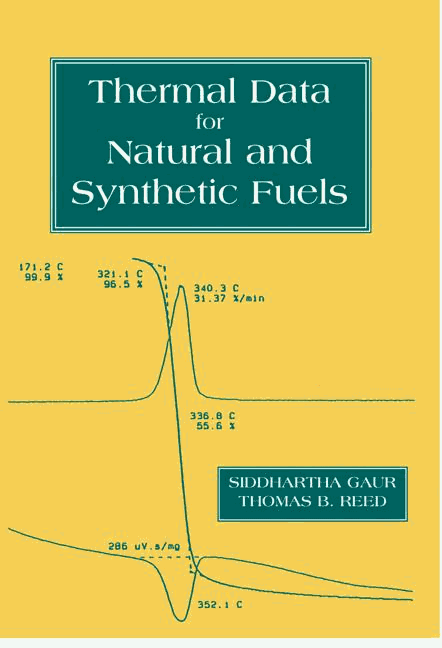
Thermal Data for Natural and Synthetic Fuels (1998)
Siddhartha Gaur, Thomas B. Reed
ISBN 9780824700706
280 pages
CRC Press
Publisher Description: Presents 100 samples of organic substances characterized under identical conditions by thermogravimetry (TG) and differential thermal analysis (DTA) in addition to proximate analysis-providing accurate information essential in research and engineering applications related to fuel preparation. Discusses nonisothermal kinetic techniques, mathematical models, and other parameter estimation procedures that facilitate the extrapolation of results obtained under various conditions-including the Gaur and Reed method, an important advance in understanding the kinetics of thermal data.

Thermal
Characterization of Polymeric Materials, Volume 1-2. 2nd Ed. (1997)
Edith A. Turi (Editor)
ISBN 978-0127037837
2420 pages
Academic Press
Publisher Description: The Second Edition of Thermal Characterization of Polymeric Materials, edited by Edith A. Turi, continues the tradition of the widely acclaimed original work, providing a comprehensive and fully current reviewof the literature and techniques of thermal analysis of polymers. The two-volume set provides an in-depth overview of thermal analysis by focusing on instrumentation and a wide array of applications in research, development, production, quality control and technical service. Readers will benefit greatly from the well-coordinated and clearly written chapters, which are replete with practical examples. Chapters are written by world-renowned authors and include important, previously unpublished experimentaldata. Fully revised and updated, this Second Edition has grown from 960 to approximately 2500 pages, reflecting the explosive development of the field during the past fifteen years. This comprehensive two-volume set is an invaluable reference source for chemists, engineers, physicists, and other professionals involved in research, development, production, applications, characterization, and evaluation of polymers.
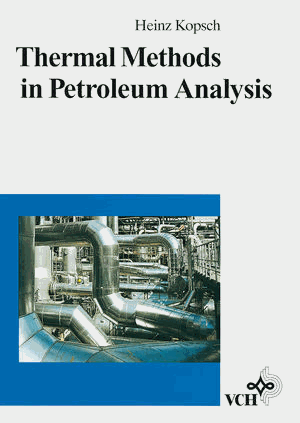
Thermal Methods in Petroleum Analysis (VCH 1995) (Wiley 2007)
Heinz Kopsch
VCH (1995), Wiley (2007-8)
ISBN 978-3-527-61514-8 527 pages
Publisher Description: This exceptional book reveals the results of twelve years of extensive thermoanalytical investigations into petroleum and its products with the aid of 236 tables, 284 diagrams and 159 references. Firstly, the methods employed in obtaining thermoanalytic data, in particular thermogravimetry, differential thermal analysis and differential scanning calorimetry, are presented, and the underpinning theory described. Next, the data obtained from model substances, i.e. pure hydrocarbons, is displayed; it is then explained how multicomponent hydrocarbon systems may be characterized by comparison of their data with this. Research into petroleum and its products using these methods is outlined. The reactions central to various refinery processes, tertiary oil recovery, lubricant stability testing and oil shale retorting, to name but a few examples, are investigated as are relevant pyrolysis and oxidation reactions. Finally, readers are brought up-to-date with recent developments in instrumentation, are recommended hardware and software and are provided with a list of suppliers. Scientists, engineers and technicians working on research, product characterization, process development or quality control in the oil recovery, oil refining, petrochemical, lubricant and asphalt industries will find the advice and information in this book to be of great value.

Thermal Analysis of Materials (1994)
Robert F. Speyer
ISBN 0824789636 298 pages
CRC
Publisher Description: Discussing the design and optimum use of thermal analysis instrumentation for materials' property measurement, this work details how the instruments work, what they measure, potential pitfalls and the fitting of experimental results to theoretical models. It presents a tutorial on writing computer programs for data manipulation, advanced thermoanalytical methods and case studies.
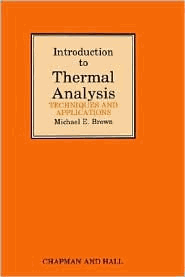
Introduction to Thermal Analysis: Techniques and Applications (1988)
Michael E. Brown
Chapman And Hall
ISBN 0 412 30230 6
222 pages

Thermal
Characterization of Polymeric Materials. 1st Ed. (1981)
Edith A. Turi (Editor)
ISBN 0127037802
986 pages
Academic Press
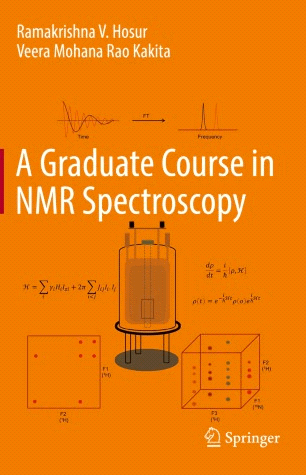
Ramakrishna V. Hosur, Veera Mohana Rao Kakita
Springer
ISBN 978-3-030-88769-8
313 pagesPublisher Description: This textbook is designed for graduate students to introduce the basic concepts of Nuclear Magnetic Resonance spectroscopy (NMR), spectral analysis and modern developments such as multidimensional NMR, in reasonable detail and rigor. The book is self-contained, so, a unique textbook in that sense with end of chapter exercises included supported by a solution manual. Some of the advanced topics are included as Appendices for quick reference. Students of chemistry who have some exposure to mathematics and physics will benefit from this book and it will prepare them to pursue research in different branches of Chemistry or Biophysics or Structural Biology.
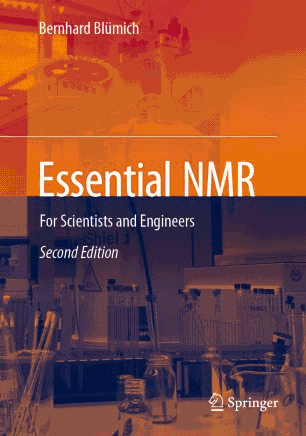
Essential NMR for Scientists and Engineers, 2nd Ed (2019)
Bernhard Blumich
Springer
ISBN 978-81-322-3653-5 (Print) 978-3-030-10704-8 (Online) 169 pages
Publisher Description: The second edition of this textbook offers extended information on imaging as well as relaxation. A new chapter has been added to cover hyperpolarisation. As before, Essential NMR is a set of lecture notes for scientists and engineers who want to brush up on their knowledge of NMR. It is also a compendium for graduate and postgraduate students of physics and chemistry as well as for their teachers, covering all fields of NMR, i.e. NMR methodology and hardware, chemical analysis, 2D-spectroscopy, NMR imaging, flow NMR, and quality control NMR. The material, selected and organized for a one-semester course, is presented in a concise and informative way. Each page addresses a particular topic and holds an illustrative figure as well as explanatory text providing the key information. The book is intended for beginning graduate students and doctoral students of Physics, Chemistry, Chemical Engineering, and Material Science.
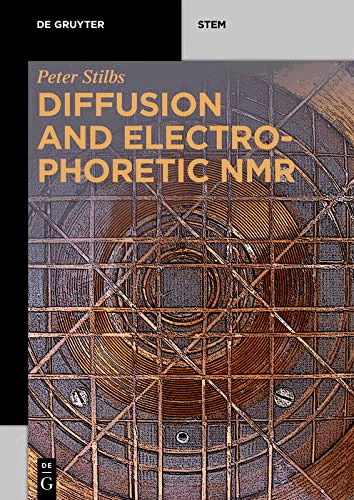
Diffusion and Electrophoretic NMR (2019)
Peter Stilbs
De Gruyter
ISBN 978-3110551525 336 pages
Publisher Description: Diffusion and Eletrophoretic NMR experiments resolve chemical compounds based on their molecular motion. This publication introduces the basics of these methods and explains how they can be used to measure the size of molecules and aggregates, to determine degree of polymerization and to solve other chemical problems. Supplied with many case studies, the book is a must-have for students and researchers who work with practical NMR measurements.
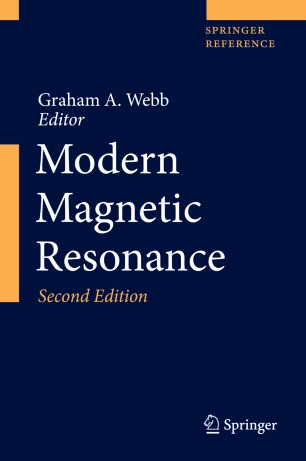
Modern Magnetic Resonance, Volumes 1-3 (2018)
Springer
ISBN 978-3-319-28387-6 (Print) 978-3-319-28388-3 (Online)
2293 pagesPublisher Description: This completely revised and updated second edition showcases the considerable progress that has taken place in this field since 2008. The three part reference work contains key developments, scores of contributions, key literature citations and overviews of the important progress achieved in the relevant topics since the publication of the previous edition. Two key differences in this new edition are the replacement of the previous Medical Sciences section with the Biological and Pharmaceutical Science sections and the inclusion of a new part featuring Archaeological applications. Divided into seven comprehensive parts, the work covers: Archaeology, Biological Sciences, Chemistry, Food Science, Marine Science, Materials Science, and Pharmaceutical Science. Section editors from Asia, USA, and Europe have recruited a truly international list of active and eminent contributors who have created a remarkable and unique work. Topics include: Electron Spin Resonance, High resolution solid and liquid state NMR; Low resolution NMR; Solution State NMR; Magnetic Resonance Imaging. The level of scientific coverage of the chosen topics renders the handbook suitable for research workers in the relevant fields as well as final year undergraduate students .
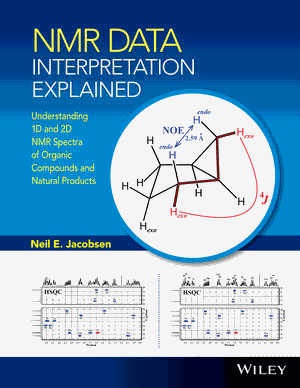
Neil E. Jacobsen
Wiley
ISBN 978-1-119-17688-6 658 pages
Publisher Description: Through numerous examples, the principles of the relationship between chemical structure and the NMR spectrum are developed in a logical, step-by-step fashion Includes examples and exercises based on real NMR data including full 600 MHz one- and two-dimensional datasets of sugars, peptides, steroids and natural products Includes detailed solutions and explanations in the text for the numerous examples and problems and also provides large, very detailed and annotated sets of NMR data for use in understanding the material Describes both simple aspects of solution-state NMR of small molecules as well as more complex topics not usually covered in NMR books such as complex splitting patterns, weak long-range couplings, spreadsheet analysis of strong coupling patterns and resonance structure analysis for prediction of chemical shifts Advanced topics include all of the common two-dimensional experiments (COSY, ROESY, NOESY, TOCSY, HSQC, HMBC) covered strictly from the point of view of data interpretation, along with tips for parameter settings.
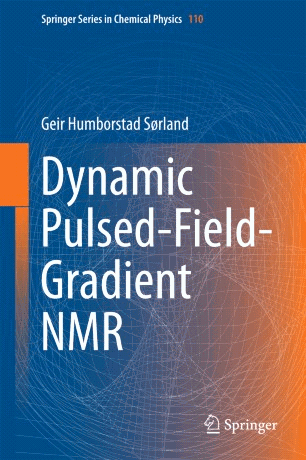
Dynamic Pulsed-Field-Gradient NMR (2014)
Geir Humborstad Sørland
Springer
ISBN 978-3662444993
367 pagesPublisher Description: Dealing with the basics, theory and applications of dynamic pulsed-field-gradient NMR NMR (PFG NMR), this book describes the essential theory behind diffusion in heterogeneous media that can be combined with NMR measurements to extract important information of the system being investigated. This information could be the surface to volume ratio, droplet size distribution in emulsions, brine profiles, fat content in food stuff, permeability/connectivity in porous materials and medical applications currently being developed. Besides theory and applications it will provide the readers with background knowledge on the experimental set-ups, and most important, deal with the pitfalls that are numerously present in work with PFG-NMR. How to analyze the NMR data and some important basic knowledge on the hardware will be explained, too.
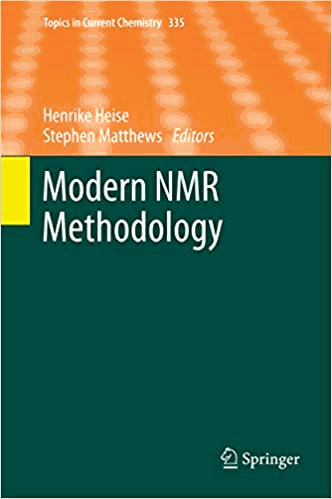
Modern NMR Methodology (Topics in Current Chemistry Book 335) (2013)
Henrike Heise
, Stephen Matthews (Eds.)Springer
ISBN: 978-3-642-44563-7
211 pagesChapter Titles: 1- NMR Spectroscopy for Chemical Analysis at Low Magnetic Fields. 2- Dynamic Nuclear Hyperpolarization in Liquids. 3-NMR with Multiple Receivers. 4-TROSY NMR Spectroscopy of Large Soluble Proteins. 5-Solid-State NMR Spectroscopy of Proteins. 6-Paramagnetic Solid-State Magic-Angle Spinning NMR Spectroscopy.
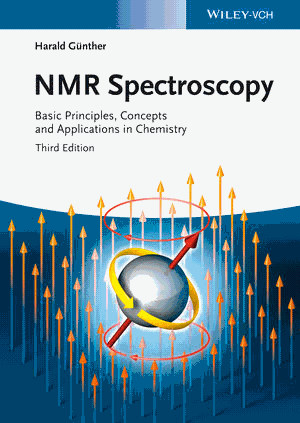
NMR Spectroscopy: Basic Principles, Concepts and Applications in Chemistry, 3rd Edition (2013)
Harald Gunther
Wiley
ISBN 978-3-527-33000-3 734 pages
Publisher Description: Nuclear magnetic resonance (NMR) spectroscopy is one of the most powerful and widely used techniques in chemical research for investigating structures and dynamics of molecules. Advanced methods can even be utilized for structure determinations of biopolymers, for example proteins or nucleic acids. NMR is also used in medicine for magnetic resonance imaging (MRI). The method is based on spectral lines of different atomic nuclei that are excited when a strong magnetic field and a radiofrequency transmitter are applied. The method is very sensitive to the features of molecular structure because also the neighboring atoms influence the signals from individual nuclei and this is important for determining the 3D-structure of molecules. This new edition of the popular classic has a clear style and a highly practical, mostly non-mathematical approach. Many examples are taken from organic and organometallic chemistry, making this book an invaluable guide to undergraduate and graduate students of organic chemistry, biochemistry, spectroscopy or physical chemistry, and to researchers using this well-established and extremely important technique. Problems and solutions are included.
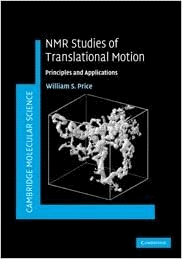
NMR Studies of Translational Motion. Principles and Applications (2009)
William S. Price
Cambridge University Press
ISBN 978-0521806961 416 pages
Publisher Description: Translational motion in solution, either diffusion or fluid flow, is at the heart of chemical and biochemical reactivity. Nuclear Magnetic Resonance (NMR) provides a powerful non-invasive technique for studying the phenomena using magnetic field gradient methods. Describing the physical basis of measurement techniques, with particular emphasis on diffusion, balancing theory with experimental observations and assuming little mathematical knowledge, this is a strong, yet accessible, introduction to the field. A detailed discussion of magnetic field gradient methods applied to Magnetic Resonance Imaging (MRI) is included, alongside extensive referencing throughout, providing a timely, definitive book to the subject, ideal for researchers in the fields of physics, chemistry and biology.

Neil E. Jacobsen
Wiley
ISBN 9780471730965 668 pages
Publisher Description: NMR Spectroscopy Explained : Simplified Theory, Applications and Examples for Organic Chemistry and Structural Biology provides a fresh, practical guide to NMR for both students and practitioners, in a clearly written and non-mathematical format. It gives the reader an intermediate level theoretical basis for understanding laboratory applications, developing concepts gradually within the context of examples and useful experiments. * Introduces students to modern NMR as applied to analysis of organic compounds. * Presents material in a clear, conversational style that is appealing to students. * Contains comprehensive coverage of how NMR experiments actually work. * Combines basic ideas with practical implementation of the spectrometer. * Provides an intermediate level theoretical basis for understanding laboratory experiments. * Develops concepts gradually within the context of examples and useful experiments. * Introduces the product operator formalism after introducing the simpler (but limited) vector model.
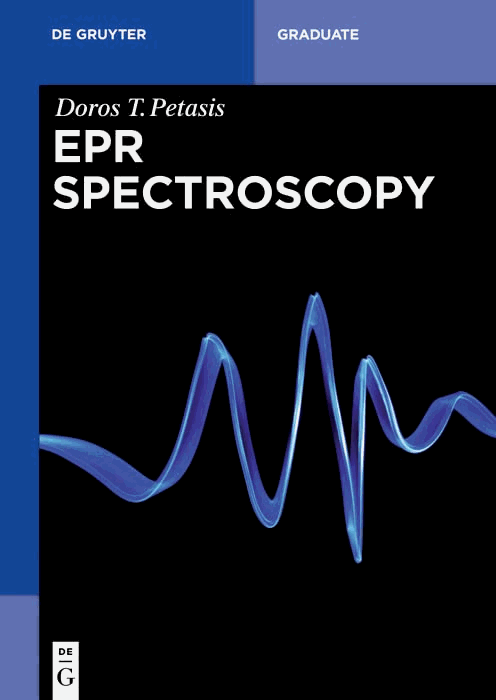
Doros T. Petasis
De Gruyter
ISBN: 9783110417562
(ebook) 300 pagesPublisher Description: EPR spectroscopy is a versatile, nondestructive technique widely used in chemistry, biology, and physics. It detects molecules and materials with unpaired electrons making it a very selective technique that produces a wealth of information on such systems. Its high sensitivity makes it suitable in analyzing very small samples, single crystals, or reaction intermediates like radicals. This textbook takes a practical approach that introduces the basic concepts of EPR to sufficient detail to allow the reader to gain a basic knowledge of EPR and understand how experiments are carried out and how spectra are analyzed and interpreted. Many illustrative examples are included drawn from solid-state physics and bioinorganic chemistry. It is suitable as a short introduction for advanced undergraduate and beginning graduate students taking their first steps into EPR research.
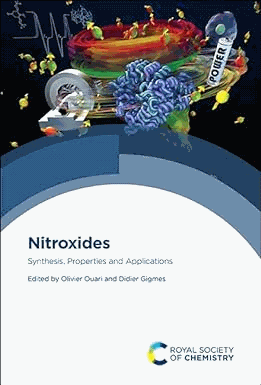
Nitroxides: Synthesis, Properties and Applications (2021)
Olivier Ouari, Didier Gigmes, Eds.
RSC
ISBN
978-1788017527 (Print) 610 pagesPublisher Description:
Nitroxides are versatile small organic molecules possessing a stabilised free radical. With their unpaired electron spin they display a unique reactivity towards various environmental factors, enabling a diverse range of applications. They have uses as synthetic tools, such as catalysts or building blocks; imaging agents and probes in biomedicine and materials science; for medicinal antioxidant applications; and in energy storage. Polynitroxides (polymers bearing pendant nitroxide sidechains) have been used in organic radical batteries, oxidation catalysts and in exchange reactions for constructing complex architectures. Chapters in this book cover the synthesis of nitroxides, EPR studies and magnetic resonance applications, physiochemical studies, and applications including in batteries, imaging and organic synthesis. With contributions from leaders in the field, Nitroxides will be of interest to graduate students and researchers across chemistry, physics, biology and materials science.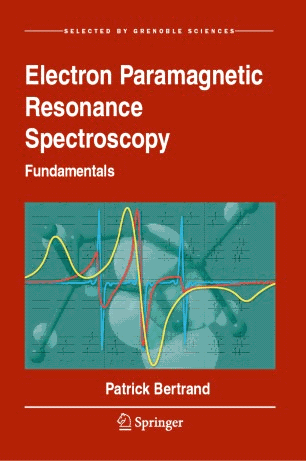
Electron Paramagnetic Resonance Spectroscopy. Fundamentals (2020)
Patrick Bertrand
Springer
ISBN 978-81-322-3653-5 (Print) 978-3-030-39663-3 (Online)
433 pagesPublisher Description: Although originally invented and employed by physicists, electron paramagnetic resonance (EPR) spectroscopy has proven to be a very efficient technique for studying a wide range of phenomena in many fields, such as chemistry, biochemistry, geology, archaeology, medicine, biotechnology, and environmental sciences. Acknowledging that not all studies require the same level of understanding of this technique, this book thus provides a practical treatise clearly oriented toward applications, which should be useful to students and researchers of various levels and disciplines. In this book, the principles of continuous wave EPR spectroscopy are progressively, but rigorously, introduced, with emphasis on interpretation of the collected spectra. Each chapter is followed by a section highlighting important points for applications, together with exercises solved at the end of the book. A glossary defines the main terms used in the book, and particular topics, whose knowledge is not required for understanding the main text, are developed in appendices for more inquisitive readers.
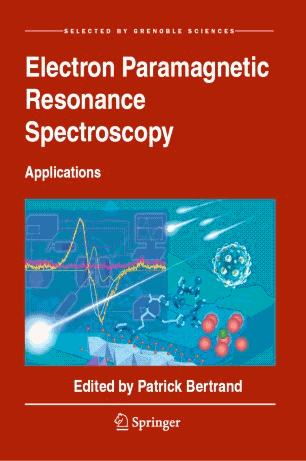
Electron Paramagnetic Resonance Spectroscopy.Applications (2020)
Patrick Bertrand
Springer
ISBN 978-3-030-39667-1 (Print) 978-3-030-39663-3 (Online)
454 pagesPublisher Description: This book shows how the fundamentals of electron paramagnetic resonance (EPR) spectroscopy are practically implemented and illustrates the diversity of current applications. The technique is used at various levels, and applications are presented in order of increasing difficulty, with reference to theoretically obtained results. This book features a diverse array of application examples, from fields such as ionizing radiation dosimetry, neurodegenerative diseases, structural transitions in proteins, and the origins of terrestrial life. The final chapter of this book highlights the principles and applications of the technique of ferromagnetic resonance spectroscopy, followed by a brief introduction to advanced EPR techniques such as electron spin echo envelope modulation (ESEEM), hyperfine sub-level correlation (HYSCORE), pulsed electron-electron double resonance (PELDOR), and continuous wave electron nuclear double resonance (ENDOR) experiments.
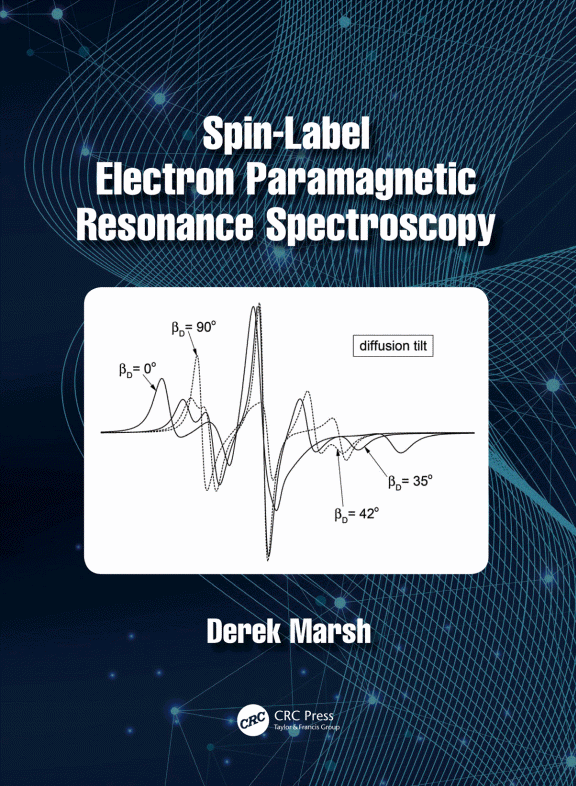
Spin-Label Electron Paramagnetic Resonance Spectroscopy (2020)
Derek Marsh
CRC
ISBN
514 pagesPublisher Description:
Spin-label electron paramagnetic resonance (EPR) spectroscopy is a versatile molecular probe method that finds wide application in molecular biophysics and structural biology. This book provides the first comprehensive summary of basic principles, spectroscopic properties, and use for studying biological membranes, protein folding, supramolecular structure, lipid-protein interactions, and dynamics. The contents begin with discussion of fundamental theory and practice, including static spectral parameters and conventional continuous-wave (CW) spectroscopy. The development then progresses, via nonlinear CW-EPR for slower motions, to the more demanding time-resolved pulse EPR, and includes an in-depth treatment of spin relaxation and spectral line shapes. Once the spectroscopic fundamentals are established, the final chapters acquire a more applied character. Extensive appendices at the end of the book provide detailed summaries of key concepts in magnetic resonance and chemical physics for the student reader and experienced practitioner alike.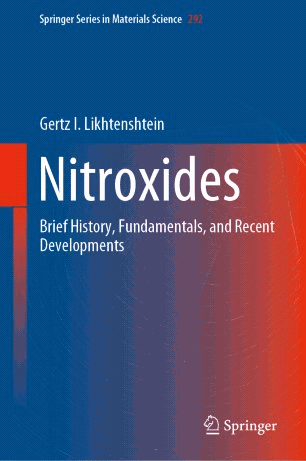
Nitroxides. Brief History, Fundamentals, and Recent Developments (2020)
Gertz I. Likhtenshtein
Springer
ISBN 978-3-030-34821-2 (Print) 978-3-030-34822-9 (Online)
323 pagesPublisher Description: Written by a pioneer in the development of spin labeling in biophysics, this expert book covers the fundamentals of nitroxide spin labeling through cutting-edge applications in chemistry, physics, materials science, molecular biology, and biomedicine. Nitroxides have earned their place as one of the most popular organic paramagnets due to their suitability as inhibitors of oxidative processes, as a means to polarize magnetic nuclei, and, in molecular biology, as probes and labels to understand molecular structures and dynamics as drags for cancer and other diseases. Beginning with an overview of the basic methodology and nitroxides’ 145-year history, this book equips students with necessary background and techniques to undertake original research and industry work in this growing field.

Fundamentals of Spin Exchange, Story of a Paradigm Shift by Kev M. Salikhov_19 (2019)
Kev M. Salikhov
Springer
ISBN 978-3-030-26821-3 (Print) 978-3-030-26822-0(Online) 2
65 pagesPublisher
Description: This book is a
comprehensive summary of 50 years of research from theoretical predictions to
experimental confirmation of the manifestation of spin exchange in EPR
spectroscopy.
The author unfolds the details of comprehensive state of the art of theoretical
calculations, which have been proven to become the core of the paradigm shift in
spin exchange and set the direction for the future of spin exchange research.
The book refers to important experimental data that confirms the theory. It
describes the modern protocol for determining the bi-molecular spin exchange
rate from the EPR spectra, which will be especially interesting for
experimentalists.
Given its scope, the book will benefit all researchers engaged in theory and
experiments in the area of spin exchange and its manifestations in EPR
spectroscopy, where many remarkable applications of the spin probe have been
developed.
Provides a comprehensive review of theoretical and experimental studies on spin
exchange and its applications
Presents the state of the art in calculations of spin exchange constants and
analysis of spin exchange in EPR spectroscopy
Describes the current protocol for determining the spin exchange rate by
analyzing the shape of the EPR spectra.
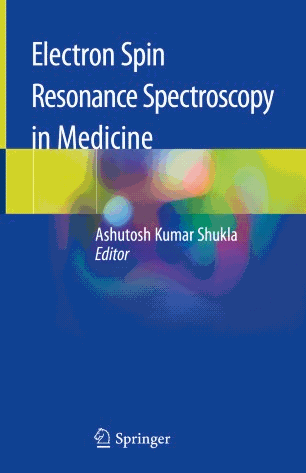
Electron Spin Resonance Spectroscopy in Medicine (2019)
Ashutosh Kumar Shukla
(Ed.)Springer
ISBN 978-981-13-2229-7 (Print) 978-981-13-2230-3(Online)
223 pagesPublisher Description: This book examines various applications of electron spin resonance spectroscopy (ESR) in medicine, covering topics such as interactions between blood and nanoparticles, physical intricacy of HbNO complexes, parasitic diseases, oxidative stress measurement, polymerization of resinous materials used in dentistry, tooth dosimetry and dermatological applications. Instead of providing mathematical details, it focuses on the applications and data interpretation of ESR as an emerging tool. This book is intended for students and researchers interested in the field of ESR applications in translational research and medicine.
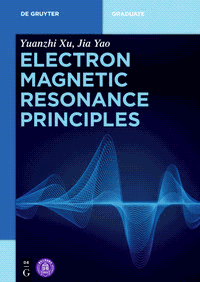
Electron Magnetic Resonance Principles (2019)
Yuanzhi Xu and Jia Yao
De Gruyter
ISBN 978-3-11-052800-8
451 pagesPublisher Description:
The book presents principles of electron magnetic resonance from a chemist’s point-of-view, covering g-tensor theory, isotropical hyperfine structure, anisotropical hyperfine structure and fine structure of spectrum, and relaxation theory. Detailed explanations on quantitative determination of paramagnetic species are given to address readers' difficulties. Written as a physical chemistry graduate textbook, it is also suitable for industry users.Provides theoretical frameworks for electron magnetic resonance. Elaborates quantitative determination of spectrum and paramagnetic species in gas phase and inorganic radical specialty. Includes abundant references for further learning.
Yuri D. TsvetkovMichael K. BowmanYuri A. Grishin (Eds.)n
Springer
ISBN 978-3-030-05371-0 (Print) 978-3-030-34822-9 (Online)
221 pagesPublisher Description: This book covers the basic theory and techniques, as well as various applications of pulsed electron–electron double resonance (PELDOR or DEER). This electron paramagnetic resonance technique is able to measure the distances and the distribution of distances between electron spins in the 1.5–15 nanometer scale; to determine the geometry of spin-labeled molecules; to estimate the number of interacting spins in spin clusters; and to characterize the spatial distribution of paramagnetic centers. As a result, PELDOR is now a popular method in EPR spectroscopy, particularly in the context of biologically important systems and soft matter and is also applied to problems in physical chemistry, biochemistry, polymers, soft matter and materials. Enabling readers to gain an understanding of the fundamentals of the PELDOR methods and an appreciation of the opportunities PELDOR provides, the book helps readers solve their own physical and biochemical problems.

Topics From EPR Research (2019)
Ahmed M. Maghraby
(Ed.)Intechr
ISBN 978-1-78985-300-1 89 pages
Publisher Description:
Electron paramagnetic resonance (EPR) spectroscopy has become one of the leading spectroscopic techniques. It targets materials containing unpaired electrons and possesses many applications. Since it was discovered more than 70 years ago, EPR spectroscopy is subjected to uninterrupted development and comprehensive studies. This book represents some of recent topics from EPR research.

EPR Spectroscopy: Fundamentals and Methods (2018)
Daniella Goldfarb, Stefan Stoll
Wiley
ISBN 978-1119-162-99-5 648 pages
Publisher Description:
This unique, self-contained resource is the first volume on electron paramagnetic resonance (EPR) spectroscopy in the eMagRes Handbook series. The 27 chapters cover the theoretical principles, the common experimental techniques, and many important application areas of modern EPR spectroscopy. EPR Spectroscopy: Fundamentals and Methods is presented in four major parts: A: Fundamental Theory, B: Basic Techniques and Instrumentation, C: High-Resolution Pulse Techniques, and D: Special Techniques.The first part of the book gives the reader an introduction to basic continuous-wave (CW) EPR and an overview of the different magnetic interactions that can be determined by EPR spectroscopy, their associated theoretical description, and their information content. The second provides the basics of the various EPR techniques, including pulse EPR, and EPR imaging, along with the associated instrumentation. Parts C and D builds on parts A and B and offer introductory accounts of a wide range of modern advanced EPR techniques, with examples of applications. The last two parts presents most of the new advances that do not appear in most of the classical EPR textbooks that focus on CW EPR.
EPR Spectroscopy: Fundamentals and Methods contains, in concise form, all the material needed to understand state-of-the-art EPR spectroscopy at the graduate school/research level, whilst the editors have ensured that it presents the topic at a level accessible to newcomers to the field and others who want to know its range of application and how to apply it.
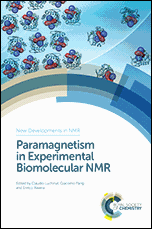
Claudio Luchinat, Giacomo Parigi, Enrico Ravera (Eds.)
CRC
ISBN 78-1-78801-086-3 316 pages
Publisher Description:
Paramagnetic NMR is a growing technique that represents an increasingly important tool for the investigation of biomolecules. This book presents an update and overview of the paramagnetic NMR phenomena and effects as well as guidelines for practical implementation of state-of-the-art experiments. All experiments are supported by a solid theoretical foundation. Areas mentioned are the development of solid state NMR, the use of paramagnetic tags providing information on the structure and mobility of the investigated systems, and dynamic nuclear polarization to increase sensitivity. Compiled by experts in the field, this book has international appeal for researchers as well as students interested in magnetic resonance and structural biology who require experimental support and accessible information.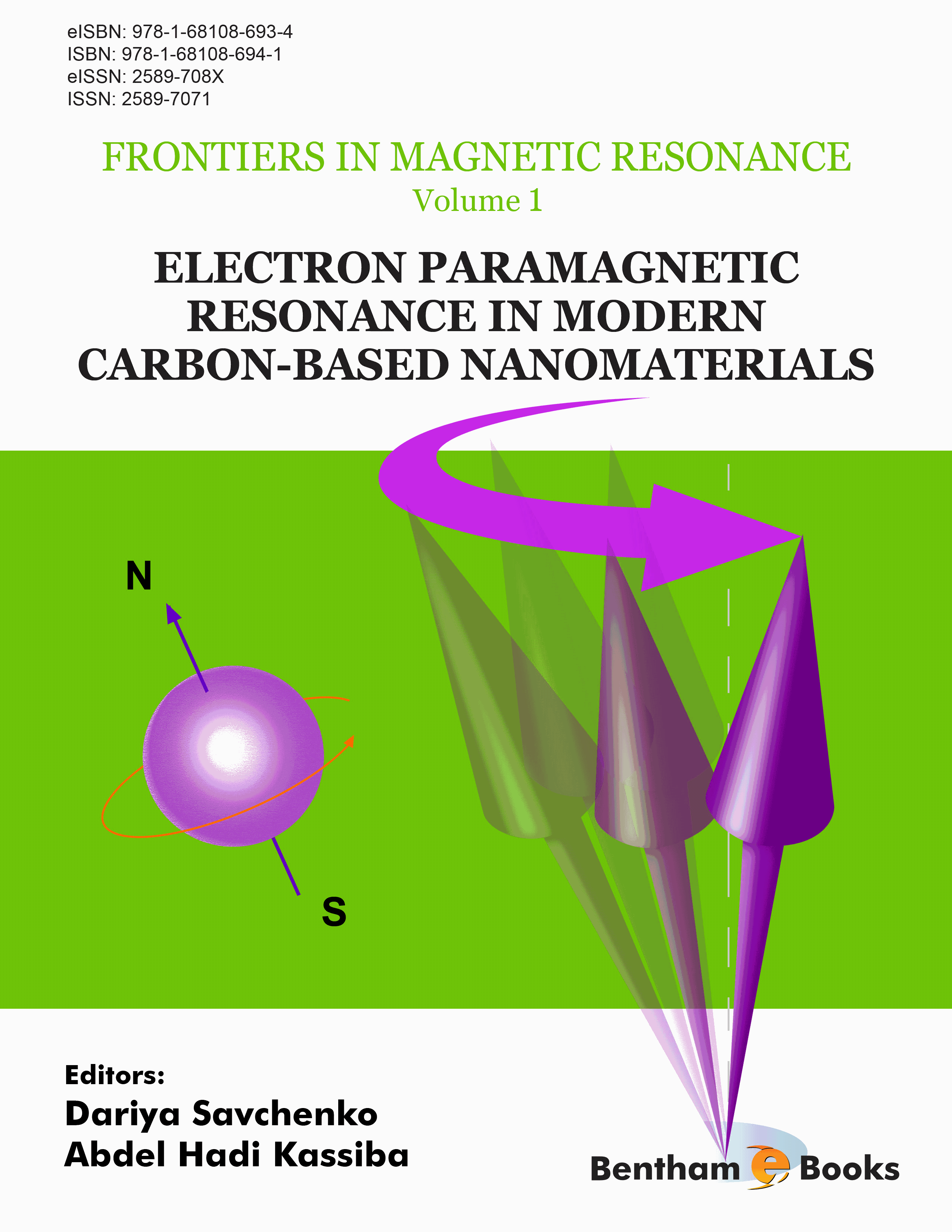
Electron Paramagnetic Resonance in Modern Carbon-Based Nanomaterials. Vol. 1 (2018)
Dariya Savchenko, Abdel Hadi Kassiba
Bentham Books
ISBN 2589-7071 3
04 pagesPublisher Description:
This volume presents information about several topics in the field of electron paramagnetic resonance (EPR) study of carbon-containing nanomaterials. It introduces the reader to an array of experimental and theoretical approaches for the analysis of paramagnetic centers (dangling bonds, interface defects, vacancies, and impurities) usually observed in modern carbon-containing materials such as nanographites, graphene, disordered onion-like carbon nanospheres (DOLCNS), single-walled carbon nanotubes (SWCNTs), multi-walled carbon nanotubes (MWCNT), graphene oxide (GO), reduced graphene oxide (rGO), nanodiamonds, silicon carbonitride (SiCN) and silicon carbide (SiC) based composites and thin films.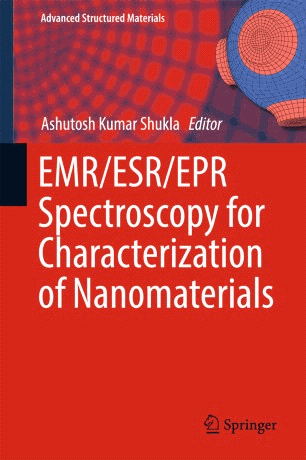
EMR/ESR/EPR Spectroscopy for Characterization of Nanomaterials (2017)
Ashutosh Kumar Shukla
(Ed.)Springer
ISBN 978-81-322-3653-5 (Print) 978-81-322-3655-9 (Online)
183 pagesPublisher Description: The subject matter of this book is the application of EMR/ESR/EPR spectroscopy for characterization of nanomaterials. Initial chapters deal with nanomaterials and their classification. Characterization of metallic nanoparticles, metal oxide nanoparticles and rare earth impurity doped nanoparticles from the (ESR) spectrum parameters are covered in the chapters that follow. A special feature of the book is EMR/ESR/EPR spectroscopic characterization of nanoparticles which are important due to their bactericidal and anticancerous properties. Strength of continuous wave (CW) is explained with the help of suitable examples. The book focuses on applications and data interpretation avoiding extensive use of mathematics so that it also caters to the need of young scientists in the life science disciplines. The book includes a comparison with other spectroscopic characterization methods so as to give an integrated approach to the reader. It will prove useful to biomedical scientists and engineers, chemists, and materials engineers in student, researcher, and practitioner positions.

Electron Spin Resonance in Food Science (2017)
Ashutosh Shukla (Editor)
Elsevier
ISBN 9780128054284 156 pages
Publisher Description:
Electron Spin Resonance in Food Science covers, in detail, the ESR identification of the irradiation history of food products and beverages to investigate changes that occur during storage, with an aim of improving hygienic quality and extending shelf-life with minimal tempering in nutritional profile.The book also includes ESR studies on the interaction of food items and packaging materials, along with a section on new approaches in ESR identification of irradiated foods that is followed by a chapter on international legislation relevant to irradiated food.
A section on ESR applications in characterizing ROS/antioxidants in food items and lipid oxidation, including spin labeling, spin trapping and imaging applications is also covered, as are ESR applications in nutrition and pharmaceutics.
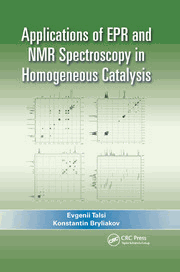
Applications of EPR and NMR Spectroscopy in Homogeneous Catalysis (2017)
Evgenii Talsi, Konstantin Bryliakovi
CRC
ISBN (Ebook)
243 pagesPublisher Description: This book reviews advances in important and practically relevant homogeneous catalytic transformations, such as single-site olefin polymerizations and chemo- and stereo-selective oxidations. Close attention is paid to the experimental investigation of the active sites of catalytic oxidation systems and their mechanisms. Major subjects include the applications of NMR and EPR spectroscopic techniques and data obtained by other physical methods. The book addresses a broad readership and focus on widespread techniques available in labs with NMR and EPR spectrometers.
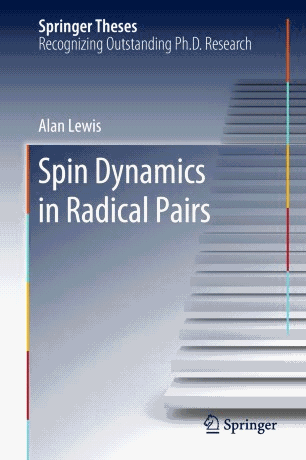
Spin Dynamics in Radical Pairs (2017)
A
lan LewisSpringer
ThesesISBN 978-3-030-00685-3 (Print) 978-3-030-00686-0 (Online) 1
67 pagesPublisher Description:
This book sheds new light on the dynamical behaviour of electron spins in molecules containing two unpaired electrons (i.e. a radical pair). The quantum dynamics of these spins are made complicated by the interaction between the electrons and the many nuclear spins of the molecule; they are intractable using analytical techniques, and a naïve numerical diagonalization is not remotely possible using current computational resources. Hence, this book presents a new method for obtaining the exact quantum-mechanical dynamics of radical pairs with a modest number of nuclear spins. Readers will learn how a calculation that would take 13 years using conventional wavepacket propagation can now be done in 1 day, and will also discover a new semiclassical method for approximating the dynamics in the presence of many nuclear spins. The new methods covered in this book are shown to provide significant insights into three topical and diverse areas: charge recombination in molecular wires (which can be used in artificially mimicking photosynthesis), magnetoelectroluminescence in organic light-emitting diodes, and avian magnetoreception (how birds sense the Earth’s magnetic field in order to navigate).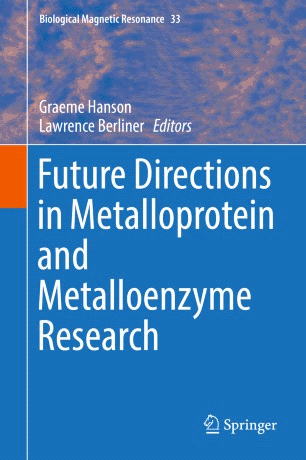
Future Directions in Metalloprotein and Metalloenzyme Research (2017)
G. Hanson, L. Berliner (Eds.)
Springer
ISBN 978-3-319-59098-1 (Print) 978-3-319-59100-1 (Online) 199 pages
Publisher Description: This book covers the latest developments in metalloenzymes, including characterizing metal bridging in proteins and peptides, copper(II) complexes of marine peptides, high-spin Co(II) in model and metalloprotein systems to enzymes such as the molybdenum-containing enzymes, CW and pulse EPR of cytochrome P450 enzymes and the radical S-adenosylmethionine FeS family. In the previous two related volumes in the Biological Magnetic Resonance series, High-Resolution EPR: Applications to Metalloenzymes and Metals in Medicine and Metals in Biology:Applications of High-Resolution EPR to Metalloenzymes, topics covered included high-resolution EPR methods, iron proteins, nickel and copper enzymes, metals in medicine, iron–sulfur cluster-containing proteins, and molybdenum enzymes. In this volume, new developments in these areas are covered in detail and new areas that have emerged are also detailed. This is an ideal book for graduate students and researchers working in the fields of high-resolution EPR, metalloenzymes, and metals in biology.
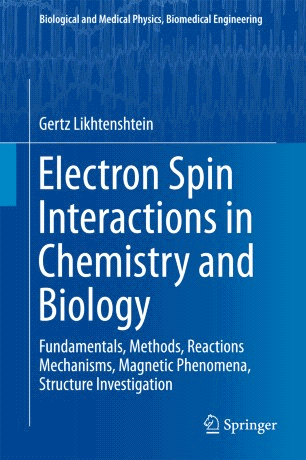
Gertz Likhtenshtein
Springer
ISBN: 9978-3-319-33926-9(Print) 9978-3-319-33927-6 (Online)
355 pagesPublisher Description: This book presents the versatile and pivotal role of electron spin interactions in nature. It provides the background, methodologies and tools for basic areas related to spin interactions, such as spin chemistry and biology, electron transfer, light energy conversion, photochemistry, radical reactions, magneto-chemistry and magneto-biology. The book also includes an overview of designing advanced magnetic materials, optical and spintronic devices and photo catalysts. This monograph appeals to scientists and graduate students working in the areas related to spin interactions physics, biophysics, chemistry and chemical engineering..
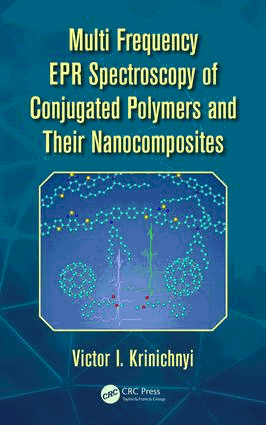
Multi Frequency EPR Spectroscopy of Conjugated Polymers and Their Nanocomposites (2016)
Victor I. Krinichnyi
CRC
ISBN 9781315366852 (
Ebook) 314 pagesPublisher Description: Conjugated polymeric materials and their nanocomposites are widely used for the creation of alternative sources of renewable energy, cell phone screens, mobile gadgets, video players and OLED-TV, as well as organic diodes, transistors, sensors, etc. with field-dependent and spin-assisted electronic properties. Multifrequency EPR Spectroscopy methods can help researchers optimize their structural, magnetic and electronic properties for the creation of more efficient molecular devices. This book will acquaint the reader with the basic properties of conjugated polymers, the fundamentals of EP
R. Spectroscopy, and the information that can be obtained at different wavebands of EPR spectroscopy.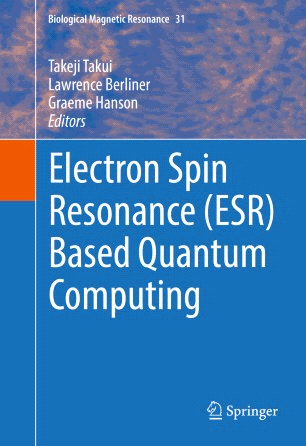
Electron Spin Resonance (ESR) Based Quantum Computing (2016)
T. Takui, L. Berliner, G. Hanson (Eds.)
Springer
ISBN 978-1-4939-3656-4 (Print) 978-1-4939-3658-8 (Online) 259 pages
Publisher Description: This book addresses electron spin-qubit based quantum computing and quantum information processing with a strong focus on the background and applications to EPR/ESR techniques and spectroscopy. It explores a broad spectrum of topics including quantum computing, information processing, quantum effects in electron-nuclear coupled molecular spin systems, adiabatic quantum computing, heat bath algorithmic cooling with spins, and gateway schemes of quantum control for spin networks to NMR quantum information. The organization of the book places emphasis on relevant molecular qubit spectroscopy. These revolutionary concepts have never before been included in a comprehensive volume that covers theory, physical basis, technological basis, applications, and new advances in this emerging field. This book is an ideal resource for students and researchers in the fields of EPR/ESR, NMR and quantum computing.

Elsevier
ISBN 9780128028346 702 pages
Publisher Description: Electron Paramagnetic Resonance Investigations of Biological Systems by Using Spin Labels, Spin Probes, and Intrinsic Metal Ions Part A & B, are the latest volumes in the Methods in Enzymology series, continuing the legacy of this premier serial with quality chapters authored by leaders in the field. This volume covers research methods centered on the use of Electron Paramagnetic Resonance (EPR) techniques to study biological structure and function
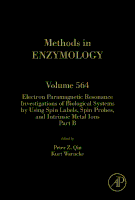
Elsevier
ISBN 978-0-12-802835-3 597 pages
Publisher Description: Electron Paramagnetic Resonance Investigations of Biological Systems by Using Spin Labels, Spin Probes, and Intrinsic Metal Ions Part A & B, are the latest volumes in the Methods in Enzymology series, continuing the legacy of this premier serial with quality chapters authored by leaders in the field. This volume covers research methods centered on the use of Electron Paramagnetic Resonance (EPR) techniques to study biological structure and function
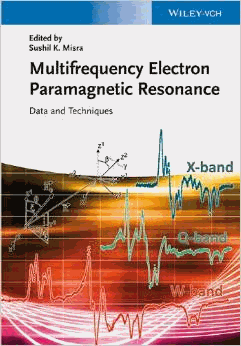
Multifrequency Electron Paramagnetic Resonance: Data and Techniques
(2014)Sushil K. Misra (Editor)
Wiley
ISBN 9783527412228 320 pages
Publisher Description:
This handbook is aimed to deliver an up-to-date account of some of the recently developed experimental and theoretical methods in EPR, as well as a complete up-to-date listing of the experimentally determined values of multifrequency transition-ion spin Hamiltonian parameters by Sushil Misra, reported in the past 20 years, extending such a listing published by him in the Handbook on Electron Spin Resonance, volume 2. This extensive data tabulation makes up roughly 60% of the book`s content. It is complemented by the first full compilation of hyperfine splittings and g-factors for aminoxyl (nitroxide) radicals since 197 by Larry Berliner, a world expert on spin labeling, helping to identify and interpret substances and processes by means of EPR techniques. The book also includes coverage of the recently developed experimental technique of rapid-scan EPR by Sandra Eaton and Gareth Eaton, and a thorough review of computational modeling in EPR by Stefan Stoll, author of Easy Spin.
Anders Lund, Masaru Shiotani
Springer
ISBN 978-3-319-09215-7 (Print) 978-3-319-09216-4 (Online)
773 pagesPublisher Description: Applications of EPR in Radiation Research is a multi-author contributed volume presented in eight themes: I. Elementary radiation processes (fundamental reaction mechanisms, low temperature radiolysis, quantum solids); II: Solid state radiation chemistry (crystalline, amorphous and heterogeneous systems); III: Biochemistry, biophysics and biology applications (radicals in biomaterials, spin trapping, free-radical-induced DNA damage); IV: Materials science (polymeric and electronic materials, materials for treatment of nuclear waste); V: Radiation metrology (EPR-dosimetry, clinical applications); VI: Geological applications; VII: Advanced techniques (pulsed and optically detected EPR, spatial distributions of radicals, radical ion pairs); VIII: Theoretical tools (density-functional calculations, spectrum simulations).

Structural Information from Spin-Labels and Intrinsic Paramagnetic Centres in the Biosciences (2014)
Christiane R. Timmel, Jeffrey R. Harmer
(Editors)Springer
ISBN 978-3-642-39124-8 (Print) 978-3-642-39125-5 (Online)
322 pagesPublisher Description: Pulse Dipolar Electron Spin Resonance: Distance Measurements by Peter P. Borbat, Jack H. Freed.Interpretation of Dipolar EPR Data in Terms of Protein Structure, by Gunnar Jeschke.Site-Directed Nitroxide Spin Labeling of Biopolymers, by Sandip A. Shelke and Snorri Th. Sigurdsson. Metal-Based Spin Labeling for Distance Determination, by Daniella Goldfarb. Structural Information from Spin-Labelled Membrane-Bound Proteins, by Johann P. KLare, Heinz-Jürgen Steinhoff. Structural Information from Oligonucleotides, by Richard Ward and Olav Schiemann. Orientation selective DEER using rigid spin labels, cofactors, metals, and clusters, by Claudia E. Tait, Alice M. Bowen, Christiane R. Timmel, Jeffrey Harmer).

Magnetic Resonance and Its Applications (2014)
Vladimir I. Chizhik, Yuri S. Chernyshev, Alexey V. Donets, Vyacheslav V. Frolov, Andrei V. Komolkin, Marina G. Shelyapina.
Springer
ISBN 978-3-319-05298-4 (Print) 978-3-319-05299-1 (Online) 782 Pages
Publisher Description: The book is devoted to the description of the fundamentals in the area of magnetic resonance. The book covers two domains: radiospectroscopy and quantum radioelectronics. Radiospectroscopy comprises nuclear magnetic resonance , electron paramagnetic resonance, nuclear quadrupolar resonance, and some other phenomena. The radiospectroscopic methods are widely used for obtaining the information on internal (nano, micro and macro) structure of objects. Quantum radioelectronics, which was developed on the basis of radiospectroscopic methods, deals with processes in quantum amplifiers, generators and magnetometers. We do not know analogues of the book presented. The book implies a few levels of the general consideration of phenomena, that can be useful for different groups of readers (students, PhD students, scientists from other scientific branches: physics, chemistry, physical chemistry, biochemistry, biology and medicine).
Saakov, V.S., Drapkin, V.Z., Krivchenko, A.I., Rozengart, E.V., Bogachev, Y.V., Knyazev, M.N.
Springer
ISBN 978-3-7091-1007-2 357 pages
Publisher Description: This book provides a multidisciplinary overview to the application of high order derivative spectrophotometry and Electron Spin Resonance (ESR) spectroscopy in biology and ecology. The characteristics of the principle methods as well as the generation of reliable spectra are discussed in general terms allowing the reader to gain an idea of these methods’ potentials. Furthermore the authors give an extended overview to the spectroscopic and spectro-photometric analysis of specific biological materials. This volume is a well condensed description of an analytical method and a clear review to its application in biology and related fields and an essential tool for researchers who are new in the field of spectroscopic methods and their applications in the life sciences.

Anders Lund, Masaru Shiotani (Editors)
Springer
ISBN 978-94-007-4892-7 (Print) 978-94-007-4893-4 (Online) 414 pages
Publisher Description: EPR
of Free Radicals in Solids: Trends in Methods and Applications, 2nd ed. presents a critical two volume review of the methods and applications of EPR (ESR) for the study of free radical processes in solids. Emphasis is on the progress made in the developments in EPR technology, in the application of sophisticated matrix isolation techniques and in the advancement in quantitative EPR that have occurred since the 1st edition was published. Improvements have been made also at theoretical level, with the development of methods based on first principles and their application to the calculation of magnetic properties as well as in spectral simulations.EPR of Free Radicals in Solids I focuses on the trends in experimental and theoretical methods to extract structural and dynamical properties of radicals and spin probes in solid matrices by continuous wave (CW) and pulsed techniques. It presents simulation techniques and software for CW and pulsed EPR as well as studies of quantum effects at low temperature. The chapters dealing with quantum chemistry methods for the theoretical interpretation of hyperfine coupling tensors and g-tensors have been much extended in this edition and a new chapter on the calculation of zero-field splitting tensors has been added. This new edition is a valuable resource to experimentalists and theoreticians in research involving free radicals, as well as for students of advanced courses in physical chemistry, chemical physics, materials science, biophysics, biochemistry and related fields.
This new edition is a valuable resource to experimentalists and theoreticians in research involving free radicals, as well as for students of advanced courses in physical chemistry, chemical physics, materials science, biophysics, biochemistry and related fields

Anders Lund, Masaru Shiotani (Editors)
Springer
ISBN 978-94-007-4886-6 (Print) 978-94-007-4887-3 (Online) 444 pages
Publisher Description: EPR of Free Radicals in Solids: Trends in Methods and Applications, 2nd ed. presents a critical two volume review of the methods and applications of EPR (ESR) for the study of free radical processes in solids. Emphasis is on the progress made in the developments in EPR technology, in the application of sophisticated matrix isolation techniques and in the advancement in quantitative EPR that have occurred since the 1st edition was published. Improvements have been made also at theoretical level, with the development of methods based on first principles and their application to the calculation of magnetic properties as well as in spectral simulations. EPR of Free Radicals in Solids II focuses on the trends in applications of experimental and theoretical methods to extract structural and dynamical properties of radicals and spin probes in solid matrices by continuous wave (CW) and pulsed techniques in nine chapters written by experts in the field. It examines the studies involving radiation- and photo-induced inorganic and organic radicals in inert matrices, the high-spin molecules and metal-based molecular clusters as well as the radical pro-cesses in photosynthesis. Recent advancements in environmental applications in-cluding measurements by myon resonance of radicals on surfaces and by quantitative EPR in dosimetry are outlined and the applications of optical detection in material research with much increased sensitivity reviewed. The potential use of EPR in quantum computing is considered in a newly written chapter. This new edition is aimed to experimentalists and theoreticians in research involving free radicals, as well as for students of advanced courses in physical chemis-try, chemical physics, materials science, biophysics, biochemistry and related fields.

Malte Drescher, Gunnar Jeschke
Springer
ISBN 978-3-642-28346-8 (Print) 978-3-642-28347-5 (Online) 238 pages
Publisher Description: EPR Spectroscopy in Catalysis, by Sabine Van Doorslaer und Damien M. Murphy Radicals in Flavoproteins, by Erik Schleicher und Stefan Weber EPR Spectroscopy in Polymer Science, by Dariush Hinderberger EPR in Protein Science, by Intrinsically Disordered Proteins, by Malte Drescher Site-Directed Spin Labeling of Membrane Proteins, by Enrica Bordignon Structure and Dynamics of Nucleic Acids, by Ivan Krstić, Burkhard Endeward, Dominik Margraf, Andriy Marko und Thomas F Prisner New Directions in Electron Paramagnetic Resonance Spectroscopy on Molecular Nanomagnets, by J. van Slagerens.
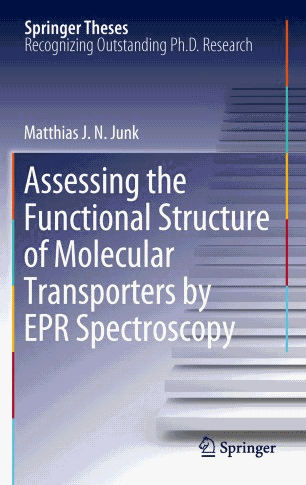
Assessing the Functional Structure of Molecular Transporters by EPR Spectroscopy (2012)
J.N. Junk
Springer Theses
ISBN 978-3-642-25134-4 (Print) 978-3-642-25135-1 (Online) 2
25 pagesPublisher Description:
In his thesis, Matthias Junk takes an innovative approach to assess the local structure and dynamics of biological and synthetic amphiphilic macromolecules capable of transporting small molecules. Replacing the latter with stable radicals, he uses state-of-the-art electron paramagnetic resonance (EPR) spectroscopy to describe the highly relevant transport function from the viewpoint of the guest molecules. Such, he demonstrates that the functional structure of human serum albumin in solution significantly differs from its crystal structure – a consequence of the protein’s adaptability to host various endogenous compounds and drug molecules. Further, he shows that the thermal collapse of thermoresponsive hydrogels and dendronized polymers leads to static and dynamic heterogeneities on the nanoscale. These heterogeneities bear consequences for the material’s hosting properties and enable unforeseen complex catalytic functionalities.
Encyclopedia of Radicals in Chemistry, Biology and Materials (201
2)Chryssostomos Chatgilialoglu and Armido Stude
r (Editors)Wiley
Online ISBN 978111995367
ISBN 978-0-470-97125-3 2324 pagesPublisher Description: H
ighlighting the growing applications of free radicals in key chemical, biological and medical processes Over the last two decades the application of free radicals in organic synthesis, materials science and life science has steadily increased, this Encyclopedia presents methodologies and mechanisms involving free radicals of chemical and biological research, including applications in materials science and medicine.The aim of this Encyclopedia is to offer for the first time a description of free radicals within an interdisciplinary and multidisciplinary context, connecting structural characteristics and chemical properties to their applications in different areas of chemistry and related disciplines.
It covers not only basic concepts and chemical synthesis, but also touches on various aspects concerning the role of free radicals in materials and life sciences. The reader will find a balanced contribution of topics related to free radicals covering for example, their role in proteomics, genomics and lipidomics as well as their enormous potential in synthesis and technology.
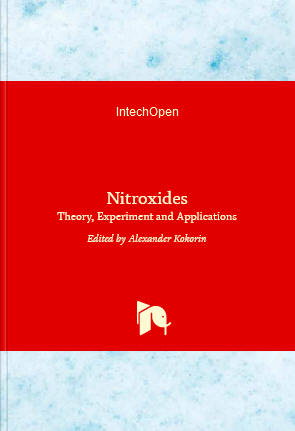
Nitroxides-Theory, Experiment and Applications (2012)
A
lexander Kokorin (Ed.)Intech
ISBN 9978-953-51-0722-4
445 pagesPublisher Description:
Nitroxide (aminoxyl) radicals became the start point for one of the most interesting and rapidly developing areas of modern chemical physics with valuable applications to biophysics, molecular biology, polymer sciences and medicine. This book, consisting of 15 chapters gathered in 3 sections, written by authors actively involved in the area of spin label/probe technique. The authors describe in detail some novel trends and analyze new approaches of practical applications of nitroxide radicals. The book, recommended by the Governing Council of N. Semenov International Center of Chemical Physics, Moscow, will be of help to many scientists: chemists, physical chemists, biophysicists, biologists, physicians and other experts in a variety of disciplines, in which spin labels and probes are used, as well as to students and PhD students. It may be also suitable for teaching, and may help to promote the progress in natural sciences.
Fluorescence and Electron Paramagnetic Resonance (EPR)Spectroscopy: Basic Principles, the Different Techniques and Applications
(2011)Abebe Belay
LAP LAMBERT Academic Publishing
ISBN 3843388954 84 pages
Publisher Description: The book divided in to two parts. In the first part of this book, the historical development, the basic principles and some photo-physical process of fluorescence spectroscopy, the various biological applications of this instruments were presented. In second part, the historical development of EPR, a typical atomic system that exhibit paramagnetic system, the basic principles and applications of this instrument in biological and chemical systems were reviewed.

Multifrequency Electron Paramagnetic Resonance: Theory and applications (2011)
Sushil K. Misra (Editor)
Wiley
ISBN 3527407790 1056 pages
Publisher Description:
Filling the gap for a systematic, authoritative, and up-to-date review of this cutting-edge technique, this book covers both low and high frequency EPR, emphasizing the importance of adopting the multifrequency approach to study paramagnetic systems in full detail by using the EPR method. In so doing, it discusses not only the underlying theory and applications, but also all recent advances -- with a final section devoted to future perspectives.
Principles and Applications of ESR Spectroscopy (2010)
Lund Anders, Shiotani Masaru, Shimada Shigetaka.
Springer-Verlag
ISBN 978-1402053436 461 Pages
Publisher Description: Principles and Applications of ESR Spectroscopy" fills the gap between the detailed monographs in ESR spectroscopy and the general textbooks in molecular physics, physical chemistry, biochemistry or spectroscopy. The latter only briefly explain the underlying theory and do not provide details about applications, while the currently available ESR textbooks are primarily focused on the technique as such.

Quantitative EPR. A Practitioners Guide (2010)
Eaton Gareth R., Eaton Sandra S., Barr David P.,
Weber Ralph T.
Springer
ISBN 978-3211929476
Publisher Description: This is the first comprehensive yet practical guide for people who perform quantitative EPR measurements. No existing book provides this level of practical guidance to ensure the successful use of EPR. There is a growing need in both industrial and academic research to provide meaningful and accurate quantitative EPR results. This text discusses the various sample, instrument and software related aspects required for EPR quantitation. Specific topics include: choosing a reference standard, resonator considerations (Q, B1, Bm), power saturation characteristics, sample positioning, and finally, putting all the factors together to obtain an accurate spin concentration of a sample.

Metals in Biology. Applications of High-Resolution EPR to Metalloenzymes (2010)
G. Hanson, L. Berliner (Eds.)
Springer
ISBN 978-1-4419-1138-4
Publisher Description: Metal ions in biology is an ever expanding area in science and medicine involving metal ions in proteins and enzymes, their biosynthesis, catalysis, electron transfer, metal ion trafficking, gene regulation and disease. While X-ray crystallography has provided snapshots of the geometric structures of the active site redox cofactors in these proteins, the application of high resolution EPR spectroscopy in conjunction with quantum chemistry calculations has enabled, in many cases, a detailed understanding of a metalloenzymes mechanism through investigations of the geometric and electronic structure of the resting, enzyme-substrate intermediates and product complexes. This volume, Part II of a two-volume set demonstrates the application of high resolution EPR spectroscopy in determining the geometric and electronic structure of active site metal ion centers in iron sulfur cluster containing metalloproteins, mononuclear molybdenum metalloenzymes, manganese-containing enzymes and novel metalloproteins.
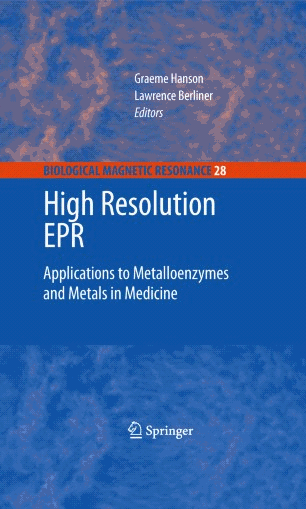
High Resolution EPR. Applications to Metalloenzymes and Metals in Medicines (2009)
G. Hanson, L. Berliner (Eds.)
Springer
ISBN 978-0-387-84855-6
Publisher Description: Metalloproteins are involved in a variety of biologically important processes, including metal ion and oxygen transport, biosynthesis, electron transfer, biodegradation, drug metabolism, proteolysis and peptide hydrolysis, environmental oxygen, sulphur, and nitrogen cycles, and disease states. High-resolution EPR spectroscopy is crucial in determining the geometric and electronic structural characterization of the redox cofactors in metalloenzymes, which is essential for understanding their reactivity in complex biological systems.This volume, Part I of a two-volume set, covers high-resolution EPR methods, computer simulation, density functional theory, and their application to iron proteins, nickel, and copper enzymes and metals in medicine. The following chapters, written by experts in their fields.
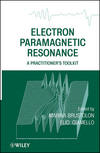 Electron Paramagnetic Resonance: A Practitioners Toolkit(
2009),
Electron Paramagnetic Resonance: A Practitioners Toolkit(
2009),
Brustolon
Marina R., Giamello Elio (Editors)
Wiley
ISBN 978-0470258828
Publisher Description: This book offers a pragmatic guide to navigating through the complex maze of EPR/ESR spectroscopy fundamentals, techniques, and applications. Written for the scientist who is new to EPR spectroscopy, the editors have prepared a volume that de-mystifies the basic fundamentals without weighting readers down with detailed physics and mathematics, and then presents clear approaches in specific application areas. The first part presents basic fundamentals and advantages of electron paramagnetic resonance spectrscopy. The second part explores severalapplication areas including chemistry, biology, medicine, materials and geology. A frequently-asked-questions sections focuses on practicalquestions, such as the size of sample, etc. It's an ideal, hands-on reference for chemists and researchers in the pharmaceutical and materials (semiconductor) industries who are looking for a basic introduction to EPR spectroscopy.
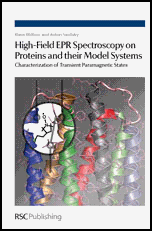
High-Field EPR
Spectroscopy on Proteins and their Model Systems: Characterization of Transient
Paramagnetic States (2008)
Klaus Möbius, Anton Savitsky.
RSC, Royal Society of Chemistry
ISBN 978-0854043552.
Publisher Description: Understanding the major factors determining the specificity of transmembrane transfer processes in proteins is now a hot topic in molecular bio-science. Advanced electron paramagnetic resonance (EPR) at high magnetic fields is a powerful technique for characterizing the transient states of proteins in action. High-Field EPR Spectroscopy on Proteins and their Model Systems: characterization of Transient Paramagnetic States offers a comprehensive overview of experimental techniques in, and paradigmatic examples of, the application of high-field EPR spectroscopy in biology and chemistry. The book’s focus is on the use of the technique in conjunction with site-specific mutation strategies and advanced quantum-chemical computation methods to reveal protein structure and dynamics. This yields new insights into biological processes at the atomic and molecular level. The theoretical and instrumental background of high-field EPR is described and examples of paradigmatic protein systems, such as photosynthetic reaction centres, are discussed in the light of recent investigations. Aspects of structure dynamics-function relations that are revealed by studying site-specific mutants are highlighted, thereby combining high-field EPR with genetic engineering techniques. The information obtained complements that obtained from protein crystallography, solid-state NMR, infrared and optical spectroscopy. The book documents both background knowledge and results of the latest research in the field. Unique features include comparisons of information content of EPR, ENDOR, Triple resonance, ESEEM and PELDOR taken at different microwave frequencies and magnetic fields. Coherent treatment of the subject by the leading Berlin high-field EPR laboratory covers the theoretical background as well as state-of-art research both in terms of instrumentation and application to biological systems. The book provides an outlook to future developments and references for further reading and is essential reading for postdoctoral scientists, professionals, academics and graduate students working in this field.
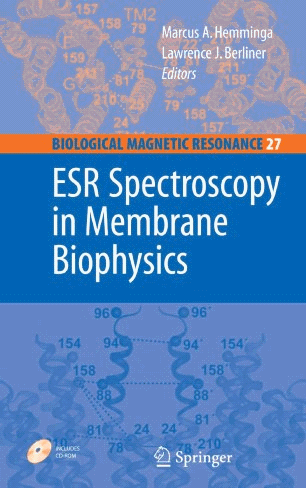
M. Hemminga, L. Berliner (Eds.)
Springer
ISBN 978-0-387-25066-3
Publisher Description: Membrane proteins offer the greatest challenge in structural biology, and there is an urgent need to develop and apply new biophysical methodologies that are able to generate detailed structural information. Among modern biophysical techniques, site-directed spin-labeling electron spin resonance (SDSL-ESR) appears to show the highest potential to further develop the field. The objective of this book is to provide in-depth information about new advances of SDSL-ESR in membrane biophysics, emphasizing recent developments in the application to membrane proteins. The contributions in this volume illustrate the current state of the art of SDSL-ESR and highlight new advances in high-field ESR and pulsed ESR.

Biomolecular EPR Spectroscopy
(2008)
Hagen Wilfred R.
CRC
ISBN 978-1420059571
Publisher Description: This authoritative reference seamlessly covers all important bioEPR applications, including low-spin and high-spin metalloproteins, spin traps and spin lables, interaction between active sites, and redox systems. It is loaded with practical tricks as well as do’s and don’ts that are based on the author’s 30 years of experience in the field. The book also comes with an unprecedented set of supporting software designed with simple graphical user interfaces that allow readers to tackle problems they will likely encounter when engaged in spectral analysis.

Electron Spin Resonance: Analysis and
Interpretation (2007)
Rieger
Philip H.
RSC, Royal Society of Chemistry
ISBN 978-0854043552.
Publisher Description: Electron Spin Resonance covers the obtaining, analysing and interpreting of cw X-band ESR spectra of molecules with unpaired electron (s). The purpose of the book is to describe in mathematical terms the extraction of useful information from ESR spectra about the interaction of unpaired electrons with atoms in the molecules being studied. A reader familiar with quantum mechanics should gain a thorough understanding of the origins of the phenomena which make ESR spectra possible. The information that can be obtained from the spectra are explained in detail and in a logical step-by-step fashion. Examples of spectra of organic, inorganic and organometallic molecules, both in solution and in frozen solution are shown, analysed and interpreted and the mathematical basis of this interpretation clearly presented. The examples start with straightforward cases and proceed to more complicated ones. The ESR of biradicals, triplet states and other systems with more than one unpaired electron is also addressed. Particular attention is paid to the analysis and interpretation of spectra obtained from frozen solutions of paramagnetic organometallic compounds in which the g-matrix and the molecular axes are non-coincident.
This book lays a firm groundwork for understanding more sophisticated experiments, which the availability of newer commercial instruments have made possible.
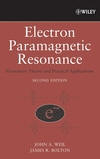 Electron Paramagnetic Resonance:
Elementary Theory and Practical Applications. 2nd Ed. (2007)
Electron Paramagnetic Resonance:
Elementary Theory and Practical Applications. 2nd Ed. (2007)
Weil John A., Bolton J.R
Wiley
ISBN 978-0471754961.
Publisher Description: This book provides an introduction to the underlying theory, fundamentals, and applications of EPR spectroscopy, as well as new developments in the area. Knowledge of the topics presented will allow the reader to interpret of a wide range of EPR spectra, as well as help them to apply EPR techniques to problem solving in a wide range of areas: organic, inorganic, biological, and analytical chemistry; chemical physics, geophysics, and minerology. Includes updated information on high frequency and multi-frequency EPR, pulsed microwave techniques and spectra analysis, dynamic effects, relaxation phenomena, computer-based spectra simulation, biomedical aspects of EPR, and more.
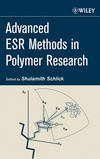 Advanced ESR Methods in Polymer Research
(2006)
Advanced ESR Methods in Polymer Research
(2006)
Schlick
Shulamit (Editor)
Wiley
ISBN 978-0471731894.
Publisher Description: A definitive work on ESR and polymer science by today's leading authorities
The past twenty years have seen extraordinary advances in electron spin resonance (ESR) techniques, particularly as they apply to polymeric materials. With contributions from over a dozen of the world's top polymer scientists, Advanced ESR Methods in Polymer Research is the first book to bring together all the current trends in this exciting field into one comprehensive reference.
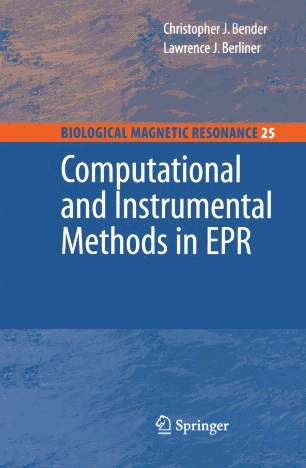
C. Bender, L. Berliner (Eds.)
Springer
ISBN 978-0-387-33145-4 226 Pages
Publisher Description:
Electron magnetic resonance has been greatly facilitated by the introduction of advances in instrumentation and better computational tools, such as the increasingly widespread use of the density matrix formalism. This volume is devoted to both instrumentation and computation aspects of EPR, while addressing applications such as spin relaxation time measurements, the measurement of hyperfine interaction parameters, and the recovery of Mn(II) spin Hamiltonian parameters via spectral simulation.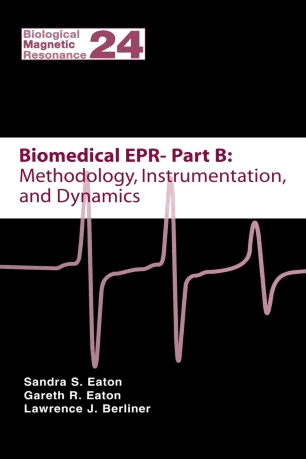
Biomedical EPR, Part B: Methodology, Instrumentation, and Dynamics (2005)
S.R. Eaton, E.R. Eaton, L. Berliner (Eds.)
Springer
ISBN 78-0-306-48532-9 486 Pages
Publisher Description:
Biomedical EPR – Part B focuses on applications of EPR techniques and instrumentation, with applications to dynamics. The book celebrates the 70th birthday of Prof. James S. Hyde, Medical College of Wisconsin, and his contributions to this field. Chapters are written to provide introductory material for new-comers to the field that lead into up-to-date reviews that provide perspective on the wide range of questions that can be addressed by EPR.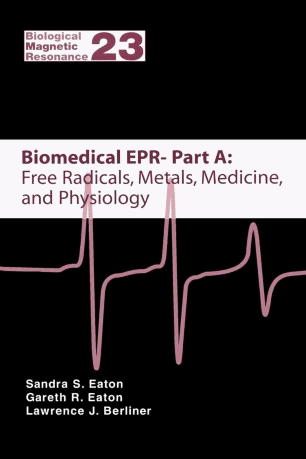
Biomedical EPR, Part A: Free Radicals, Metals, Medicine, and Physiology (2004)
S.R. Eaton, E.R. Eaton, L. Berliner (Eds.)
Springer
ISBN 978-0-306-48506-0 536 Pages
Publisher Description:
Biomedical EPR – Part A focuses on applications of EPR spectroscopy in the areas of free radicals, metals, medicine, and physiology. The book celebrates the 70th birthday of Prof. James S. Hyde, Medical College of Wisconsin, and his contributions to this field. Chapters are written to provide introductory material for new-comers to the field which lead into up-to-date reviews that provide perspective on the wide range of questions that can be addressed by EPR.
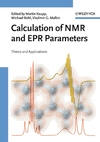 Calculation of NMR and EPR Parameters:
Theory and Applications (2004)
Calculation of NMR and EPR Parameters:
Theory and Applications (2004)
Kaupp
Martin, Bühl Michael, Malkin Vladimir G.(Eds.)
Wiley
ISBN 978-3527307791
Publisher Description: This is the first book to present the necessary quantum chemical methods for both resonance types in one handy volume, emphasizing the crucial interrelation between NMR and EPR parameters from a computational and theoretical point of view. Here, readers are given a broad overview of all the pertinent topics, such as basic theory, methodic considerations, benchmark results and applications for both spectroscopy methods in such fields as biochemistry, bioinorganic chemistry as well as with different substance classes, including fullerenes, zeolites and transition metal compounds. The chapters have been written by leading experts in a given area, but with a wider audience in mind.The result is the standard reference on the topic, serving as a guide to the best computational methods for any given problem, and is thus an indispensable tool for scientists using quantum chemical calculations of NMR and EPR parameters.A must-have for all chemists, physicists, biologists and materials scientists who wish to augment their research by quantum chemical calculations of magnetic resonance data, but who are not necessarily specialists in these methods or their applications. Furthermore, specialists in one of the subdomains of this wide field will be grateful to find here an overview of what lies beyond their own area of focus.
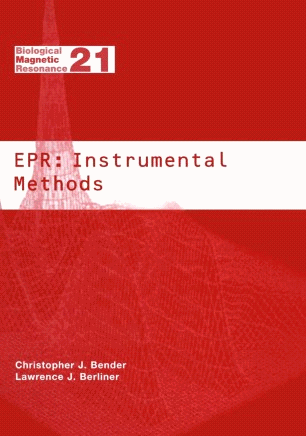
EPR: Instrumental Methods (2004)
L. Berliner, C. Bender (Eds.)
Springer
ISBN 978-1-4613-4733-0 437 Pages
Publisher Description:
Electron magnetic resonance spectroscopy is undergoing something akin to a renaissance that is attributable to advances in microwave circuitry and signal processing software. EPR: Instrumental Methods is a textbook that brings the reader up to date on these advances and their role in providing better experimental techniques for biological magnetic resonance. Chapters in this book guide the reader from basic principles of spectrometer design through the advanced methods that are providing new vistas in disciplines such as oximetry, imaging, and structural biology.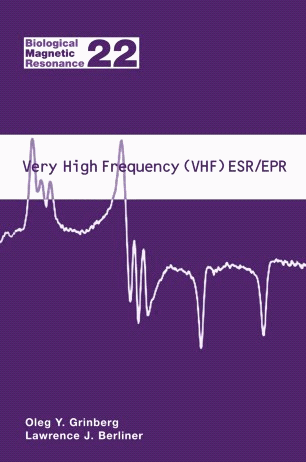
Very High Frequency (VHF) ESR/EPR (2004)
O.Y. Grinberg, L. Berliner (Eds.)
Springer
ISBN 9978-1-4419-3442-0 569 Pages
Publisher Description:
The field of Very High Frequency EPR (VHF EPR) or sometimes called Very High Field EPR (conveniently, also abbreviated as VHF EPR) has blossomed during the past decade, especially after the original pioneering work of Ya. S. Lebedev and his group at the Institute of Chemical Physics, Russian Academy of Sciences in Moscow. Although Lebedev suffered heavily under the economic constraints of the communist Soviet Union and then succumbed to cancer at the peak of his scientific career, his groundbreaking work from the 1970's is still considered today to be the 'gold standard' by researchers practicing EPR at high magnetic fields. A stimulus for the production of this book is the legacy of Yakov Levedev in his students now residing in academic positions in the US and elsewhere. The aim of this book is to highlight the state of this growing field. This is an attempt to cover the full scope of VHF EPR in a single volume. The idea for this volume came to the editors at the 2001 Rocky Mountain Analytical Conference during the 24th International EPR Symposium chaired by Sandra and Gareth Eaton. VHF EPR was presented as an independent research field at a workshop organized by LC BruneI and supported by the National High Magnetic Field Laboratory, a National Science Foundation funded facility at Florida State University.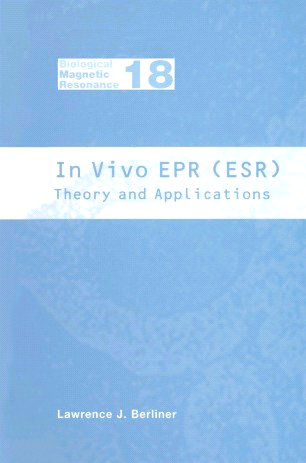
In Vivo EPR (ESR). Theory and Applications (2003)
L. Berliner (Ed.)
Springer
ISBN 978-1-4613-4906-8 656 Pages
Publisher Description:
In Vivo EPR (ESR) is a textbook on this relatively new subject in biomedical electron spin resonance. While a few chapters have appeared in special topics volumes in this series, this book covers the principles and theory, instrumentation as well as the latest applications at the time of its writing. The authors are world-renowned experts and pioneers in their fields. This book is divided into two major sections dealing with theory and instrumentation, and aspects of biochemistry, in vitro and in vivo applications. A significant amount of detail is devoted to clinical applications and the problems and pitfalls encountered in in vivo spectroscopy and imaging.
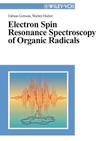 Electron Spin Resonance Spectroscopy of
Organic Radicals (2003)
Electron Spin Resonance Spectroscopy of
Organic Radicals (2003)
Gerson
Fabian, Huber Walter
Wiley-VCH
ISBN: 978-3527302758.
Publisher Description: Electron spin resonance spectroscopy is the method used to determine the structure and life expectancy of a number of radicals. Written by Fabian Gerson and Walter Huber, top experts in the field of electron spin resonance spectroscopy, this book offers a compact yet readily comprehensible introduction to the modern world of ESR. Thanks to its comprehensive coverage, ranging from fundamental theory right up to the treatment of all important classes of organic radicals and triplet-state molecules that can be analyzed using ESR spectroscopy, this unique book is suitable for users in both research and industry. Instead of using complex mathematical derivations, the authors present a readily understandable approach to the field by interpreting sample spectra and classifying experimental data.
Principles
of Pulse Electron Paramagnetic Resonance (2001)
Arthur Schweiger, Gunnar Jeschke
Oxford University Press
ISBN 9780198506348 608 Pages
Publisher Description: Pulse EPR (electron paramagnetic resonance) is one of the newest and most widely used techniques for examining the structure, function and dynamics of biological systems and synthetic materials. Until now, however, there has been no single text dedicated to this growing area of research. This text addresses the need for a comprehensive overview of Pulse EPR. The book covers the basic theory of pulse EPR, as well as a description and critical evaluation of the existing and emerging methods needed for selecting and conducting the proper experiment and analyzing the results. This is an indispensable reference for all scientists who need a thorough grounding in this increasingly popular field of spectroscopy.
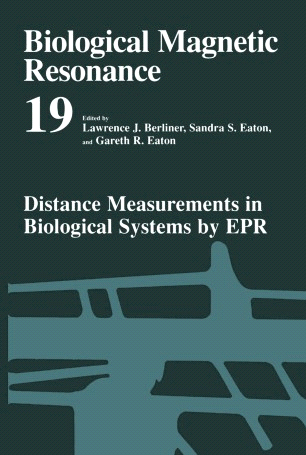
Distance Measurements in Biological Systems by EPR (2001)
L. Berliner
, G.R. Eaton, S.S. Eaton (Eds.)ISBN 978-1-4757-0575-1
Publisher Description: Distance measurements in biological systems by EPR The foundation for understanding function and dynamics of biological systems is knowledge of their structure. Many experimental methodologies are used for determination of structure, each with special utility. Volumes in this series on Biological Magnetic Resonance emphasize the methods that involve magnetic resonance. This volume seeks to provide a critical evaluation of EPR methods for determining the distances between two unpaired electrons. The editors invited the authors to make this a very practical book, with specific numerical examples of how experimental data is worked up to produce a distance estimate, and realistic assessments of uncertainties and of the range of applicability, along with examples of the power of the technique to answer biological problems. The first chapter is an overview, by two of the editors, of EPR methods to determine distances, with a focus on the range of applicability. The next chapter, also by the Batons, reviews what is known about electron spin relaxation times that are needed in estimating distances between spins or in selecting appropriate temperatures for particular experiments. Albert Beth and Eric Hustedt describe the information about spin-spin interaction that one can obtain by simulating CW EPR line shapes of nitroxyl radicals. The information in fluid solution CW EPR spectra of dual-spin labeled proteins is illustrated by Hassane Mchaourab and Eduardo Perozo.

Handbook of electron spin resonance:
Vol.2, (1999)
Poole C.P.Jr., Farach H.A
AIP (America Institute of Physics)
ISBN 0-387-98660-9 375 Pages
Publisher Description: In the first volume, Professors Poole and Farach provided one of the first definitive reference tools for this field. In this second volume, the authors present a comprehensive source for subfields of ESR not covered in the first volume, including: * Sensitivity * Field Swept versus Frequency Swept Spectra * Resonators * Line Shapes * Electron Spin Echo Envelope Modulation * Hamiltonian types and symmetries * ESR Imaging * High Magnetic Fields and High Frequencies. Written by recognized experts in the field, and intended for students and researchers, these handbooks bring together wide-ranging data from diverse disciplines within ESR, and then integrate it into a comprehesive and definitive resource. An invaluable reference for all those involved in ESR research.

Free Radicals: Biology and Detection by Spin Trapping (1999)
Rosen Gerald M. , Britigan Bradley E. , Halpern Howard J. Pou Sovitj
Oxford
ISBN 978-0195095050
Publisher Description: Free radicals, molecules with unpaired electrons, are highly reactive and play key roles in physiologic regulation and in many degenerative and pathologic processes, making them a fertile area of research. This book focuses on spin trapping, a sophisticated technique for the identification of free radicals in biological systems. The method is complex, and this book offers an in-depth guide to all of the critical aspects needed for its application to free radicals in biology. This includes advice on interpreting results, trouble-shooting, and experimental designs. The book looks at future directions in the field and will prove an invaluable resource for investigators working in the biology of free radicals, regardless of whether they are new or highly experienced in the applications of spin trapping.

Spin Labeling. The Next Millenium (in Biological Magnetic Resonance series, Vol.14, (1998)
Berliner Lawrence J.
(Ed)
Springer Verlag
ISBN 978-0306456442

Electron Spin Resonance: A Comprehensive Treatise on Experimental Techniques. 2nd Ed. (1997)
Poole
C.P.
Dover Publications
ISBN 0-486-69444-5
Publisher Description: Second edition of classic reference contains comprehensive coverage of experimental techniques, theoretical and practical aspects of ESR instrumentation. Recent developments, plus how to build, use ESR spectrometer. References. 1982 edition.
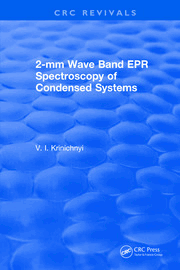
2-mm Wave Band EPR Spectroscopy of Condensed Systems (1995)
Victor I. Krinichnyi
CRC
ISBN 9781351069373 (Ebook)
236 pagesPublisher Description: This is the first book to summarize the problems of using modern high-resolution 2-mm wave band EPR spectroscopy in an interdisciplinary field for the investigation of various condensed systems. The material is well illustrated and the applications are as diverse as possible. The main subjects included are: unique characteristics of 2-mm EPR spectroscopy and appropriate experimental techniques, dynamics and polarity of radical microenvironment in model and biological systems, and the nature of charge carriers and charge transfer mechanisms in organic polymer semiconductors.

Handbook of electron spin resonance: data sources, computer technology, relaxation, and ENDOR (1994)
Poole C.P.Jr., Farach H.A.
AIP (America Institute of Physics)
ISBN 1-563-96044-3.

Electron Paramagnetic Resonance: Elementary Theory and Practical Applications (1994)
Weil J.A., Bolton J.R., Wertz J.E.
Wiley Interscience
ISBN 0-471-57234-9.
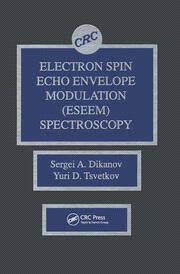
Electron Spin Echo Envelope Modulation (ESEEM) Spectroscopy (1992)
Sergei A. Dikanov, Yuri
Tsvetkov
CRC
ISBN 9780849342240 432 pages
Publisher Description:
The first volume devoted entirely to Electron Spin Echo Envelope Modulation (ESEEM) Spectroscopy This valuable book provides an introduction and broad survey of topics in ESEEM spectroscopy, including the theory, instrumentation, peculiarities of ESE experiments, and analysis of experimental data with particular emphasis on orientationally disordered systems. Applications of ESEEM spectroscopy to study chemically and biologically important paramagnetic centers in single crystals, amorphous solids, and powders are discussed as well. Electron Spin Echo Envelope Modulation (ESEEM) Spectroscopy will benefit specialists in magnetic resonance spectroscopy, physicists, chemists, and biologists who use magnetic resonance in their research.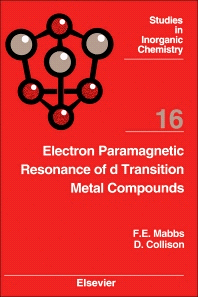
Electron Paramagnetic Resonance of d Transition Metal Compounds (1992)
F.E. Mabbs, D. Collison.
Elsevier
ISBN 9781483291499 (ebook)
Publisher Description: Electron paramagnetic resonance (epr) spectroscopy is a sensitive and versatile method of studying paramagnets, which is finding increasing use in chemistry, biochemistry, earth and materials sciences. The technique is treated both qualitatively and quantitatively, with a progressive increase in sophistication in each succeeding chapter. Following a general introductory chapter, the first half of the book deals with single unpaired electron systems and considers both metal and ligand Zeeman, hyperfine and quadrupole interactions. The simulation of these spectra is discussed, followed by the relationship between spin-Hamiltonian parameters and models of the electronic structures of paramagnets. The second half of the book treats multiple unpaired electron systems using the same philosophy. An introduction to the epr properties of cluster compounds and of extended exchanging systems is also given. There is a chapter on linewidths and lineshapes, and an extensive appendix containing much additional information. A wide-ranging library of simulated and experimental spectra is given, as well as graphical data which should aid spectrum interpretation. Each chapter contains key references and there is a substantial subject and keyword index. This book is designed to teach epr spectroscopy to students without any previous knowledge of the technique. However, it will also be extremely useful to researchers dealing with paramagnetic d transition metals..

Electron Spin Resonance: Elementary
Theory and Practical Applications (1986)
Wertz J.E.
Springer Verlag
ISBN 0-412-01161-1.
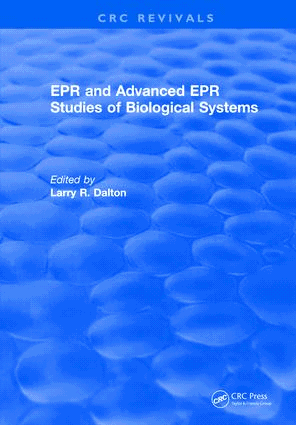
Larry.R. Dalton
CRC
ISBN 781351071871 (Ebook) 322 pages
Publisher Description: This work is written to provide a qualitative introduction, appropriate for a general science audience, to the application of pragmagnetic resonance to the determination of biomolecular dynamics. The work is also intended as a reference resource for those pursuing or contemplating research in the hydrodynamics. The work is also intended as a reference resource for those pursuing or contemplating research in the hydrodynamic characterization of components of Biosystems. Thus, the Introduction, Theory, and Methodology sections involve presentations at two levels � a pictorial and intuitive presentation for the generalist and a quantitative presentation for the specialist. The sections on applications provide a critical discussion of both pure and applied research applications which yields insights into both the capabilities and limitations of the methodology. The applications sections are also of interest from the standpoint of the detailed characterization of certain Biosystems, such as erythrocytes, which have evolved from EPR measurements.

Handbook of EPR Spectra from Quinones and Quinols (1985)
Pedersen Jens A
CRC
ISBN 9780849329555

Polymer Characterization by ESR and NMR (1980)
Woodward Arthur, Bovey Frank A.
ACS Symposium Series,
142
ISBN 978-0841205949

ESR Spectroscopy in Polymer Research
(1977)
Ranby Bengt, Rabek Jan F.,
Springer Verlag
ISBN 978-3540081517
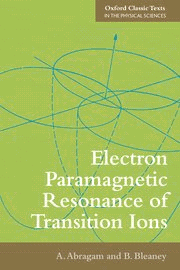
Electron Paramagnetic Resonance of Transition Ions (1970)(2012).
A. Abragam and B. Bleaney
Oxford
ISBN 0198512503
911 pagesPublisher Description: This book is a reissue of a classic Oxford text, and provides a comprehensive treatment of electron paramagnetic resonance of ions of the transition groups. The emphasis is on basic principles, with numerous references to publications containing further experimental results and more detailed developments of the theory. An introductory survey gives a general understanding, and a general survey presents such topics as the classical and quantum resonance equations, the spin-Hamiltonian, Endor, spin-spin and spin-lattice interactions, together with an outline of the known behaviour of ions of each of the five transition groups, at the experimentalist's level. Finally a theoretical survey, using group theory and symmetry properties, discusses the fundamentals of the theory
of paramagnetism.
Electron Spin Relaxation Phenomena in Solids (1969)
Standley K J
Springer
ISBN: 978-1-4899-6251-5 (Print) 978-1-4899-6539-4 (Online) 245 Pages

Electron Spin Resonance Spectrometers (1967)
Assenheimn H M
Springer
ISBN 978-1-4899-5504-3 (Print) 978-1-4899-5502-9 (Online) 280 Pages

Introduction to Electron Spin Resonance (1966)
Wilmshurst T H
Springer
ISBN 978-1-4899-5599-9 (Print) 978-1-4899-5597-5 (Online) 216 Pages

Electron Spin Resonance in Semiconductors (1966)
Lancaster, Gordon
Springer
ISBN 978-1-4684-1739-5 (Print) 978-1-4684-1737-1 (Online) 152 Pages
Publisher Description: Since the study of the solid state began it has been necessary to use increasingly refined experimental techniques, of which electron spin resonance is an important example, in the effort to gain information concerning the structure and properties of an immense and varied range of solids. In the last two decades the great commercial demand for solid-state electronic devices has stimulated research into the funda mental properties of semiconductors. At the same time as semiconductor devices were becoming techno logically important, the technique of electron spin resonance was first being used on a large scale, principally at the Clarendon Laboratory, Oxford. Both solid-state physics and electron spin resonance have now reached the stage where they are useful to each other, primarily in the realm of the atomic properties of matter. Dr Lancaster's book is one of a series of monographs that aims at covering as comprehensively as possible the field of electron spin resonance. His book has been written for those who wish to know some thing about the way in which the electron spin resonance technique has been used in the study of semiconductors. It also has value for specialists who may need an authoritative work of reference, and for workers in allied subjects who wish to use this technique to further their work. Much of his treatise deals with electron spin resonance in crystals of silicon and germanium containing specific impurities, as these materials are of greatest interest. Practical results are discussed wherever possible.

Free Radicals as Studied by Electron Spin Resonance (1958)
Ingram D.J.E.
Butterworths, London
274 pages
General Polymer Chemistry, Polymer Text Books, Polymer Characterization

Polymer Chemistry, 2nd Ed (2023)
Sebastian Koltzenburg, Michael Maskos, Oskar Nuyken
Springer
ISBN 9783662649299 581 pages
Publisher Description: This comprehensive textbook describes the synthesis, characterization and technical and engineering applications of polymers. Offering a broad and balanced introduction to the basic concepts of macromolecular chemistry and to the synthesis and physical chemistry of polymers, it is the ideal text for graduate students and advanced Masters students starting out in polymer science. Building on the basic principles of organic chemistry and thermodynamics, it provides an easily understandable and highly accessible introduction to the topic. Step by step, readers will obtain a detailed and well-founded understanding of this vibrant and increasingly important subject area at the intersection between chemistry, physics, engineering and the life sciences. Following a different approach than many other textbooks in the field, the authors, with their varying backgrounds (both from academia and industry), offer a new perspective. Starting with a clear and didactic introduction, the book discusses basic terms and sizes and shapes of polymers and macromolecules. There then follow chapters dedicated to polymers in solutions, molar mass determination, and polymers in the solid state, incl. (partially) crystalline or amorphous polymers as well as their application as engineering materials. Based on this information, the authors explain the most important polymerization methods and techniques. Often neglected in other textbooks, there are chapters on technical polymers, functional polymers, elastomers and liquid crystalline polymers, as well as polymers and the environment. An overview of current trends serves to generate further interest in present and future developments in the field. This book is the English translation of the successful German textbook "Polymere", which was awarded the Chemical Industry in Germany’s 2015 literature Prize (“Literaturpreis des Fonds der Chemischen Industrie”) for its innovative, novel approach, and its good accessibility and readability, while at the same time providing comprehensive coverage of the field of polymer science

Elsevier
ISBN 978-0-12-819768-4 651 pages
Publisher Description: Molecular Characterization of Polymers presents a range of advanced and cutting-edge methods for the characterization of polymers at the molecular level, guiding the reader through theory, fundamentals, instrumentation, and applications, and supporting the end goal of efficient material selection and improved material performance. Each chapter focuses on a specific technique or family of techniques, including the different areas of chromatography, field flow fractionation, long chain branching, static and dynamic light scattering, mass spectrometry, NMR, X-Ray and neutron scattering, polymer dilute solution viscometry, microscopy, and vibrational spectroscopy. In each case, in-depth coverage explains how to successfully implement and utilize the technique. This practical resource is highly valuable to researchers and advanced students in polymer science, materials science, and engineering, and to those from other disciplines and industries who are unfamiliar with polymer characterization techniques.
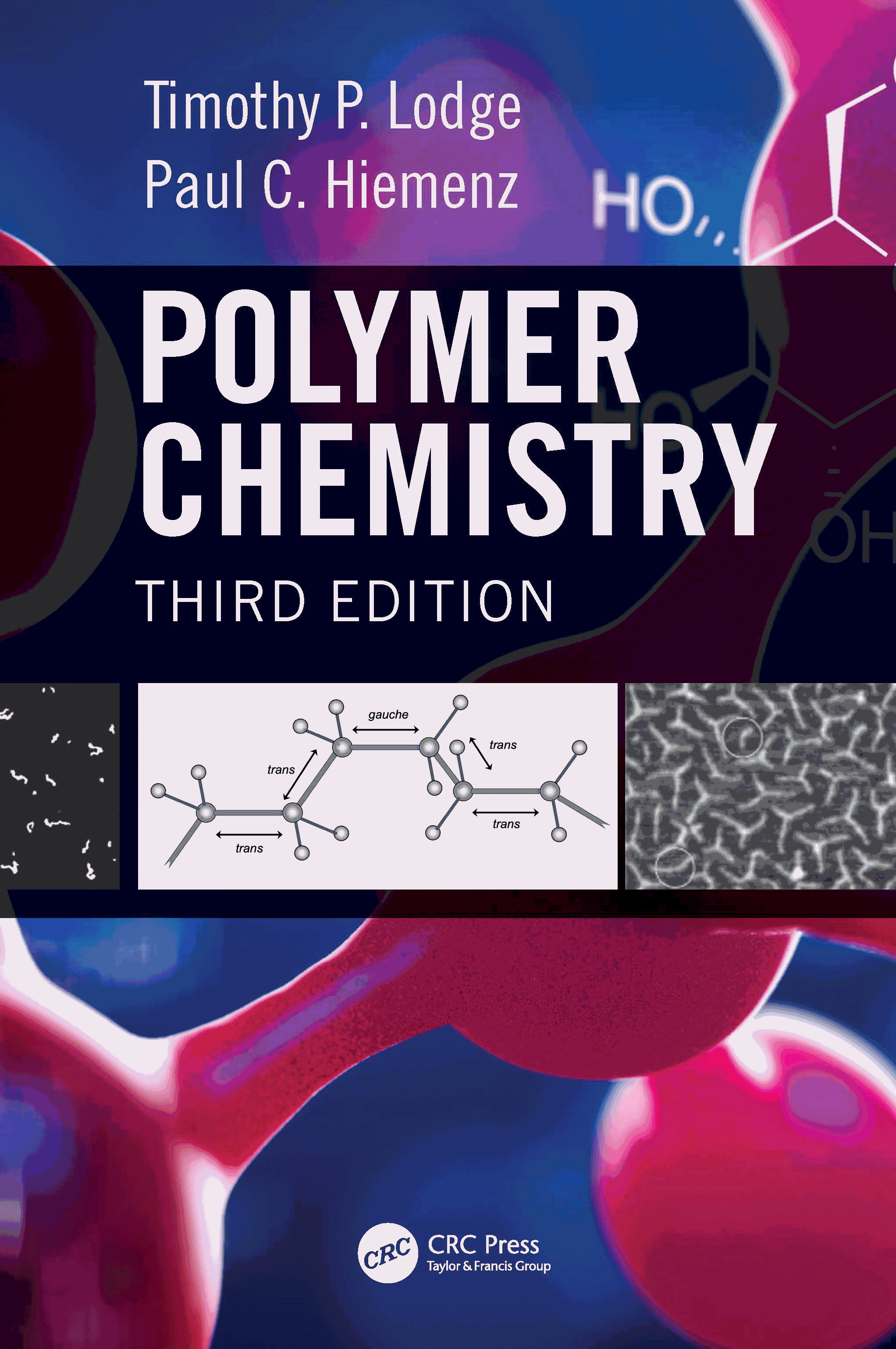
Polymer Chemistry. 3rd Ed. (2020)
Timothy P. Lodge, Paul C. Hiemenz
CRC Press
ISBN
9780429190810 (ebook) 676 pagesPublisher Description: A well-rounded and articulate examination of polymer properties at the molecular level, Polymer Chemistry focuses on fundamental principles based on underlying chemical structures, polymer synthesis, characterization, and properties. It emphasizes the logical progression of concepts and provide mathematical tools as needed as well as fully derived problems for advanced calculations. The much-anticipated Third Edition expands and reorganizes material to better develop polymer chemistry concepts and update the remaining chapters. New examples and problems are also featured throughout. This revised edition: Integrates concepts from physics, biology, materials science, chemical engineering, and statistics as needed. Contains mathematical tools and step-by-step derivations for example problems Incorporates new theories and experiments using the latest tools and instrumentation and topics that appear prominently in current polymer science journals. The number of homework problems has been greatly increased, to over 350 in all. The worked examples and figures have been augmented. More examples of relevant synthetic chemistry have been introduced into Chapter 2 ("Step-Growth Polymers"). More details about atom-transfer radical polymerization and reversible addition/fragmentation chain-transfer polymerization have been added to Chapter 4 ("Controlled Polymerization"). Chapter 7 (renamed "Thermodynamics of Polymer Mixtures") now features a separate section on thermodynamics of polymer blends. Chapter 8 (still called "Light Scattering by Polymer Solutions") has been supplemented with an extensive introduction to small-angle neutron scattering. Polymer Chemistry, Third Edition offers a logical presentation of topics that can be scaled to meet the needs of introductory as well as more advanced courses in chemistry, materials science, polymer science, and chemical engineering.
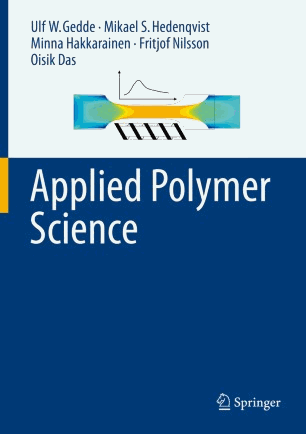
Applied Polymer Science (2021)
Springer
ISBN 978-3-030-68472-3 5
47 pagesPublisher Description: This companion volume to “Fundamental Polymer Science” (Gedde and Hedenqvist, 2019) offers detailed insights from leading practitioners into experimental methods, simulation and modelling, mechanical and transport properties, processing, and sustainability issues. Separate chapters are devoted to thermal analysis, microscopy, spectroscopy, scattering methods, and chromatography. Special problems and pitfalls related to the study of polymers are addressed. Careful editing for consistency and cross-referencing among the chapters, high-quality graphics, worked-out examples, and numerous references to the specialist literature make “Applied Polymer Science” an essential reference for advanced students and practicing chemists, physicists, and engineers who want to solve problems with the use of polymeric materials
.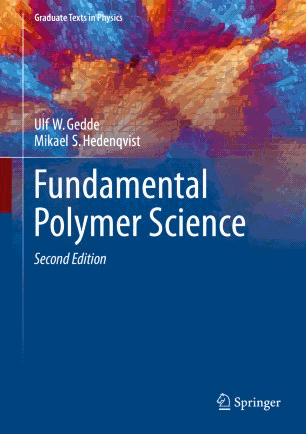
Fundamental Polymer Science. 2nd Ed. (2019)
Springer
ISBN 978-3-030-29792-3
501 pagesPublisher Description: This successor to the popular textbook, “Polymer Physics” (Springer, 1999), is the result of a quarter-century of teaching experience as well as critical comments from specialists in the various sub-fields, resulting in better explanations and more complete coverage of key topics. With a new chapter on polymer synthesis, the perspective has been broadened significantly to encompass all of polymer science. Polysaccharides and proteins are included in essentially all chapters, while polyelectrolytes are new to the second edition. Cheap computing power has greatly expanded the role of simulation and modeling in the past two decades, which is reflected in many of the chapters. A supplementary chapter on basic thermodynamics is based on a course that the senior author has taught for seven years. Additional problems and carefully prepared graphics aid in understanding. Two principles are key to the textbook’s appeal: 1) Students learn that, independent of the origin of the polymer, synthetic or native, the same general laws apply, and 2) students should benefit from the book without an extensive knowledge of mathematics. Taking the reader from the basics to an advanced level of understanding, the text meets the needs of a wide range of students in chemistry, physics, materials science, biotechnology, and civil engineering, and is suitable for both masters- and doctoral-level students.
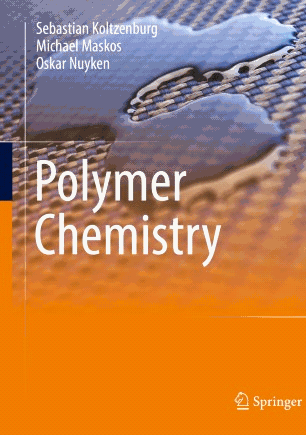
Sebastian Koltzenburg
, Michael Maskos, Oskar NuykenSpringer
ISBN 978-3-662-49279-6
581 pagesPublisher Description: This comprehensive textbook describes the synthesis, characterization and technical and engineering applications of polymers. Offering a broad and balanced introduction to the basic concepts of macromolecular chemistry and to the synthesis and physical chemistry of polymers, it is the ideal text for graduate students and advanced Masters students starting out in polymer science. Building on the basic principles of organic chemistry and thermodynamics, it provides an easily understandable and highly accessible introduction to the topic. Step by step, readers will obtain a detailed and well-founded understanding of this vibrant and increasingly important subject area at the intersection between chemistry, physics, engineering and the life sciences. Following a different approach than many other textbooks in the field, the authors, with their varying backgrounds (both from academia and industry), offer a new perspective. Starting with a clear and didactic introduction, the book discusses basic terms and sizes and shapes of polymers and macromolecules. There then follow chapters dedicated to polymers in solutions, molar mass determination, and polymers in the solid state, incl. (partially) crystalline or amorphous polymers as well as their application as engineering materials. Based on this information, the authors explain the most important polymerization methods and techniques. Often neglected in other textbooks, there are chapters on technical polymers, functional polymers, elastomers and liquid crystalline polymers, as well as polymers and the environment. An overview of current trends serves to generate further interest in present and future developments in the field. This book is the English translation of the successful German textbook "Polymere", which was awarded the Chemical Industry in Germany’s 2015 literature Prize (“Literaturpreis des Fonds der Chemischen Industrie”) for its innovative, novel approach, and its good accessibility and readability, while at the same time providing comprehensive coverage of the field of polymer science .
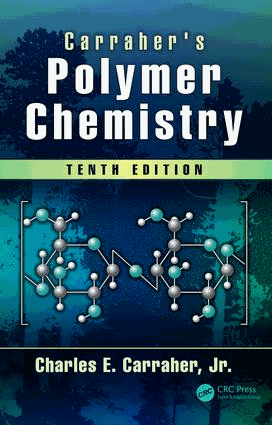
Carraher's Polymer Chemistry. 10th Ed. (2017)
CRC Press
ISBN 9781315116600 (ebook)
816 pagesPublisher Description: Carraher's Polymer Chemistry, Tenth Edition integrates the core areas of polymer science. Along with updating of each chapter, newly added content reflects the growing applications in Biochemistry, Biomaterials, and Sustainable Industries. Providing a user-friendly approach to the world of polymeric materials, the book allows students to integrate their chemical knowledge and establish a connection between fundamental and applied chemical information. It contains all of the elements of an introductory text with synthesis, property, application, and characterization. Special sections in each chapter contain definitions, learning objectives, questions, case studies and additional reading.
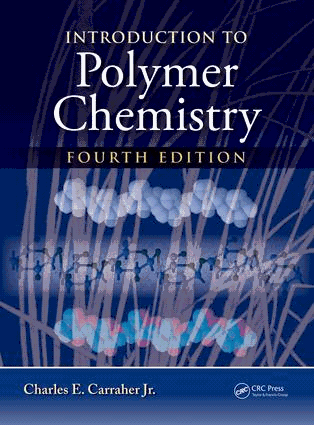
Introduction to Polymer Chemistry. 4th Ed. (2017)
CRC Press
ISBN 9781315369488 (ebook)
588 pagesPublisher Description: Introduction to Polymer Chemistry provides undergraduate students with a much-needed, well-rounded presentation of the principles and applications of natural, synthetic, inorganic, and organic polymers. With an emphasis on the environment and green chemistry and materials, this fourth edition continues to provide detailed coverage of natural and synthetic giant molecules, inorganic and organic polymers, elastomers, adhesives, coatings, fibers, plastics, blends, caulks, composites, and ceramics. Building on undergraduate work in foundational courses, the text fulfills the American Chemical Society Committee on Professional Training (ACS CPT) in-depth course requirement.

Characterization of Polymer Blends. (2015)
S. Thomas, Y. Grohens, P. Jyotishkumar
eds.Wiley
-VCH VerlagISBN 9783527331536
942 pagesPublisher Description: Filling the gap for a reference dedicated to the characterization of polymer blends and their micro and nano morphologies, this book provides comprehensive, systematic coverage in a one-stop, two-volume resource for all those working in the field. Leading researchers from industry and academia, as well as from government and private research institutions around the world summarize recent technical advances in chapters devoted to their individual contributions. In so doing, they examine a wide range of modern characterization techniques, from microscopy and spectroscopy to diffraction, thermal analysis, rheology, mechanical measurements and chromatography. These methods are compared with each other to assist in determining the best solution for both fundamental and applied problems, paying attention to the characterization of nanoscale miscibility and interfaces, both in blends involving copolymers and in immiscible blends. The thermodynamics, miscibility, phase separation, morphology and interfaces in polymer blends are also discussed in light of new insights involving the nanoscopic scale. Finally, the authors detail the processing-morphology-property relationships of polymer blends, as well as the influence of processing on the generation of micro and nano morphologies, and the dependence of these morphologies on the properties of blends. Hot topics such as compatibilization through nanoparticles, miscibility of new biopolymers and nanoscale investigations of interfaces in blends are also addressed. With its application-oriented approach, handpicked selection of topics and expert contributors, this is an outstanding survey for anyone involved in the field of polymer blends for advanced technologies.
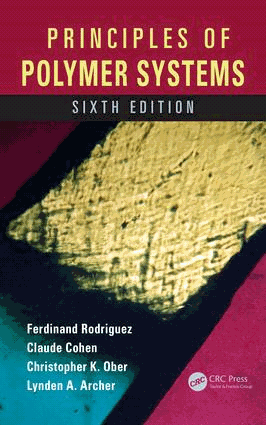
CRC Press
ISBN 9780429172298 (ebook)
810 pagesPublisher Description: Maintaining a balance between depth and breadth, the Sixth Edition of Principles of Polymer Systems continues to present an integrated approach to polymer science and engineering. A classic text in the field, the new edition offers a comprehensive exploration of polymers at a level geared toward upper-level undergraduates and beginning graduate students. Revisions to the sixth edition include: A more detailed discussion of crystallization kinetics, strain-induced crystallization, block copolymers, liquid crystal polymers, and gels New, powerful radical polymerization methods Additional polymerization process flow sheets and discussion of the polymerization of polystyrene and poly(vinyl chloride) New discussions on the elongational viscosity of polymers and coarse-grained bead-spring molecular and tube models Updated information on models and experimental results of rubber elasticity Expanded sections on fracture of glassy and semicrystalline polymers New sections on fracture of elastomers, diffusion in polymers, and membrane formation New coverage of polymers from renewable resources New section on X-ray methods and dielectric relaxation All chapters have been updated and out-of-date material removed. The text contains more theoretical background for some of the fundamental concepts pertaining to polymer structure and behavior, while also providing an up-to-date discussion of the latest developments in polymerization systems. Example problems in the text help students through step-by-step solutions and nearly 300 end-of-chapter problems, many new to this edition, reinforce the concepts presented.
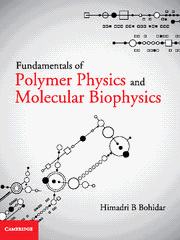
Fundamentals of Polymer Physics and Molecular Biophysics (2014)
Himadri B. Bohidar
Cambridge
ISBN 9781107415959
(online) 321 pagesPublisher Description: Macromolecules in solutions can be distinctly characterised by their transport behaviour in solution phase. The study of the transport processes includes diffusion coefficient, sedimentation coefficient, intrinsic viscosity and friction constant. The question arises as to how to explicitly characterise the macromolecules from the data of coefficients. This book answers this question in a systematic manner. It provides physical interpretation of the data obtained in macromolecular transport phenomena in a given system and also addresses some important issues and concepts related to biopolymers such as proteins and nucleic acids. The application of concepts like conformational properties and salient physicochemical features of protein and nucleic acids is also elucidated in the book. Based on the molecular structure, it provides the essential concepts which can be used to model and analyse the static and transport behaviour of polymers and biopolymers.

Polymer Physics. A Molecular Approach (2013)
Hu, Wenbing
Springer
ISBN 978-3-7091-0670-9 245 pages
Publisher Description: A molecular view on the fundamental issues in polymer physics is provided with an aim at students in chemistry, chemical engineering, condensed matter physics and material science courses. An updated translation by the author, a renowned Chinese chemist, it has been proven to be an effective source of learning for many years. Up-to-date developments are reflected throughout the work in this concise presentation of the topic. The author aims at presenting the subject in an efficient manner, which makes this particularly suitable for teaching polymer physics in settings where time is limited, without having to sacrifice the extensive scope that this topic demands.
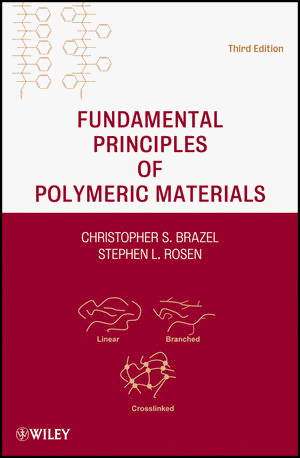
Fundamental Principles of Polymeric Materials. 3rd Ed. (2012)
Christopher S. Brazel, Stephen L. Roseng
Wiley
ISBN 978-0-470-50542-7 432 pages
Publisher Description: With its balanced presentation of polymer chemistry, physics, and engineering applications, the Third Edition of this classic text continues to instill readers with a solid understanding of the core concepts underlying polymeric materials. Both students and instructors have praised the text for its clear explanations and logical organization. It begins with molecular-level considerations and then progressively builds the reader's knowledge with discussions of bulk properties, mechanical behavior, and processing methods.

Polymer Science: A Comprehensive Reference (2012)
Editors-in-Chief: Krzysztof Matyjaszewski and Martin Möller
Elsevier
ISBN-13: 978-0444533494 10 Volume set 7760 pages
This Comprehensive Reference covers all aspects of polymer science from chemistry/chemical engineering to materials science, biological aspects, applications and fate of polymers in the environment.
Volume 1: Basic Concepts and Polymer Properties
Volume 2: Polymer Characterization
Volume 3: Chain Polymerization of Vinyl Monomers
Volume 4: Ring-Opening Polymerization and Special Polymerization Processes
Volume 5: Polycondensation
Volume 6: Macromolecular Architectures and Soft Nano-Objects
Volume 7: Nanostructured Polymer Materials and Thin Films
Volume 8: Polymers for Advanced Functional Materials
Volume 9: Polymers in Biology and Medicine
Volume 10: Polymers for a Sustainable Environment and Green Energy
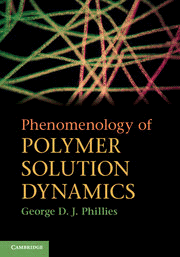
Phenomenology of Polymer Solution Dynamics (2011)
George D. J. Phillies
Cambridge
ISBN 9780511843181 (online)
527 pagesPublisher Description: Presenting a completely new approach to examining how polymers move in non-dilute solution, this book focuses on experimental facts, not theoretical speculations, and concentrates on polymer solutions, not dilute solutions or polymer melts. From centrifugation and solvent dynamics to viscosity and diffusion, experimental measurements and their quantitative representations are the core of the discussion. The book reveals several experiments never before recognized as revealing polymer solution properties. A novel approach to relaxation phenomena accurately describes viscoelasticity and dielectric relaxation and how they depend on polymer size and concentration. Ideal for graduate students and researchers interested in the properties of polymer solutions, the book covers real measurements on practical systems, including the very latest results. Every significant experimental method is presented in considerable detail, giving unprecedented coverage of polymers in solution.

Nonlinear Dynamics with Polymers: Fundamentals, Methods and Applications (2010)
John A. Pojman, Qui Tran‐Cong‐Miyatag (Eds.)
Wiley
ISBN 9783527325290 254 pages
Publisher Description: Closing a gap in the literature, this is the first comprehensive handbook on this modern and important polymer topic. Edited by highly experienced and top scientists in the field, this ready reference covers all aspects, including material science, biopolymers, gels, phase separating systems, frontal polymerization and much more.

Polymer Microscopy: Characterization and Evaluation of Materials. 3rd Ed. (2008)
Linda Sawyer, David T. Grubb, Gregory F. Meyers
Springer
ISBN-10: 0387726276 416 pages
Publisher Description: Polymer Microscopy, Third Edition, is a comprehensive and practical guide to the study of the microstructure of polymers, and is the result of the authors' many years of academic and industrial experience. To address the needs of students and professionals from a variety of backgrounds, introductory chapters deal with the basic concepts of both polymer morphology and processing and microscopy and imaging theory. The core of the book is more applied, with many examples of specimen preparation and image interpretation leading to materials characterization. Microscopy is applied to the characterization of a wide range of polymer systems, including fibers, films, engineering resins and plastics, composites, nanocomposites, polymer blends, emulsions and liquid crystalline polymers. Light microscopy, atomic force microscopy, and scanning and transmission electron microscopy techniques are all considered, as are emerging techniques such as compositional mapping in which microscopy is combined with spectroscopy. This extensively updated and revised Third Edition closes with a problem solving guide, which gives a systematic framework for deciding on suitable approaches to the characterization of polymer microstructure.

Organic and Physical Chemistry of Polymers (2007)
Gnanou, Fontanille
Wiley
ISBN 978-0-471-72543-5 632 Pages
Publisher Description: Organic and Physical Chemistry of Polymers provides a thorough introduction to the fundamentals of polymers, including their structure and synthesis as well as their chemical and physical properties. This accessible guide illuminates the increasingly important role of polymers in modern chemistry, beginning with the essentials, and: * Covers thermodynamics, conformation, morphology, and measurements of molar masses *Discusses polymerization mechanisms, reaction of polymers, synthesis of block and graft polymers, and complex topologies *Addresses the mechanical properties, rheology, polymer processing, and fabrication of fibers and films.

Modern Polymer Spectroscopy (2007)
Giuseppe Zerbi, Heinz W. Siesler, Isao Noda, Professor Mitsuo Tasumi, Samuel Krimm
Wiley-VCH
ISBN 3527296557 304 pages
Publisher Description: Modern Polymer Spectroscopy provides a 'guided tour' to the state of the art in polymer analysis by vibrational spectroscopy. Five renowned experts describe new experimental and theoretical techniques. Areas of focus include: - two-dimensional infrared spectroscopy - segmental mobility of liquid crystalline polymers under external fields - dynamics and structure of polymers with chemical and structural disorder - spectra of polyconjugated conducting polymers - theoretical calculations on biopolymers. Readers learn experimental techniques and theoretical tools essential for obtaining more valuable information from their vibrational spectra, in order too solve problems that would otherwise be impossible. An essential reference for all professionals who need to keep abreast at the latest developments in the field, graduate students in polymer science, material science and the biosciences using spectroscopic techniques will profit from the wealth of information provided in this state-of-the-art guide.

Principles of Polymerization. 4th Ed. (2004)
George Odian
Wiley
ISBN 978-0-471-27400-1 832 pages
Publisher Description:The new edition of a classic text and reference The large chains of molecules known as polymers are currently used in everything from "wash and wear" clothing to rubber tires to protective enamels and paints. Yet the practical applications of polymers are only increasing; innovations in polymer chemistry constantly bring both improved and entirely new uses for polymers onto the technological playing field. Principles of Polymerization, Fourth Edition presents the classic text on polymer synthesis, fully updated to reflect today's state of the art. New and expanded coverage in the Fourth Edition includes: * Metallocene and post-metallocene polymerization catalysts * Living polymerizations (radical, cationic, anionic) * Dendrimer, hyperbranched, brush, and other polymer architectures and assemblies * Graft and block copolymers * High-temperature polymers * Inorganic and organometallic polymers * Conducting polymers * Ring-opening polymer ization * In vivo and in vitro polymerization Appropriate for both novice and advanced students as well as professionals, this comprehensive yet accessible resource enables the reader to achieve an advanced, up-to-date understanding of polymer synthesis. Different methods of polymerization, reaction parameters for synthesis, molecular weight, branching and crosslinking, and the chemical and physical structure of polymers all receive ample coverage. A thorough discussion at the elementary level prefaces each topic, with a more advanced treatment following. Yet the language throughout remains straightforward and geared towards the student. Extensively updated, Principles of Polymerization, Fourth Edition provides an excellent textbook for today's students of polymer chemistry, chemical engineering, and materials science, as well as a current reference for the researcher or other practitioner working in these areas.

Physical Chemistry of Macromolecules: Basic Principles and Issues. 2nd Ed. (2004)
S. F. Sun
Wiley
ISBN 9780471281382 584 pages
Publisher Description: Integrating coverage of polymers and biological macromolecules into a single text, Physical Chemistry of Macromolecules is carefully structured to provide a clear and consistent resource for beginners and professionals alike. The basic knowledge of both biophysical and physical polymer chemistry is covered, along with important terms, basic structural properties and relationships.

Polymer Spectroscopy (1996) (2004, Knovel)
Fawcett, Allan H.
Wiley
ISBN 978-0-471-96029-4 410 pages
Publisher Description: This book will be invaluable to post graduate students of polymer science and researchers using any one of the many spectroscopic techniques.This book provides an overview of the current state-of-the-art through contributions by world-renowned experts. Techniques covered include: 1H and 13C NMR; NMR Imaging, Solid State NMR, Infra Red and Raman spectroscopy, ESR, light and neutron scattering.

Polymer Solutions: An Introduction to Physical Properties (2002)
Iwao Teraoka
Wiley
ISBN 9780471389293 360 pages
Publisher Description: Polymer Solutions: An Introduction to Physical Properties offers a fresh, inclusive approach to teaching the fundamentals of physical polymer science. Students, instructors, and professionals in polymer chemistry, analytical chemistry, organic chemistry, engineering, materials, and textiles will find Iwao Teraoka's text at once accessible and highly detailed in its treatment of the properties of polymers in the solution phase. Teraoka's purpose in writing Polymer Solutions is twofold: to familiarize the advanced undergraduate and beginning graduate student with basic concepts, theories, models, and experimental techniques for polymer solutions; and to provide a reference for researchers working in the area of polymer solutions as well as those in charge of chromatographic characterization of polymers. The author's incorporation of recent advances in the instrumentation of size-exclusion chromatography, the method by which polymers are analyzed, renders the text particularly topical.
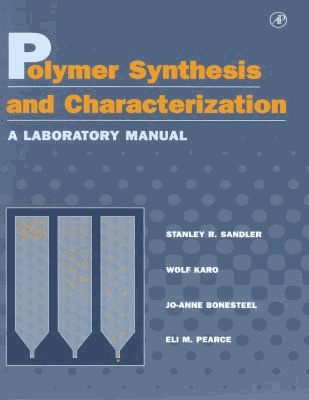
Polymer Synthesis and Characterization. A Laboratory Manual (1998)
(ebscohost.com link)Stanley R. Sandler, Wolf Karo, JoAnne Bonesteel, Eli M. Pearce
Academic Press
ISBN 9780080539218 232 pages
Publisher Description: This laboratory manual covers important techniques for polymer synthesis and characterization, and provides newcomers with a comprehensive introduction to the basic principles of highlighted techniques. The reader will benefit from the clear writing style and straightforward approach to fairly complex ideas. The book also provides references that the more advanced reader can use to obtain in-depth explanations of techniques. Polymer Synthesis and Characterization will serve as a useful resource for industrial technicians and researchers in polymer chemistry and physics, material science, and analytical chemistry.
Polymer Handbooks and Reference Books
![]()
(Ed)
ISBN
2954 pagesPublisher Description: Undoubtedly the applications of polymers are rapidly evolving. Technology is continually changing and quickly advancing as polymers are needed to solve a variety of day-to-day challenges leading to improvements in quality of life. The Encyclopedia of Polymer Applications presents state-of-the-art research and development on the applications of polymers. This groundbreaking work provides important overviews to help stimulate further advancements in all areas of polymers. This comprehensive multi-volume reference includes articles contributed from a diverse and global team of renowned researchers. It offers a broad-based perspective on a multitude of topics in a variety of applications, as well as detailed research information, figures, tables, illustrations, and references. The encyclopedia provides introductions, classifications, properties, selection, types, technologies, shelf-life, recycling, testing and applications for each of the entries where applicable. It features critical content for both novices and experts including, engineers, scientists (polymer scientists, materials scientists, biomedical engineers, macromolecular chemists), researchers, and students, as well as interested readers in academia, industry, and research institutions.
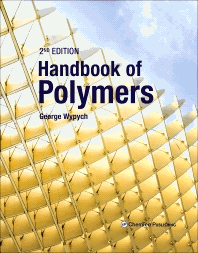
Handbook of Polymers 2nd Ed. (2016)
(Ed)
ISBN
712 pagesPublisher Description: Polymers selected for this edition of the book include all major polymeric materials used by the plastics and other branches of the chemical industry as well as specialty polymers used in the electronics, pharmaceutical, medical, and space fields. Extensive information is included on biopolymers. The data included in this book come from open literature (published articles, conference papers, and books), literature available from manufacturers of various grades of polymers, plastics, and finished products, and patent literature. The above sources were searched, including the most recent literature. It can be seen from the references that a large portion of the data comes from information published in 2011-2016. This underscores one of the major goals of this undertaking, which is to provide readers with the most up-to-date information.

Encyclopedic Dictionary of Polymers. 2nd Ed. (2011)
Jan W. Gooch (Editor)
Springer
ISBN 978-0-387-31021-3 (Print) 978-0-387-30160-0 (Online) 520 Pages
Publisher Description: This reference, in its second edition, contains more than 7,500 polymeric material terms, including the names of chemicals, processes, formulae, and analytical methods that are used frequently in the polymer and engineering fields. In view of the evolving partnership between physical and life sciences, this title includes an appendix of biochemical and microbiological terms (thus offering previously unpublished material, distinct from all competitors.) Each succinct entry offers a broadly accessible definition as well as cross-references to related terms. Where appropriate to enhance clarity further, the volume's definitions may also offer equations, chemical structures, and other figures. The new interactive software facilitates easy access to a large database of chemical structures (2D/3D-view), audio files for pronunciation, polymer science equations and many more.

Polymer Data Handbook 2nd Ed. (2009)
(Ed.)
ISBN 1264 pages
Publisher Description:This Second Edition includes better values of properties already reported, properties not reported in time for the earlier edition, and entirely new properties becoming important for modern polymer applications. It also contains 218 total polymers, 20 of which are all-new, particularly in high-technology areas such as; electrical conductivity, non-linear optical properties, microlithography, nanophotonics, and electroluminescences. Examples of specific polymers include; silsesquioxane ladder polymers, 'foldamer' self-assembling polymers, and block copolymers that phase separately into 'mushrooms', ellipsoids, and sheets with surfaces radically different in properties from the other.
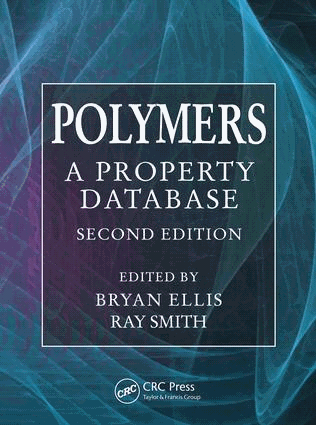
Polymers - A Property Database 2nd Ed. (2008)
Web Version of database (poly.chemnetbase.com)
ISBN
1052 pagesPublisher Description: Scientific and Commercial Information for More Than 1,000 Polymers. Polymers: A Property Database, Second Edition offers a central and reliable source for scientific and commercial information on more than 1,000 polymers. Revised and updated throughout, this edition features 25% new material, including 50 entirely new entries that reflect advances in areas such as conducting polymers, hydrogels, nano-polymers, and biomaterials. The second edition also comes with unlimited access to a complete, fully searchable Web version of the reference. Powerful retrieval software allows users to customize their searches and refine results. Each entry includes trade names, properties, manufacturing processes, commercial applications, supplier details, references, and links to constituent monomers.

Polymer Reference Book (2006) (2008, Knovel)
Crompton, T.R. (Ed.)
Smithers Rapra Technology
ISBN
978-1-85957-526-0 724 pagesPublisher Description:
This book should be of great interest to all those who are engaged in the examination of polymers in industry, university research establishments and general education. The book is intended for all staff who are concerned with instrumentation in the polymer laboratory, including laboratory designers, work planners, chemists, engineers, chemical engineers and those concerned with the implementation of specifications and process control.
Physical Properties of Polymers Handbook. 2nd Ed. (2006)
James E. Mark (Ed)
Springer
ISBN 0387312358 1095 pages
Publisher Description: This handbook offers concise information on the properties of polymeric materials, particularly those most relevant to the areas of physical chemistry and chemical physics. In the second edition of Physical Properties of Polymers Handbook, each chapter has been extensively updated and revised.. Each chapter has been extensively updated and revised. In addition, a dozen new chapters have been added, increasing the number of topics covered by approximately 25%. Half of these new chapters can be grouped into the general area of "Reinforcing Materials for Polymers." New chapters have increased the number of topics to cover Carbon black, Silica, Clays and other layered fillers, POSS cubic particles, Nanotubes, and Reinforcement theory. Other new chapters focus on Rotaxanes and related materials, Self-assembly materials, Foldamer supramolecular structures, Tribology, Mechanical properties of single molecules, and dendrimers. The study of complex materials is highly interdisciplinary, and new findings are published in a large selection of journals by a wide range of scientific and engineering societies. Physical Properties of Polymers Handbook brings together the work of experts from different disciplines who are contributing to the growing area of polymers and complex materials.

Polymer Handbook 4th Ed. (1999) (2005, Knovel)
Brandrup, J.; Immergut, Edmund H.; Grulke, Eric A.; Abe, Akihiro; Bloch, Daniel R.(Eds.)
Wiley
ISBN 0471166286 2336 pages
Publisher Description: The Polymer Handbook is the single most comprehensive source of physical property data for polymers commercially available, with experimentally determined and selected data of about 350 properties for over 2,500 polymers. It contains a vast array of data for polymers, monomers and other ancillary topics that are required for experimental and theoretical research and applications of polymers. This is a must have database for all technologists, scientists, researchers, and students concerned with theoretical or applied polymer science. Knovel has made the entire book available online as a PDF and have used the Wiley Database of Polymer Properties as a source of its Interactive Tables.
Soft Matter, Colloids, Surfactants, etc
 Surfactant Science and Technology. 4th Ed. (2020)
Surfactant Science and Technology. 4th Ed. (2020)
Wiley
ISBN 9781119465850 (Print) 400 pages
Publisher Description: A solid introduction to the field of surfactant science, this new edition provides updated information about surfactant uses, structures, and preparation, as well as seven new chapters expanding on technology applications. Offers a comprehensive introduction and reference of the science and technology of surface active materials Elaborates, more fully than prior editions, aspects of surfactant crystal structure as well as their effects on applications Adds more information on new classes and applications of natural surfactants in light of environmental consequences of surfactant use.
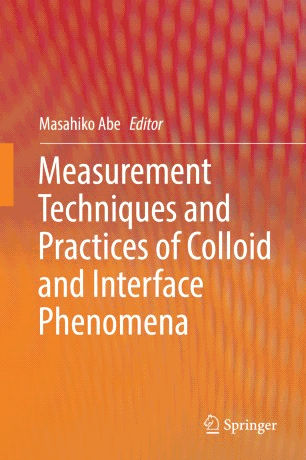
Measurement Techniques and Practices of Colloid and Interface Phenomena (2019)
Springer
ISBN 978-981-13-5930-9 (Print) 978-981-13-5931-6 (Online)
145 pagesPublisher Description: This book is a manual of measurement of colloids and interfaces designed especially for new researchers who have just begun research on these topics. The book is written by active researchers in the field of colloids and interfacial chemistry, based on the practical experience of the authors. In each chapter, the key points of measurement, how to analyze data correctly, points to be careful about, and merits of a particular method are concisely explained from the point of view of the readers. Not only in industries such as cosmetics and pharmaceuticals but also in academic studies of nanotechnology, correct understanding of colloid and interface phenomena is vital because the properties of these items, however small, are affected by the nature of interfaces. This book will be particularly useful for researchers who are not yet fully confident of the measurement techniques that are clearly explained here.
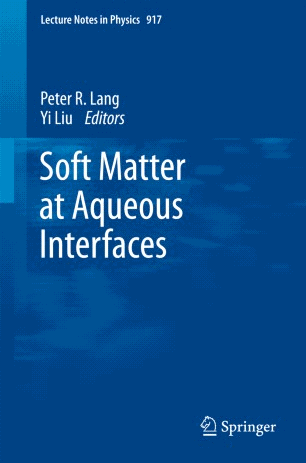
Springer
ISBN 978-3-319-24500-3 (Print) 978-3-319-24502-7 (Online) 555 pages
Publisher Description: This book covers the science of interfaces between an aqueous phase and a solid, another liquid or a gaseous phase, starting from the basic physical chemistry all the way to state-of-the-art research developments. Both experimental and theoretical methods are treated thanks to the contributions of a distinguished list of authors who are all active researchers in their respective fields. The properties of these interfaces are crucial for a wide variety of processes, products and biological systems and functions, such as the formulation of personal care and food products, paints and coatings, microfluidic and lab-on-a-chip applications, cell membranes, and lung surfactants. Accordingly, research and expertise on the subject are spread over a broad range of academic disciplines and industrial laboratories. This book brings together knowledge from these different places with the aim of fostering education, collaborations and research progress.
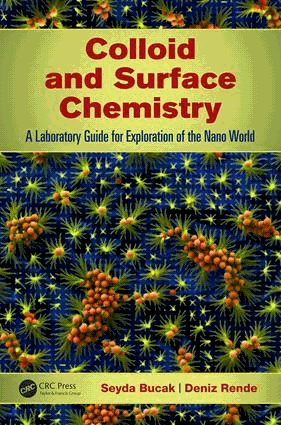
Colloid and Surface Chemistry. A Laboratory Guide for Exploration of the Nano World (2014)
CRC
ISBN (Print)
e) 278 pagesPublisher Description: With principles that are shaping today’s most advanced technologies, from nanomedicine to electronic nanorobots, colloid and interface science has become a truly interdisciplinary field, integrating chemistry, physics, and biology. Colloid and Surface Chemistry: Exploration of the Nano World- Laboratory Guide explains the basic principles of colloid and interface science through experiments that emphasize the fundamentals. It bridges the gap between the underlying theory and practical applications of colloid and surface chemistry. Separated into five chapters, the book begins by addressing research methodology, how to design successful experiments, and ethics in science. It also provides practical information on data collection and analysis, keeping a laboratory notebook, and writing laboratory reports. With each section written by a distinguished researcher, chapter 2 reviews common techniques for the characterization and analysis of colloidal structures, including surface tension measurements, viscosity and rheological measurements, electrokinetic methods, scattering and diffraction techniques, and microscopy. Chapters 3–5 provide 19 experiments, each including the purpose of the experiment, background information, pre-laboratory questions, step-by-step procedures, and post-laboratory questions. Chapter 3 contains experiments about colloids and surfaces, such as sedimentation, exploration of wetting phenomena, foam stability, and preparation of miniemulsions. Chapter 4 covers various techniques for the preparation of nanoparticles, including silver, magnetic, and silica nanoparticles. Chapter 5 demonstrates daily-life applications of colloid science, describing the preparation of food colloids, body wash, and body cream.

Encyclopedia of Colloid and Interface Science (2013)
Tharwat Tadros (Ed)
Springer
ISBN 3642206662 1436 pages
Publisher
Description: An authoritative and
comprehensive reference relevant to all scientists and engineers in the field.
This encyclopedia not only helps chemistry, materials science and physics
researchers to understand the principles, but also provides practicing engineers
with the necessary information for implementing practical applications, such as
Food and agrochemicals, Polymers and ceramics, Cosmetics and detergents, Paints
and coatings, Pharmaceuticals and drug delivery.
In addition, the encyclopedia is an important reference for industrial chemists
and chemical engineers faced with a multitude of industrial systems of a
colloidal nature.
As wide as the range of applications that colloid and interface science has is
the range of scientific disciplines that contribute to research and development
in this field. These encompass chemistry, physics, biology and mathematics as
well as nanoscience and nanotechnology. The encyclopedia provides easy-to-digest
information for meeting these interdisciplinary challenges.
While providing numerous concise definitions of key terms, the encyclopedia also
features more than forty in-depth essays on topics ranging from Agrochemical
Formulations to Zeta Potential. All entries are cross-referenced and include
selected references to original literature as well as synonyms.

Soft Matter: The Stuff That Dreams Are Made Of (2011)
Roberto Piazza
Springer
ISBN 978-94-007-0584-5 279 Pages
Publisher Description: This book takes you for a leisurely walk through the ‘middle earth’ that scientists call soft matter -- much smaller than what we observe with the naked eye, but not as remote as the esoteric realm of molecules, atoms and fundamental particles. From toys to trainers, our civilization would be very different if we did not have plastic. From milk to paint, what would we do without colloids? We ourselves fall into the category of soft matter, made as we are of a molecular origami of proteins, DNA and other biological compounds. This fascinating exploration reveals what these materials have in common and which aspects of their behavior make them useful in our everyday life. Understanding more about their physical properties will make you marvel at the ‘soft’ things that surround us.

Soft Matter Characterization (2008)
Borsali, Redouane; Pecora, Robert (Eds.)
Springer
ISBN 978-1-4020-4464-9 1455 pages
Publisher Description: This 2 volume reference work, split into 4 parts, presents detailed discussions of many of the major techniques commonly used as well as some of those in current development for studying and manipulating soft matter. The articles are intended to be accessible to the interdisciplinary audience (at the graduate student level and above) that is or will be engaged in soft matter studies or those in other disciplines who wish to view some of the research methods in this fascinating field.
Part 1 contains articles with a largely (but, in most cases, not exclusively) theoretical content and/or that cover material relevant to more than one of the techniques covered in subsequent volumes. It includes an introductory chapter on some of the time and space-time correlation functions that are extensively employed in other articles in the series, a comprehensive treatment of integrated intensity (static) light scattering from macromolecular solutions, as well as articles on small angle scattering from micelles and scattering from brush copolymers. A chapter on block copolymers reviews the theory (random phase approximation) of these systems, and surveys experiments on them (including static and dynamic light scattering, small-angle x-ray and neutron scattering as well as neutron spin echo (NSE) experiments). This chapter describes block copolymer behavior in the "disordered phase" and also their self-organization. The volume concludes with a review of the theory and computer simulations of polyelectrolyte solutions.
Part 2 contains material on dynamic light scattering, light scattering in shear fields and the related techniques of fluorescence recovery after photo bleaching (also called fluorescence photo bleaching recovery to avoid the unappealing acronym of the usual name), fluorescence fluctuation spectroscopy, and forced Rayleigh scattering. Volume 11 concludes with an extensive treatment of light scattering from dispersions of polysaccharides.
Part 3 presents articles devoted to the use of x-rays and neutrons to study soft matter systems. It contains survey articles on both neutron and x-ray methods and more detailed articles on the study of specific systems- gels, melts, surfaces, polyelectrolytes, proteins, nucleic acids, block copolymers. It includes an article on the emerging x-ray photon correlation technique, the x-ray analogue to dynamic light scattering (photon correlation spectroscopy).
Part 4 describes direct imaging techniques and methods for manipulating soft matter systems. It includes discussions of electron microscopy techniques, atomic force microscopy, single molecule microscopy, optical tweezers (with applications to the study of DNA, myosin motors, etc.), visualizing molecules at interfaces, advances in high contrast optical microscopy (with applications to imaging giant vesicles and motile cells), and methods for synthesizing and atomic force microscopy imaging of novel highly branched polymers..
Soft matter research is, like most modern scientific work, an international endeavor. This is reflected by the contributions to these volumes by leaders in the field from laboratories in nine different counties. An important contribution to the international flavor of the field comes, in particular, from x-ray and neutron experiments that commonly involve the use of a few large facilities that are multinational in their staff and user base

Environmental Colloids and Particles: Behaviour, Separation and Characterisation, Vol. 10 (2007)
Kevin J. Wilkinson, Jamie R. Lead (Eds.)
Wiley
ISBN 9780470024324(print) 9780470024539 (Online) 702 Pages
Publisher Description: This text presents the current knowledge of environmental colloids and includes reviews of the current understanding of structure, role and behaviour of environmental colloids and particles, whilst focussing directly on aquatic systems and soils. In addition, there is substantial critical assessment of the techniques employed for the sampling, size fractionation and characterisation of colloids and particles. Chemical, physical and biological processes and interactions involving colloids are described, and particular attention is paid to quantitative approaches that take account of particle heterogeneity and polydispersity.

Introduction to Soft Matter: Synthetic and Biological Self-Assembling Materials (2007)
Ian W. Hamley
Wiley
Online ISBN: 9780470517338 DOI: 10.1002/9780470517338 342 Pages
Publisher Description: This book provides an introduction to this exciting and relatively new subject with chapters covering natural and synthetic polymers, colloids, surfactants and liquid crystals highlighting the many and varied applications of these materials. Written by an expert in the field, this book will be an essential reference for people working in both industry and academia and will aid in understanding of this increasingly popular topic.

Surfactants and Polymers in Aqueous Solution. 2nd Ed. (2003)
Krister Holmberg, Bo Jönsson, Bengt Kronberg, Björn Lindman
Wiley
ISBN: 9780471498834 562 pages
Publisher Description: Many industrial formulations such as detergents, paints, foodstuff and cosmetics contain both surfactants and polymers and their interaction govern many of the properties. This book is unique in that it discusses the solution chemistry of both surfactants and polymers and also the interactions between the two. The book, which is based on successful courses given by the authors since 1992, is a revised and extended version of the first edition that became a market success with six reprints since 1998. Surfactants and Polymers in Aqueous Solution is broad in scope, providing both theoretical insights and practical help for those active in the area. This book contains a thorough discussion of surfactant types and gives information of main routes of preparation. A chapter on novel surfactants has been included in the new edition. Physicochemical phenomena such as self-assembly in solution, adsorption, gel formation and foaming are discussed in detail. Particular attention is paid to the solution behaviour of surfactants and polymers containing polyoxyethylene chains. Surface active polymers are presented and their interaction with surfactants is a core topic of the book. Protein-surfactant interaction is also important and a new chapter deals with this issue. Microemulsions are treated in depth and several important application such as detergency and their use as media for chemical reactions are presented. Emulsions and the choice of emulsifier is discussed in some detail. The new edition also contains chapters on rheology and wetting. Surfactants and Polymers in Aqueous Solution is aimed at those dealing with surface chemistry research at universities and with surfactant formulation in industry.
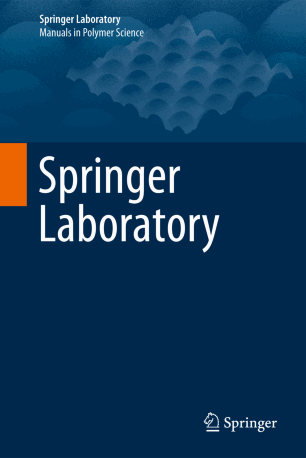
Publisher Description: The Springer Laboratory Manuals on Polymer Science are a series of books that aim at presenting the state-of–the-art of different methods of polymer analysis and characterization. In contrast to typical monographs describing fundamental approaches to analytical methods, the principal items of the laboratory manuals are detailed work procedures. Accompanied by a short introductory chapter on the theoretical background, the different volumes are divided into chapters on experimental procedures, equipment, tips and tricks, trouble shooting, and applications. Extensive use is made of sketches, schemes, flow diagrams, tables, and charts. The volumes of the series will familiarize polymer chemists, polymer physicists, and materials scientists as well as students of macromolecular and analytical sciences with methods of polymer analysis from an experimental perspective. They will enable experimentalists to plan, optimize and carry out their own experiments on polymer analysis and characterization.

Thermal Field-Flow Fractionation of Polymers (2019)
Guilaume Greyling
, Harald PaschgSpringer
ISBN 978-3-642-36079-4 (Print) 978-3-642-36080-0 (Online).
Publisher Description: This book introduces the reader to thermal field-flow fractionation and discusses its advantages over the fundamental problems associated with traditional column-based analytical techniques commonly used to characterize polymers and macromolecules. The authors discuss the theoretical background, equipment, experimental procedures as well as the recent advances and applications of thermal field-flow fractionation. Complete with several practical examples and troubleshooting guidelines, the book is written for beginners and experienced separation scientists alike and will enable its readers to optimize their experimental conditions for their specific separation needs and problems.
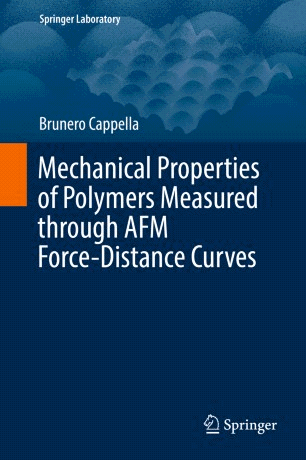
Mechanical Properties of Polymers Measured through AFM Force-Distance Curves (2016)
Brunero Cappella
Springer Laboratory
ISBN
978-3-319-29457-5 (Print) 978-3-319-29459-9 (Online).Publisher Description: This Springer Laboratory volume is a practical guide for scientists and students dealing with the measurement of mechanical properties of polymers at the nanoscale through AFM force-distance curves. In the first part of the book the reader will find a theoretical introduction about atomic force microscopy, focused on force-distance curves, and mechanical properties of polymers. The discussion of several practical issues concerning the acquisition and the interpretation of force-distance curves will help scientists starting to employ this technique. The second part of the book deals with the practical measurement of mechanical properties of polymers by means of AFM force-distance curves. Several "hands-on" examples are illustrated in a very detailed manner, with particular attention to the sample preparation, data analysis, and typical artefacts. This section gives a complete overview about the qualitative characterization and quantitative determination of the mechanical properties of homogeneous polymer samples, polymer brushes, polymer thin films, confined polymer samples, model blends and microstructured polymer blends through AFM force-distance curves. The book also introduces to new approaches and measurement techniques, like creep compliance and force modulation measurements, pointing out approximations, limitations and issues requiring further confirmation.

Advanced Separation Techniques for Polyolefins (2014)
Harald Pasch, Muhammad Imran Malik
Springer Laboratory
ISBN
9978-3-319-08631-6 (Print) 978-3-319-08632-3 (Online).Publisher Description: This Springer Laboratory volume introduces the reader to advanced techniques for the separation and fractionation of polyolefins. It includes detailed information on experimental protocols and procedures, addressing the experimental background of different polyolefin fractionation techniques in great detail. The book summarizes important applications in all major fractionation methods with emphasis on multidimensional analytical approaches. It comprises the most powerful modern techniques, such as high temperature size exclusion chromatography (HT-SEC) for molar mass analysis, temperature rising elution fractionation (TREF) and crystallization analysis fractionation (CRYSTAF) for the analysis of chemical composition and branching, high temperature two-dimensional liquid chromatography (HT-2D-LC), solvent and temperature gradient interaction chromatography (SGIC and TGIC) and crystallization elution fractionation (CEF).

Multidimensional HPLC of Polymers (2013)
Harald Pasch, Bernd Trathnigg
Springer Laboratory
ISBN 978-3-642-36079-4 (Print) 978-3-642-36080-0 (Online).
Publisher Description: This book presents the principle ideas of combining different analytical techniques in multi-dimensional analysis schemes. It reviews the basic principles and instrumentation of multi-dimensional chromatography and the hyphenation of liquid chromatography with selective spectroscopic detectors and presents experimental protocols for the analysis of complex polymers. It is the consequent continuation of "HPLC of Polymers" from 1999 by the same authors. Like its 'predecessor', this book discusses the theoretical background, equipment, experimental procedures and applications for each separation technique, but in contrast treats multi-dimensional and coupled techniques. "Multidimensional HPLC of Polymers" intends to review the state of the art in polymer chromatography and to summarize the developments in the field during the last 15 years. With its tutorial and laboratory manual style it is written for beginners as well as for experienced chromatographers, and will enable its readers (polymer chemists, physicists and material scientists, as well as students of polymer and analytical sciences) to optimize the experimental conditions for their specific separation problems.

Scanning Force Microscopy of Polymers (2010)
Vancso, G. Julius, Schönherr, Holger
Springer
ISBN 3642012302 248 pages
Publisher Description: This lab manual introduces the reader to scanning force microscopy of polymers based on a practice-oriented approach. It begins with a broad introduction to the necessary background of SFM, including intermolecular forces and various SFM imaging modes. "Scanning Force Microscopy of Polymers" is developed in a didactically clear and easily understandable style. The application of SFM to visualize and study polymers is exemplified by numerous case studies, including experimental protocols. In addition, the book helps the reader to develop a conscious and critical understanding of SFM data. This approach enables the reader to acquire the knowledge and experimental skills that are necessary to understand and obtain good and reliable SFM results within the shortest time possible.

Electron Microscopy of Polymers (2008)
Michler, Goerg H.
Springer
ISBN 3540363505 474 pages
Publisher Description: There are many books on electron microscopy, however, the study of polymers using EM necessitates special techniques, precautions and preparation methods, including ultramicrotomy. This book discusses the general characteristics of the various techniques of EM, including scanning force microscopy (AFM). The application of these techniques to the study of morphology and properties, particularly micromechanical properties, is described in detail. Examples from all classes of polymers are presented.

Synthetic Polymeric Membranes: Characterization by Atomic Force Microscopy (2008)
Khulbe, K. C., Feng, C. Y., Matsuura, Takeshi
Springer
ISBN 978-3-540-73993-7 190 pages
Publisher Description: This is a much-needed text that focuses on the method recently developed to study the surfaces of synthetic polymeric membranes using an Atomic Force Microscope (AFM).
AFM is becoming a very important tool for the characterization of synthetic polymeric membranes, as The development of membranes for improved performance depends on the exact knowledge of the morphology of a thin selective layer that exists at the surface of the membrane.
The control of the morphology of the selective layer is crucial for the design of synthetic polymeric membranes. With a relatively short history of twenty-five years, AFM has firmly established its position as a means of characterizing the membrane surface.
Here, each chapter includes information on the basic principles, commercial applications, an overview of current research and guidelines for future research. Each also includes a summary and comprehensive list of references.
The book covers all aspects of AFM studies on the characterization of synthetic polymeric membranes.
This work will be of wide interest, as synthetic membranes are now considered to be one of the most important tools in areas as crucial as seawater desalination, waste-water treatment, and water production.

Light Scattering from Polymer Solutions and Nanoparticle Dispersions (2007)
Schärtl, Wolfgang
Springer
ISBN 978-3-540-71950-2 191 pages
Publisher Description: Light scattering is a very powerful method for characterizing the structure of polymers and nanoparticles in solution. Recent technical developments have broadened the possible practical applications of this technique, overcoming earlier limitations such as sample turbidity and insufficient experimental time scales. Until this volume, despite their importance, these new developments have not yet been presented in a comprehensive form. In addition, and perhaps more significantly to the broad audience, this book provides a much-needed accessible introduction for students and non-experts interested in the basic principles and fundamental techniques of light scattering. As part of the Springer Laboratory series, this book provides a simple-to-read and illustrative textbook probing the seemingly very complicated topic of light scattering from polymers and nanoparticles in dilute solution, and goes further to cover some of the latest technical developments in experimental light scattering.

Polyelectrolytes and Nanoparticles (2007)
Koetz, Joachim, Kosmella, Sabine
Springer
ISBN 978-3-540-46381-8 105 pages
Publisher Description: This lab manual guides chemists through demonstrations of synergistic effects between polyelectrolytes and nanoparticles. After a short introduction into the field of polyelectrolytes and polyelectrolyte characterization, the role of polyelectrolytes in the process of nanoparticle formation is discussed in more detail. However, polyelectrolytes can directly influence the growing of nanoparticles and also can stabilize the nanoparticles formed. Therefore, the nanoparticle formation in polyelectrolyte-modified template phases, e.g. microemulsions, is of growing interest. Finally, methods for characterization of the polyelectrolyte-modified nanoparticles are explained. The adsorption of polyelectrolytes can be detected by measuring the zeta potential at the nanoparticle surface by means of electrophoretic light scattering, acoustophoresis or streaming potential measurements. It is also shown that the particle size and particle size distribution can be determined by using dynamic light scattering in combination with electron microscopy. Moreover, all methods and preparation techniques are discussed in sufficient detail to give readers deeper insight into the methodical background.

X-Ray Scattering of Soft Matter (2007)
Stribeck, Norbert
Springer
SBN 978-3-540-69855-5 238 pages
Publisher Description: This coherently written volume summarizes the analytical power of modern X-ray scattering in the field of soft matter.
Applications of X-ray scattering to soft matter have advanced considerably within recent years, both conceptually and technically. There are now mature high-power X-ray sources, synchrotrons and rotating anodes, as well as high-speed detectors, which have become readily available and which make the whole process more viable.
High-quality time-resolved experiments on polymer structure can now be performed with ease, a major advancement due to the genuine power of the scattering method.
This manual is a detailed description of simple tools that can elucidate the mechanisms of structure evolution in the studied materials. It is also a step-by-step guide to more advanced methods of the latest X-ray scattering techniques, and breaks down these methods.
Data analysis based on clear, unequivocal results is rendered simple and straightforward – with a stress on the careful planning of experiments and adequate recording of all required data.
This book, then, serves as a useful ready-reference guide. It has been written for the modern scientist who is a generalist and needs a concise reference, and demonstrates typical errors in data evaluation.

Analytical Ultracentrifugation of Polymers and Nanoparticles (2006)
Maechtle, Walter, Börger, Lars
Springer
ISBN 3540234322 237 pages
Publisher Description: Analytical ultracentrifugation (AUC) is a powerful method for the characterization of polymers, biopolymers, polyelectrolytes, nanoparticles, dispersions, and other colloidal systems. The method is able to determine the molar mass, the particle size, the particle density and interaction parameters like virial coefficients and association constants. Because AUC is also a fractionation method, the determination of the molar mass distribution, the particle size distribution, and the particle density distribution is possible. A special technique, the density gradient method, allows fractionating heterogeneous samples according to their chemical nature that means being able to detect chemical heterogeneity. The book is divided into chapters concerning instrumentation, sedimentation velocity runs, density gradient runs, application examples and future developments. In particular, the detailed application chapter demonstrates the versatility and power of AUC by means of many interesting and important industrial examples. Thus the book concentrates on practical aspects rather than details of centrifugation theory.

Esterification of Polysaccharides (2006)
Heinze, Thomas, Liebert, Tim, Koschella, Andreas
Springer
ISBN 978-3-540-32103-3
Publisher
Description: Polysaccharide
esters (e.g. cellulose and starch) are among the first polymeric materials
applied commercially. The way of producing these technically relevant
derivatives, mainly the carboxylic acid esters of C2 to C4
acids, have not been changed significantly during their history of manufacture.
The investigation of new acylation methods and strategies of analysis was
revived during the last decade by the search for tailored, biocompatible
material for specific fields of application, e.g., biotechnology, sensor
technique and medicine. Unconventional solvents were developed for completely
homogeneous acylation reaction applying state of the art techniques of modern
organic chemistry for polysaccharide modification. This book will provide a
first comprehensive summary of acylation methods in a very practical manner.
Detailed structure analysis is indispensable for the evaluation of
structure-property-relationships. Spectroscopic methods in particular FTIR- and
NMR spectroscopy including two dimensional methods are of increasing importance.
A variety of FTIR-, 1H NMR- and 13C NMR spectra are
collected on the supplemented CD-ROM.

Rheology Essentials of Cosmetic and Food Emulsions (2006)
Brummer, Rüdiger
Springer
ISBN 978-3-540-25553-6 180 pages
Publisher Description: Cosmetic emulsions exist today in many forms for a wide variety of applications, including face and hand creams for normal, dry or oily skin, body milks and lotions, as well as sun-block products. Keeping track of them and their properties is not always easy despite informative product names or partial names (e.g. hand or face cream) that clearly indicate their use and properties. This practical manual provides a detailed overview that describes the key properties and explains how to measure them using modern techniques. Written by an expert in flows and flow properties, it focuses on the application of rheological (flow) measurements to cosmetic and food emulsions and the correlation of these results with findings from other tests.
Beginning with a brief history of rheology and some fundamental principles, the manual describes in detail the use of modern viscometers and rheometers, including concise explanations of the different available instruments. But the focus remains on practical everyday lab procedures: how to characterize cosmetic and food emulsions with different rheological tests such as temperature, time, stress and strain, both static and dynamic. Also the critical topic of how the results correlate with other important product characteristics, for instance, skin sensation, pumping performance, stability etc. is carefully explored. Many pictures, illustrations, graphs and tables help readers new to the measurement of cosmetic emulsions in their daily work as well as to the more experienced who seek additional special tips and tricks.

Viscosimetry of Polymers and Polyelectrolytes (2004)
Kulicke, Werner-Michael, Clasen, Christian
Springer
ISBN 978-3-540-40760-7 120 pages
Publisher Description: Viscometry is an easy, accessible, but at the same time significant, analytical method for the characterization of polymers in solution. Widely used in pharmaceutical, medical and polymer processing industries as well as in research, viscometry allows for a quick and inexpensive determination of relevant parameters such as solution structure, viscosity and molar mass. This laboratory handbook offers clear guidelines and tips for the practical everyday application of viscosimetry, as well as supplying a comprehensive companion for the interpretation of viscosimetric data from simple to complex polymer solutions. It is written with the premise that general knowledge of the broad behavioral spectrum of polymer solutions is of utmost importance for the correct handling of viscometric equipment and the interpretation of data. Originating from the author’s experience supervising analytical polymer chemistry lab courses, it shows readers how to tackle key practical problems through detailed examples.

NMR Spectroscopy of Polymers (2004)
Kitayama, Tatsuki, Hatada, Koichi
Springer
ISBN 978-3-540-40220-6 222 pages
Publisher Description: NMR Spectroscopy of Polymers places emphasis on the practical use of NMR spectroscopy in polymer chemistry rather than the theoretical treatments. Based on the authors' extensive experimental experience, topics covered include (1) experimental problems such as preparation of sample solution, selection of solvent, internal standard and tube, and contaminants in sample solution, (2) accuracy and precision of NMR measurements required in the analysis of polymer structure such as tacticity, copolymer composition and chain end structures, (3) volume magnetic susceptibility by NMR, (4) stereochemistry of polymer chains, chemical composition and comonomer sequence distribution in copolymers, and end groups and irregular linkages, (5) on-line coupled size exclusion chromatography(SEC) and NMR spectroscopy(SEC/NMR) in which an NMR spectrometer is set in the SEC system as a detector.

MALDI-TOF Mass Spectrometry of Synthetic Polymers (2003)
Pasch, Harald, Schrepp, Wolfgang
Springer
ISBN 978-3-540-44259-2 299 pages
Publisher Description: MALDI-TOF mass spectrometry is one of the latest and most fascinating new developments in the analysis of organic compounds. Originally developed for the analysis of biomolecules, it has developed into one of the most powerful techniques for the characterization of synthetic polymers. This book describes the fundamentals of the MALDI process and the technical features of MALDI-TOF instrumentation. It reviews the application of MALDI-TOF for identification, chemical and molar mass analysis of synthetic polymers.
Experimental protocols for the determination of endgroups, the analysis of homo- and copolymers, and the coupling of liquid chromatography and MALDI-TOF are discussed in detail.

Size Exclusion Chromatography (1999)
Prof. Sadao Mori, Dr. Howard G. Barth
Springer Laboratory
ISBN 978-3-642-08493-5 (Print) 978-3-662-03910-6 (Online)
Publisher Description: Although size exclusion chromatography (SEC) is perhaps the most popular and widely used technique for determining the molecular weight distribution of polymeric materials, there have been very few texts written on this topic. During the past decade, SEC has experienced a considerable amount of growth in regard to column and detector technology and new applications. With these advances, SEC can now be used for determining absolute molecular weight, polymer chain conformation and size, and branching, as well as polymer solution properties. This book introduces the reader to the fundamentals of SEC with emphasis on practical aspects of the technique, such as column and mobile selection, calibration, new detector capabilities and guidelines for performing SEC on most types of polymers, especially those of industrial importance. This book is intended for either those new to the field of SEC, or for those research workers who require a more comprehensive background.

Pasch, Harald, Trathnigg, Bernd
Springer
ISBN 978-3-642-58265-3 224 pages
Publisher Description: Polymers are mainly characterized by molar mass, chemical composition, functionality and architecture. The determination of the complex structure of polymers by chromatographic and spectroscopic methods is one of the major concerns of polymer analysis and characterization. This lab manual describes the experimental approach to the chromatographic analysis of polymers. Different chromatogrpahic methods, their theoretical background, equipment, experimental procedures and applications are discussed, thermodynamics of polymer chromatography, size exclusion chromatography, liquid adsorption chromatography, liquid chromatography at the critical point of adsorption, two-dimensional chromatography. The book will enable polymer chemists, physicists and material scientists as well as students of macromolecular and analytical science to optimize chromatographic conditions for a specific separation problem. Special emphasis is given to the description of applications for homo- and copolymers and polymer blends.
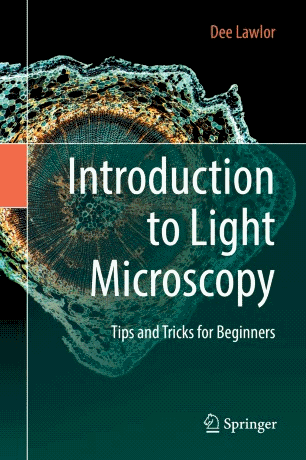
Introduction to Light Microscopy. Tips and Tricks for Beginners (2019)
Dee LawlorSpringer
ISBN 978-3-030-05392-5
164 pagesPublisher Description: This book offers a beginner’s guide to using light microscopes. It begins with a brief introduction to the physics of optics, which will give the reader a basic grasp of the behaviors of light. In turn, each part of the microscope is explained using clear and simple English, together withdetailed photographs and diagrams. The reader will learn the function, care and correct use of each part. A troubleshooting section also helps resolve some of the most common issues encountered in light microscopy. Most people have a general idea of how to use a microscope, but many never get the full benefit, because they receive no training. With easy-to-follow steps and detailed images, this guide will help everyone achieve the best results, and be confident using their microscope. This book is intended for anyone using a light microscope, such as university students, people in lab environments, hobbyists, educators who teach science to young children, and anyone with a general interest in these valuable tools.
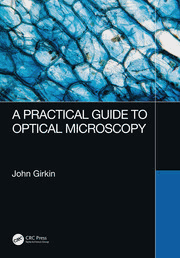
A Practical Guide to Optical Microscopy (2019)
John Girkin
CRC Press
ISBN
278 pagesPublisher Description: Optical microscopy is used in a vast range of applications ranging from materials engineering to in vivo observations and clinical diagnosis, and thanks to the latest advances in technology, there has been a rapid growth in the number of methods available. This book is aimed at providing users with a practical guide to help them select, and then use, the most suitable method for their application. It explores the principles behind the different forms of optical microscopy, without the use of complex maths, to provide an understanding to help the reader utilise a specific method and then interpret the results. Detailed physics is provided in boxed sections, which can be bypassed by the non-specialist. It is an invaluable tool for use within research groups and laboratories in the life and physical sciences, acting as a first source for practical information to guide less experienced users (or those new to a particular methodology) on the range of techniques available.
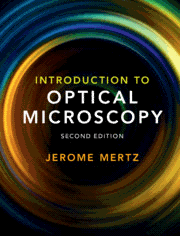
Introduction to Optical Microscopy (2019)
J
erome MertzCambridge Press
ISBN 9781108428309 462 pages
Publisher Description: This fully updated, self-contained textbook covering modern optical microscopy equips students with a solid understanding of the theory underlying a range of advanced techniques. Two new chapters cover pump-probe techniques, and imaging in scattering media, and additional material throughout covers light-sheet microscopy, image scanning microscopy, and much more. An array of practical techniques are discussed, from classical phase contrast and confocal microscopy, to holographic, structured illumination, multi-photon, and coherent Raman microscopy, and optical coherence tomography. Fundamental topics are also covered, including Fourier optics, partial coherence, 3D imaging theory, statistical optics, and the physics of scattering and fluorescence. With a wealth of end-of-chapter problems, and a solutions manual for instructors available online, this is an invaluable book for electrical engineering, biomedical engineering, and physics students taking graduate courses on optical microscopy, as well as advanced undergraduates, professionals, and researchers looking for an accessible introduction to the field.
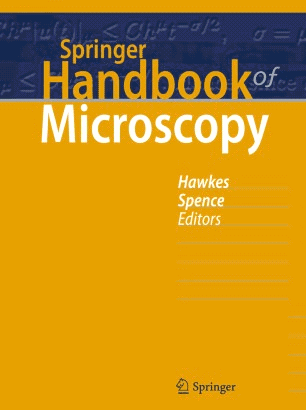
Springer Handbook of Microscopy (2019)
Peter W. HawkesJohn C. H. Spence (Eds.)
Springer
ISBN 978-3-030-00068-41
1543 pagesPublisher Description: This book features reviews by leading experts on the methods and applications of modern forms of microscopy. The recent awards of Nobel Prizes awarded for super-resolution optical microscopy and cryo-electron microscopy have demonstrated the rich scientific opportunities for research in novel microscopies. Earlier Nobel Prizes for electron microscopy (the instrument itself and applications to biology), scanning probe microscopy and holography are a reminder of the central role of microscopy in modern science, from the study of nanostructures in materials science, physics and chemistry to structural biology. Separate chapters are devoted to confocal, fluorescent and related novel optical microscopies, coherent diffractive imaging, scanning probe microscopy, transmission electron microscopy in all its modes from aberration corrected and analytical to in-situ and time-resolved, low energy electron microscopy, photoelectron microscopy, cryo-electron microscopy in biology, and also ion microscopy. In addition to serving as an essential reference for researchers and teachers in the fields such as materials science, condensed matter physics, solid-state chemistry, structural biology and the molecular sciences generally, the Springer Handbook of Microscopy is a unified, coherent and pedagogically attractive text for advanced students who need an authoritative yet accessible guide to the science and practice of microscopy.
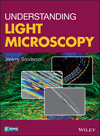
Understanding Light Microscopy (2019)
Jeremy Sanderson
Wiley
ISBN 9780470973752
817 pagesPublisher Description: Introduces readers to the enlightening world of the modern light microscope. There have been rapid advances in science and technology over the last decade, and the light microscope, together with the information that it gives about the image, has changed too. Yet the fundamental principles of setting up and using a microscope rests upon unchanging physical principles that have been understood for years. This informative, practical, full-colour guide fills the gap between specialised edited texts on detailed research topics, and introductory books, which concentrate on an optical approach to the light microscope. It also provides comprehensive coverage of confocal microscopy, which has revolutionised light microscopy over the last few decades. Written to help the reader understand, set up, and use the often very expensive and complex modern research light microscope properly, Understanding Light Microscopy keeps mathematical formulae to a minimum—containing and explaining them within boxes in the text. Chapters provide in-depth coverage of basic microscope optics and design; ergonomics; illumination; diffraction and image formation; reflected-light, polarised-light, and fluorescence microscopy; deconvolution; TIRF microscopy; FRAP & FRET; super-resolution techniques; biological and materials specimen preparation; and more.
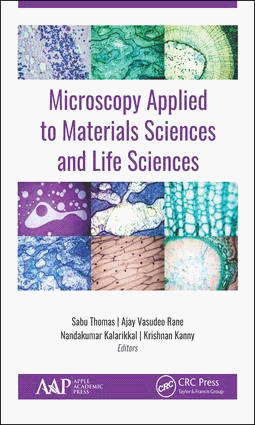
Microscopy Applied to Materials Sciences and Life Sciences (2018)
Ajay Vasudeo Rane, Sabu Thomas, Nandakumar Kalarikkal (Eds.)
CRC Press
ISBN
526 pagesPublisher Description: This new volume, Microscopy Applied to Materials Sciences and Life Sciences. focuses on recent theoretical and practical advances in polymers and their blends, composites, and nanocomposites related to their microscopic characterization. It highlights recent accomplishments and trends in the field of polymer nanocomposites and filled polymers related to microstructural characterization. This book gives an insight and better understanding into the development in microscopy as a tool for characterization. The book emphasizes recent research work in the field of microscopy in life sciences and materials sciences mainly related to its synthesis, characterizations, and applications. The book explains the application of microscopic techniques in life sciences and materials sciences, and their applications and state of current research carried out. The book aims to foster a better understanding of the properties of polymer composites by describing new techniques to measure microstructure property relationships and by utilizing techniques and expertise developed in the conventional filled polymer composites. Characterization techniques, particularly microstructural characterization, have proven to be extremely difficult because of the range of length-scales associated with these materials.
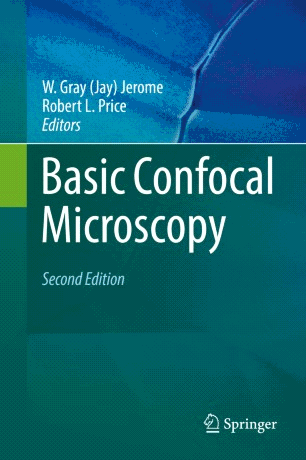
W. P. Gray (Jay) Jerome, Robert L. Price (Eds.)
Springer
ISBN
978-3-319-97453-8 368 pagesPublisher Description: Basic Confocal Microscopy, Second Edition builds on the successful first edition by keeping the same format and reflecting relevant changes and recent developments in this still-burgeoning field. This format is based on the Confocal Microscopy Workshop that has been taught by several of the authors for nearly 20 years and remains a popular workshop for gaining basic skills in confocal microscopy. While much of the information concerning fluorescence and confocal microscopy that made the first edition a success has not changed in the six years since the book was first published, confocal imaging is an evolving field and recent advances in detector technology, operating software, tissue preparation and clearing, image analysis, and more have been updated to reflect this. Several of these advances are now considered routine in many laboratories, and others such as super resolution techniques built on confocal technology are becoming widely available.
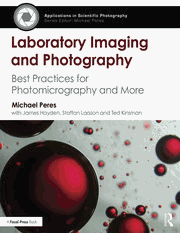
Laboratory Imaging & Photography. Best Practices for Photomicrography and More (2017)
Michael Peres
Routledge
ISBN
392 pagesPublisher Description: Laboratory Imaging and Photography: Best Practices for Photomicrography and More is the definitive guide to the production of scientific images. Inside, the reader will find an overview of the theory and practice of laboratory photography, along with useful approaches to choosing equipment, handling samples, and working with microscopic subjects. Drawing from over 150 years of combined experience in the field, the authors outline methods of properly capturing, processing and archiving the images that are essential to scientific research. Also included are chapters on applied close-up photography, artificial light photography and the optics used in today’s laboratory environment, with detailed entries on light, confocal and scanning electron microscopy. A lab manual for the digital era, this peerless reference book explains how to record visual data accurately in an industry where a photograph can serve to establish a scientific fact.
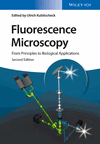
Fluorescence Microscopy. From Principles to Biological Applications. 2nd Ed. (2017)
Ulrich Kubitscheck
(Ed.)Wiley
ISBN 9783527338375
482 pagesPublisher Description: While there are many publications on the topic written by experts for experts, this text is specifically designed to allow advanced students and researchers with no background in physics to comprehend novel fluorescence microscopy techniques. This second edition features new chapters and a subsequent focus on super-resolution and single-molecule microscopy as well as an expanded introduction. Each chapter is written by a renowned expert in the field, and has been thoroughly revised to reflect the developments in recent years.
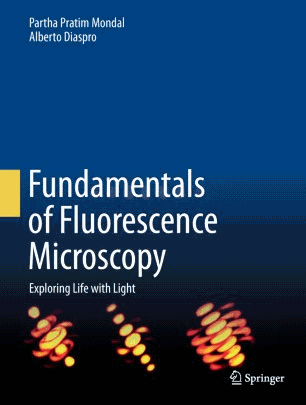
Fundamentals of Fluorescence Microscopy. Exploring Life with Light (2014)
Partha Pratim Mondal, Alberto Diaspro
Springer
ISBN 978-94-007-7544-2 218 pages
Publisher Description: This book starts at an introductory level and leads reader to the most advanced developments in fluorescence imaging and super-resolution techniques that have enabled the emergence of new disciplines such as nanobioimaging, multiphoton microscopy, photodynamic therapy, nanometrology and nanosensors. The interdisciplinary subject of fluorescence microscopy and imaging requires complete knowledge of imaging optics and molecular physics. So, this book approaches the subject by introducing optical imaging concepts before going deep into the advanced imaging systems and their applications. Molecular orbital theory forms the basis for understanding fluorescent molecules and thereby facilitates complete explanation of light-matter interaction at the geometrical focus. The two disciplines have some overlap since light controls the states of molecules and conversely, molecular states control the emitted light. These two mechanisms together determine essential fluorescence factors and phenomena such as, molecular cross-section, Stokes shift, emission and absorption spectra, quantum yield, signal-to-noise ratio, Forster resonance energy transfer (FRET), fluorescence recovery after photobleaching (FRAP) and fluorescence lifetime. These phenomena form the basis of many fluorescence based devices. The book is organized into two parts. The first part deals with basics of imaging optics and its applications. The advanced part covers many imaging techniques and related instrumentation that are developed in the last decade pointing towards far-field diffraction limited and unlimited imaging.

Sample Preparation Handbook for Transmission Electron Microscopy: Techniques (2010)
Ayache, J., Beaunier, L., Boumendil, J., Ehret, G., Laub.
Springer
ISBN 978-1-4419-5975-1
338 pagesPublisher Description: This two-volume Handbook is a comprehensive and authoritative guide to sample preparation for the transmission electron microscope. This first volume covers general theoretical and practical aspects of the methodologies used for TEM analysis and observation of any sample. The information will help you to choose the best preparative technique for your application taking into account material types, structures, and their properties. Physical properties, material classification, and microstructures are considered together with a thorough description of the physics and chemistry of sample preparation and the main artifacts brought about by mechanical, physical and chemical methods, principles which are also applicable to sample preparation for the SEM, AFM etc.. Also included is a discussion of how to combine techniques for complex sample analysis and to obtain a TEM thin slice. Sample Preparation Handbook for Transmission Electron Microscopy: Methodology will guide you through the most current techniques for successful sample preparation in all fields from materials science to biology.

Sample Preparation Handbook for Transmission Electron Microscopy
: Methodology (2010)Ayache, J., Beaunier, L., Boumendil, J., Ehret, G., Laub.
Springer
ISBN
978-0-387-98182-6 250 pagesPublisher Description: Describes physical characteristics, chemistry, structure/texture, and orientation properties of materials in relation to the most appropriate type of TEM analysis.

Scanning Force Microscopy of Polymers (2010)
Vancso, G. Julius, Schönherr, Holger
Springer
ISBN-10: 3642012302 248 pages
Publisher Description: This lab manual introduces the reader to scanning force microscopy of polymers based on a practice-oriented approach. It begins with a broad introduction to the necessary background of SFM, including intermolecular forces and various SFM imaging modes. "Scanning Force Microscopy of Polymers" is developed in a didactically clear and easily understandable style. The application of SFM to visualize and study polymers is exemplified by numerous case studies, including experimental protocols. In addition, the book helps the reader to develop a conscious and critical understanding of SFM data. This approach enables the reader to acquire the knowledge and experimental skills that are necessary to understand and obtain good and reliable SFM results within the shortest time possible.

Advanced Computing in Electron Microscopy. 2nd ed. (2010)
Kirkland, Earl J.
Springer
ISBN 978-1-4419-6533-2 289 pages
Publisher Description: Advanced Computing in Electron Microscopy, 2nd Edition, brings together diverse information on image simulation. An invaluable resource, this book provides information on various methods for numerical computation of high resolution conventional and scanning transmission electron microscope images. This text will serve as a great tool for students at the advanced undergraduate or graduate level, as well as experienced researchers in the field.

Handbook of Sample Preparation for Scanning Electron Microscopy and X-Ray Microanalysis (2009)
Echlin, Patrick
Springer
ISBN 978-0-387-85731-2 330 pages
Publisher Description: This Handbook is a complete guide to preparing a wide variety of specimens for the scanning electron microscope and x-ray microanalyzers. Specimens range from inorganic, organic, biological, and geological samples to materials such as metals, polymers, and semiconductors which can exist as solids, liquids and gases.

Transmission Electron Microscopy: A Textbook for Materials Science. 2nd Ed. (2009)
Williams, David B., Carter, C. Barry
Springer
ISBN 978-0-387-76501-3 760 pages
Publisher Description: This groundbreaking text has been established as the market leader throughout the world. Now profusely illustrated with full color figures and diagrams throughout the text, Provides the necessary insight and guidance for successful hands-on application of this versatile and powerful materials characterization technique. For this first new edition in 12 years, many sections have been completely rewritten with all others revised and updated. The new edition also includes an extensive collection of questions for the student, providing approximately 800 for self-assessment and over 400 that are suitable for homework assignment.

Polymer Microscopy: Characterization and Evaluation of Materials. 3rd Ed.(2008)
Linda Sawyer, David T. Grubb, Gregory F. Meyers
Springer
ISBN-10: 0387726276 416 pages
Publisher Description: Polymer Microscopy, Third Edition, is a comprehensive and practical guide to the study of the microstructure of polymers, and is the result of the authors' many years of academic and industrial experience. To address the needs of students and professionals from a variety of backgrounds, introductory chapters deal with the basic concepts of both polymer morphology and processing and microscopy and imaging theory. The core of the book is more applied, with many examples of specimen preparation and image interpretation leading to materials characterization. Microscopy is applied to the characterization of a wide range of polymer systems, including fibers, films, engineering resins and plastics, composites, nanocomposites, polymer blends, emulsions and liquid crystalline polymers. Light microscopy, atomic force microscopy, and scanning and transmission electron microscopy techniques are all considered, as are emerging techniques such as compositional mapping in which microscopy is combined with spectroscopy. This extensively updated and revised Third Edition closes with a problem solving guide, which gives a systematic framework for deciding on suitable approaches to the characterization of polymer microstructure.

Electron Microscopy of Polymers (2008)
Michler, Goerg H.
Springer
ISBN: 3540363505 474 pages
Publisher Description: There are many books on electron microscopy, however, the study of polymers using EM necessitates special techniques, precautions and preparation methods, including ultramicrotomy. This book discusses the general characteristics of the various techniques of EM, including scanning force microscopy (AFM). The application of these techniques to the study of morphology and properties, particularly micromechanical properties, is described in detail. Examples from all classes of polymers are presented.

Scanning Probe Microscopy (2007)
Kalinin, Sergei V., Gruverman, Alexei
Springer
ISBN 978-0-387-28668-6 980 pages
Publisher Description: Scanning Probe Microscopy brings up to date a constantly growing knowledge base of electrical and electromechanical characterization at the nanoscale. This comprehensive, two-volume set presents practical and theoretical issues of advanced scanning probe microscopy (SPM) techniques ranging from fundamental physical studies to device characterization, failure analysis, and nanofabrication. Volume 1 focuses on the technical aspects of SPM methods ranging from scanning tunneling potentiometry to electrochemical SPM, and addresses the fundamental physical phenomena underlying the SPM imaging mechanism. Volume 2 concentrates on the practical aspects of SPM characterization of a wide range of materials, including semiconductors, ferroelectrics, dielectrics, polymers, carbon nanotubes, and biomolecules, as well as on SPM-based approaches to nanofabrication and nanolithography.

Hawkes, P.W.; Spence, John C.H. (Eds.)
Springer
ISBN 978-0-387-49762-4 748 pages
Publisher Description: This fully corrected second impression of the classic 2006 text on microscopy runs to more than 1,000 pages and covers up-to-the-minute developments in the field. The two-volume work brings together a slew of experts who present comprehensive reviews of all the latest instruments and new versions of the older ones, as well as their associated operational techniques. The chapters draw attention to their principal areas of application. New forms of imaging in science have nearly always led to major advances, especially in the nanoworld, and the pace of these developments has increased dramatically in recent decades. Many new types of microscopes have joined the traditional light microscope and the transmission and scanning electron microscopes during the past two decades. A huge range of subjects are benefiting from these new tools, including semiconductor physics, medicine, molecular biology, the nanoworld in general, magnetism, and ferroelectricity. This fascinating book will be an indispensable guide for a wide range of scientists in university laboratories as well as engineers and scientists in industrial R&D departments.

Polarized Light in Liquid Crystals and Polymers (2006)
Toralf Scharf
Wiley
ISBN 9780471740643
400 pagesPublisher Description: Polarized Light in Liquid Crystals and Polymers deals with the linear optics of birefringent materials, such as liquid crystals and polymers, and surveys light propagation in such media with special attention to applications. It is unique in treating light propagation in micro- and nanostructured birefringent optical elements, such as lenses and gratings composed of birefringent materials, as well as the spatial varying anisotropic structures often found in miniaturized liquid crystal device.

Microscopy Techniques for Materials Science (2002) (Knovel 2005)
Clarke, A.R.; Eberhardt, C.N.
Woodhead Publishing (CRC)
ISBN 978-1-85573-587-3 424 pages
Publisher Description: An overview of and practical guide to the various computer-aided light microscopical techniques used in materials science today. After introducing the reader to the basic concepts of optics, the interactions between light and matter, and image processing, the book goes on to discuss in depth both 2-d reflection microscopy and confocal laser scanning microscopy. The application of these techniques to the characterization of materials is abundantly illustrated through specific case studies. There is also discussion of other modern optical imaging techniques and even of non-optical ones such as x-ray micrography.

Fundamentals of Light Microscopy and Electronic Imaging. 2nd Ed. (2012)
Douglas B. Murphy, Michael W. Davidson
Wiley-Blackwell
ISBN 9780471692140 552 pages
Publisher Description: Fundamentals of Light Microscopy and Electronic Imaging, Second Edition provides a coherent introduction to the principles and applications of the integrated optical microscope system, covering both theoretical and practical considerations. It expands and updates discussions of multi-spectral imaging, intensified digital cameras, signal colocalization, and uses of objectives, and offers guidance in the selection of microscopes and electronic cameras, as well as appropriate auxiliary optical systems and fluorescent tags. The book is divided into three sections covering optical principles in diffraction and image formation, basic modes of light microscopy, and components of modern electronic imaging systems and image processing operations. Each chapter introduces relevant theory, followed by descriptions of instrument alignment and image interpretation. This revision includes new chapters on live cell imaging, measurement of protein dynamics, deconvolution microscopy, and interference microscopy.
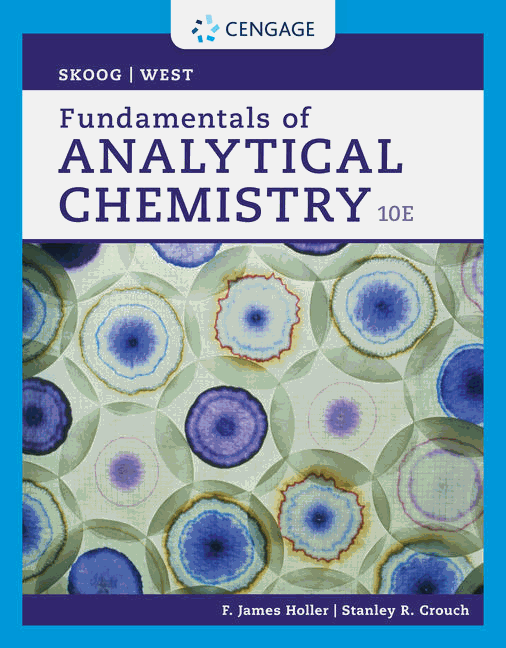
Douglas A. Skoog; Donald M. West; F. James Holler; Stanley R. Crouch
Cengage Learning
ISBN 978-0357450444 1072 pages
Publisher Description: Introduce the principles and practices behind analytical chemistry while emphasizing its applied nature with Skoog/West/Holler/Crouch's Fundamentals of Analytical Chemistry, 10th Edition. This award-winning author team presents analytical chemistry using a reader-friendly yet systematic and rigorous approach with updates that reflect the latest developments. Each chapter begins with a compelling story and stunning visuals that demonstrate how analytical chemistry impacts industry, medicine and the sciences today. Dynamic photos from renowned chemistry photographer Charlie Winters captivate readers while reinforcing principles. Updated content integrates the use of Excel 2019 as a problem-solving tool in analytical chemistry with summaries, new exercises and a no-cost supplement by the text authors. A complete package includes OWLv2 online resources that take a mastery approach to learning.
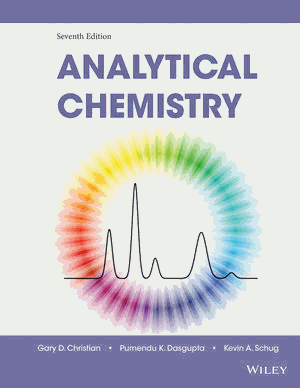
Analytical Chemistry. 7th Ed. (2013)
Gary D. Christian, Purnendu K. Dasgupta, Kevin A. Schug
Wiley
ISBN 978-0-470-88757-8 848 pages
Publisher Description: With the 7th Edition of Analytical Chemistry renowned chemists, Purnendu (Sandy) Dasgupta and Kevin Schug, both of the University of Texas Arlington, join the author team. The new edition focuses on more in-depth coverage of the principles and techniques of quantitative analysis and instrumental analysis (aka Analytical Chemistry). The goal of the text is to provide a foundation of the analytical process, tools, and computational methods and resources, and to illustrate with problems that bring realism to the practice and importance of analytical chemistry. It is designed for undergraduate college students majoring in chemistry and in fields related to chemistry.
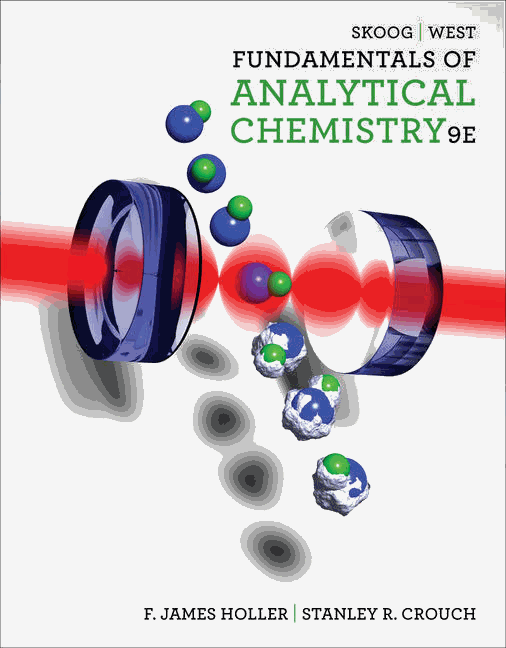
Fundamentals of Analytical Chemistry. 9th Ed. (2013)
Douglas A. Skoog; Donald M. West; F. James Holler; Stanley R. Crouch
Cengage Learning
ISBN 978-0495558286 1072 pages
Publisher Description: Known for its readability and systematic, rigorous approach, this fully updated Ninth Edition of Fundamentals of Analytical Chemistry offers extensive coverage of the principles and practices of analytic chemistry and consistently shows students its applied nature. The book's award-winning authors begin each chapter with a story and photo of how analytic chemistry is applied in industry, medicine, and all the sciences. To further reinforce student learning, a wealth of dynamic photographs by renowned chemistry photographer Charlie Winters appear as chapter-openers and throughout the text. Incorporating Excel spreadsheets as a problem-solving tool, the Ninth Edition is enhanced by a chapter on Using Spreadsheets in Analytical Chemistry, updated spreadsheet summaries and problems, an "Excel Shortcut Keystrokes for the PC" insert card, and a supplement by the text authors, EXCEL® APPLICATIONS FOR ANALYTICAL CHEMISTRY, which integrates this important aspect of the study of analytical chemistry into the book's already rich pedagogy. New to this edition is OWL, an online homework and assessment tool that includes the Cengage YouBook, a fully customizable and interactive eBook, which enhances conceptual understanding through hands-on integrated multimedia interactivity.
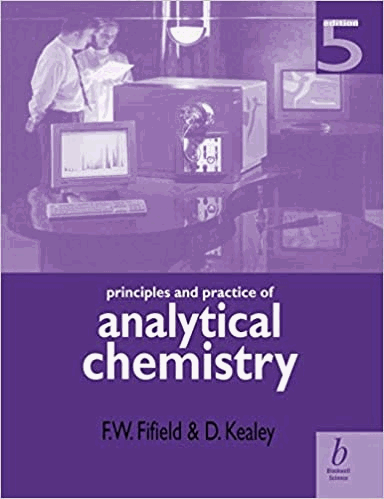
Principles and Practice of Analytical Chemistry. 5th Ed. (2010)
F. W. Fifield, David Kealey
Wiley
ISBN 978-0-632-05384-1 578 pages
Publisher Description: Over more than two decades this book has established itself as the first choice for growing numbers of students and practising analysts who require a well-written and concise overview of the principles and practice of analytical chemistry. Significant changes encompass strengthening of the coverage of data handling, together with new material covering rapidly developing subject areas of molecular spectrometry, atomic spectrometry, and separation techniques. Answers to the self- learning problems and exercises are also included. The new edition of the book will continue to provide a sound and broad base for the study of analytical chemistry.
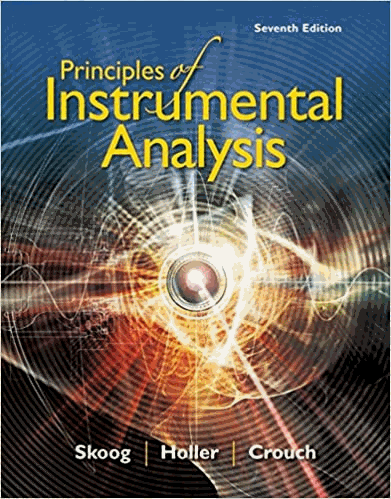
Douglas A. Skoog; F. James Holler; Stanley R. Crouch
Cengage Learning
ISBN 978-1305577213 1072 pages
Publisher Description:
Principles of Instrumental Analysis sets the standard for courses on the principles and applications of modern analytical instruments. In this tth Edition, authors Skoog, Holler, and Crouch infuse their popular text with updated techniques and new action-oriented case studies. A proven approach emphasizes the fundamental principles of operation for each type of instrument, its optimal area of application as well as its sensitivity, precision, and limitations. Content also introduces elementary analog and digital electronics, computers, and the treatment of analytical data.
Robert M. Granger, Hank M. Yochum, Jill N. Granger, and Karl D. Sienerth
Oxford (OUP)
ISBN
978-0190865337 880 pagesPublisher Description:
Instrumental Analysis provides a rigorous, modern, and engaging coverage of chemical instrumentation, written with the undergraduate student in mind. At its core, Instrumental Analysis includes the underlying theory, instrumental design, applications and operation of spectroscopic, electroanalytical, chromatographic, and mass spectral instrumentation. It provides students with the requisite skills to identify the comparative advantages and disadvantages in choosing one analytical technique over another by combining direct comparisons of the techniques with a discussion of how these choices affect the interpretation of the data in its final form.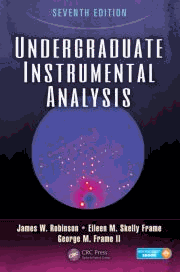
James W. Robinson, Eileen Skelly Frame, George M. Frame II
CRC Press
ISBN 9781420061352
1264 pagesPublisher Description:
Crucial to research in molecular biology, medicine, geology, food science, materials science, and many other fields, analytical instrumentation is used by many scientists and engineers who are not chemists. Undergraduate Instrumental Analysis, Seventh Edition provides users of analytical instrumentation with an understanding of these instruments, covering all major fields of modern instrumentation. Following the tradition of earlier editions, this text is designed for teaching undergraduates and those with no analytical chemistry background how contemporary analytical instrumentation works, as well as its uses and limitations. Each chapter provides a discussion of the fundamental principles underlying the techniques, descriptions of the instrumentation, and numerous applications. The chapters also contain updated bibliographies and problems, and most have suggested experiments appropriate to the techniques. This completely revised and updated edition covers subjects in more detail, such as a completely revised x-ray chapter, expanded coverage of electroanalytical techniques, and expansion of chromatography and mass spectrometry topics to reflect the predominance of these instruments in laboratories. This includes state-of-the-art sample introduction and mass analyzers, and the latest developments in UPLC and hyphenated techniques. The book also contains new graphics and addresses several new topics: Ion mobility spectrometry, Time domain NMR (relaxometry), Electron spin resonance spectroscopy (ESR, EPR), Forensic science and bioanalytical applications, Microcalorimetry and optical thermal instruments, Laser-induced breakdown spectroscopy (LIBS). This text uniquely combines instrumental analysis with organic spectral interpretation (IR, NMR, and MS). It provides detailed coverage of sampling, sample handling, sample storage, and sample preparation. In addition, the authors have included many instrument manufacturers’ websites, which contain extensive resources.
Quantitative Analytical Chemistry
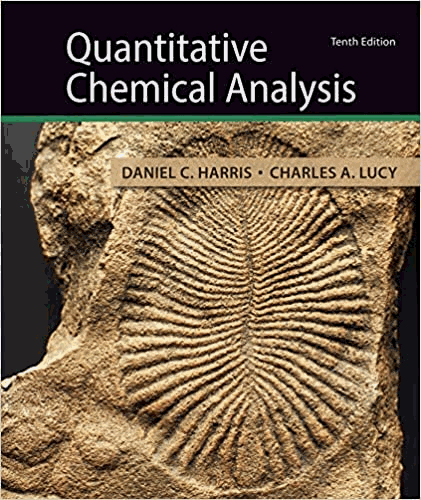
Quantitative Chemical Analysis. 10th Ed. (2019)
Daniel C. Harris; Charles A. Lucy
Macmillan
ISBN 978-1319164300 1056 pages
Publisher Description: The 10th edition of Quantitative Chemical Analysis continues to set the standard for learning analytical chemistry with distinguished writing, the most up-to-date content, and now the acclaimed Achieve program, supporting exceptional problem solving practice. New author Charles Lucy joins Dan Harris, infusing additional subject expertise and classroom experience into the 10th edition. Macmillan’s new online learning platform, Achieve is the culmination of years of development work put toward creating the most powerful online learning tool for chemistry students. Achieve includes an interactive e-Book as well as our renowned assessments. Students will be able to focus their study with adaptive quizzing and gain a better understanding of what is happening at the atomic or molecular level through instrumentation technique videos. Achieve features a flexible suite of resources to support learning core concepts, visualization, problem-solving, and assessment. This powerful platform houses all student and instructor resources. You can assign what you want or download resources as you need. Powerful analytics and quick insights in Achieve pair with exceptional content to provide an unrivaled learning and teaching experience.
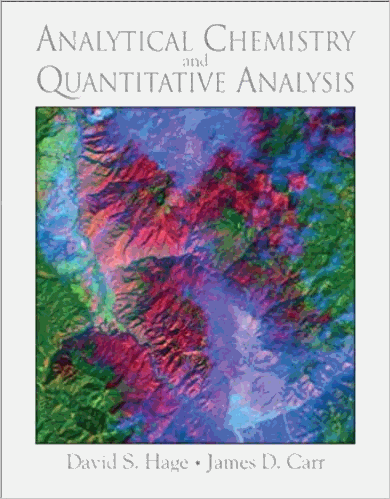
Analytical Chemistry and Quantitative Analysis (2010)
David S. Hage; Lincoln James R. Car
Pearson
ISBN 978-0321596949 720 pages
Publisher Description: Analytical Chemistry and Quantitative Analysis presents concepts and procedures in a manner that reflects the practice and applications of these methods in today’s analytical laboratories. These methods are illustrated by using current examples from fields that include forensics, environmental analysis, medicine, biotechnology, food science, pharmaceutical science, materials analysis, and basic research. The fundamental principles of laboratory techniques for chemical analysis are introduced, along with issues to consider in the appropriate selection and use of these methods—including the proper use and maintenance of balances, laboratory glassware, and notebooks, as well as mathematical tools for the evaluation and comparison of experimental results.
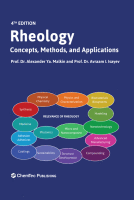
Alexander Ya. Malkin
, Avraam Isayev.ChemTec Publishing
ISBN 978-1-927885-93-2 50
4 pagesPublisher Description: Rheology: Concepts, Methods, and Applications, Fourth Edition provides a thorough historical and theoretical grounding in the field and introduces rheology as the method for solving many practical problems in materials science and engineering. This new edition has been updated to include new evidence-based methods and applications, coverage of non-Newtonian properties and their effect on material processing, heterogeneity in flow, rheology of highly concentrated emulsions and suspensions, viscosity and viscoelastic behavior of nanocomposites, the behavior of supramolecular solutions, rheology of gels, deformation-induced anisotropy, conformation changes during flow and molecular orientation.
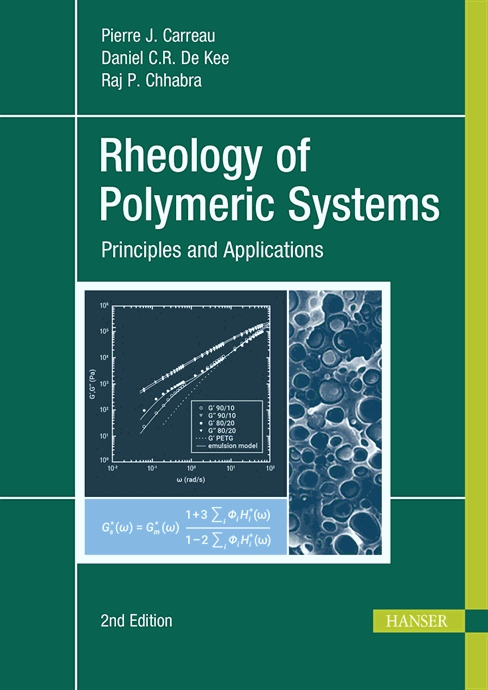
Rheology of Polymeric Systems: Principles and Applications 2nd Ed. (2021)
Pierre J. Carreau, Daniel C.R. De Kee, Raj P. Chhabra
Hanser Publications
ISBN 978-1569907221
642 pagesPublisher Description: Rheology is applied extensively in polymer, chemical, food processing, and related industries. This book combines the basic concepts and applications by presenting a balanced overview of the principles. With simplified analysis of complex problems, the textbook format provides easy understanding for both students and practicing professionals. There is no competing book with such a wide scope, including unique topics such as diffusion, flows about particles, and liquid mixing. This second edition is abundantly updated throughout. Highlights include yield stress measurements, non-Fickian diffusion and rheology of polymer nanocomposites, new results based on CFD simulations, and much more.

The Rheology Handbook. For Users of Rotational and Oscillatory Rheometers. 5th Ed(2020)
Thomas G Mezger
Vincentz Network
ISBN 9783866305328 528 pages
Publisher Description: Already in its 5th edition, this standard work describes the principles of rheology clearly, vividly and in practical terms. The book includes the rheology of additives in waterborne dispersions and surfactant systems. Not only it is a great reference book, it can also serve as a textbook for studying the theory behind the methods. The practical use of rheology is presented in the areas quality control, production and application, chemical and mechanical engineering, materials science and industrial research and development. After reading this book, the reader should be able to perform tests with rotational and oscillatory rheometers and interpret the results correctly.

The Abbott Guide to Rheology (2018)
Steven Abbot
Self Published
61 pages
Publisher Description: Rheology is too often seen as scary, unhelpful, confusing, difficult and obscure. That is because it is discussed by smart rheologists who don't understand how difficult they make it for the rest of us. The point of The Abbott Guide to Rheology (61pp & 21k words) is to make rheology usable by the formulation community. It is short, informal, completely free and is not tied to any advertising or email list and doesn't require registration.
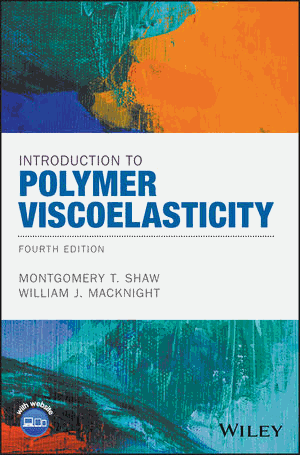
Introduction to Polymer Viscoelasticity. 4th Ed (2018)
Montgomery T. Shaw, William J. MacKnight
Wiley
ISBN 978-1-119-18182-8 3
84 pagesPublisher Description: Completely revised and updated, the fourth edition of this classic text continues to offer the reader a thorough understanding of viscoelastic behavior, essential for the proper utilization of polymers..

Understanding Viscoelasticity: An Introduction to Rheology. 3rd ed. (2017)
Nhan Phan-Thien, Nam Mai-Duy
Springer
ISBN 978-3319619996
322 pagesPublisher Description: This book presents an introduction to viscoelasticity, in particular, to the theories of dilute polymer solutions and dilute suspensions of rigid particles in viscous and incompressible fluids. These theories are important, not just because they apply to practical problems of industrial interest, but because they form a solid theoretical base upon which mathematical techniques can be built, from which more complex theories can be constructed, to better mimic material behaviour. The emphasis of this book is not on the voluminous current topical research, but on the necessary tools to understand viscoelasticity. This is a compact book for a first year graduate course in viscoelasticity and modelling of viscoelastic multiphase fluids. The Dissipative Particle Dynamics (DPD) is introduced as a particle-based method, relevant in modelling of complex-structured fluids. All the basic ideas in DPD are reviewed. The third edition has been updated and expanded with new results in the meso-scale modelling, links between the fluid modelling to its physical parameters and new matlab programs illustrating the modelling. Particle-based modelling techniques for complex-structure fluids are added together with some sample programs. A solution manual to the problems is included.
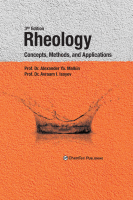
Rheology: Concepts, Methods, and Applications. 3rd Ed. (2017)
Alexander Ya. Malkin, Avraam Isayev.
ChemTec Publishing
ISBN 978-1-927885-21-5 500 pages
Publisher Description: Rheology: Concepts, Methods and Applications, Third Edition provides a thorough historical and theoretical grounding in the field, and introduces rheology as the method of solving many practical problems in materials science and engineering. The book is practical and relevant for industry, but is also consistent with rheology courses in academia, making it relevant to both academics and accomplished rheologists in industry.
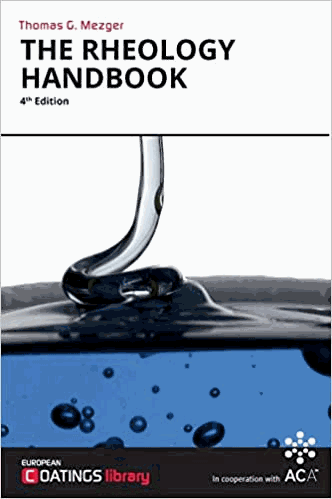
The Rheology Handbook. For Users of Rotational and Oscillatory Rheometers. 4th Ed (2017)
Thomas G Mezger
Vincentz Network
ISBN 978-3866308428 434 pages
Publisher Description: Already in its 4th edition, this standard work describes the principles of rheology clearly, vividly and in practical terms. The book includes the rheology of additives in waterborne dispersions and surfactant systems. Not only it is a great reference book, it can also serve as a textbook for studying the theory behind the methods. The practical use of rheology is presented in the areas quality control, production and application, chemical and mechanical engineering, materials science and industrial research and development. After reading this book, the reader should be able to perform tests with rotational and oscillatory rheometers and interpret the results correctly.

Applied Rheology - With Joe Flow on Rheology Road (2014)
Thomas G Mezger
Anton Paar
ISBN 978-3950401608
191 pagesPublisher Description: Applied Rheology is primarily aimed at users of rotation and oscillation rheometers. Embark on a journey of discovery with Joe Flow down Rheology Road. Your stroll begins with ideally viscous liquids through the suburbs of viscoelastic materials to arrive at ideally elastic solids. Along the way, Joe Flow provides many insights and practical tips for making meaningful measurements. You'll find a great resource in Applied Rheology, whether you're a newcomer or an experienced user. Thomas Mezger finds a clear and entertaining way to describe the laws of rheology and how they can be applied to samples from key industries, including the construction, polymer, coatings, pharmaceutical, and food industrie.
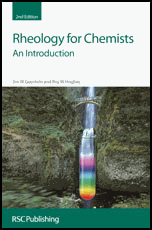
Rheology for Chemists: An Introduction. 2nd Ed. (2008)
J Goodwin, R Hughes
RSC
ISBN 978-0854048397
276 pagesPublisher Description: Rheology is primarily concerned with materials: scientific, engineering and everyday products whose mechanical behaviour cannot be described using classical theories. From biological to geological systems, the key to understanding the viscous and elastic behaviour firmly rests in the relationship between the interactions between atoms and molecules and how this controls the structure, and ultimately the physical and mechanical properties. Rheology for Chemists An Introduction takes the reader through the range of rheological ideas without the use of the complex mathematics. The book gives particular emphasis on the temporal behaviour and microstructural aspects of materials, and is detailed in scope of reference. An excellent introduction to the newer scientific areas of soft matter and complex fluid research, the second edition also refers to system dimension and the maturing of the instrumentation market. This book is a valuable resource for practitioners working in the field, and offers a comprehensive introduction for graduate and post graduates. "... well-suited for self-study by research workers and technologists, who, confronted with technical problems in this area, would like a straightforward introduction to the subject of rheology." Chemical Educator, "... full of valuable insights and up-to-date information." Chemistry World.

A Handbook of Elementary Rheology
H
oward Antony BarnesUniversity of Wales,Institute of Non-Newtonian Fluid Mechanics
ISBN 0953803201 2
04 pagesFrom the Foreword: "In an earlier book — An Introduction to Rheology we stated that rheology is a difficult subject. However, even though we then tried to make it as simple as possible, a number of people still told us that they found the book hard going. This present book is meant to satisfy this group. For this reason, the mathematical content has been kept to a minimum, and the text is as descriptive as possible: there are no integrals and only the occasional differentiation symbol, with all the equations in the simple algebraic form of A = B. The book is suitable as a first introduction to the subject of Rheology for any student of science or engineering. However, having worked in industry for thirty years, I am also trying to meet the needs of my industrial colleagues who—often without any previous training in the subject of rheology—find themselves having to work on the formulation and processing of non-Newtonian liquids. The contents of this book are expansions of lectures that I have given to both these groups of people over the years, in introductory rheology courses run by rheometer companies, training organisations and universities around the world".
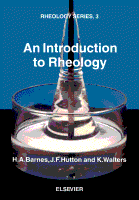
An Introduction to Rheology (1989)
H.A. Barnes, J.F. Hutton, K. Walters
Elsevier
ISBN 1493302612 210 pages
Publisher Description: Rheology is, by common consent, a difficult subject and some of the theoretical components are often viewed as being of prohibitive complexity by scientists without a strong mathematical background. There are also the difficulties inherent in any multidisciplinary science like rheology for those with a specific training. Therefore, newcomers to the field are sometimes discouraged, and for them the existing texts on the subject - some of which are outstanding - are of limited assistance because of their depth of detail and highly mathematical nature.This book introduces the subject of rheology in terms understandable to non-experts and describes the application of rheological principles to many industrial products and processes. It provides a simple but authoritative guide which shows clearly how mathematics, physics and chemistry have contributed to the development of rheology. The generic features of all liquid-like materials are summarised, i.e. viscosity, linear viscoelasticity, normal stresses and extensional viscosity. Particular systems are then discussed, i.e. polymeric liquids and suspensions. The final chapter gives an outline of the theoretical advances which have been made. Consistent notation and nomenclature have been used throughout the book, and the key textbooks and publications which will enable the reader to follow up particular topics are listed.
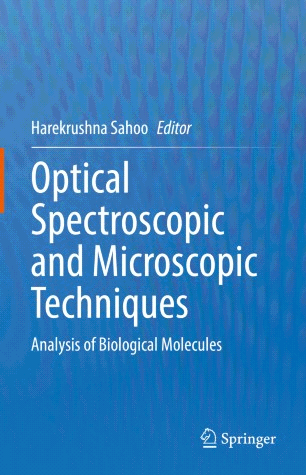
Optical Spectroscopic and Microscopic Techniques. Analysis of Biological Molecules (2022)
Harekrushna Sahoo
Springer
ISBN: 978-981-16-4550-1 260 Pages
Publisher Description: This book illustrates the significance of various optical spectroscopy and microscopy techniques, including absorption spectroscopy, fluorescence spectroscopy, infrared spectroscopy, and Raman spectroscopy for deciphering the nature of biological molecules. The content of this book chiefly focuses on (1) the principle, theory, and instrumentation used in different optical spectroscopy techniques, and (2) the application of these techniques in exploring the nature of different biomolecules (e.g., proteins, nucleic acids, enzymes, and carbohydrates). It emphasizes the structural, conformational and dynamic, and kinetic including the changes in biomolecules under a range of conditions. In closing, the book summarizes recent advances in the field of optical spectroscopic and microscopic techniques.
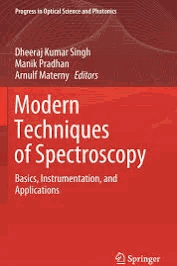
Modern Techniques of Spectroscopy. Basics, Instrumentation, and Applications. (2021)
Dheeraj Kumar Singh, Manik Pradhan, Arnulf Materny (Eds.)
Springer
ISBN: 978-981-33-6083-9 (print)
679 PagesPublisher Description: The book highlights recent developments in the field of spectroscopy by providing the readers with an updated and high-level of overview. The focus of this book is on the introduction to concepts of modern spectroscopic techniques, recent technological innovations in this field, and current examples of applications to molecules and materials relevant for academia and industry. The book will be beneficial to researchers from various branches of science and technology, and is intended to point them to modern techniques, which might be useful for their specific problems. Spectroscopic techniques, that are discussed include, UV-Visible absorption spectroscopy, XPS, Raman spectroscopy, SERS, TERS, CARS, IR absorption spectroscopy, SFG, LIBS, Quantum cascade laser (QCL) spectroscopy, fluorescence spectroscopy, ellipsometry, cavity-enhanced absorption spectroscopy, such as cavity ring-down spectroscopy (CRDS) and evanescent wave-CRDS both in gas and condensed phases, time-resolved spectroscopy etc. Applications introduced in the different chapters demonstrates the usefulness of the spectroscopic techniques for the characterization of fundamental properties of molecules, e.g. in connection with environmental impact, bio-activity, or usefulness for pharmaceutical drugs, and materials important e.g. for nano-science, nuclear chemistry, or bio-applications. The book presents how spectroscopic techniques can help to better understand substances, which have also great impact on questions of social and economic relevance (environment, alternative energy, etc.).
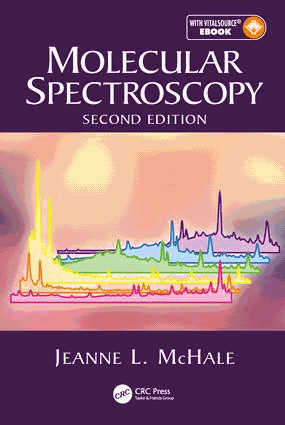
Molecular Spectroscopy. 2nd Ed. (2017)
Jeanne L. McHale
CRC
ISBN (Print) 978-3-319-20780-3 (Online) 475 pages
Publisher Description: This textbook offers an introduction to the foundations of spectroscopic methods and provides a bridge between basic concepts and experimental applications in fields as diverse as materials science, biology, solar energy conversion, and environmental science. The author emphasizes the use of time-dependent theory to link the spectral response in the frequency domain to the behavior of molecules in the time domain, strengthened by two brand new chapters on nonlinear optical spectroscopy and time-resolved spectroscopy. Theoretical underpinnings are presented to the extent necessary for readers to understand how to apply spectroscopic tools to their own interests.
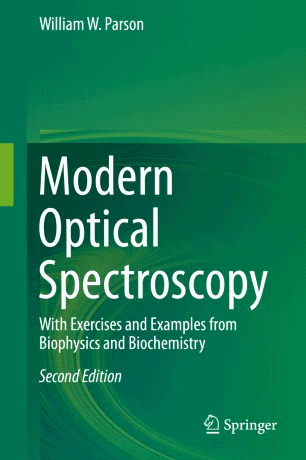
Modern Optical Spectroscopy. 2nd Ed. (2015)
William W. Parson
Springer
ISBN 978-3-662-46776-3 (print) 572 Pages
Publisher Description: This textbook offers clear explanations of optical spectroscopic phenomena and shows how spectroscopic techniques are used in modern molecular and cellular biophysics and biochemistry. The topics covered include electronic and vibrational absorption, fluorescence, resonance energy transfer, exciton interactions, circular dichroism, coherence and dephasing, ultrafast pump-probe and photon-echo spectroscopy, single-molecule and fluorescence-correlation spectroscopy, Raman scattering, and multiphoton absorption. This revised and updated edition provides expanded discussions of quantum optics, metal-ligand charge-transfer transitions, entropy changes during photoexcitation, electron transfer from excited molecules, normal-mode calculations, vibrational Stark effects, studies of fast processes by resonance energy transfer in single molecules, and two-dimensional electronic and vibrational spectroscopy. The explanations are sufficiently thorough and detailed to be useful for researchers and graduate students and advanced undergraduates in chemistry, biochemistry and biophysics. They are based on time-dependent quantum mechanics, but are developed from first principles with a clarity that makes them accessible to readers with little prior training in this field. Extra topics and highlights are featured in special boxes throughout the text. The author also provides helpful exercises for each chapter.
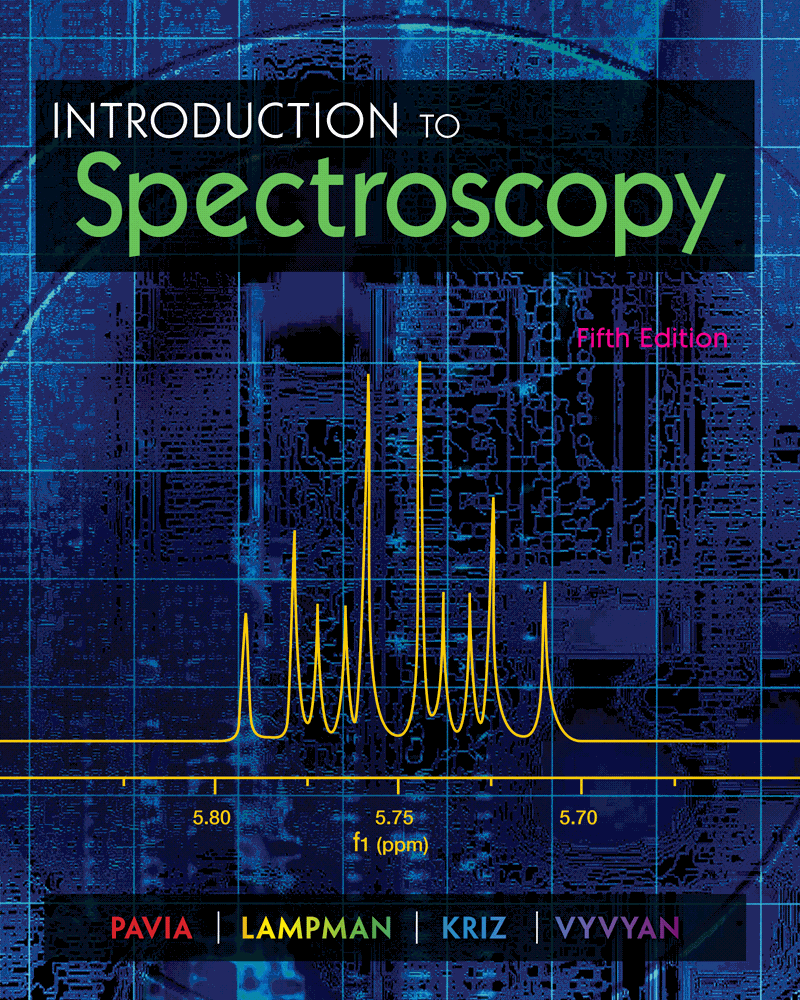
Donald L. Pavia
, Gary M. Lampman, George S. Kriz, James A. VyvyanCengage
ISBN 9781118028698
467 PagesPublisher Description:
Introduce your students to the latest advances in spectroscopy with the text that has set the standard in the field for more than three decades: INTRODUCTION TO SPECTROSCOPY, 5e, by Donald L. Pavia, Gary M. Lampman, George A. Kriz, and James R. Vyvyan. Whether you use the book as a primary text in an upper-level spectroscopy course or as a companion book with an organic chemistry text, your students will receive an unmatched, systematic introduction to spectra and basic theoretical concepts in spectroscopic methods. This acclaimed resource features up-to-date spectra; a modern presentation of one-dimensional nuclear magnetic resonance (NMR) spectroscopy; an introduction to biological molecules in mass spectrometry; and coverage of modern techniques alongside DEPT, COSY, and HECTOR.

Handbook of Spectroscopy. 2nd Ed. (2014)
Günter Gauglitz, David S. Moore (Eds.)
Wiley
ISBN 9783527321506 1878 Pages
Publisher Description: This second, thoroughly revised, updated and enlarged edition provides a straightforward introduction to spectroscopy, showing what it can do and how it does it, together with a clear, integrated and objective account of the wealth of information that may be derived from spectra. It also features new chapters on spectroscopy in nano-dimensions, nano-optics, and polymer analysis.
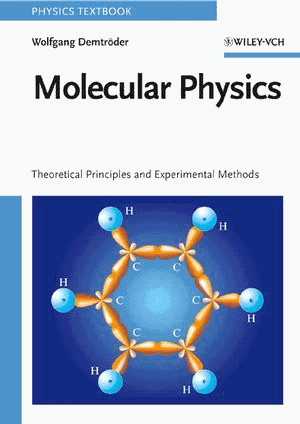
Molecular Physics: Theoretical Principles and Experimental Methods (2008)
Wolfgang Demtröder
Wiley
ISBN 978-3-527-61810-1 484 Pages
Publisher Description: The richly illustrated book comprehensively explains the important principles of diatomic and polyatomic molecules and their spectra in two separate, distinct parts. The first part concentrates on the theoretical aspects of molecular physics, such as the vibration, rotation, electronic states, potential curves, and spectra of molecules. The different methods of approximation for the calculation of electronic wave functions and their energy are also covered. The introduction of basics terms used in group theory and their meaning in molecular physics enables an elegant description of polyatomic molecules and their symmetries. Molecular spectra and the dynamic processes involved in their excited states are given its own chapter. The theoretical part then concludes with a discussion of the field of Van der Waals molecules and clusters.The second part is devoted entirely to experimental techniques, such as laser, Fourier, NMR, and ESR spectroscopies, used in the fields of physics, chemistry, biology, and material science. Time-resolved measurements and the influence of chemical reactions by coherent controls are also treated. A list of general textbooks and specialized literature is provided for further reading.
Back To TOP
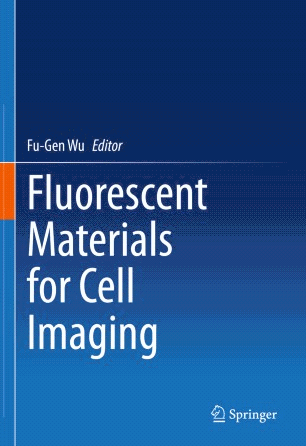
Fluorescent Materials for Cell Imaging (2020)
Springer
ISBN 978-981-15-5062-1
247 pagesPublisher Description: This book focuses on the latest fluorescent materials for cell imaging. Cell imaging is a widely used basic technique that helps scientists gain a better understanding of biological functions through studies of cellular structure and dynamics. In the past decades, the development of a variety of new fluorescent materials has significantly extended the applications of cellular imaging techniques. This book presents recently developed fluorescent materials, including semiconductor quantum dots, carbon dots, silicon nanoparticles, metal nanoclusters, upconversion nanoparticles, conjugated polymers/polymer dots, aggregation-induced emission (AIE) probes, and coordination compounds, used for various cellular imaging purposes. It will appeal to cell biologists and other researchers in academia, industry and clinical settings who are interested in the technical development and advanced applications of fluorescence imaging in cells, tissues and organisms to explore the mechanisms of biological functions and diseases.
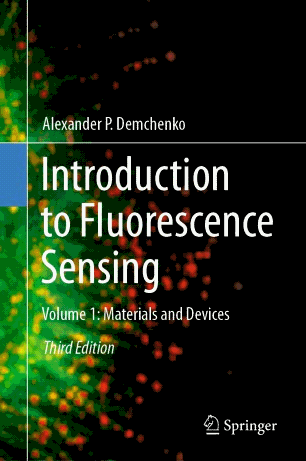
Introduction to Fluorescence Sensing. 3rd Ed. Volume 1: Materials and Devices (2020)
Springer
ISBN 978-3-030-60154-6
657 pagesPublisher Description: This book provides systematic knowledge of basic principles in the design of fluorescence sensing and imaging techniques together with critical analysis of recent developments. Fluorescence is the most popular technique in chemical and biological sensing because of its ultimate sensitivity, high temporal and spatial resolution and versatility that enables imaging within the living cells. It develops rapidly in the directions of constructing new molecular recognition units, new fluorescence reporters and in improving sensitivity of response up to detection of single molecules. Its application areas range from control of industrial processes to environment monitoring and clinical diagnostics. Being a guide for students and young researchers, it also addresses professionals involved in active basic and applied research. Making a strong link between education, research and product development, this book discusses prospects for future progress.
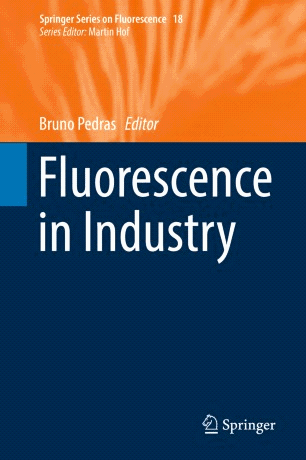
Springer
ISBN 978-3-030-20032-9 419 pages
Publisher Description: This book gathers 12 outstanding contributions that reflect state-of-the-art industrial applications of fluorescence, ranging from the pharmaceutical and cosmetics industries to explosives detection, aeronautics, instrumentation development, lighting, photovoltaics, water treatment and much more. In the field of fluorescence, the translation of research into important applications has expanded significantly over the past few decades. The 18th volume in the Springer Series on Fluorescence fills an important gap by focusing on selected industrial applications of fluorescence, described in contributions by both industry-based researchers and academics engaged in collaborations with industrial partners.

Fluorescent Tools for Imaging Oxidative Stress in Biology (Springer Thesis) (2018)
Springer Thesis
ISBN 978-3-319-73404-0
230 pagesPublisher Description: This thesis advances the long-standing challenge of measuring oxidative stress and deciphering its underlying mechanisms, and also outlines the advantages and limitations of existing design strategies. It presents a range of approaches for the chemical synthesis of fluorescent probes that detect reversible changes in cellular oxidative stress. The ability to visualise cellular processes in real-time is crucial to understanding disease development and streamline treatment, and this can be achieved using fluorescent tools that can sense reversible disturbances in cellular environments during pathogenesis. The perturbations in cellular redox state are of particular current interest in medical research, since oxidative stress is implicated in the pathogenesis of a number of diseases. The book investigates different strategies used to achieve ratiometric fluorescence output of the reversible redox probes, which nullify concentration effects associated with intensity-based probes. It also describes suitable approaches to target these probes to specific cellular organelles, thereby enabling medical researchers to visualise sub-cellular oxidative stress levels, and addressing the typically poor uptake of chemical tools into biological studies. In total it reports on four new probes that are now being used by over twenty research groups around the globe, and two of which have been commercialised. The final chapters of this thesis demonstrate successful applications of the sensors in a variety of biological systems ranging from prokaryotes to mammalian cells and whole organisms. The results described clearly indicate the immense value of collaborative, cross-disciplinary research.
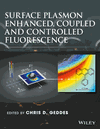
Surface Plasmon Enhanced, Coupled and Controlled Fluorescence (2017)
Chris D. Geddes (Ed.)
Wiley
ISBN 9781118027936
331 PagesPublisher Description: Explains the principles and current thinking behind plasmon enhanced Fluorescence. Describes the current developments in Surface Plasmon Enhanced, Coupled and Controlled Fluorescence. Details methods used to understand solar energy conversion, detect and quantify DNA more quickly and accurately, and enhance the timeliness and accuracy of digital immunoassays Contains contributions by the world’s leading scientists in the area of fluorescence and plasmonics Describes detailed experimental procedures for developing both surfaces and nanoparticles for applications in metal-enhanced fluorescence.
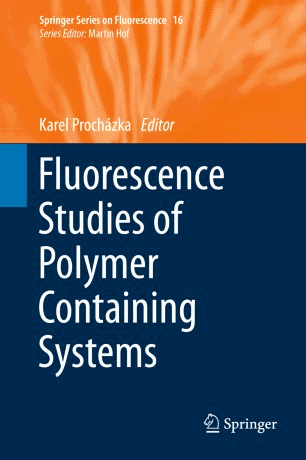
Fluorescence Studies of Polymer Containing Systems (2016)
Springer
ISBN 978-3-319-26786-9
302 pagesPublisher Description: This volume describes the application of fluorescence spectroscopy in polymer research. The first chapters outline the basic principles of the conformational and dynamic behavior of polymers and review the problems of polymer self-assembly. Subsequent chaptersintroduce the theoretical principles of advanced fluorescence methods and typical examples of their application in polymer science. The book closes withseveral reviews of various fluorescence applications for studying specific aspects of polymer-solution behavior. It is a useful resource for polymer scientists and experts in fluorescence spectroscopy alike, facilitating their communication and cooperation.

Handbook of Fluorescent Dyes and Probes. (2015)
R. W. Sabnis
Wiley
ISBN 9781118028698
446 PagesPublisher Description: Handbook of Fluorescent Dyes and Probes is the most comprehensive volume available on the subject, covering all the available dyes and probes known to date in the literature for uses in various fields. Top dye expert Dr. Ram Sabnis organizes the compounds alphabetically by the most commonly used chemical name. He presents an easy-to-use reference complete with novel ideas for breakthrough research in medical, biological, chemical, color, material, physical and related allied fields. The ease of use of the handbook is further enhanced by various appendixes provided at the end of the book to conveniently and easily locate the dye as per the reader's need. This is the first book to give the CAS registry numbers, chemical structure, Chemical Abstract (CA) index name, all other chemical names, Merck Index number, chemical/dye class, molecular formula, molecular weight, physical form, solubility, melting point, boiling point, pKa, absorption maxima, emission maxima, molar extinction coefficient, and quantum yield of fluorescent dyes and probes, as well as to provide access to synthetic procedures (lab scale and industrial scale) of dyes and probes in a single source. This user-friendly handbook also features references on safety, toxicity and adverse effects of dyes and probes on humans, animals and the environment. Containing imaging/labeling applications, biological/medical applications and industrial applications, Handbook of Fluorescent Dyes and Probes is a convenient, vital resource for industrial and academic researchers, and a valuable desktop reference for medical professionals, lab supervisors, scientists, chemists, biologists, engineers, physicists, intellectual property professionals, students, and professors. Includes all fluorescent dyes & probes known to date and provides a complete, up-to-date library of information in one reference/handbook Includes more than 300 fluorescent dyes & probes organized alphabetically by the commonly used Chemical Name Provides access to synthesis procedures (lab scale and industrial scale) of fluorescent dyes & probes First book to provide references on safety, toxicity and adverse effects of fluorescent dyes and probes on humans, animals, and the environment User-friendly and convenient resource guide for chemical, biological, medical, and intellectual property professionals in a broad range of disciplines.
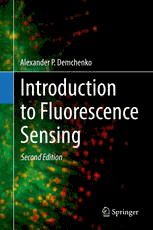
Introduction to Fluorescence Sensing. 2nd Ed. (2015)
Alexander P. Demchenko
Springer
ISBN 978-3-319-20779-7 (Print) 978-3-319-20780-3 (Online) 954 pages
Publisher Description: Fluorescence is the most popular technique in chemical and biological sensing and this book provides systematic knowledge of basic principles in the design of fluorescence sensing and imaging techniques together with critical analysis of recent developments. Its ultimate sensitivity, high temporal and spatial resolution and versatility enables high resolution imaging within living cells. It develops rapidly in the directions of constructing new molecular recognition units, new fluorescence reporters and in improving sensitivity of response, up to the detection of single molecules. Its application areas range from the control of industrial processes to environmental monitoring and clinical diagnostics. Being a guide for students and young researchers, it also addresses professionals involved in basic and applied research. Making a strong link between education, research and product development, this book discusses prospects for future progress.
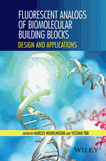
Fluorescent Analogs of Biomolecular Building Blocks. Design and Applications (2016) (2014)
Marcus Wilhelmsson, Yitzhak Tor (Eds.)
Wiley
ISBN 978‐1118175866 448 Pages
Publisher Description: This book provides a thorough overview on the design and application of fluorescent analogs of biomolecular building blocks—namely amino acids, lipids, and nucleosides—with selected topics elaborated in individual chapters. Evidencing the improvement in an interdisciplinary field of research and development, it comprises knowledge of chemistry, biology, and physics, to those who design, develop, and apply fluorescent molecules in order to study a particular property or situation in biological materials by means of fluorescence techniques. The preface of the book is very well written, encouraging the curiosity of the reader and showing the sequence/linkage between the different topics covered in the various chapters of the book. The use of fluorescence techniques is an increasingly promising alternative to other techniques in several fields. Despite the development in recent years, research in this area is important and continues to deserve huge prominence today, as it can be seen by the vast number of research papers currently published. The way the book is written makes reading enjoyable and relatively easy for readers who already have some knowledge on the subject as well as for beginners. The book presents seventeen chapters with different lengths, which should serve as a quick introduction to a particular subject, leading to recent results, with an adequate survey of relevant literature. This book can be used by readers with a main background in chemistry, physics, biology, or interface areas to start acquiring knowledge in the field considered, and it can help senior readers to update knowledge in this area. Overall, the book is very well achieved, and I strongly recommend reading.
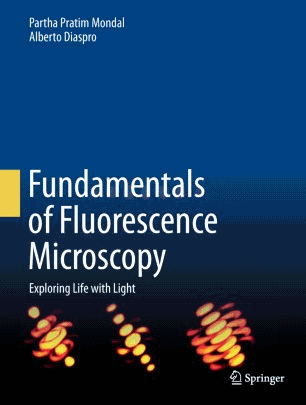
Fundamentals of Fluorescence Microscopy. Exploring Life with Light (2014)
Partha Pratim Mondal
,Alberto DiasproSpringer
ISBN 978-94-007-7544-2 218 pages
Publisher Description: This book starts at an introductory level and leads reader to the most advanced developments in fluorescence imaging and super-resolution techniques that have enabled the emergence of new disciplines such as nanobioimaging, multiphoton microscopy, photodynamic therapy, nanometrology and nanosensors. The interdisciplinary subject of fluorescence microscopy and imaging requires complete knowledge of imaging optics and molecular physics. So, this book approaches the subject by introducing optical imaging concepts before going deep into the advanced imaging systems and their applications. Molecular orbital theory forms the basis for understanding fluorescent molecules and thereby facilitates complete explanation of light-matter interaction at the geometrical focus. The two disciplines have some overlap since light controls the states of molecules and conversely, molecular states control the emitted light. These two mechanisms together determine essential fluorescence factors and phenomena such as, molecular cross-section, Stokes shift, emission and absorption spectra, quantum yield, signal-to-noise ratio, Forster resonance energy transfer (FRET), fluorescence recovery after photobleaching (FRAP) and fluorescence lifetime. These phenomena form the basis of many fluorescence based devices. The book is organized into two parts. The first part deals with basics of imaging optics and its applications. The advanced part covers many imaging techniques and related instrumentation that are developed in the last decade pointing towards far-field diffraction limited and unlimited imaging.

Molecular Fluorescence: Principles and Applications. 2nd Ed. (2012)
Bernard Valeur, Mário Nuno Berberan‐Santos
Wiley
ISBN 9783527328376 281 Pages
Publisher Description: This
second edition of the well-established bestseller is completely updated and
revised with approximately 30 % additional material, including two new chapters
on applications, which has seen the most significant developments.
The comprehensive overview written at an introductory level covers fundamental
aspects, principles of instrumentation and practical applications, while
providing many valuable tips.
For photochemists and photophysicists, physical chemists, molecular physicists,
biophysicists, biochemists and biologists, lecturers and students of chemistry,
physics, and biology.
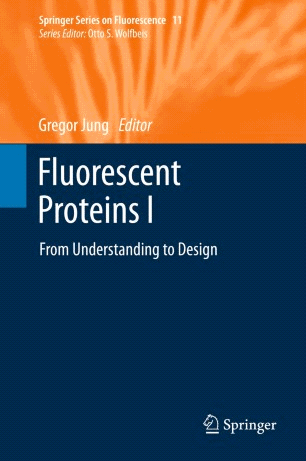
Fluorescent Proteins I. From Understanding to Design (2012)
Springer
ISBN 978-3-642-23371-5
268 pagesPublisher Description: Fluorescent proteins are intimately connected to research in the life sciences. Tagging of gene products with fluorescent proteins has revolutionized all areas of biosciences, ranging from fundamental biochemistry to clinical oncology, to environmental research. The discovery of the Green Fluorescent Protein, its first, seminal application and the ingenious development of a broad palette of fluorescence proteins of other colours, was consequently recognised with the Nobel Prize for Chemistry in 2008. Fluorescent Proteins I is devoted to the basic photophysical and photochemical aspects of fluorescent protein technology. Experienced experts highlight colour tuning, the exploration of switching phenomena and respective methods for their investigation. The book provides a thorough understanding of primary molecular processes allowing the design of fluorescent proteins for specific applications.
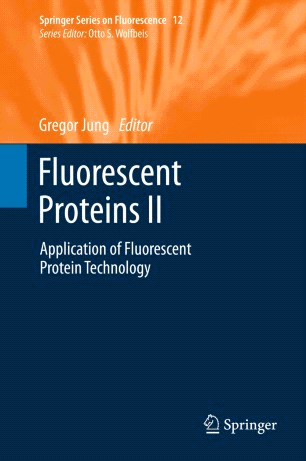
Springer
ISBN 978-3-642-23376-0 2
84 pagesPublisher Description: Fluorescent proteins are intimately connected to research in the life sciences. Tagging of gene products with fluorescent proteins has revolutionized all areas of biosciences, ranging from fundamental biochemistry to clinical oncology, to environmental research. The discovery of the Green Fluorescent Protein, its first, seminal application and the ingenious development of a broad palette of fluorescence proteins of other colours, was consequently recognised with the Nobel Prize for Chemistry in 2008. Fluorescent Proteins II highlights the physicochemical and biophysical aspects of fluorescent protein technology beyond imaging. It is tailored to meet the needs of physicists, chemists and biologists who are interested in the fundamental properties of fluorescent proteins, while also focussing on specific applications. The implementations described are cutting-edge studies and exemplify how the physical and chemical properties of fluorescent proteins can stimulate novel findings in life sciences.

Molecular Fluorescence: Principles and Applications. 2nd Ed. (2012)
Bernard Valeur
, Mário Nuno Berberan‐SantosWiley
ISBN 9783527328376
281 PagesPublisher Description:
This second edition of the well-established bestseller is completely updated and revised with approximately 30 % additional material, including two new chapters on applications, which has seen the most significant developments.
 Handbook
of Fluorescence Spectroscopy and Imaging: From Single Molecules to Ensembles.
(2011)
Handbook
of Fluorescence Spectroscopy and Imaging: From Single Molecules to Ensembles.
(2011)
Markus Sauer
, Johan Hofkens, Jörg EnderleinWiley
ISBN 9783527316694 569 Pages
Publisher Description:
Providing much-needed information on fluorescence spectroscopy and microscopy, this ready reference covers detection techniques, data registration, and the use of spectroscopic tools, as well as new techniques for improving the resolution of optical microscopy below the resolution gap. Starting with the basic principles, the book goes on to treat fluorophores and labeling, single-molecule fluorescence spectroscopy and enzymatics, as well as excited state energy transfer, and super-resolution fluorescence imaging. Examples show how each technique can help in obtaining detailed and refined information from individual molecular systems.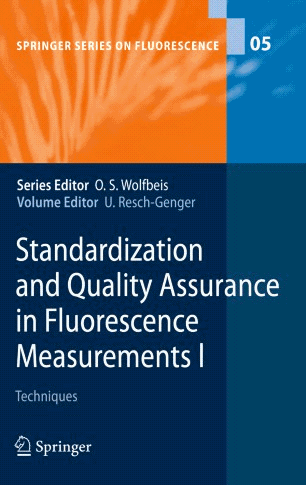
Standardization and Quality Assurance in Fluorescence Measurements I: Techniques (2008)
(Ed.)
Springer
ISBN 978-3-642-09447-7 496 pages
Publisher Description:
The validation and standardization of fluorescence methods is still in its infancy as compared to other prominent analytical and bioanalytical methods. Appropriate quality assurance standards are however a prerequisite for applications in highly regulated fields such as medical diagnostics, drug development, or food analysis. For the first time, a team of recognized international experts has documented the present status of quality assurance in fluorescence measurements, and outlines concepts for establishing standards in this field. This first of two volumes covers basic aspects and various techniques such as steady-state and time-resolved fluorometry, polarization techniques, and fluorescent chemical sensors.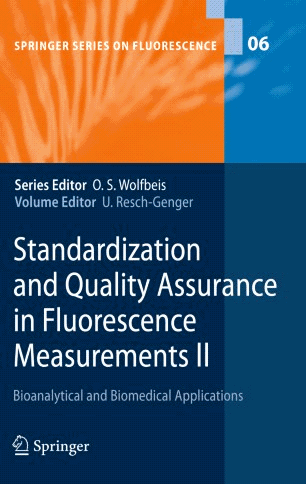
(Ed.)
Springer
ISBN 978-3-540-70570-3 564 pages
Publisher Description:
The validation and standardization of fluorescence methods is still in its infancy as compared to other prominent analytical and bioanalytical methods. Appropriate quality assurance standards are however a prerequisite for applications in highly regulated fields such as medical diagnostics, drug development, or food analysis. For the first time, a team of recognized international experts has documented the present status of quality assurance in fluorescence measurements, and outlines concepts for establishing standards in this field. This second of two volumes covers applications of fluorescence for bioanalysis and biomedical diagnostics.
Principles of Fluorescence Spectroscopy. 3rd Ed. (2006)
Joseph R. Lakowicz (Ed.)
Springer
ISBN 978-0-387-31278-1 954 pages
Publisher Description: The third edition of the established classic text reference, Principles of Fluorescence Spectroscopy, will enhance upon the earlier editions' successes. Organized as a textbook for the learning student or the researcher needing to acquire the core competencies, Principles of Fluorescence Spectroscopy, 3e will maintain the emphasis on basics, while updating the examples to include recent results from the literature. The third edition also includes new chapters on single molecule detection, fluorescence correlation spectroscopy, novel probes and radiative decay engineering.
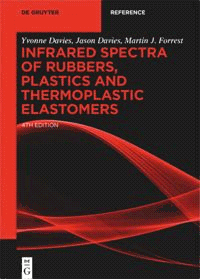
Infrared Spectra of Rubbers, Plastics and Thermoplastic Elastomers, 4th Ed. (2020)
De Gruyter
ISBN 3110644088 444 Pages
Publisher Description: This handbook collects over 800 infrared spectra of rubbers, plastics and thermoplastics elastometers. It contains five different libraries: rubbers in trasmission spectroscopy, rubbers in pyrolysate spectroscopy, plastics in trasmission spectroscopy, plastics in pyrolysate spectroscopy, and rubbers and plastics in single-bounce ATR spectroscopy. This is an invaluable reference for the rubbers and plastics industry.
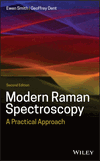
Modern Raman Spectroscopy: A Practical Approach, 2nd Ed (2019)
Ewen Smith Geoffrey Dent
Wiley
ISBN 9781119440550 241 Pages
Publisher Description:
Completely revised and updated, the second edition of Modern Raman Spectroscopy presents the information needed for clear understanding and application of the technique of Raman Spectroscopy in a range of areas such as pharmaceuticals, forensics, and biology. The authors—noted experts on the topic—reveal how to make full use of the critical information presented and include a wealth of examples of the pitfalls that can be encountered. The text opens with a description of the basic theory to assist readers in making a practical interpretation of Raman Spectra. Chapters include the main equations that are used in order to highlight the theory’s meaning and relevance while avoiding a full mathematical treatment. Modern Raman Spectroscopy provides a firm grounding, combined with a variety of references, from which to approach a more comprehensive study of specific aspects of Raman Spectroscopy.
Introduction to Experimental Infrared Spectroscopy: Fundamentals and Practical Methods (2014)
Mitsuo Tasumi (Editor)
Wiley
ISBN
978-0-470-66567-1 408 PagesPublisher Description: Infrared spectroscopy is generally understood to mean the science of spectra relating to infrared radiation, namely electromagnetic waves, in the wavelength region occurring intermediately between visible light and microwaves. Measurements of infrared spectra have been providing useful information, for a variety of scientific research and industrial studies, for over half a century; this is set to continue in the foreseeable future. Introduction to Experimental Infrared Spectroscopy is intended to be a handy guide for those who have no, or limited, experience in infrared spectroscopic measurements but are utilising infrared-related methods for their research or in practical applications. Written by leading researchers and experienced practitioners, this work consists of 22 chapters and presents the basic theory, methodology and practical measurement methods, including ATR, photoacoustic, IR imaging, NIR, 2D-COS, and VCD. The six Appendices will aid readers in understanding the concepts presented in the main text. Written in an easy-to-understand way this book is suitable for students, researchers and technicians working with infrared spectroscopy and related methods.
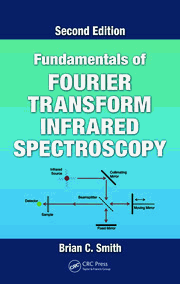
Fundamentals of Fourier Transform Infrared Spectroscopy. 2nd Ed. (2011)
CRC Press
ISBN
207 PagesPublisher Description: Reflecting the myriad changes and advancements in the technologies involved in FTIR, particularly the development of diamond ATRs, this second edition of Fundamentals of Fourier Transform Infrared Spectroscopy has been extensively rewritten and expanded to include new topics and figures as well as updates of existing chapters. Designed for those new to FTIR, but with enough reference material to appeal to journeyman and expert spectroscopists, this book does not demand any extensive familiarity with chemistry or physics. Specializing in concise and comprehensible explanations of FTIR topics, the author introduces the field of infrared spectroscopy, including the strengths and weaknesses of FTIR as a chemical analysis technique. He then describes the instrument itself and explores topics such as how an interferometer generates a spectrum, optimization of spectral quality, and which tests are used to monitor instrument health. The book discusses how to properly use spectral processing to increase the information of a spectrum without damaging the data and takes considerable care in instructing on sample preparation, as good sample preparation constitutes half the battle in extracting good data. The final chapters examine single analyte quantitative analysis and conclude with an overview of infrared microscopy. Drawing on the experience and knowledge of the author as both a professor and practitioner, Fundamentals of Fourier Transform Infrared Spectroscopy offers up-to-date information given in clear, easily understood language to appeal to beginner and expert spectroscopists alike.

Fourier Transform Infrared Spectrometry. 2nd Ed. (2006)
Peter R. Griffiths James A. de Haseth
Wiley
ISBN 9780471194040 535 Pages
Publisher Description: A bestselling classic reference, now expanded and updated to cover the latest instrumentation, methods, and applications.The Second Edition of Fourier Transform Infrared Spectrometry brings this core reference up to date on the uses of FT-IR spectrometers today. The book starts with an in-depth description of the theory and current instrumentation of FT-IR spectrometry, with full chapters devoted to signal-to-noise ratio and photometric accuracy. Many diverse types of sampling techniques and data processing routines, most of which can be performed on even the less expensive instruments, are then described. Extensively updated, the Second Edition.
![]()
Infrared and Raman Characteristic Group Frequencies: Tables and Charts, 3rd Edition (2004)
George Socrates
Wiley
ISBN
978-0-470-09307-8 366 PagesPublisher Description: The third edition of this highly successful manual is not only a revised text but has been extended to meet the interpretive needs of Raman users as well as those working in the IR region. The result is a uniquely practical, comprehensive and detailed source for spectral interpretation. Combining in one volume, the correlation charts and tables for spectral interpretation for these two complementary techniques, this book will be of great benefit to those using or considering either technique. In addition to the new Raman coverage the new edition offers: * new section on macromolecules including synthetic polymers and biomolecules; * expansion of the section on NIR (near infrared region) to reflect recent growth in this area; * extended chapter on inorganic compounds including minerals and glasses; * redrawn and updated charts plus a number of new charts covering data new to this edition. This new edition will be invaluable in every industrial, university, government and hospital laboratory where infrared (FT-IR) and Raman spectral data need to be analysed.
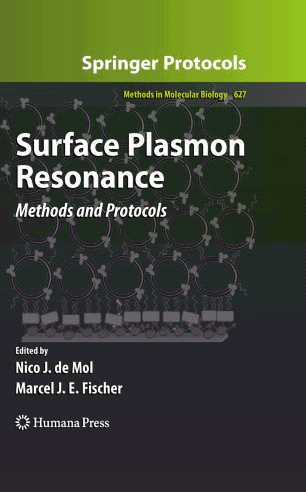
Surface Plasmon Resonance. Methods and Protocols (2010)
Springer
ISBN 978-1-60761-669-6
286 pagesPublisher Description: While commercial instruments have expanded the usage and the related literature has increased, the quality of surface plasmon resonance (SPR) research has been hindered by a lack of knowledge of the processes that influence the SPR signal. In Surface Plasmon Resonance: Methods and Protocols, experts in the field present a wide variety of applications involving commercially available SPR instruments. The heart of the SPR technique is to construct a dedicated surface for an assay. Protocols describe such surfaces for many needs, including the study of membrane bound proteins. Beyond the protocols-based chapters, the volume also highlights the backgrounds of vital issues in the use of SPR, including processes occurring within the hydrogel environment of sensors and on lipid membrane surfaces as well as the analysis of kinetic information. Written in the highly successful Methods in Molecular Biology™ series format, chapters include introductions to their respective topics, lists of the necessary materials and reagents, step-by-step, readily reproducible protocols, and notes on troubleshooting and avoiding known pitfalls.
 A
Practical Guide to Magnetic Circular Dichroism Spectroscopy (2006)
A
Practical Guide to Magnetic Circular Dichroism Spectroscopy (2006)
W. Roy Mason
Wiley
ISBN
9780470069783 223 PagesPublisher Description:
The book is a technical guide for chemists and spectroscopists, and presents a concise description of magnetic circular dichroism (MCD) spectroscopy and how it has advanced the interpretation of molecular electronic spectra.
X-Ray Spectrometry: Recent Technological Advances (2004)
Tsuji,Injuk,Van Grieken
Wiley
ISBN 9780471486404 603 Pages
Publisher Description: Covers the latest developments and areas of research in the methodological and instrumental aspects of x-ray spectrometry.* Includes the most advanced and high-tech aspects of the chemical analysis techniques based on x-rays * Introduces new types of X-ray optics and X-ray detectors, covering history, principles, characteristics and future trends * Written by internationally recognized scientists, all of whom are eminent specialists in each of the sub-fields * Sections include: X-Ray Sources, X-Ray Optics, X-Ray Detectors, Special Configurations, New Computerization Methods, New Applications.
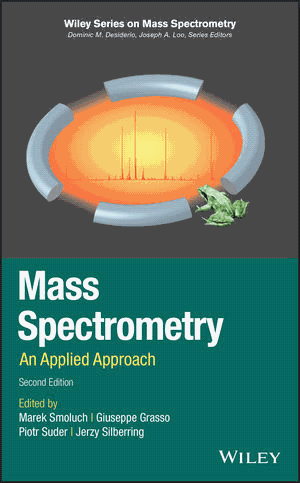
Mass Spectrometry: An Applied Approach, 2nd Edition (2019) (Knovel)
Marek Smoluch, Giuseppe Grasso, Piotr Suder, Jerzy Silberring (Eds)
Wiley
ISBN978-1-119-37730-6
448 pagesPublisher Description: Provides a comprehensive description of mass spectrometry basics, applications, and perspectives. Mass spectrometry is a modern analytical technique, allowing for fast and ultrasensitive detection and identification of chemical species. It can serve for analysis of narcotics, counterfeit medicines, components of explosives, but also in clinical chemistry, forensic research and anti-doping analysis, for identification of clinically relevant molecules as biomarkers of various diseases. This book describes everything readers need to know about mass spectrometry—from the instrumentation to the theory and applications. It looks at all aspects of mass spectrometry, including inorganic, organic, forensic, and biological MS (paying special attention to various methodologies and data interpretation). It also contains a list of key terms for easier and faster understanding of the material by newcomers to the subject and test questions to assist lecturers.
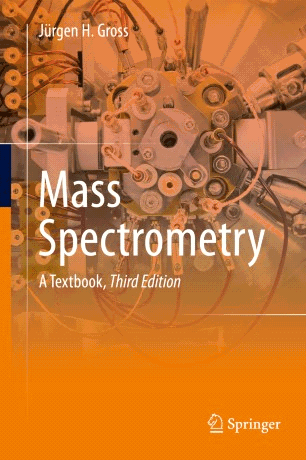
Mass Spectrometry. A Textbook, 3rd Ed (2017)
Springer
ISBN 978-3-319-54397-0
233 pagesPublisher Description: This third edition of the highly successful textbook, acclaimed for its comprehensiveness, accuracy, and excellent illustrations and photographs now comes with updated coverage plus numerous didactical improvements: The number of figures has notably increased, with about one third of them now presented in color. More photographs and schematics make it easier to understand and provide valuable insights into the practical aspects of instrumentation and procedures. Flow charts describe procedures and approaches to mass spectral interpretation and aid in decision making. Bulleted enumerations offer a quick overview wherever several features, arguments, assumptions, or properties of a subject call for clear presentation. Examples and notes now come with a short subheading that immediately conveys what this section is about. More examples, especially of methods and applications are given and some how-to-style paragraphs provide practical guidance. Each chapter ends with a concise summary that is subdivided into compact sections highlighting the basics of the subject, its figures of merit, typical applications, and its role in current mass spectromety. In the case of instrumentation (chapter 4), there are even summaries covering mass analyzers type by type. Digital object identifiers (DOIs) are now included to facilitate retrieval of references. All of this is presented in a new, attractive layout
.
The HPLC‐MS Handbook for Practitioners (2017)
Stavros Kromidas
Wiley
ISBN
9783527343072 448 pagesPublisher Description: Filling the gap for an expert text dealing exclusively with the practical aspects of HPLC-MS coupling, this concise, compact, and clear book provides detailed information to enable users to employ the method most efficiently. Following an overview of the current state of HPLC-MS and its instrumentation, the text goes on to discuss all relevant aspects of method development. A chapter on tips and tricks is followed by user reports on the advantages - and pitfalls - of applying the method in real-life scenarios. The whole is rounded off by a look at future developments by renowned manufacturers.

Hans‐Joachim Hübschmann
Wiley
ISBN 783527334742
863 pagesPublisher Description: The only comprehensive reference on this popular and rapidly developing technique provides a detailed overview, ranging from fundamentals to applications, including a section on the evaluation of GC-MS analyses. As such, it covers all aspects, including the theory and principles, as well as a broad range of real-life examples taken from laboratories in environmental, food, pharmaceutical and clinical analysis. It also features a glossary of approximately 300 terms and a substance index that facilitates finding a specific application. The first two editions were very well received, making this handbook a must-have in all analytical laboratories using GC-MS.
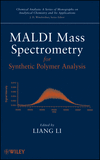
Maldi Mass Spectrometry for Synthetic Polymer Analysis (2009)
Liang Li (Ed.)
Wiley
ISBN 9780471775799
305 pagesPublisher Description: Principles and Practices of Polymer Mass Spectrometry helps readers acquire the skills necessary for selecting the optimal methods, handling samples, analyzing the data, and interpreting the results of the mass spectrometry of polymers. This guide describes the principles of polymer MS and best practices in polymer characterization. It discusses different approaches, including MALDI, ESI, TOF MS, and FT-MS. It provides a guide to developing appropriate sample preparation protocols for different polymers. Complete with examples of applications and experiments, this is an excellent reference for scientists, researchers, graduate students, and others.

MALDI-TOF Mass Spectrometry of Synthetic Polymers (2003)
Pasch, Harald, Schrepp, Wolfgang
Springer
ISBN 978-3-540-44259-2 299 pages
Publisher Description: MALDI-TOF mass spectrometry is one of the latest and most fascinating new developments in the analysis of organic compounds. Originally developed for the analysis of biomolecules, it has developed into one of the most powerful techniques for the characterization of synthetic polymers. This book describes the fundamentals of the MALDI process and the technical features of MALDI-TOF instrumentation. It reviews the application of MALDI-TOF for identification, chemical and molar mass analysis of synthetic polymers.
Experimental protocols for the determination of endgroups, the analysis of homo- and copolymers, and the coupling of liquid chromatography and MALDI-TOF are discussed in detail.

Light Scattering from Polymer Solutions and Nanoparticle Dispersions (2007)
Schärtl, Wolfgang
Springer
ISBN 978-3-540-71950-2 191 pages
Publisher Description: Light scattering is a very powerful method for characterizing the structure of polymers and nanoparticles in solution. Recent technical developments have broadened the possible practical applications of this technique, overcoming earlier limitations such as sample turbidity and insufficient experimental time scales. Until this volume, despite their importance, these new developments have not yet been presented in a comprehensive form. In addition, and perhaps more significantly to the broad audience, this book provides a much-needed accessible introduction for students and non-experts interested in the basic principles and fundamental techniques of light scattering. As part of the Springer Laboratory series, this book provides a simple-to-read and illustrative textbook probing the seemingly very complicated topic of light scattering from polymers and nanoparticles in dilute solution, and goes further to cover some of the latest technical developments in experimental light scattering.
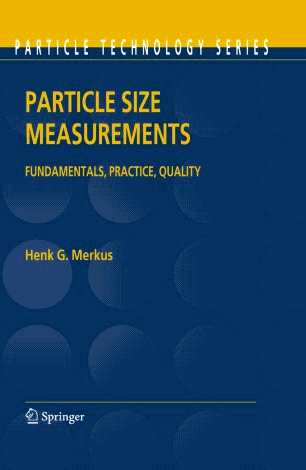
Particle Size Measurements. Fundamentals, Practice, Quality (2009)
Springer
ISBN 978-1-4020-9015-8
410 pagesPublisher Description: This book focuses on the practical aspects of particle size measurement: a major difference with existing books, which have a more theoretical approach. Of course, the emphasis still lies on the measurement techniques. For optimum application, their theoretical background is accompanied by quantitative quality aspects, limitations and problem identification. In addition the book covers the phenomena of sampling and dispersion of powders, either of which may be dominant in the overall analysis error. Moreover, there are chapters on the general aspects of quality for particle size analysis, quality management, reference materials and written standards, in- and on-line measurement, definitions and multilingual terminology, and on the statistics required for adequate interpretation of results. Importantly, a relation is made to product performance, both during processing as well as in final application. In view of its set-up, this book is well suited to support particle size measurement courses.
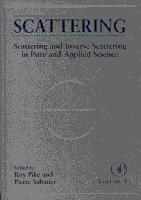
Scattering. Scattering and Inverse Scattering in Pure and Applied Science. (2001)
Roy Pike and Pierre Sabatier
Academic Press
ISBN 978-0-12-613760-6
1831 pagesPublisher Description: Scattering is the collision of two objects that results in a change of trajectory and energy. For example, in particle physics, such as electrons, photons, or neutrons are "scattered off" of a target specimen, resulting in a different energy and direction. In the field of electromagnetism, scattering is the random diffusion of electromagnetic radiation from air masses is an aid in the long-range sending of radio signals over geographic obstacles such as mountains. This type of scattering, applied to the field of acoustics, is the spreading of sound in many directions due to irregularities in the transmission medium. Volume I of Scattering will be devoted to basic theoretical ideas, approximation methods, numerical techniques and mathematical modeling. Volume II will be concerned with basic experimental techniques, technological practices, and comparisons with relevant theoretical work including seismology, medical applications, meteorological phenomena and astronomy. This reference will be used by researchers and graduate students in physics, applied physics, biophysics, chemical physics, medical physics, acoustics, geosciences, optics, mathematics, and engineering. This is the first encyclopedic-range work on the topic of scattering theory in quantum mechanics, elastodynamics, acoustics, and electromagnetics. It serves as a comprehensive interdisciplinary presentation of scattering and inverse scattering theory and applications in a wide range of scientific fields, with an emphasis, and details, up-to-date developments. Scattering also places an emphasis on the problems that are still in active current research..
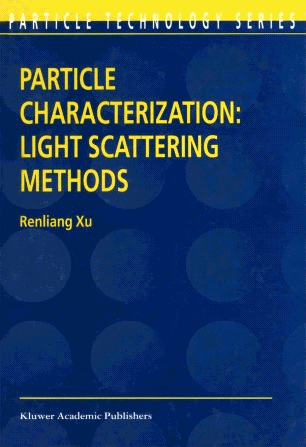
Particle Characterization: Light Scattering Methods (2000)
Kluwer
ISBN 978-0-7923-6300-2 410 pages
Publisher Description: Particle characterization is an important component in product research and development, manufacture, and quality control of particulate materials and an important tool in the frontier of sciences, such as in biotechnology and nanotechnology. This book systematically describes one major branch of modern particle characterization technology - the light scattering methods. This is the first monograph in particle science and technology covering the principles, instrumentation, data interpretation, applications, and latest experimental development in laser diffraction, optical particle counting, photon correlation spectroscopy, and electrophoretic light scattering. In addition, a summary of all major particle sizing and other characterization methods, basic statistics and sample preparation techniques used in particle characterization, as well as almost 500 latest references are provided. The book is a must for industrial users of light scattering techniques characterizing a variety of particulate systems and for undergraduate or graduate students who want to learn how to use light scattering to study particular materials, in chemical engineering, material sciences, physical chemistry and other related fields.
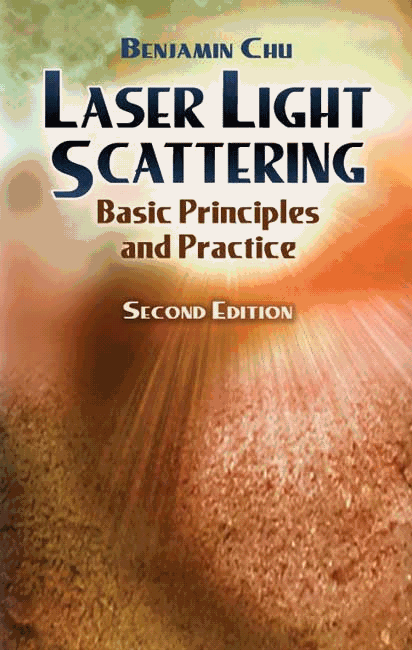
Laser Light Scattering: Basic Principles and Practice. 2nd Ed. (1991) (Dover 2007)
Elsevier (Dover)
ISBN: 9780486457987 (Dover Print) 368 pages
Publisher Description: Geared toward upper-level undergraduate and graduate students, this text introduces the interdisciplinary area of laser light scattering. It focuses chiefly on quasielastic laser scattering, discussing theoretical concepts at a realistic level. Some background in the physical sciences is assumed, but the opening chapters offer a brief review of classical electricity and magnetism as well as the general scattering theory. Topics include basic theoretical concepts related to light mixing spectroscopy, characteristics of the Fabry-Perot interferometer, and photon-counting fluctuations. The author, a distinguished professor in the Department of Chemistry at Stony Brook University, discusses experimental methods, including setting up a light scattering spectrometer using digital photon-counting and correlation techniques. Subsequent chapters explore applications to macromolecular systems, anemometry and its utility in reaction kinetics, and critical opalescence. References appear throughout the text.
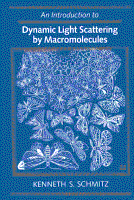
An Introduction to Dynamic Light Scattering by Macromolecules (1990)
Kenneth S. Schmitz
Academic Press
ISBN 978-0-12-627260-4 472 pages
Publisher Description: An Introduction to Dynamic Light Scattering by Macromolecules provides an introduction to the basic concepts of dynamic light scattering (DLS), with an emphasis on the interpretation of DLS data. It presents the appropriate equations used to interpret DLS data. The material is presented in order of increasing complexity of the systems under examination, ranging from dilute solutions of noninteracting particles to concentrated multicomponent solutions of strongly interacting particles and gels. Problems are presented at the end of each chapter to emphasize these concepts. Since a major emphasis of this textbook is the interpretation of DLS data obtained by polarized light scattering studies on macromolecular solutions, the results of complementary experimental techniques are also presented in order to gain insight into the dynamics of these systems. This textbook is intended for (1) advanced undergraduate students and graduate students in the chemical, physical, and biological sciences; (2) scientists who might wish to apply DLS methods to systems of interest to them but who have no formal training in the field of DLS; and (3) those who are simply curious as to the type of information that might be obtained from DLS techniques.
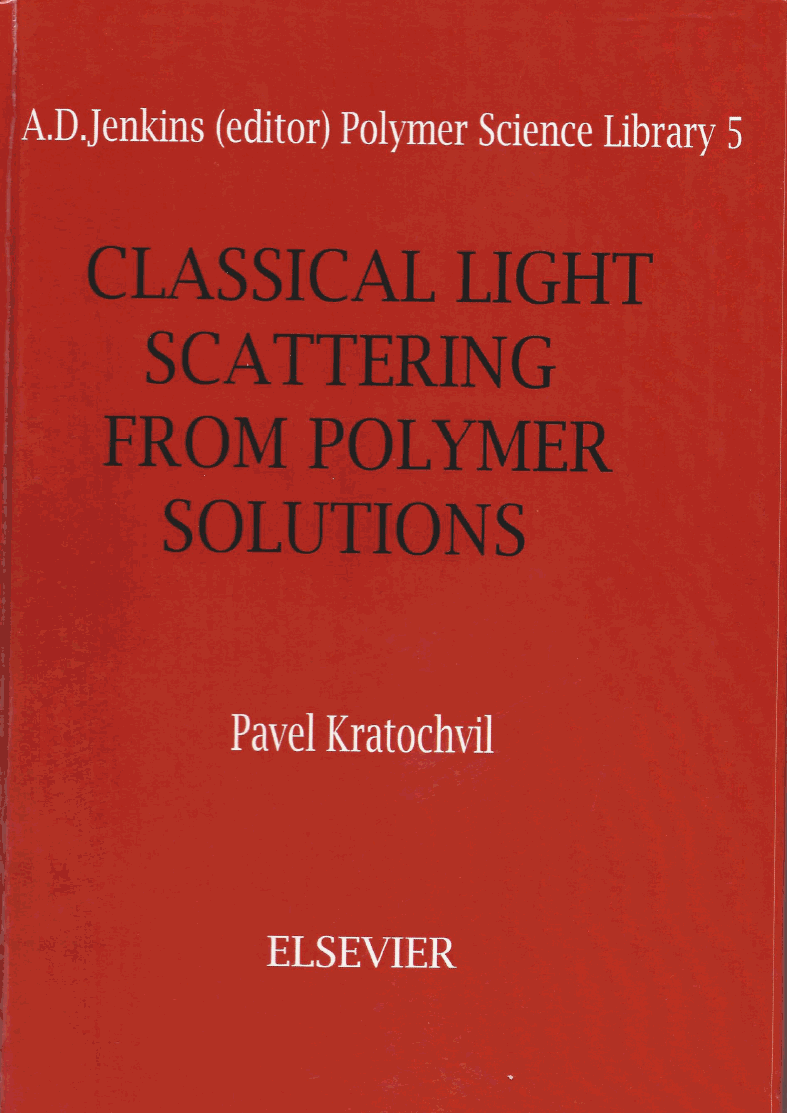
Pavel Kratochvíl
Elsevier
ISBN 978-0444428905 334 pages
Publisher Description: Classical light scattering from dilute polymer solutions is one of the few absolute, rigorously founded methods for the determination of molar mass and molecular size of macromolecular substances, and for the quantitative characterization of solute-solvent interaction. Light scattering is thus one of the most fundamental methods of the physical chemistry of polymers, and the present book provides an introduction to this technique. elements of practice and application of light scattering. Although there are a number of advanced monographs and reviews currently available on light scattering from polymer solutions, the appearance of this book marks the first introductory text of its kind. Polymer chemists wishing to make a start in light scattering will find this book an indispensable aid in their work.
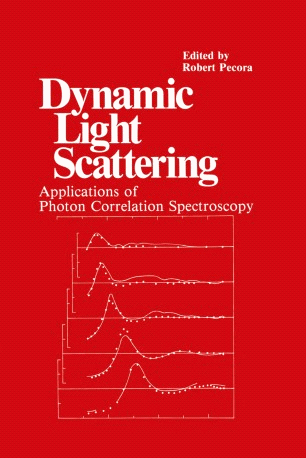
Dynamic Light Scattering. Applications of Photon Correlation Spectroscopy. (1985)
Springer (Plenum Press)
ISBN 9978-1-4612-9459-7 (Print) 978-1-4613-2389-1 (Online) 420 pages
Publisher Description: In the twenty years since their inception, modern dynamic light-scattering techniques have become increasingly sophisticated, and their applications have grown exceedingly diverse. Applications of the techniques to problems in physics, chemistry, biology, medicine, and fluid mechanics have prolifer ated. It is probably no longer possible for one or two authors to write a monograph to cover in depth the advances in scattering techniques and the main areas in which they have made a major impact. This volume, which we expect to be the first of aseries, presents reviews of selected specialized areas by renowned experts. It makes no attempt to be comprehensive; it emphasizes a body of related applications to polymeric, biological, and colloidal systems, and to critical phenomena. The well-known monographs on dynamic light scattering by Berne and Pecora and by Chu were published almost ten years ago. They provided comprehensive treatments of the general principles of dynamic light scat tering and gave introductions to a wide variety of applications, but natu rally they could not treat the new applications and advances in older ones that have arisen in the last decade. The new applications include studies of interacting particles in solution (Chapter 4); scaling approaches to the dynamics of polymers, including polymers in semidilute solution (Chapter 5); the use of both Fabry-Perot interferometry and photon correlation spectroscopy to study bulk polymers (Chapter 6); studies of micelIes and microemulsions (Chapter 8); studies of polymer gels (Chapter 9).
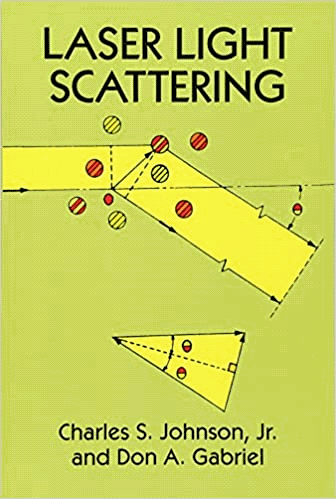
Wiley (Dover)
ISBN 9978-0486683287 (Dover Print) 96 pages
Publisher Description: Lasers play an increasingly important role in a variety of detection techniques, making inelastic light scattering a tool of growing value in the investigation of dynamic and structural problems in chemistry, biology, and physics. Until the initial publication of this work, however, no monograph treated the principles behind current developments in the field.This volume presents a comprehensive introduction to the principles underlying laser light scattering, focusing on the time dependence of fluctuations in fluid systems; it also serves as an introduction to the theory of time correlation functions, with chapters on projection operator techniques in statistical mechanics. The first half comprises most of the material necessary for an elementary understanding of the applications to the study of macromolecules, or comparable sized particles in fluids, and to the motility of microorganisms. The study of collective (or many particle) effects constitutes the second half, including more sophisticated treatments of macromolecules in solution and most of the applications of light scattering to the study of fluids containing small molecules.With its wide-ranging discussions of the many applications of light scattering, this text will be of interest to research chemists, physicists, biologists, medical and fluid mechanics researchers, engineers, and graduate students in these area.
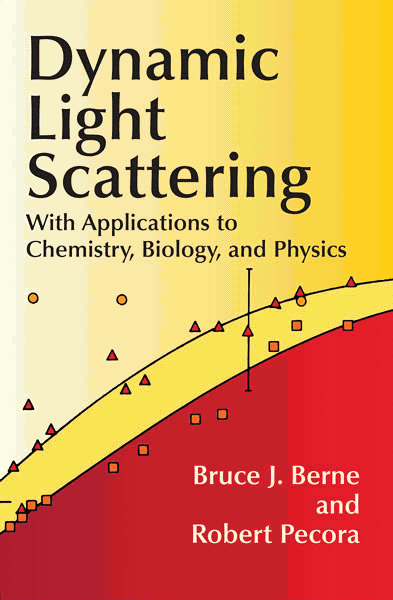
Dynamic Light Scattering: With Applications to Chemistry, Biology, and Physics (1976) (Dover 2000)
Wiley (Dover)
ISBN 9780486411552 (Dover Print) 376 pages
Publisher Description: Light scattering has provided an important method for characterizing macro-molecules for at least three decades. Now, through the use of intense, coherent laser light and efficient spectrum analyzers and autocorrelators, experiments in the frequency and time domains can be used to study molecular motion, e.g. diffusion and flow and other dynamic processes, as well as the equilibrium properties of solutions. As a result, laser light scattering has become a powerful form of spectroscopy with applications in physics, biochemistry, and other fields. This volume, which employs a relatively simple approach in order to reach the widest audience, focuses on two main topics: classical light scattering (scattering intensity, concentration dependence, size dependence, and polydispersity) and dynamic light scattering (time and frequency dependence, translational diffusion, directed flow, rotational motion, and more). A series of useful appendixes and a list of references complete this concise, accessible work, a valuable resource for physicists, chemists, and anyone interested in the increasingly important field of laser light scattering.
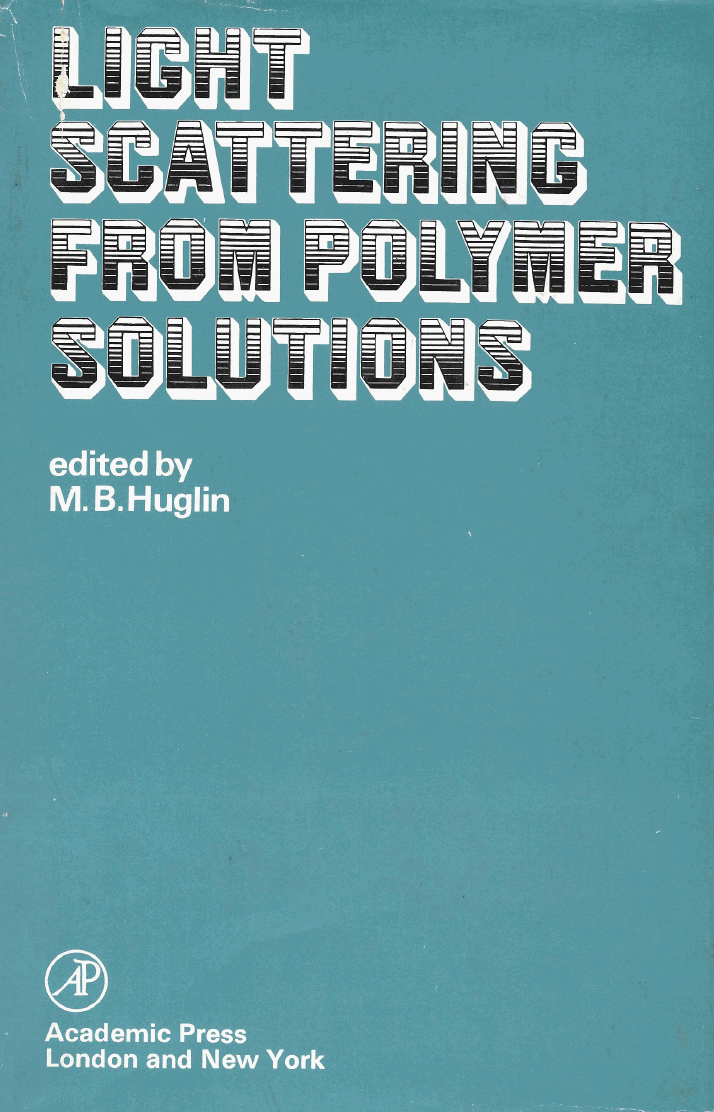
Light Scattering from Polymer Solutions (1972)
M.B. Huglin (Ed.)
Academic Press
ISBN 978-01236105082 885 pages
Publisher Description: This work has been designed to bridge the gap between s standard textbook and the extreme specialization of published research papers.

Milton Kerker
Academic Press
ISBN 978-0-12-404550-7 688 pages
Publisher Description: The Scattering of Light and Other Electromagnetic Radiation discusses the theory of electromagnetic scattering and describes some practical applications. The book reviews electromagnetic waves, optics, the interrelationships of main physical quantities and the physical concepts of optics, including Maxwell's equations, polarization, geometrical optics, interference, and diffraction. The text explains the Rayleigh2 theory of scattering by small dielectric spheres, the Bessel functions, and the Legendre functions. The author also explains how the scattering functions for a homogenous sphere change depending on different physical parameters such as the optical size, the complex refractive index, and the angle of observation. The author addresses the assignment of a complex dielectric constant and a corresponding refractive index to plasma when an alternating electrical field is applied that will make the plasma exhibit conductivity and polarization. In a liquid, the author points out that the intensity of scattering is one or two orders of magnitude less than that found in a gaseous system; he explains that the molecules are no longer acting as incoherent nor as randomly located scatterers. This book can be useful for physicists, chemists, biochemists, and engineers whose work includes research utilizing light scattering in the study of certain gases, pure liquids, molecular solutions, macromolecules, polymers, and glass.
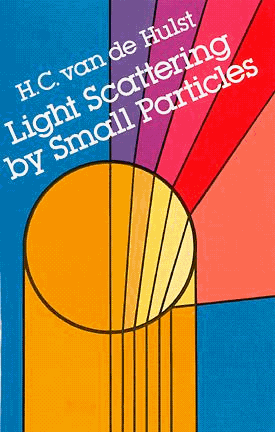
Light Scattering by Small Particles (1957) (Dover 1981)
H. C. van de Hulst
Wiley (Dover)
ISBN 9780486411552 (Dover Print) 470 pages
Publisher Description: "A must for researchers using the techniques of light scattering." ― S. C. Snowdon, Journal of the Franklin Institute The measurement of light scattering of independent, homogeneous particles has many useful applications in physical chemistry, meteorology and astronomy. There is, however, a sizeable gap between the abstract formulae related to electromagnetic-wave-scattering phenomena, and the computation of reliable figures and curves. Dr. van de Hulst's book enables researchers to bridge that gap. The product of twelve years of work, it is an exhaustive study of light-scattering properties of small, individual particles, and includes a survey of all the relevant literature. Beginning with a broad overview of basic scattering theory, Dr. van de Hulst covers the conservation of energy and momentum; wave propagation in vacuum and in a medium containing scatterers; and polarized light and symmetry relations. The heart of the book is devoted to the rigorous scattering theory for spheres of arbitrary size (Mie theory) and to various modes of approximation such as the Rayleigh-Gaas approximation, the perfect reflection approximation, the geometrical-optics approximation, and others. Methods of computation are given with respect to different kinds of particles, bodies and phenomena: particles small or very large compared to the wavelength, absorbing and nonabsorbing spheres, water drops, circular cylinders, edge phenomena and surface waves, and many others. In the last part, the author covers the use of scattering and extinction experiments as a practical tool, including applications in chemistry, meteorology and astronomy. This book's comprehensive, lucid coverage of the field makes it a valuable source for all those interested in light-scattering theory. It is absolutely essential for researchers needing to employ light-scattering measurements, and its republication will be welcomed especially by those who have found this necessary source difficult to obtain.
The Merck Index - An Encyclopedia of Chemicals, Drugs, and Biologicals (14th Edition)(06) (Knovel)
Publisher Description:The Merck Index is a world renowned, authoritative handbook of chemical, pharmaceutical and biomedical information that contains more qthan 10,000 monographs, 32 supplemental tables and 450 Organic Name Reactions and almost 1000 retired monographs.
Lange's Handbook of Chemistry (16th Edition-05) (Knovel)
Publisher Description:A standard reference for chemists for 70 years, this new Sixteenth Edition features an enormous compilation of facts, data, tabular material, and experimental findings in every area of chemistry. Included in this massive compendium are listings of the properties of approximately 4,400 organic and 1,400 inorganic compounds.
Dean's Analytical Chemistry Handbook (2nd Edition-04) (Knovel)
Publisher Description:This comprehensive, up-to-date reference offers chemists and chemical engineers detailed coverage of the full range of analytical methods, including all conventional wet and instrumental techniques.
Dean's Handbook of Organic Chemistry (2nd Edition-04) (Knovel)
Publisher Description:This handbook provides comprehensive coverage of organic chemistry; including practical information, key equations and tables, and a thorough introduction to each topic. Revised to include 50% new content. The most important tables in the book (including the largest one: Table 1.15 Physical Properties of Organic Compounds) are presented as Interactive Tables, allowing sorting and filtering, along with extensive search capabilities, both text and numeric. More than 50% of the original book data is presented in the interactive format.
Kaye Laby Tables of Physical and Chemical Constants
The Molecular Probes® Handbook—11th Edition (Invitrogen)
Publisher Description: The most complete fluorescent labeling and detection reference available, The Molecular Probes® Handbook—A Guide to Fluorescent Probes and Labeling Technologies contains over 3,000 technology solutions representing a wide range of biomolecular labeling and detection reagents. The significantly revised 11th Edition features extensive references, reorganized content, and new technical notes and product highlights.
Handbook of Inorganic Chemicals (03) (Knovel)
Publisher Description:This handbook is an invaluable resource for chemists, chemical engineers, laboratory technicians, and environmental engineers. Covering over 2000 of the most popular industrial chemicals, it details the chemical reactions the subject chemicals undergo either in preparation or naturally - all presented in a dynamic, easy-to-understand style.
Polymer Handbook (4th Edition-99-05) (Knovel)
Publisher Description:The Polymer Handbook is a unique and broadly recognized source of information about a large number of polymeric macromolecules. It contains a vast array of data for polymers, monomers and other ancillary topics that are required for experimental and theoretical research and applications of polymers.
Instrumentation Reference Book (3rd Edition) (Knovel)
Perry's Chemical Engineers' Handbook (7th Edition)(97) (Knovel)
Publisher Description:This new seventh edition of the world-famous classic provides you with unrivaled, state-of-the art coverage of all aspects of chemical engineering, from the fundamentals to details on computer applications and control. Definitive reference for chemical and process engineers.
Handbook of Optics, Volume I - Fundamentals, Techniques and Design (2nd Edition-95) (Knovel)
Publisher Description:The first volume of the Handbook of Optics provides information on classical, vision, and x-ray optics, with contributions from respected names in the field.
Handbook of Optics, Volume II - Devices, Measurements, and Properties (2nd Edition-05) (Knovel)
Publisher Description:In Volume II, readers will find coverage of: elements, from the traditional to more recently developed components such as integrated, micro, binary, gradient index, fiber, and x-ray optics; instruments, from cameras to optical scanners to FLIR systems; measurements, including both the theory and the methodology; optical and physical properties of material.
Handbook of Optics, Volume III - Classical Optics, Vision Optics and X-Ray Optics (2nd Edition_01) (Knovel)
Publisher Description:A thirty-eight chapter reference on classical, vision, and x-ray optics, with contributions from respected names in the field. Includes all of the information needed to solve problems in optics.
Handbook of Optics, Volume IV - Fiber Optics and Nonlinear Optics (2nd Edition-05) (Knovel)
Publisher Description:A new volume in the field's bestselling optics reference--an entirely new opus focusing exclusively on fiber-optics. Contains an ultra-handy, comprehensive index to all four Handbook of Optics volumes.
Knovel Critical Tables (03) (Knovel)
Publisher Description:This important, interactive Knovel reference contains tables of physical, solvent, and thermodynamic properties. The physical property tables alone include over 21,000 inorganic and organic compounds, and pure substances. The solvent property tables have data for 385 common solvents, and the thermodynamic property tables have data for over 15,000 compounds. Additionally, several tables make use of the interactive Equation Plotter to plot thermodynamic properties as a function of temperature.
Encyclopaedia of Scientific Units, Weights and Measures(03) (Knovel)
Publisher Description:This huge work is simply a "must have" for any reference library frequented by scientists of any discipline or by those with historical interests in units of measurement such as archaeologists.
Encyclopedia of Chemical Physics and Physical Chemistry, Volumes 1 - 3 (01) (Knovel)
Publisher Description:This encyclopedia quickly provides the basics, defines the scope of each subdiscipline, and indicates where to go for a more complete and detailed explanation.
Springer Handbook of Nanotechnology
Springer
GENERAL LABORATORY TECHNIQUES, SAFETY, etc.
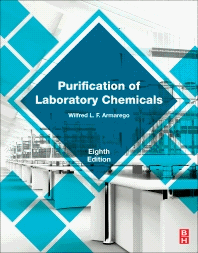
W.L.F. Armarego
Elsevier
ISBN 9780128054574 1198 Pages
Publisher Description: This book tabulates methods taken from literature for purifying thousands of individual commercially available chemicals. To help in applying this information, the more common processes currently used for purification in chemical laboratories and new methods are discussed. For dealing with substances not separately listed, a chapter is included setting out the usual methods for purifying specific classes of compounds.
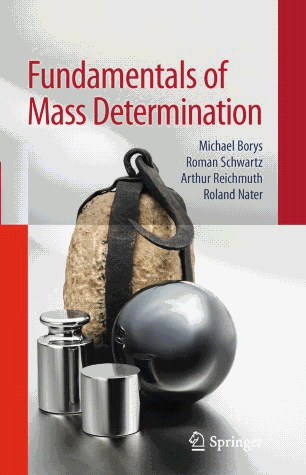
Fundamentals of Mass Determination (2012)
Michael BorysRoman SchwartzArthur ReichmuthRoland Nater
Springer
ISBN 978-3-642-11936-1 114 Pages
Publisher Description: In this book on Fundamentals of Mass Determination, the definition and dissemination of units of mass is explained, starting with an introduction to metrology and mass determination. Establishing a mass scale requires corresponding mass standards and mass comparators. The metrological requirements for weighing instruments, weight pieces, and measuring conditions are explained and discussed based on international directives and applicable legal regulations. International directives and institutions are striving towards the worldwide uniform implementation of these requirements. Processes used to determine density and volume are described to the extent that they apply to mass determination. Calculating measurement uncertainty entails taking into consideration the effect of influence variables on mass determination. An overview of this topic is provided to make it easier to determine and specify measurement uncertainty in practice, while additional information in the form of tables, illustrations, and literature references allow the reader to study mass metrology further.
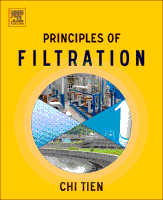
Principles of Filtration (2012)
Chi Tien
Elsevier
ISBN 978-0-444-56366-8
334 PagesPublisher Description: This book covers filtration in various modes of operation for both solid/gas and solid/liquid suspensions. It provides the necessary knowledge and background information to prepare and equip persons who are interested in serious filtration work. It is a useful reference/text for students and practicing engineers. It can also be adopted as an advanced text book for various engineering courses in chemical, environmental, mechanical and metallurgical engineering. The book presents analysis and treatment of filtration processes employing different filter media operating in various modes for both gas/solid and liquid/solid systems.

Destruction of Hazardous Chemicals in the Laboratory. 3rd Ed. (2012) (knovel.com link)
George Lunn Eric B. Sansone
Wiley
ISBN 9780470487556
779 pagesPublisher Description: The book describes practical procedures for the destruction of hazardous chemicals and biological agents in the laboratory in which they are used. The book is a continuation and expansion of “Destruction of Hazardous Chemicals in the Laboratory.” It follows the same general approach as the first and second editions but includes a number of new chapters including one on using advanced oxidation techniques as a general means of degrading chemicals. All the monographs from the second edition are incorporated in this volume and are revised and extended as necessary. A number of new monographs describing procedures for the destruction of hazardous chemicals have also been added. The destruction of many pharmaceuticals is also described in this book. This subject has become of increasing importance with recent reports of the detection of pharmaceuticals in the water supply. Finally a new addition is the chapter “General Methods for the Destruction of Hazardous Chemicals in the Laboratory.” This chapter describes recent advanced oxidation methods that should be generally applicable to all organic compounds. The methods use commonly available laboratory equipment and reagents.

Buying and Selling Laboratory Instruments: A Practical Consulting Guide. (2010) (knovel.com link)
Marvin C. McMaster
Wiley
ISBN 9780470404010
160 pagesPublisher Description: A time-tested, systematic approach to the buying and selling of complex research instruments. Searching for the best laboratory instruments and systems can be a daunting and expensive task. A poorly selected instrument can dramatically affect results produced and indirectly affect research papers, the quality of student training, and an investigator's chances for advancement. Buying and Selling Laboratory Instruments offers the valuable insights of an analytical chemist and consultant with over four decades of experience in locating instruments based upon both need and price. It helps all decision makers find the best equipment, service, and support while avoiding the brand-loyalty bias of sales representatives so you can fully meet your laboratory's requirements. The first section of the book guides buyers through the hurdles of funding, purchasing, and acquiring best-fit instruments at the least-expensive price. It explains how to find vendors that support their customers with both knowledgeable service and application support. Also offered is guidance on adapting your existing instruments to new applications, integrating new equipment, and what to do with instruments that can no longer serve in research mode. The second section explains the sales process in detail. This is provided both as a warning against manipulative sales reps and as a guide to making the sale a win-win process for you and your vendor. It also shows you how to select a knowledgeable technical guru to help determine the exact system configuration you need and where to find the best price for it. Added bonuses are summary figures of buying sequence and sales tools and an appendix containing frequently asked questions and memory aids. Buying and Selling Laboratory Instruments is for people directly involved in selecting and buying instruments for operational laboratories, from the principle investigator to the person actually delegated with investigating and selecting the system to be acquired. Sales representatives; laboratory managers; universities; pharmaceutical, biotech, and forensic research firms; corporate laboratories; graduate and postdoctoral students; and principle investigators will not want to be without this indispensible guide.
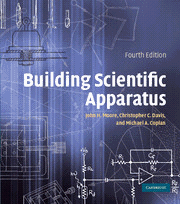
Building Scientific Apparatus. 4th Ed. (2009) (knovel.com link)
Cambridge U. Press
ISBN 9780521878586 658 pages
Publisher Description: Unrivaled in its coverage and unique in its hands-on approach, this practical guide to the design and construction of scientific apparatus, or laboratory instruments, is essential reading for every scientist and student of engineering, and physical, chemical, and biological sciences. Featured in this great new edition are features including the physical principles governing the operation of the mechanical, optical and electronic parts of an instrument, new sections on detectors, low-temperature measurements, high-pressure apparatus, and updated engineering specifications. 400 hand drawn figures and tables, have been added to this edition, which basically teaches scientists and engineers how to perform experiments.

Wiley Guide to Chemical Incompatibilities. 3rd Ed. (2009) (knovel.com link)
Richard P. Pohanish Stanley A. Greene
Wiley
ISBN 9780470387634 110 Pages
Publisher Description: More than a revision of the previous edition, this Third Edition has been rewritten and expanded to broaden coverage and improve its usefulness. It contains nearly 9,000 chemical incompatibility profiles and nearly 250 new entries, covering flammability, violent and explosive binary reactions, incompatibilities, and reactions that may result from physical change. Alphabetical organization provides concise incompatibility profiles for thousands of commonly used commercial chemicals, allowing readers to look up a given substance and instantly learn whether it is incompatible with common materials, other chemical substances, structural materials, or personal protective equipment.

A Comprehensive Guide to The Hazardous Properties of Chemical Substances. 3rd Ed. (2007)
Pradyot Patnaik
Wiley
ISBN 9780471714583
1060 pagesPublisher Description: The definitive guide to the hazardous properties of chemical compounds.Correlating chemical structure with toxicity to humans and the environment, and the chemical structure of compounds to their hazardous properties, A Comprehensive Guide to the Hazardous Properties of Chemical Substances, Third Edition allows users to assess the toxicity of a substance even when no experimental data exists. Thus, it bridges the gap between hazardous materials and chemistry.

A User's Guide to Vacuum Technology (2003)
John F. O'Hanlon
Wiley
ISBN 9780471270522
516 pagesPublisher Description: In the decade and a half since the publication of the Second Edition of A User?s Guide to Vacuum Technology there have been many important advances in the field, including spinning rotor gauges, dry mechanical pumps, magnetically levitated turbo pumps, and ultraclean system designs. These, along with improved cleaning and assembly techniques have made contamination-free manufacturing a reality. Designed to bridge the gap in both knowledge and training between designers and end users of vacuum equipment, the Third Edition offers a practical perspective on today?s vacuum technology. With a focus on the operation, understanding, and selection of equipment for industrial processes used in semiconductor, optics, packaging, and related coating technologies, A User?s Guide to Vacuum Technology, Third Edition provides a detailed treatment of this important field. While emphasizing the fundamentals and touching on significant topics not adequately covered elsewhere, the text avoids topics not relevant to the typical use.
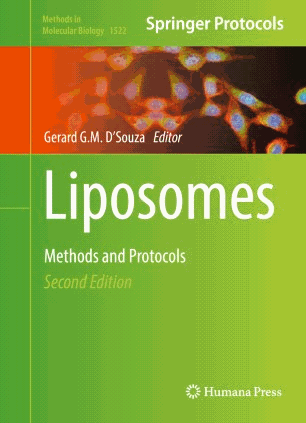
D'Souza, Gerard G.M (Ed
s.)Springer
ISBN 978-1-4939-6591-5
296 PagesPublisher Description: This second edition volume expands on the previous edition by discussing classic techniques, as well as new protocols that focus on the preparation of liposomes, lipid characterization, particle size and charge analysis, drug encapsulation, surface modification, stimuli response, and cellular interaction and biodistribution. Written in the highly successful Methods in Molecular Biology series format, chapters include introductions to their respective topics, lists of the necessary materials and reagents, step-by-step, readily reproducible laboratory protocols, and tips on troubleshooting and avoiding known pitfalls. Comprehensive and practical, Liposomes: Methods and Protocols, Second Edition is a valuable resource for graduate students, post-doctoral researchers, and established investigators utilizing lipid-based systems in the fields of cell and molecular biology, drug delivery, and physical chemistry.
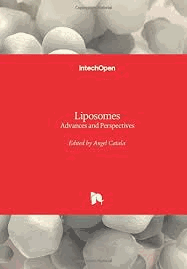
Angel Catala (ed.)
Intech Open
ISBN 978-953-51-3579-1 326 Pages
Publisher Description: Liposomes have received increased attention in recent years. Nevertheless, liposomes, due to their various forms and applications, require further investigation. These structures can deliver both hydrophilic and hydrophobic drugs. Preparation of liposomes results in different properties for these systems. In addition, there are many factors and difficulties that affect the development of liposome drug delivery structure. The purpose of this book is to concentrate on recent developments on liposomes. The articles collected in this book are contributions by invited researchers with a long-standing experience in different research areas. We hope that the material presented here is understandable to a broad audience, not only scientists but also people with general background in many different biological sciences. This volume offers you up-to-date, expert reviews of the fast-moving field of liposomes.
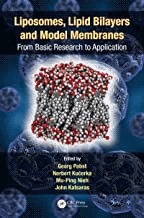
Liposomes, Lipid Bilayers and Model Membranes. From Basic Research to Application (2016)
Georg Pabst, Norbert Kučerka, Mu-Ping Nieh, John Katsaras
(eds.)CRC Press
ISBN 9781138198753
478 PagesPublisher Description: As a result of their unique physical properties, biological membrane mimetics, such as liposomes, are used in a broad range of scientific and technological applications. Liposomes, Lipid Bilayers and Model Membranes: From Basic Research to Application describes state-of-the-art research and future directions in the field of membranes, which has evolved from basic studies of the physicochemical properties of amphiphiles to their application in industry and medicine. Written by leading researchers in their fields, this book describes basic and applied research, and serves as a useful reference for both the novice and the expert. Part one covers a range of basic research topics, from theory and computational simulations to some of the most up-to-date experimental research. Topics discussed include soft matter physics of membranes, nonlamellar phases, extraction of molecules by amphiphiles, lipid models for membrane rafts, membrane dynamics, nanodiscs, microemulsions, active membranes, as well as interactions of bilayers with drugs or DNA to treat disease or for gene transfer, respectively. Part two of the book focuses on technological applications of amphiphiles, such as liposome-based nanoparticles for drug delivery, formulation of liposomes for prolonged in vivo circulation and functionalization for medical purposes, novel drug delivery systems for increased drug loading, and the use of tethered membranes for bio-sensing applications. Chapters also describe the use of liposomes in textile dyeing and how lipidic nanoparticles are used by the food industry.
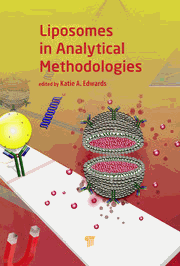
Liposomes in Analytical Methodologies (2016)
Katie A. Edwards
Jenny Stanford Publishing
(CRC Press)ISBN 9789814669269
480 PagesPublisher Description:
Liposomes have been widely explored in the drug delivery realm over the past decades. Many of the properties that made them well suited for drug delivery applications, such as the internal space to encapsulate a large payload of molecules and the inherent protection from exterior stresses, have also been exploited in various analytical techniques. Liposomes in Analytical Methodologies provides an extensive coverage of their utility, ranging from historic developments to actively researched techniques written by expert investigators. The introductory chapter serves as a primer on the fundamentals of liposomes for analytical purposes and provides an overview of various applications, while subsequent chapters provide in-depth coverage of selected areas. With techniques ranging from liposome PCR to electrophoretic separations, readers will gain an appreciation for the versatility that liposomes can add to the analytical toolbox.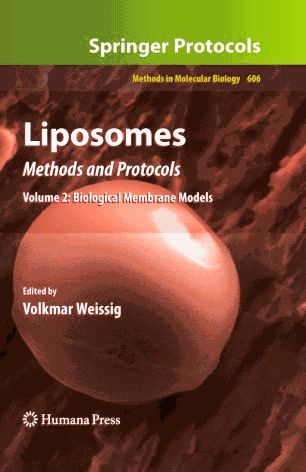
Liposomes Methods and Protocols, Volume : Biological Membrane Models (2010)
Weissig, Volkmar (Ed.)
Springer
ISBN 978-1-60761-447-0 5
64 PagesPublisher Description: With nearly one hundred years of intensive study, lipids have proven to be a vital and ever-more-promising area of cell biological research. In Liposomes: Methods and Protocols, leading experts in the related fields explore cutting-edge experimental methods involving all aspects of lipids as essential components of the cell membrane. Volume 2: Biological Membrane Models focuses on detailed methods for the use of liposomes in studying a variety of biochemical and biophysical membrane phenomena concomitant with chapters describing a great palette of state-of-the-art analytical technologies. As a volume in the highly successful Methods in Molecular Biology™ series, the chapters include introductions to their respective topics, lists of the necessary materials and reagents, step-by-step, readily reproducible laboratory protocols, and notes on troubleshooting and avoiding known pitfalls.
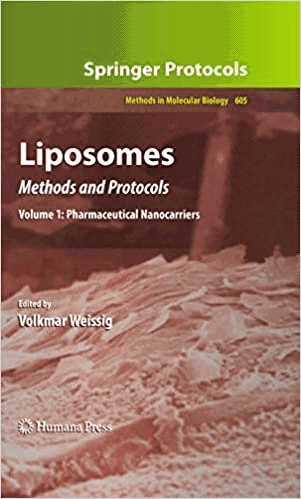
Liposomes Methods and Protocols, Volume 1: Pharmaceutical Nanocarriers (2010)
Weissig, Volkmar
(Ed.)Springer
ISBN 978-1-60327-360-2
578 PagesPublisher Description: With nearly one hundred years of intensive study, lipids have proven to be a vital and ever-more-promising area of cell biological research. In Liposomes: Methods and Protocols, leading experts in the related fields explore cutting-edge experimental methods involving all aspects of lipids as essential components of the cell membrane. Volume 1: Pharmaceutical Nanocarriers focuses on the state-of-the-art aspects of developing liposome-based nanoscale drug delivery techniques, delving into the depths of the emerging field of pharmaceutical and biomedical nanotechnology. As a volume in the highly successful Methods in Molecular Biology™ series, the chapters include introductions to their respective topics, lists of the necessary materials and reagents, step-by-step, readily reproducible laboratory protocols, and notes on troubleshooting and avoiding known pitfalls. Comprehensive and authoritative, Liposomes: Methods and Protocols promises to be an essential source of practical know-how for every investigator, young and seasoned alike, whose research area involves in one way or another phospholipids, glycolipids, or cholesterol.
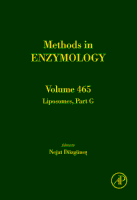
Liposomes, Part G (Methods in Enzymology, Vol 465)(2009)
Elsevier
ISBN 978-0123813794 448 pages
Publisher Description: Previous Methods in Enzymology volumes on Liposomes have described methods of liposome preparation and the physicochemical characterization of liposomes (volume 367), and the use of liposomes in biochemistry, molecular cell biology (volume 372), immunology, diagnostics, gene delivery and gene therapy (volume 373). Methods involved in the production and application of antibody- or ligand-targeted liposomes, environment-sensitive liposomes, and liposomal oligonucleotides were provided in volume 387, as were methods for studying the in vivo fate of liposomes. Finally, volume 391 presented methods in liposomal anti-cancer, antibacterial, antifungal and antiviral agents, miscellaneous liposomal therapies and electron microscopy of liposomes. The latter volume also included a short introductory chapter on ‘‘The Origin of Liposomes: Alec Bangham at Babraham’’. This new volume includes topics focusing on advances in liposome formation and characterization, and recent developments in the use of liposomes in therapeutics.
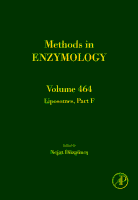
Liposomes, Part F (Methods in Enzymology, Vol 464)(2009)
Elsevier
ISBN 978-0-12-374969-7 416 pages
Publisher Description: Previous Methods in Enzymology volumes on ‘‘Liposomes’’ have described methods of liposome preparation and the physicochemical characterization of liposomes (Volume 367), and the use of liposomes in biochemistry, molecular cell biology (Volume 372), immunology, diagnostics, gene delivery, and gene therapy (Volume 373). Methods involved in the production and application of antibody- or ligand-targeted liposomes, environmentsensitive liposomes, and liposomal oligonucleotides were provided in Volume 387, as were methods for studying the in vivo fate of liposomes. Finally, Volume 391 presented methods in liposomal anticancer, antibacterial, antifungal, and antiviral agents, miscellaneous liposomal therapies and electron microscopy of liposomes. The latter volume also included a short introductory chapter on ‘‘The Origin of Liposomes: Alec Bangham at Babraham.’’ This new volume includes sections focusing on bioactive liposomes and the interface of liposomes and nanotechnology.
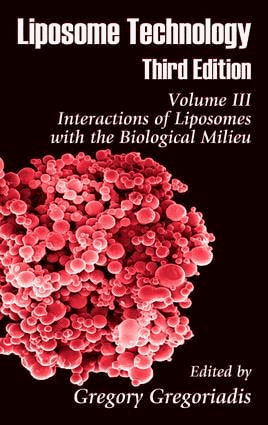
Gregoriadis Gregory (ed.)
CRC Press
ISBN ISBN 9780367390389 424 Pages
Publisher Description: Offering step-by-step technical details, Liposome Technology, Third Edition, Three Volume Set provides comprehensive coverage of all aspects of liposome technology, including liposome preparation and analysis, entrapment of drugs and other materials into liposomes, and liposome interaction with the biological environment to be applied in the detection, therapy, or prevention of disease. The text offers critical discussions of the methodologies of each technology discussed so that readers can examine the benefits and limitations and compare it to other methods. This Third Edition features 55 chapters written by leading international experts. Because of the considerable progress in liposome related techniques and their application in therapy since the publication of the Second Edition in 1992, over half of the chapters are new to the edition, and the other chapters have been extensively updated. Liposome Technology, Third Edition, Three Volume Set is an ideal resource for pharmaceutical scientists, researchers, regulatory personnel, FDA personnel, and medicinal chemists working in this discipline.
VOLUME
III. Interactions of Liposomes with Complement Leading to Toxic Reactions. Fixed Drug Ratio Liposome Formulations of Combination Cancer Therapeutics. Pharmacokinetics and Biopharmaceutics of Lipid-Based Drug Formulations. Optimization Strategies in Lymph Node Targeting of Interstitially Injected Immunoglobulin G-bearing Liposomes. Observations on the Disappearance of the Stealth Property of PEGylated Liposomes: Effect of Lipid Dose and Dosing Frequency. ATP-Loaded Liposomes for Myocardium Preservation under Ischemic Conditions. Targeting Tumor Angiogenesis Using Liposomes. Targeting Liposomes to Endothelial Cells in Inflammatory Diseases. Targeting of Cationic Liposomes to Endothelial Tissue. Folate Receptor Targeted Liposomes. Methods for Tracking Radiolabeled Liposomes after Injection in the Body. Cytoplasmic Tracking of Liposomes Containing Protein Antigens. Targeting of Liposomes to Lymph Nodes. Intracellular Delivery of Therapeutic Oligonucleotides in pH-Sensitive and Cationic Liposomes. Liposomes for Intracavitary and Intratumoral Drug Delivery. The Liposome Mediated "Macrophage Suicide" Technique: A Tool to Study and Manipulate Macrophage Activities. Lung Surfactants: Correlation Between Biophysical Characteristics, Composition and Therapeutic Efficacy. Liposomes in Cancer Immunotherapy. Preparation of Oil-in-Water Emulsions Stabilized by Liposomes for Vaccine Delivery. A Biotechnological Approach to Formulate Vaccines within Liposomes. Liposomal Therapeutics: From Animal to Man.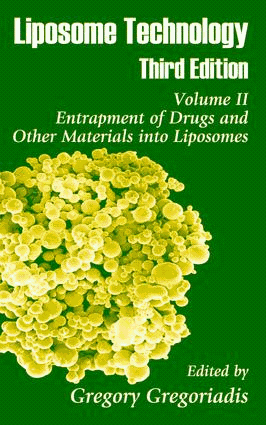
Liposome Technology, 3rdEd, Vol. II: Entrapment of Drugs and Other Materials into Liposomes (2007)
Gregoriadis Gregory (ed.)
CRC Press
ISBN 9780849388286 424 Pages
Publisher Description: Offering step-by-step technical details, Liposome Technology, Third Edition, Three Volume Set provides comprehensive coverage of all aspects of liposome technology, including liposome preparation and analysis, entrapment of drugs and other materials into liposomes, and liposome interaction with the biological environment to be applied in the detection, therapy, or prevention of disease. The text offers critical discussions of the methodologies of each technology discussed so that readers can examine the benefits and limitations and compare it to other methods. This Third Edition features 55 chapters written by leading international experts. Because of the considerable progress in liposome related techniques and their application in therapy since the publication of the Second Edition in 1992, over half of the chapters are new to the edition, and the other chapters have been extensively updated. Liposome Technology, Third Edition, Three Volume Set is an ideal resource for pharmaceutical scientists, researchers, regulatory personnel, FDA personnel, and medicinal chemists working in this discipline.
VOLUME II. Amphipathic Weak Base Loading into Preformed Liposomes Having a Transmembrane Ammonium Ion Gradient: From the Bench to Approved DOXIL. Encapsulation of Drugs within Liposomes by pH Gradient Techniques. Incorporation of Lipophilic Antitumor and Antiviral Drugs into the Lipid Bilayer of Small Unilamellar Liposomes. Liposome-Encapsulated Hemoglobin as an Artificial Oxygen Carrier. An Original Lipid Complex System for Amphotericin B. Coupling of Peptides to the Surface of Liposomes: Application to Liposome-Based Synthetic Vaccines. Encapsulation of Nucleic Acid-Based Therapeutics. Intraliposomal Trapping Agents for Improving In Vivo Liposomal Drug Formulation Stability. Radiolabeling of Liposomes for Scintigraphic Imaging. Liposomal Bisphophonates for the Treatment of Restenosis. Development of a Liposomal Vaccination System for Immunity Modulating Anti-Tumor Therapy. Influenza Virosomes as Adjuvants in Cancer Immunotherapy. Liposome-Based DNA/Protein Vaccines: Procedures for Entrapment. LPD: A Non-Viral Gene Vector Turned into a Potent Vaccine Carrier. Automated Screening of Cationic Lipid Formulations for Transfection. Association of Neutral or Anionic PEG Lipids into Lipoplexes: On Line Incorporation Assessment, and Pharmacokinetics Advantages. Lipid Peptide Vectors for Gene Therapy. Phospholipid and Non-Phospholipid Based Vesicles for Drug and DNA Delivery to Mitochondria in Living Mammalian Cells. Uptake and Intracellular Fate of Liposomes.
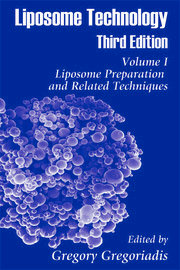
Liposome Technology, 3rdEd, Vol. I: Liposome Preparation and Related Techniques (2007)
Gregoriadis Gregory (ed.)
CRC Press
ISBN 9780849340765 1240 Pages
Publisher Description: Offering step-by-step technical details, Liposome Technology, Third Edition, Three Volume Set provides comprehensive coverage of all aspects of liposome technology, including liposome preparation and analysis, entrapment of drugs and other materials into liposomes, and liposome interaction with the biological environment to be applied in the detection, therapy, or prevention of disease. The text offers critical discussions of the methodologies of each technology discussed so that readers can examine the benefits and limitations and compare it to other methods. This Third Edition features 55 chapters written by leading international experts. Because of the considerable progress in liposome related techniques and their application in therapy since the publication of the Second Edition in 1992, over half of the chapters are new to the edition, and the other chapters have been extensively updated. Liposome Technology, Third Edition, Three Volume Set is an ideal resource for pharmaceutical scientists, researchers, regulatory personnel, FDA personnel, and medicinal chemists working in this discipline.
VOLUME I. Formation and Properties of Fatty Acid Vesicles (Liposomes). Formation and Physicochemical Properties of Lipid Vesicles (Liposomes) by the Coacervation Method. Preparation of Liposomes and Oily Formulations by Freeze-Drying Monophase Solutions. Formation of Large Unilamellar Vesicles by Extrusion. Preparation of Liposomes for Pulmonary Delivery Using Medical Nebulizers. Immunopotentiating Reconstituted Influenza Virosomes. Lipoplexes in Gene Therapy under the Considerations of Scaling Up, Stability Issues and Pharmaceutical Requirements. Synthesis and Advantages of Acid-Labile Formulations for Lipoplexes. Bioresponsive Lipids and Their Use for Macromolecular Delivery. Polymeric Vesicles Based on Hydrophilic Polymers Bearing Hydrophobic Pendant Groups. Mixed Vesicles and Mixed Micelles: Formation, Thermodynamic Stability and Pharmaceutical Aspects. Vesicular Phospholipid Gels. Stabilization of Liposomes by Freeze-Drying: Lessons from Nature. Hydrolysis of Phospholipids in Liposomes and Stability Indicating Analytical Techniques. Process Development and Quality Control of Injectable Liposomal Therapeutics.
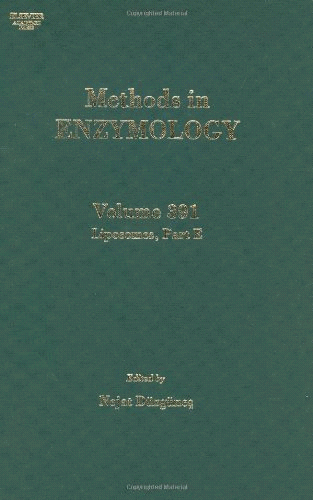
Liposomes, Part E (Methods in Enzymology, Vol 391)(2005)
Elsevier
ISBN 9780121827960 528 pages
Publisher Description: The first chapter of this volume is a tribute to Alec Bangham. The rest of the volume focuses on therapeutic applications of liposomes, and comprises sections on liposomal anti-cancer agents, liposomal antibacterial, antifungal and antiviral agents, miscellaneous liposomal therapies, and electron microscopy of liposomes. I hope that these chapters will facilitate the work of graduate students, post-doctoral fellows, as well as established scientists entering liposome research or shifting their focus in the field. The previous volumes in this series have covered additional aspects of liposomology: Preparation and physicochemical characterization of liposomes (volume 367), the use of liposomes in biochemistry and in molecular cell biology (volume 372), liposomes in immunology, diagnostics, gene delivery and gene therapy (volume 373), antibody-or ligand-targeted liposomes, environment-sensitive liposomes, liposomal oligonucleotides, and liposomes in vivo (volume 387).
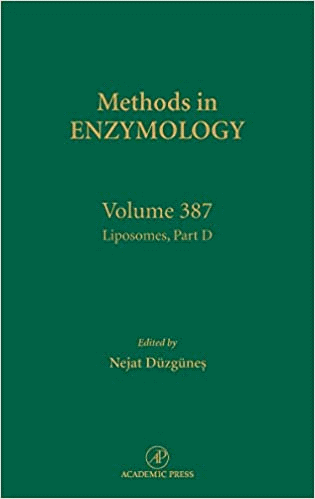
Liposomes, Part D (Methods in Enzymology, Vol 387)(2004)
Elsevier
ISBN 9780121827922 341 pages
Publisher Description: This volume includes chapters on targeted and environment-sensitive liposomes, delivery of oligonucleotides, and the use of liposomes in vivo. I hope that these chapters will facilitate the work of graduate students, post-doctoral fellows, and established scientists entering liposome research. The next volume on ‘‘Liposomes’’ (Part E) will focus on the therapeutic applications of liposomes. Previous volumes in this series (367, 372, and 373) cover additional subdisciplines in liposomology.
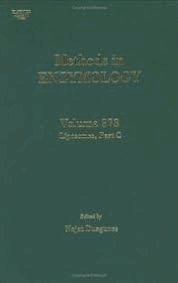
Liposomes, Part C (Methods in Enzymology, Vol 373)(2003)
Elsevier
ISBN 9780121822767 596 pages
Publisher Description: This volume includes applications of liposomes in immunology, diagnostics, and gene delivery and gene therapy. I hope that these chapters will facilitate the work of graduate students, post-doctoral fellows, and established scientists entering liposome research. Other volumes in this series cover additional subdisciplines in liposomology.

Liposomes, Part B (Methods in Enzymology, Vol 372)(2003)
Elsevier
ISBN 9780121822750 479 pages
Publisher Description: This volume includes applications of liposomes in biochemistry, molecular cell biology and molecular virology. I hope that these chapters will facilitate the work of graduate students, post-doctoral fellows, and established scientists entering liposome research. Subsequent volumes in this series will cover additional subdisciplines in liposomology.

Liposomes, Part A (Methods in Enzymology, Vol 367)(2003)
Elsevier
ISBN 9780121822705 311 pages
Publisher Description: This volume describes methods of liposome preparation, and the physicochemical characterization of liposomes. I hope that these chapters will facilitate the work of graduate students, post-doctoral fellows, and established scientists entering liposome research. Subsequent volumes in this series will cover additional subdisciplines in liposomology.
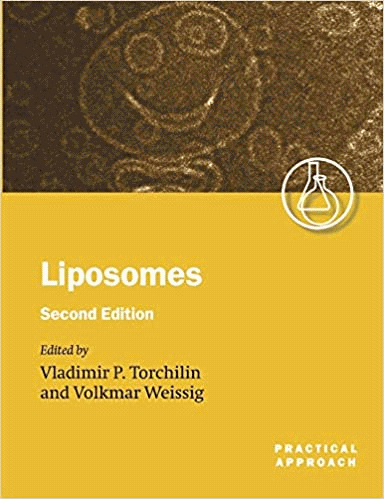
Liposomes: A Practical Approach, 2nd Ed. (The Practical Approach Series, 264)(2003)
Vladimir P. Torchilin, Volkmar Weissig (eds.)
Oxford
ISBN 978-0199636549 424 pages
Publisher Description: Since the first edition of "Liposomes - A Practical Approach" was published in 1990, Liposome technology has become a highly successful and rapidly developing area of preclinical and clinical research. During the 90's, a number of liposome-based drugs reached the market in the U.S. and Europe and several new aspects of liposome research have been discovered. As a consequence there has been an explosion of new procedures and techniques in the field. Reflecting both the significant changes in the field and the new discoveries, this new edition of Liposomes contains a combination of chapters from the 1st edition which have been significantly updated, and several new chapters. Each chapter is an outstanding contribution from leading experts in the field, and the book as a whole encompasses all key areas of liposome technology. The first half of the book addresses a number of essential experimental protocols such as the preparation, characterization, and storage of liposomes. Also included are methods for drug encapsulation into liposomes, modification of the liposomal surface to control drug behaviour in biological environments, long-circulating liposomes and the use of cationic liposomes as transfection vectors. The second half of the book discusses specificareas of liposome research and application, such as pH-sensitive liposomes, liposomes for diagnostic imaging, liposomal DNA vaccines, isothermic titration calorimetry of liposomes and vesicular phospholipids gels. This new edition of Liposomes is an essential tool for all experienced liposomologists and the perfect introduction for researchers new to the field.
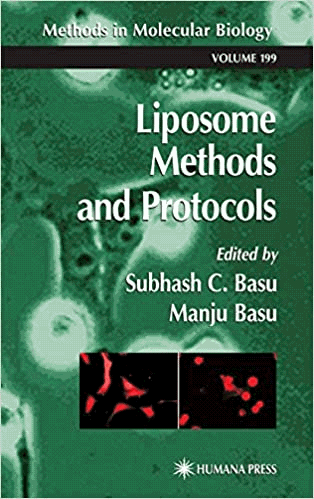
Basu, Subhash C., Basu, Manju (Eds.)
Springer
ISBN 978-1617372179 2
64 PagesPublisher Description: In vitro utilization of liposomes holds great potential as a powerful tool for drug targeting, gene transport across plasma and nuclear membranes, and enzyme therapy for patients with genetic disorders. In Liposome Methods and Protocols, a panel of skilled researchers describes in step-by-step detail their best laboratory techniques for elucidating liposome biology and realizing this promise. With these readily reproducible methods, investigators can illuminate such critical questions as the attachment of liposomes to cell surfaces, the permeation of liposomes through the plasma membranes, and the stability of liposomes in cellular and nuclear matrices. Each detailed protocol is presented by an investigator who is intimately familiar with its problems and capabilities, and includes a detailed list of materials to be used, troubleshooting tips straight from the benchtop, and notes on pitfalls to avoid. The emphasis is on clearly presenting the technical steps critical to experimental success that are too often omitted from methods published in the primary literature. State-of-the-art and highly practical, Liposome Methods and Protocols provides an indispensable collection of proven techniques and references for researchers across many fields, including glycoproteins, glycolipids, glycosyltransferases, drug transport, viral transport, antibody delivery, synthetic peptide delivery to cells, and protease delivery.
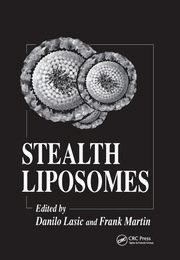
Danilo D. Lasic, Francis J. Martin (eds.)
CRC Press
ISBN 9780367401801 320 Pages
Publisher Description: This book examines stealth liposomes from a multidisciplinary approach, which includes theoretical polymer physics, organic synthesis, colloid science, and biology. Discussions include theory, chemistry, biochemistry, pharmacology, preclinical studies in model systems, and medical applications in humans.
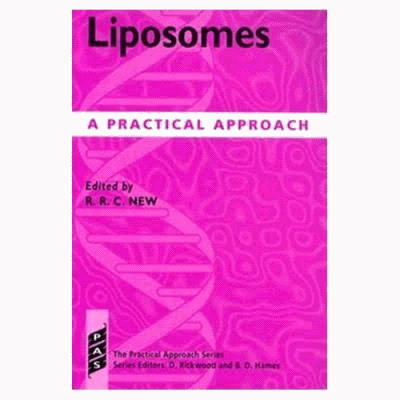
Liposomes: A Practical Approach (The Practical Approach Series, 58)(1990)
R R C New (ed.)
Oxford
ISBN 978-0199630769 320 pages
Publisher Description: Over the last twenty years the status of liposomes has changed from laboratory novelty to powerful industrial tool. The properties of such membrane preparations have been extensively researched and ingenious ways have been found of manipulating them to confer certain behavioural characteristics, such as sensitivity to light, pH, temperature, or protein tertiary structure. Many potential applications of liposomes in medicine have also been recognized. This book brings together the full range of methods from liposome preparation to application which experienced workers in the field have found to be routinely reliable. This book is intended for researchers and postgraduates in biochemistry, cell biology, and biotechnology.
Advanced Organic Chemistry, Part A: Structure and Mechanisms, 5th ed (2007)
Francis A. Carey, Richard J. Sundberg
Springer
ISBN 978-0-387-44897-8 1199 pages
Publisher Description:Advanced Organic Chemistry Part A provides a close look at the structural concepts and mechanistic patterns that are fundamental to organic chemistry. It relates those mechanistic patterns, including relative reactivity and stereochemistry, to underlying structural factors. Understanding these concepts and relationships will allow students to recognize the cohesive patterns of reactivity in organic chemistry. Part A: Structure and Mechanism and Part B: Reaction and Synthesis - taken together - are intended to provide the advanced undergraduate or beginning graduate student in chemistry with a foundation to comprehend and use the research literature in organic chemistry.
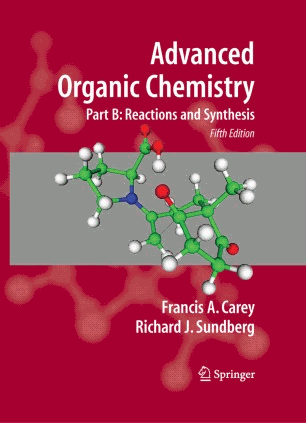
Advanced Organic Chemistry, Part B: Reactions and Synthesi, 5th ed (2007)
Francis A. Carey, Richard J. Sundberg
Springer
ISBN 978-0-387-68350-8 1321 pages
Publisher Description: The control of reactivity to achieve specific syntheses is one of the overarching goals of organic chemistry. Part B describes the most general and useful synthetic reactions, organized on the basis of reaction type. Together with Part A: Structure and Mechanisms, the two volumes are intended to provide the advanced undergraduate or beginning graduate student in chemistry with a sufficient foundation to comprehend and use the research literature in organic chemistry.
Structure Determination of Organic Compounds: Tables of Spectral Data Fifth Edition (2020)
Ernö Pretsch , Philippe Bühlmann , Martin Badertscher
Springer
ISBN 978-3-662-62438-8 478 pages
Publisher Description: This book compiles reference material for NMR, IR, UV/Vis and mass spectra since the combined interpretation of spectra of the different methods is advantageous. It can be used in three ways: 1:as compact and easy to understand companion material; 2:to complement the understanding of detailed textbooks; 3:as an easy to use reference book The long-standing success of the work, which has been published in a total of 7 languages, proves the usefulness of this method of representation. The content of this fifth English edition now includes reference data for the interpretation of 15N- and 29Si-spectra. Additionally, the fragmentation rules for mass spectrometry have been extended with recently available information for the interpretation of MS/MS spectra after soft ionization.
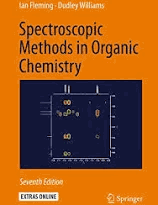
Spectroscopic Methods in Organic Chemistry 7th ed. (2019)
Ian Fleming, Dudley Williams
Springer
ISBN 978-3030182519 443 pages
Publisher Description: This book is a well-established guide to the interpretation of the mass, ultraviolet, infrared and nuclear magnetic resonance spectra of organic compounds. It is designed for students of organic chemistry taking a course in the application of these techniques to structure determination. The text also remains useful as a source of data for organic chemists to keep on their desks throughout their career. In the seventh edition, substantial portions of the text have been revised reflecting knowledge gained during the author's teaching experience over the last seven years. The chapter on NMR has been divided into two separate chapters covering the 1D and 2D experiments. The discussion is also expanded to include accounts of the physics at a relatively simple level, following the development of the magnetization vectors as each pulse sequence is introduced. The emphasis on the uses of NMR spectroscopy in structure determination is retained. Worked examples and problem setsare included on a chapter level to allow students to practise their skills by determining the chemical structures of unknown compounds.

Structure Elucidation in Organic Chemistry: The Search for the Right Tools (2015)
Maria-Magdalena Cid, Jorge Bravo
Wiley
ISBN 978-3-527-33336-3 529 pages
Publisher Description: Intended for advanced readers, this is a review of all relevant techniques for structure analysis in one handy volume. As such, it provides the latest knowledge on spectroscopic and related techniques for chemical structure analysis, such as NMR, optical spectroscopy, mass spectrometry and X-ray crystallography, including the scope and limitation of each method. As a result, readers not only become acquainted with the techniques, but also the advantages of the synergy between them. This enables them to choose the correct analytical method for each problem, saving both time and resources. Special emphasis is placed on NMR and its application to absolute configuration determination and the analysis of molecular interactions. Adopting a practical point of view, the author team from academia and industry guarantees both solid methodology and applications essential for structure determination, equipping experts as well as newcomers with the tools to solve any structural problem.
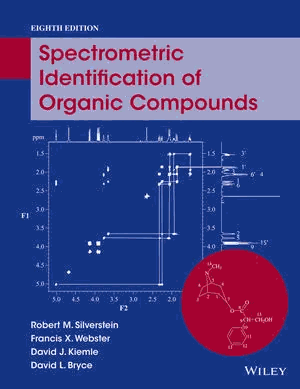
Spectrometric Identification of Organic Compounds, 8th Edition (2014)
Robert M. Silverstein, Francis X. Webster, David J. Kiemle, David L. Bryce
Wiley
ISBN 978-0-470-61637-6 464 pages
Publisher Description: First published over 40 years ago, this was the first text on the identification of organic compounds using spectroscopy. This text presents a unified approach to the structure determination of organic compounds based largely on mass spectrometry, infrared (IR) spectroscopy, as well as multinuclear and multidimensional nuclear magnetic resonance (NMR) spectroscopy. The key strength of this text is the extensive set of practice and real-data problems (in Chapters 7 and 8). Even professional chemists use these spectra as reference data. Spectrometric Identification of Organic Compounds is written by and for organic chemists, and emphasizes the synergistic effect resulting from the interplay of spectra. This text is characterized by its problem-solving approach with numerous practice problems and extensive reference charts and tables.
Practical Organic Chemistry and Synthesis
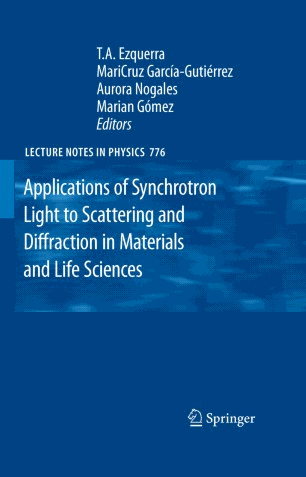
Marian GomezAurora Nogales, Mari Cruz Garcia-Gutierrez,T.A. Ezquerra
Springer
ISBN 978-3-540-95967-0 318 pages
Publisher Description: The present set of lecture notes originates from the deeply felt need in the community to bridge the gap between beamline manuals and advanced graduate textbooks. The volume is a collection of tutorials, surveys and reviews. They cover most cases of relevance and interest where the combination of synchrotron light with various scattering and diffraction techniques is a very helpful approach to obtaining essential information about the structure of large molecular assemblies in low-ordered environments. Soft condensed matter and biomaterials, as well as complex fluids, are typical of the materials considered here.

Mason, Robert L. Gunst, Richard F. Hess, James L
Wiley
ISBN 978-0-471-37216-5 736 pages
Publisher Description: Ideal for both students and professionals, this focused and cogent reference has proven to be an excellent classroom textbook with numerous examples. It deserves a place among the tools of every engineer and scientist working in an experimental setting. Emphasizes the strategy of experimentation, data analysis, and the interpretation of experimental results: Features numerous examples using actual engineering and scientific studies. Presents statistics as an integral component of experimentation from the planning stage to the presentation of the conclusions. Deep and concentrated experimental design coverage, with equivalent but separate emphasis on the analysis of data from the various designs. Topics can be implemented by practitioners and do not require a high level of training in statistics. New edition includes new and updated material and computer output.

Instrumentation Reference Book, 3rd Edition (2003) (Knovel)
Walt Boyes
Elsevier
ISBN 978-0-7506-7123-1
Publisher Description:This book is of direct interest to anyone working in the process, control and instrumentation fields where these measurements are essential. Often categorized as either 'techniques' or 'applications' this book addresses the various applications that may be needed with reference to the practical techniques that are available for the instrumentation or measurement of a specific physical quantity or quality. This book is a comprehensive and authoritative collection of technical information, which is of direct practical value to instrumentation and control engineers as well as all instrument technicians and users. It is also an indispensable addition to any academic library for the benefit of engineering and science students.

Fundamentals of Contemporary Mass Spectrometry (2006)
Chhabil Das
Wiley
ISBN:9780471682295 578 pages
Publisher
Description:Mass
spectrometry has played a pivotal role in a variety of scientific disciplines.
Today it is an integral part of proteomics and drug discovery process.
Fundamentals of Contemporary Mass Spectrometry gives readers a concise and
authoritative overview of modern mass spectrometry instrumentation, techniques,
and applications, including the latest developments. After an introduction to
the history of mass spectrometry and the basic underlying concepts, it covers: *
Instrumentation, including modes of ionization, condensed phase ionization
techniques, mass analysis and ion detection, tandem mass spectrometry, and
hyphenated separation techniques
* Organic and inorganic mass spectrometry* Biological mass spectrometry,
including the analysis of proteins and peptides, oligosaccharides, lipids,
oligonucleotides, and other biological materials* Applications to quantitative
analysis.

Excel for Chemists®: A Comprehensive Guide, Third Edition (2011)
E. Joseph Bilo
Wiley
ISBN 9780470381236 732 pages
Publisher Description: The newly revised step-by-step guide to using the scientific calculating power of Excel to perform a variety of chemical calculations. Chemists across all subdisciplines use Excel to record data in tabular form, but few have learned to take full advantage of the program. Featuring clear step-by-step instructions, Excel for Chemists illustrates how to use the scientific calculating power of Excel to perform a variety of chemical calculations.

Excel for Scientists and Engineers. Numerical Methods (2006)
E. Joseph Bilo
Wiley
ISBN 9780471387343 454 pages
Publisher Description: Learn to fully harness the power of Microsoft Excel® to perform scientific and engineering calculations. With this text as your guide, you can significantly enhance Microsoft Excel's® capabilities to execute the calculations needed to solve a variety of chemical, biochemical, physical, engineering, biological, and medicinal problems. The text begins with two chapters that introduce you to Excel's Visual Basic for Applications (VBA) programming language, which allows you to expand Excel's® capabilities, although you can still use the text without learning VBA. Following the author's step-by-step instructions, here are just a few of the calculations you learn to perform: * Use worksheet functions to work with matrices * Find roots of equations and solve systems of simultaneous equations * Solve ordinary differential equations and partial differential equations * Perform linear and non-linear regression * Use random numbers and the Monte Carlo method.This text is loaded with examples ranging from very basic to highly sophisticated solutions. More than 100 end-of-chapter problems help you test and put your knowledge to practice solving real-world problems. Answers and explanatory notes for most of the problems are provided in an appendix.

Methods of Multivariate Analysis, 3rd Ed (2012)
Alvin C. Rencher William F. Christensen
Wiley
ISBN 9780470178966 768 Pages
Publisher Description:This Third Edition continues to explore the key descriptive and inferential procedures that result from multivariate analysis. Following a brief overview of the topic, the book goes on to review the fundamentals of matrix algebra, sampling from multivariate populations, and the extension of common univariate statistical procedures (including t-tests, analysis of variance, and multiple regression) to analogous multivariate techniques that involve several dependent variables. The latter half of the book describes statistical tools that are uniquely multivariate in nature, including procedures for discriminating among groups, characterizing low-dimensional latent structure in high-dimensional data, identifying clusters in data, and graphically illustrating relationships in low-dimensional space. In addition, the authors explore a wealth of newly added topics
All logos and names are the copyrights of the respective owners.
Last Updated 07/28/2025
Accessibility Statement Provide Website Feedback